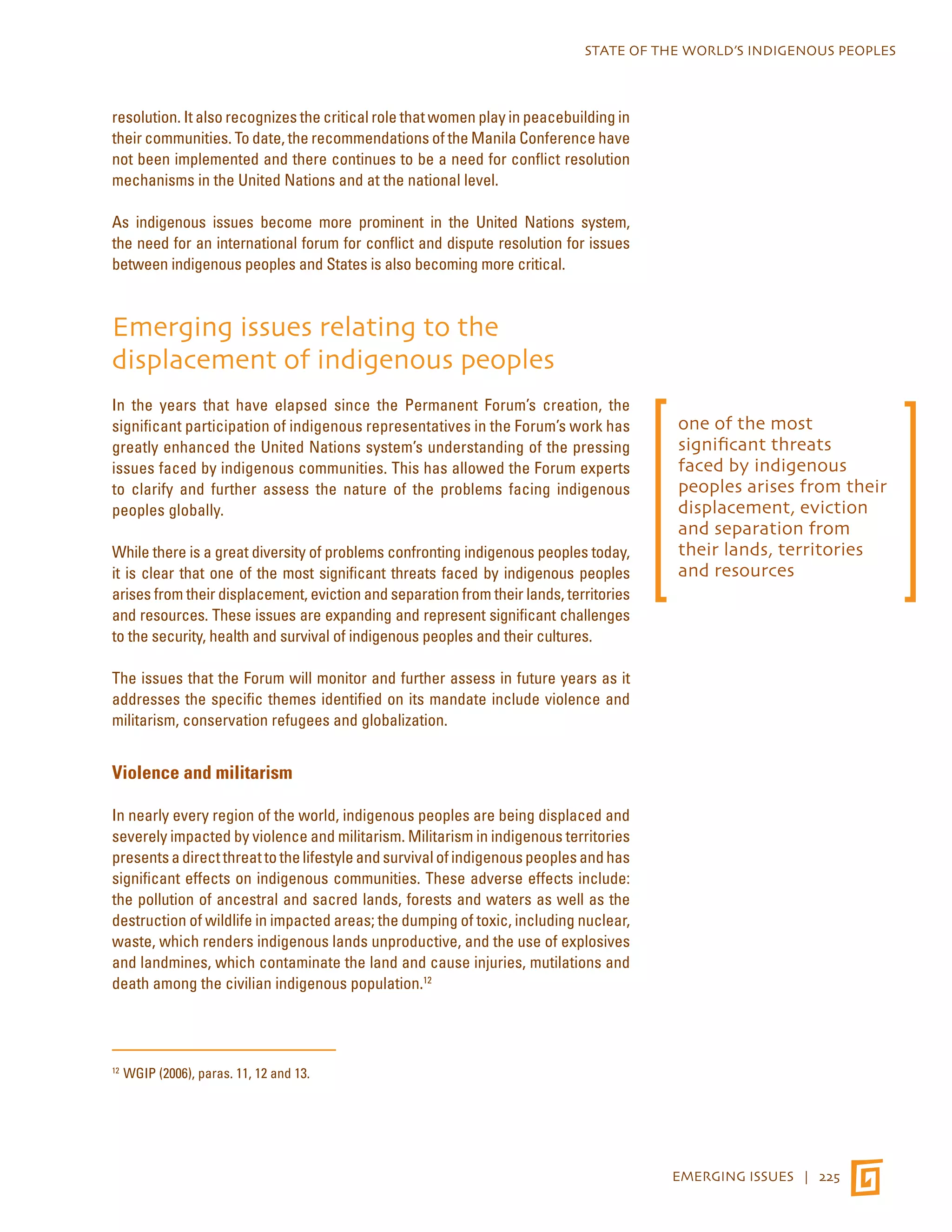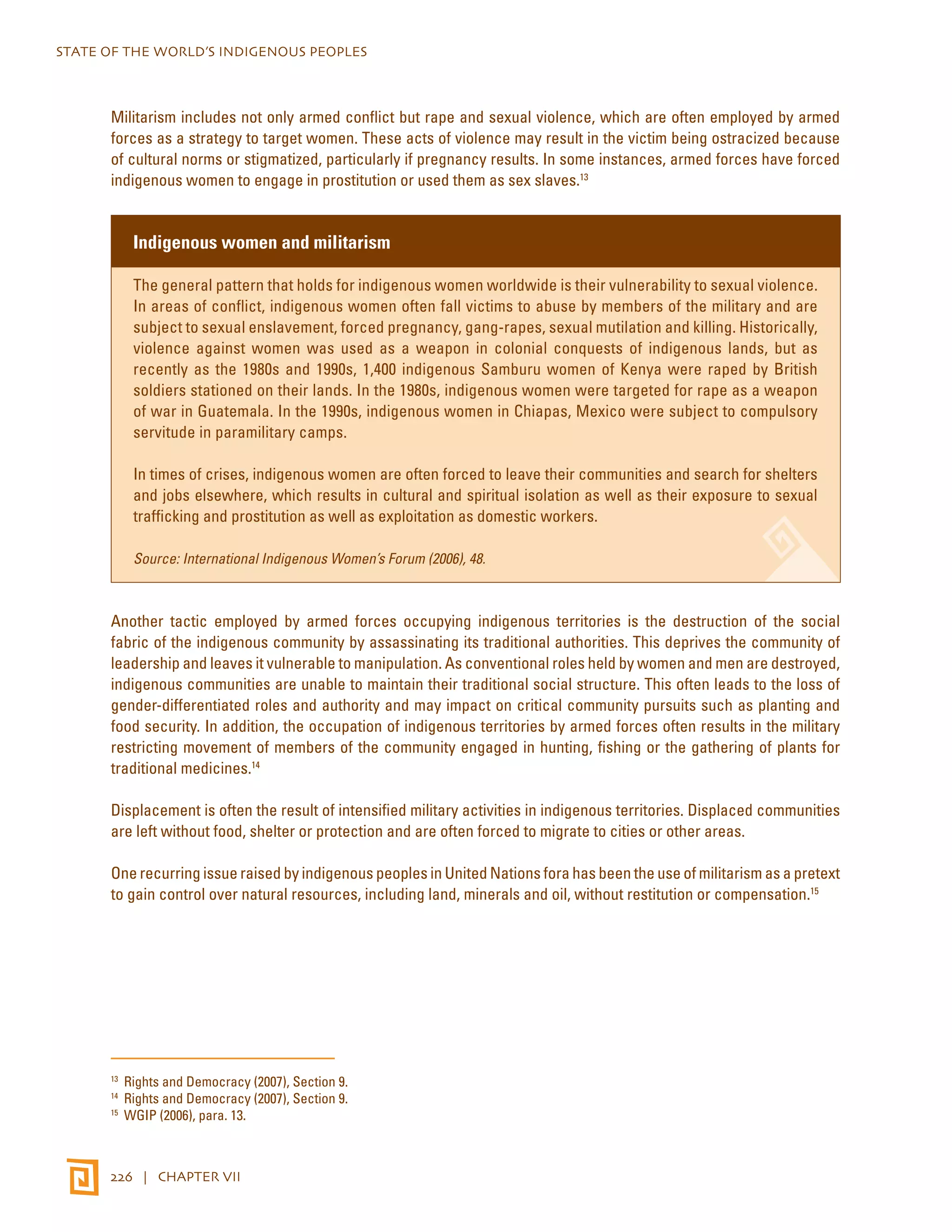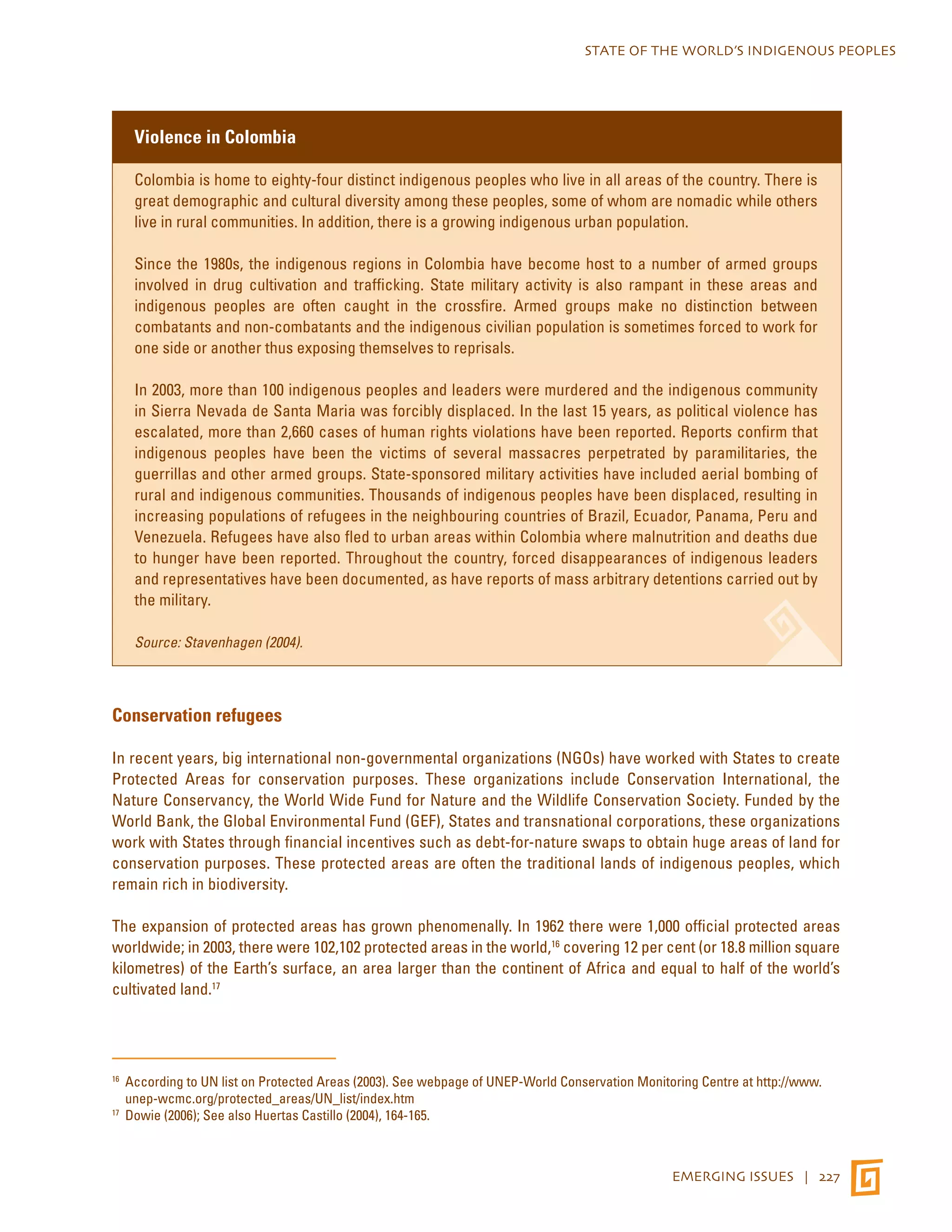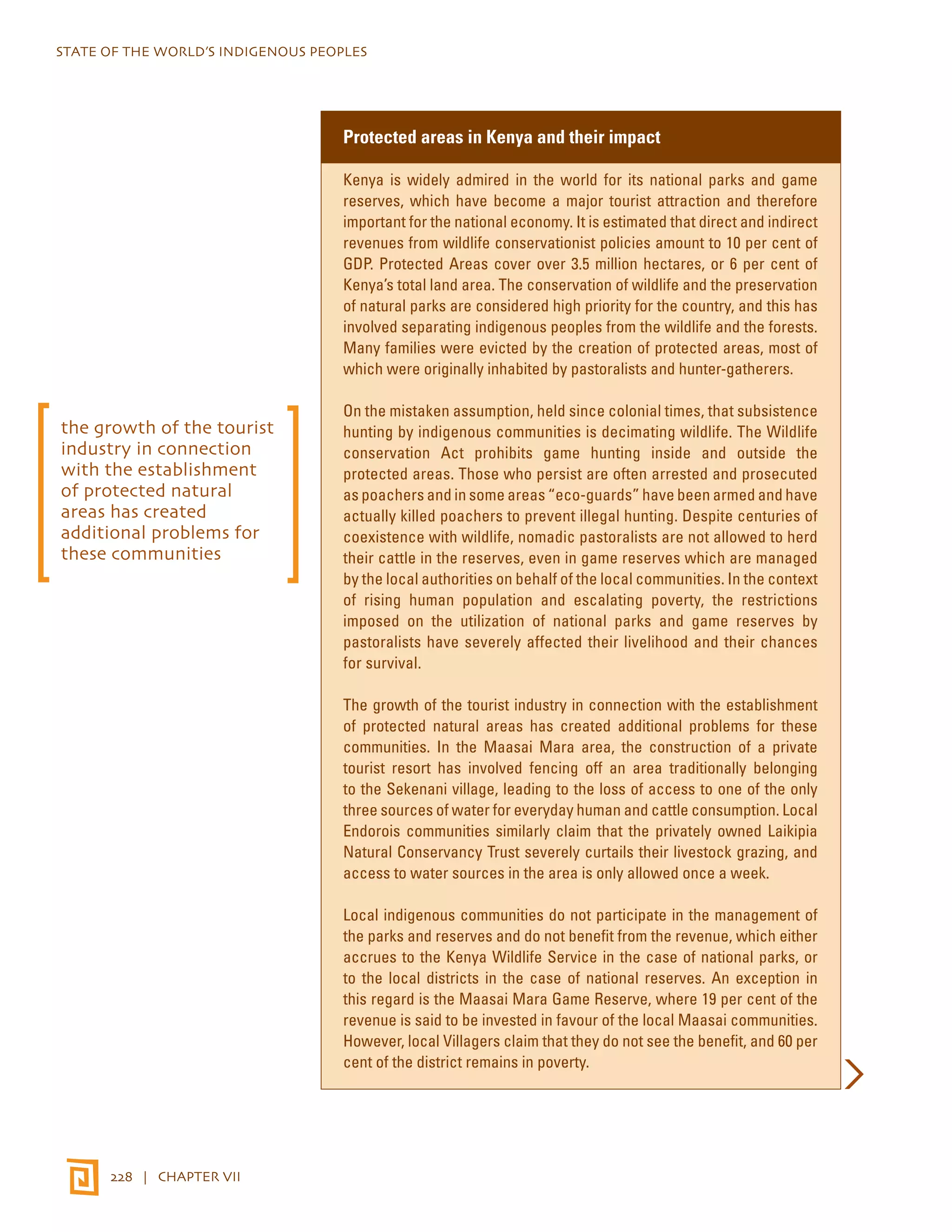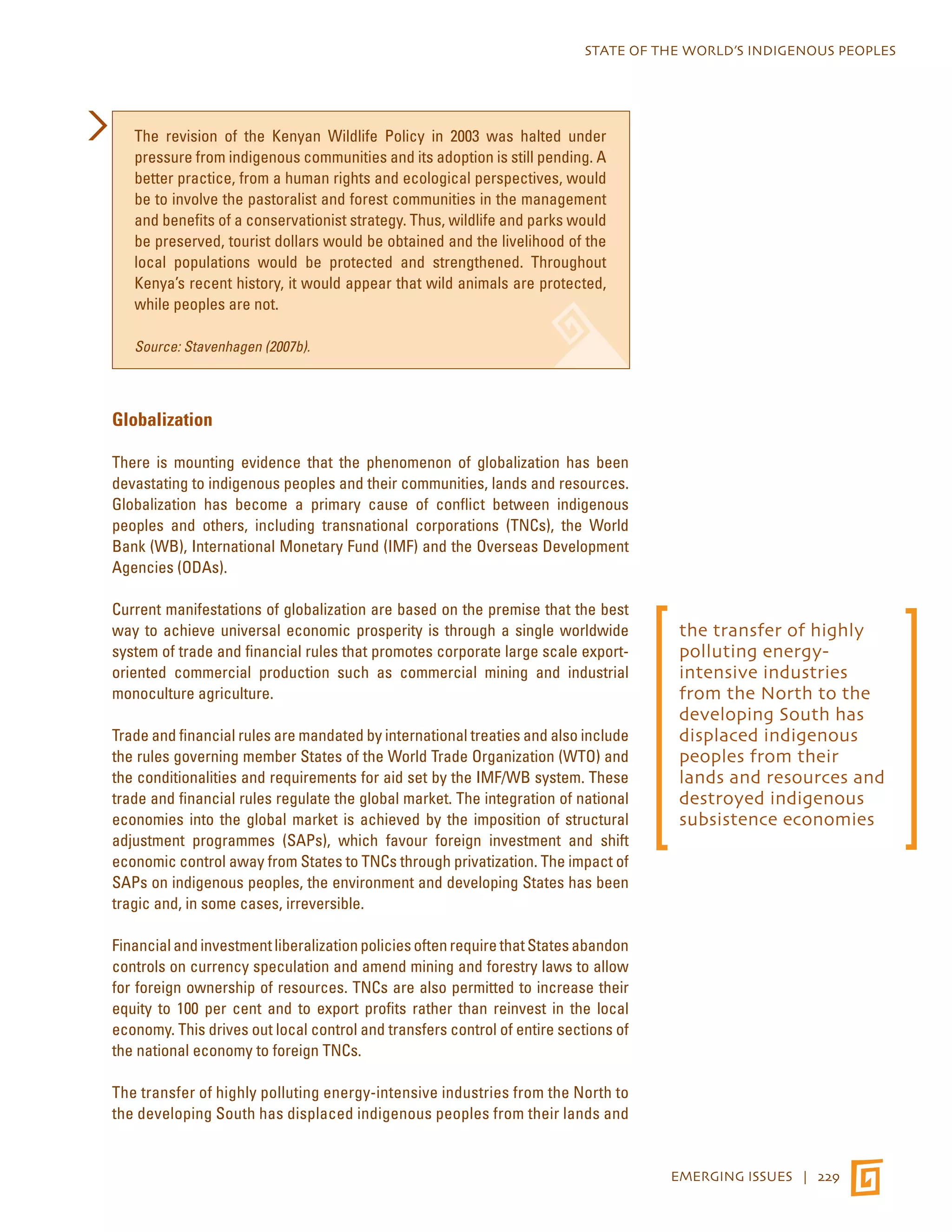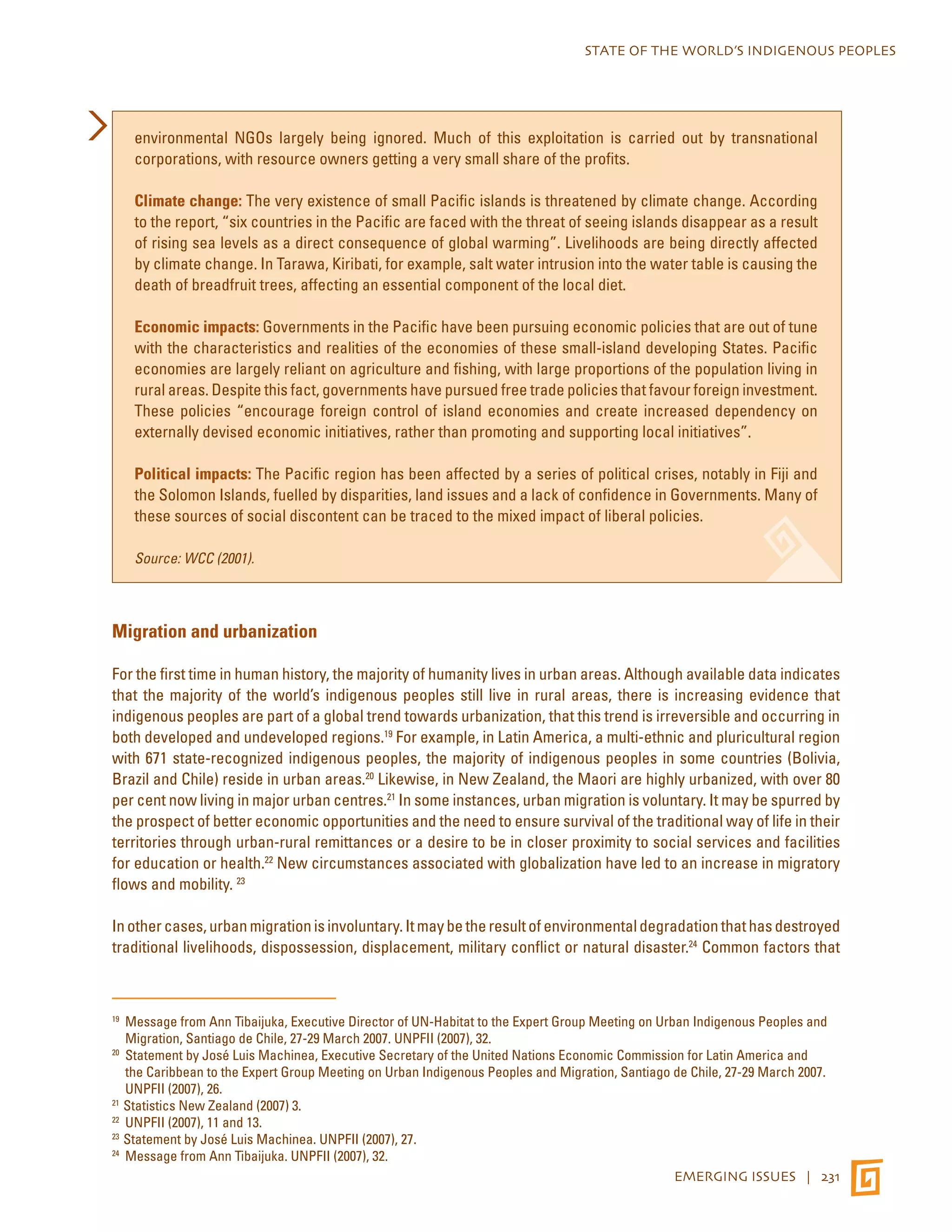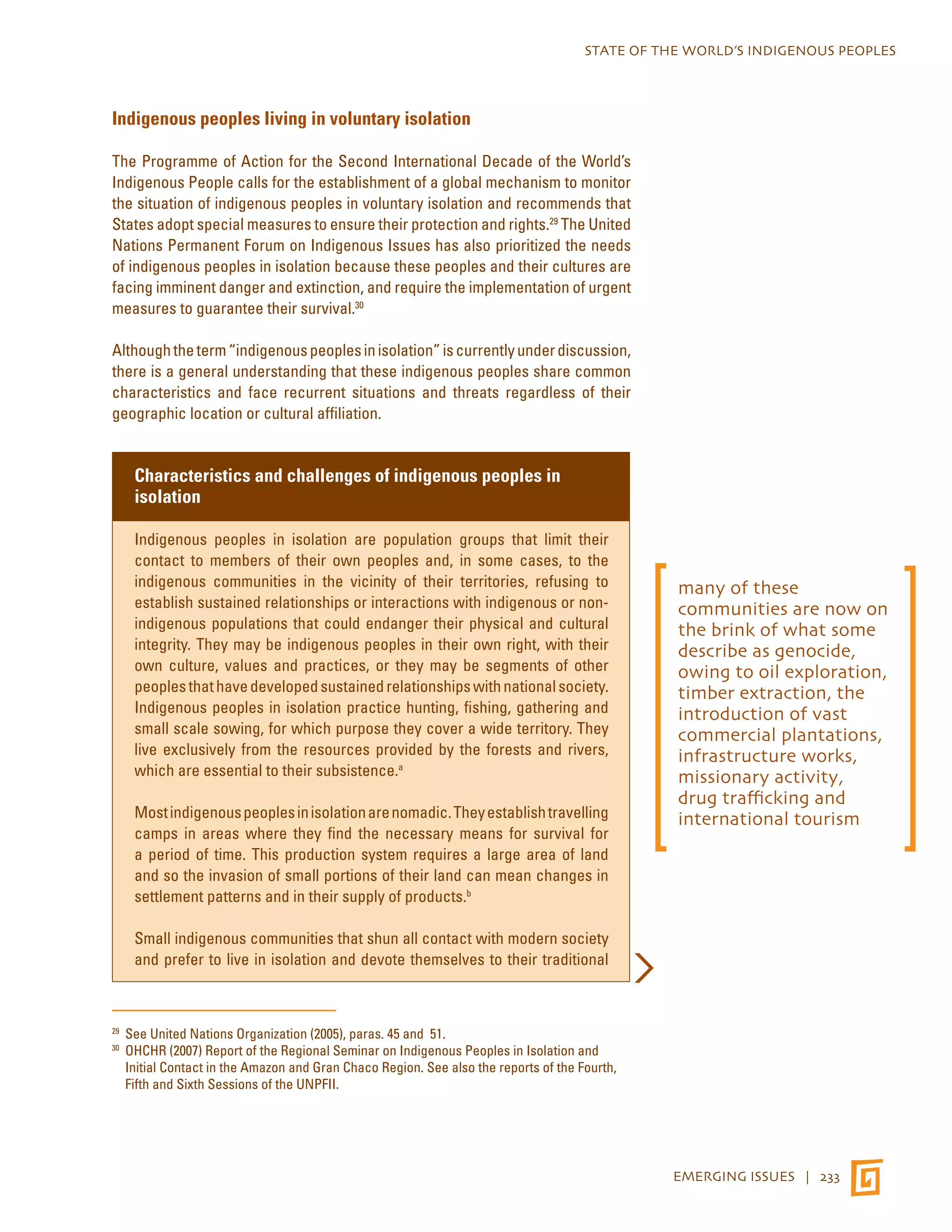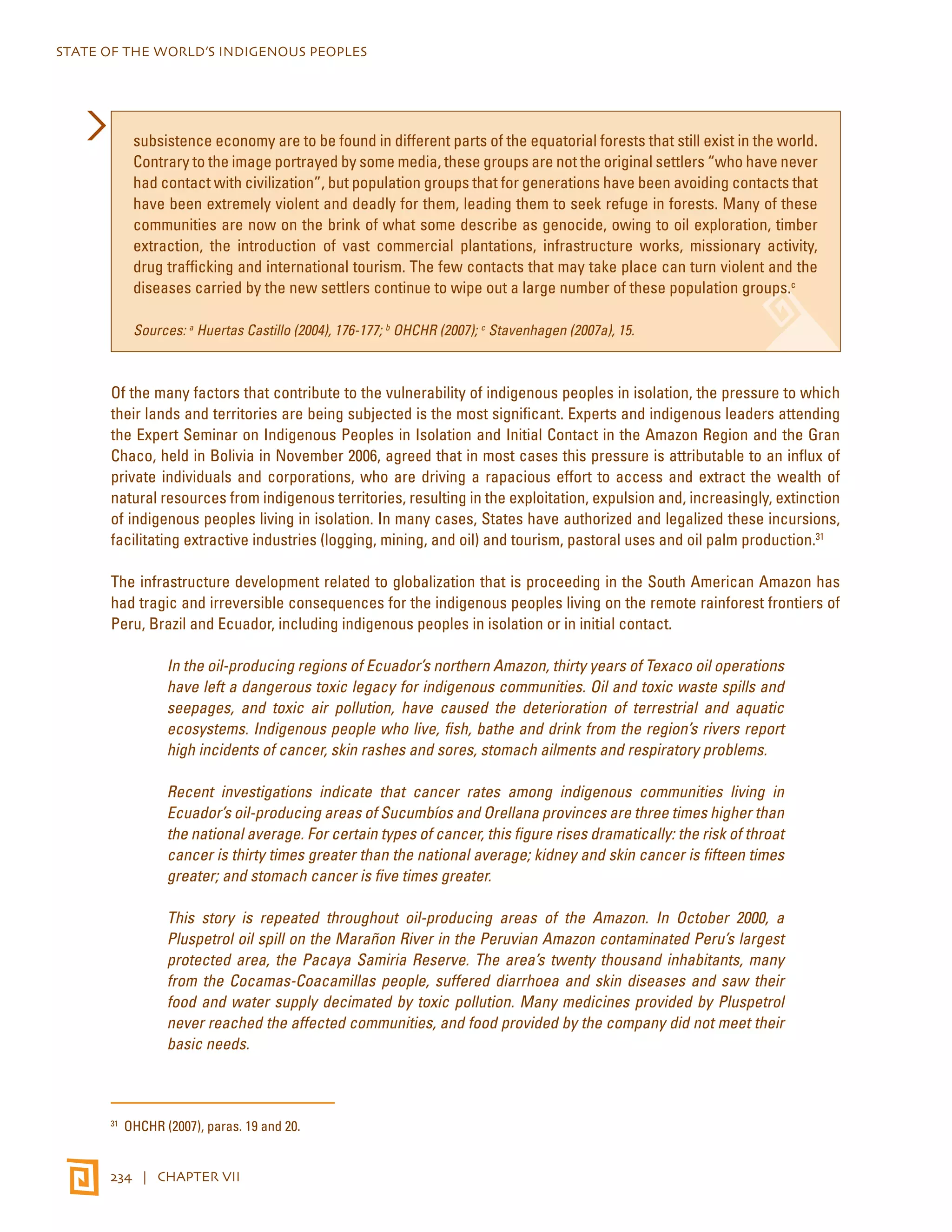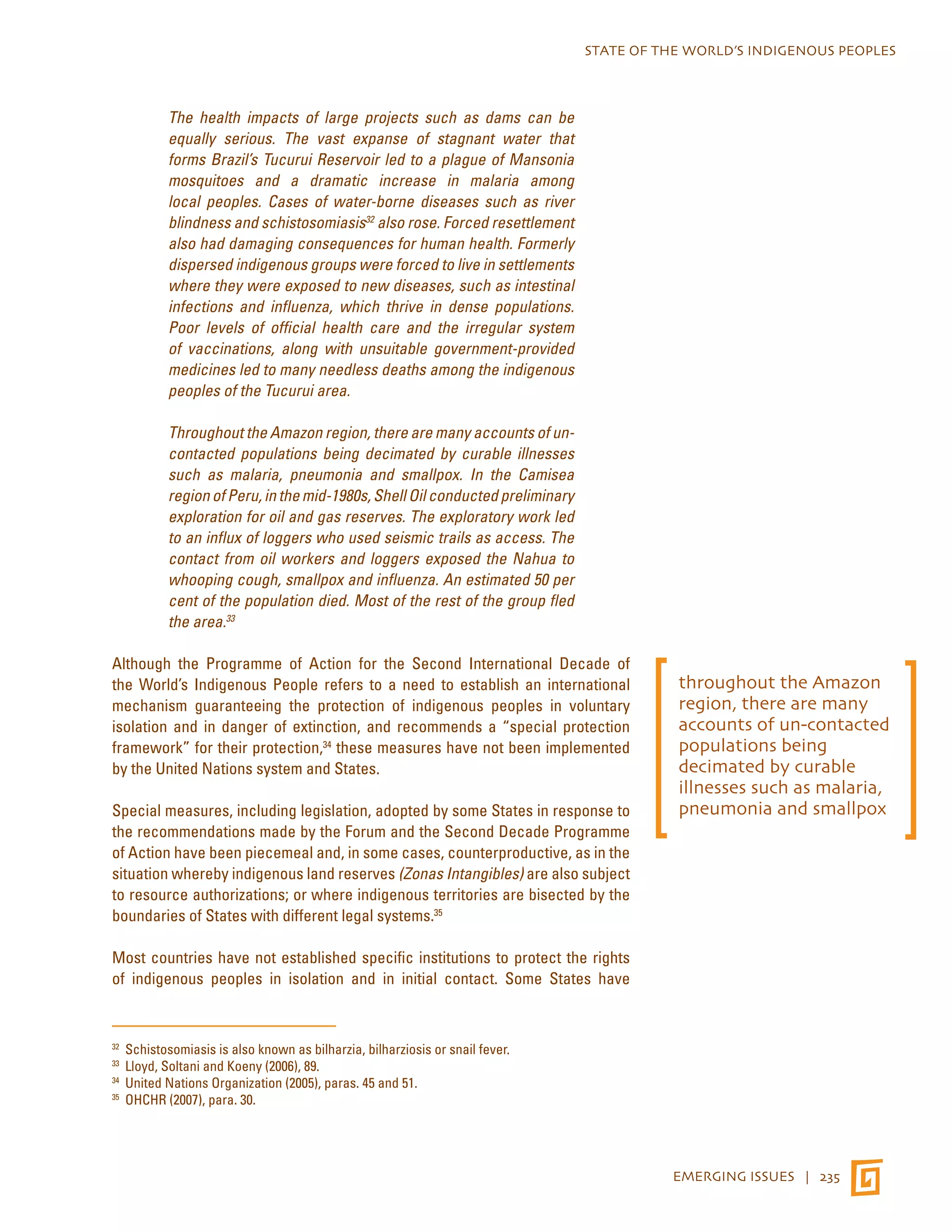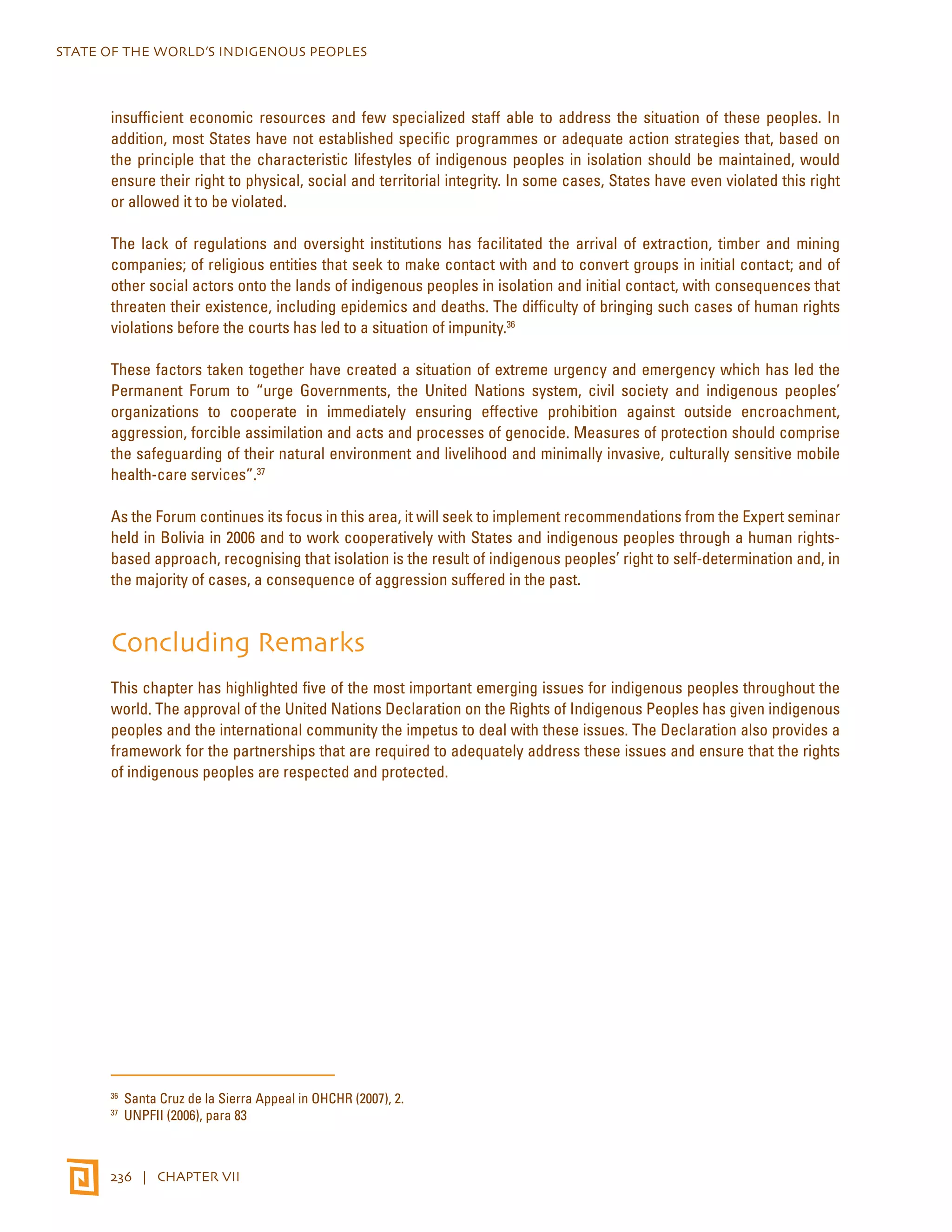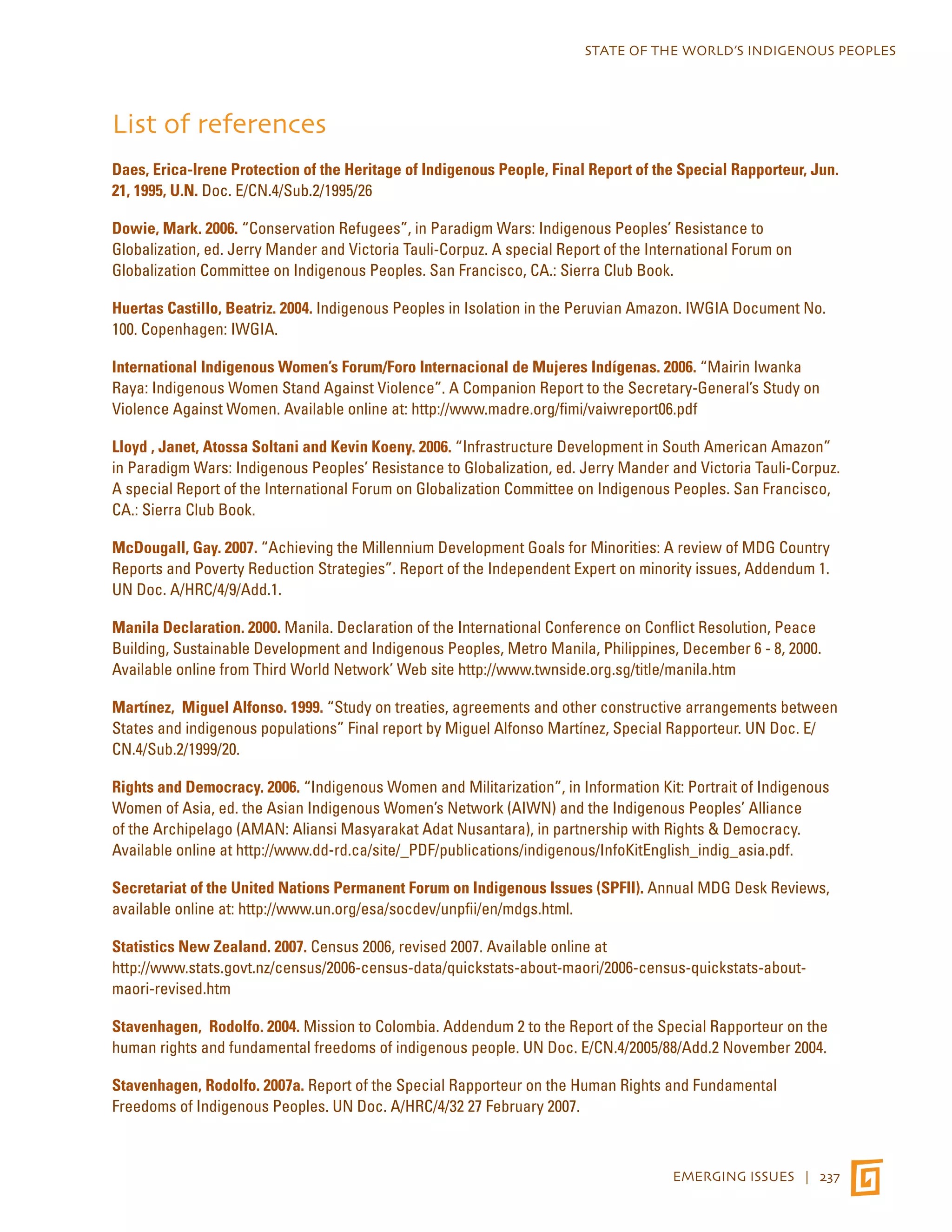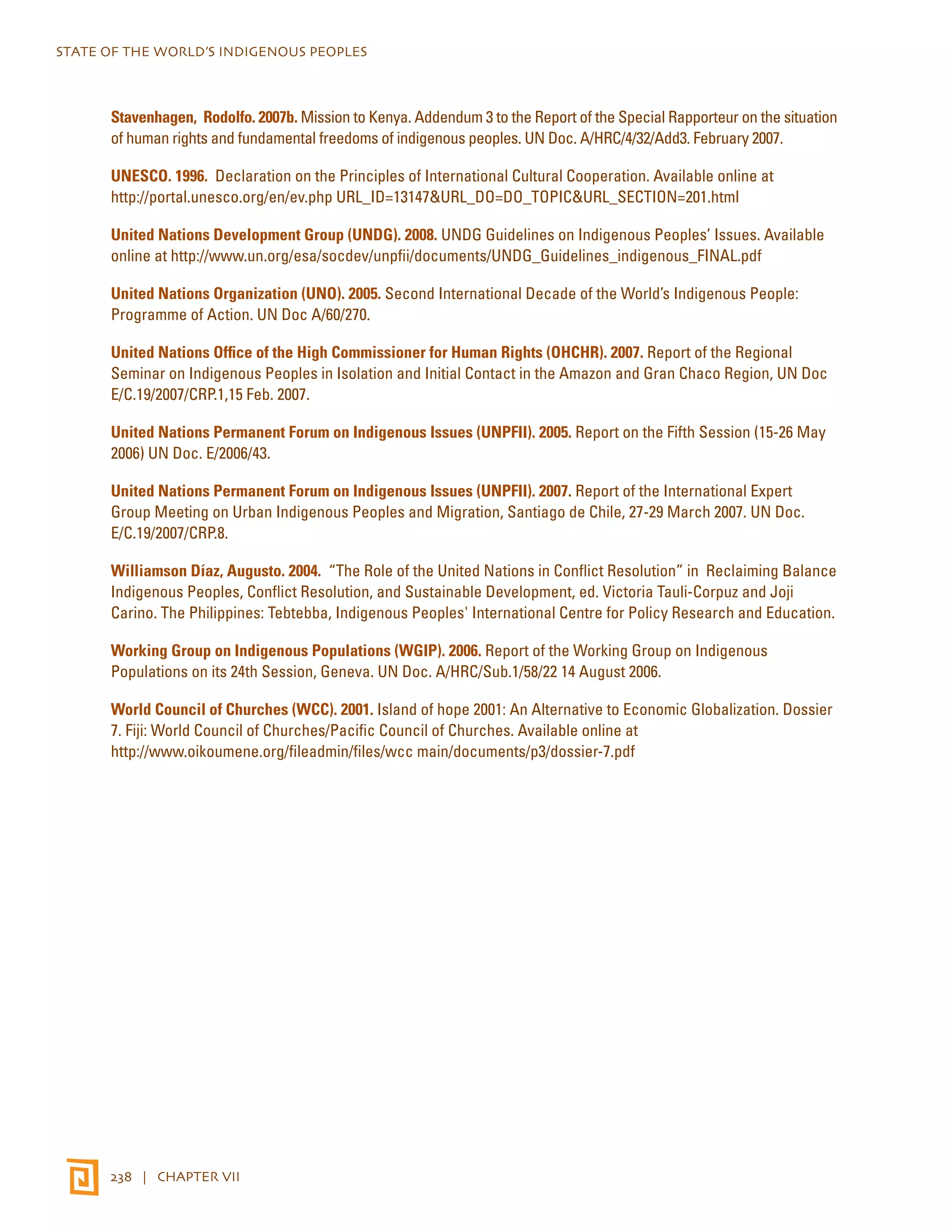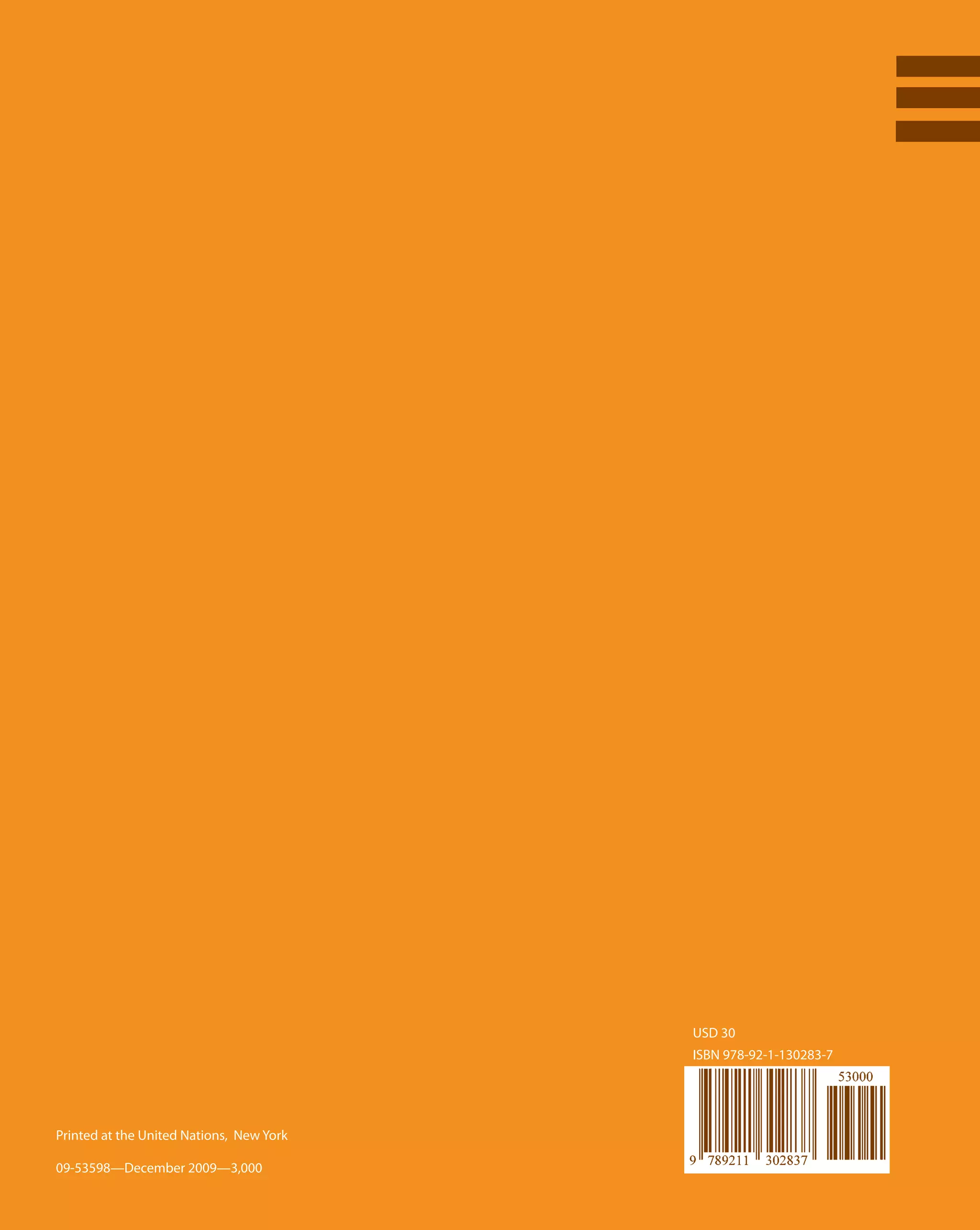This document provides an introduction to the State of the World's Indigenous Peoples report. It discusses the history of indigenous issues at the international level and the concept of indigenous peoples. It notes that while progress has been made, indigenous peoples still face challenges including discrimination, poverty and human rights issues. The introduction outlines the structure of the report and provides an overview of key international responses to indigenous issues.
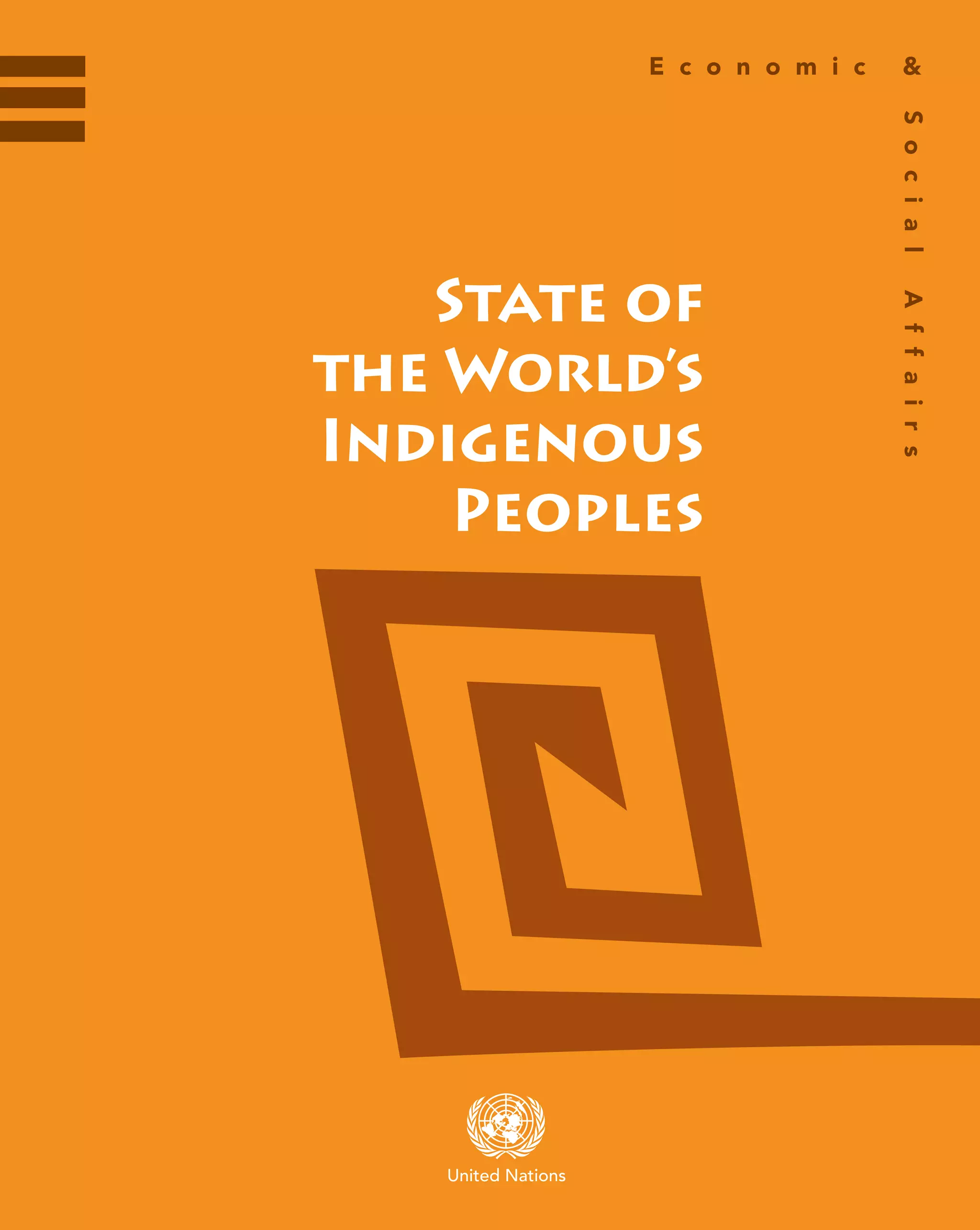
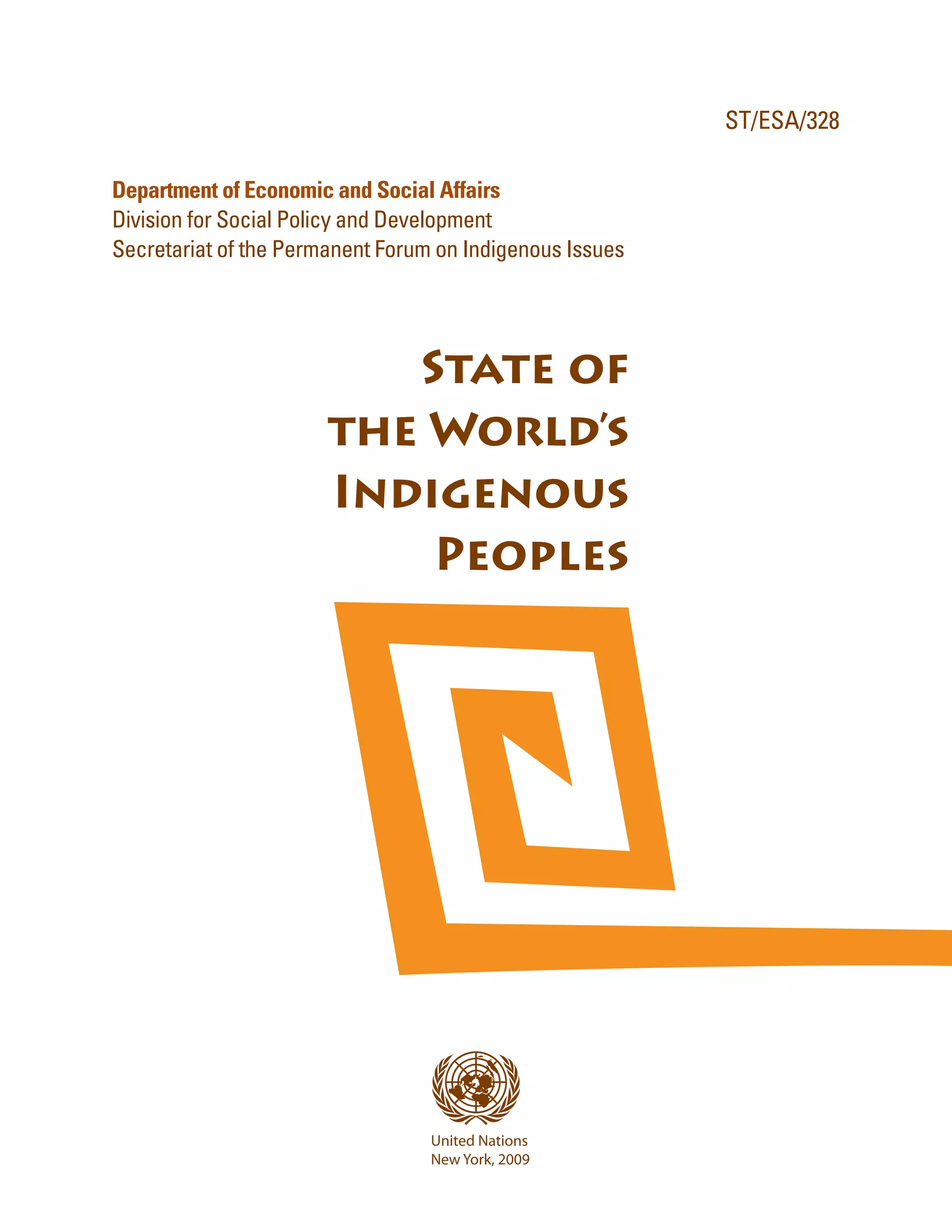
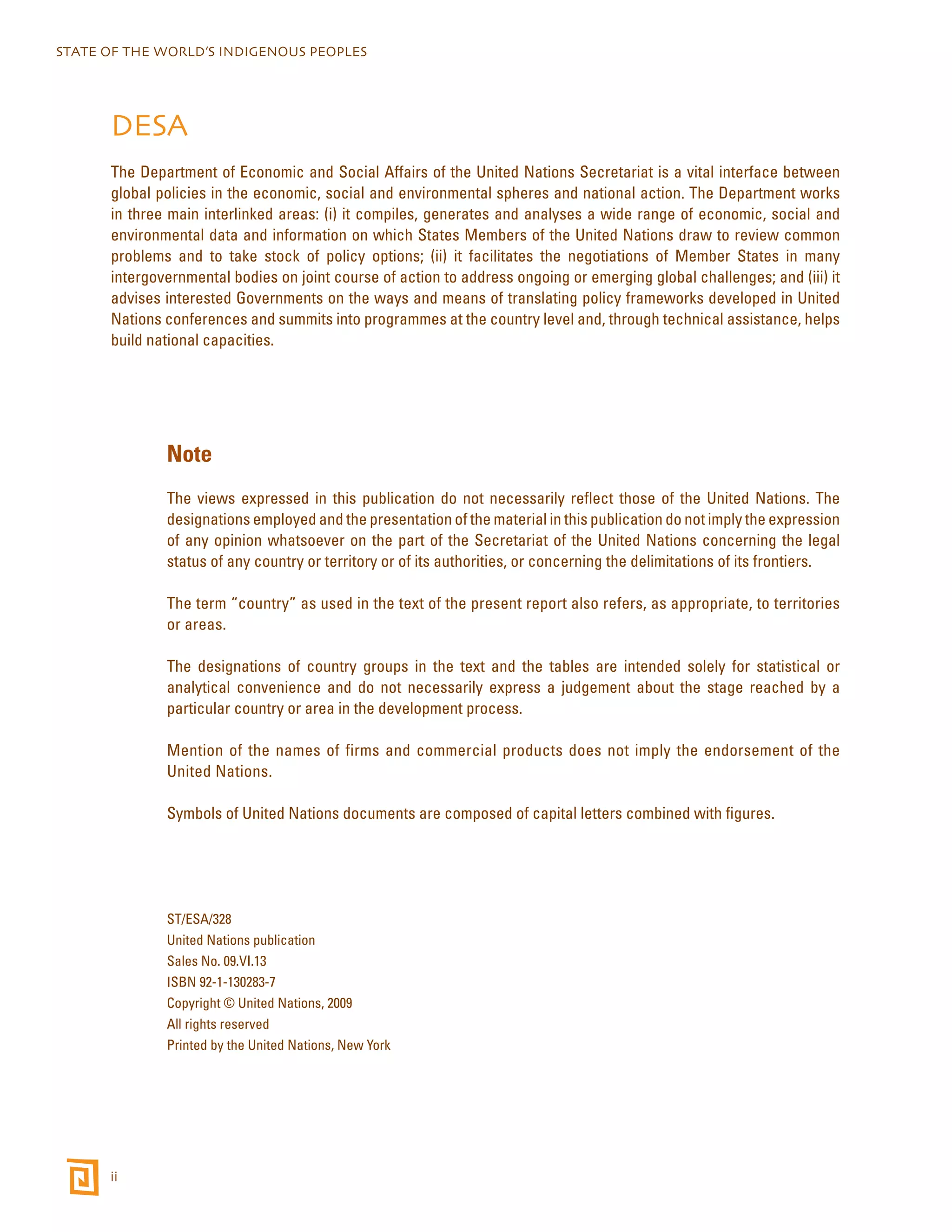


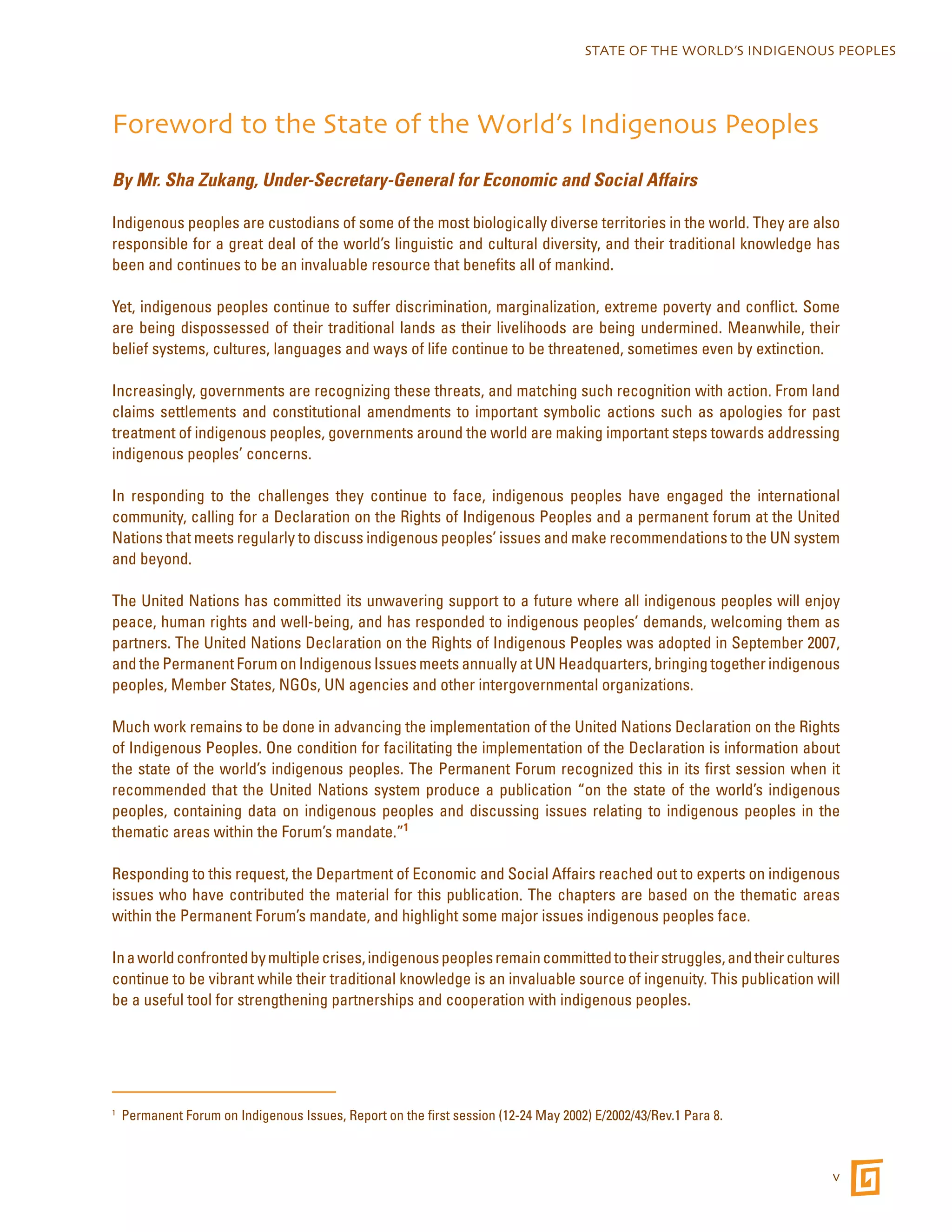

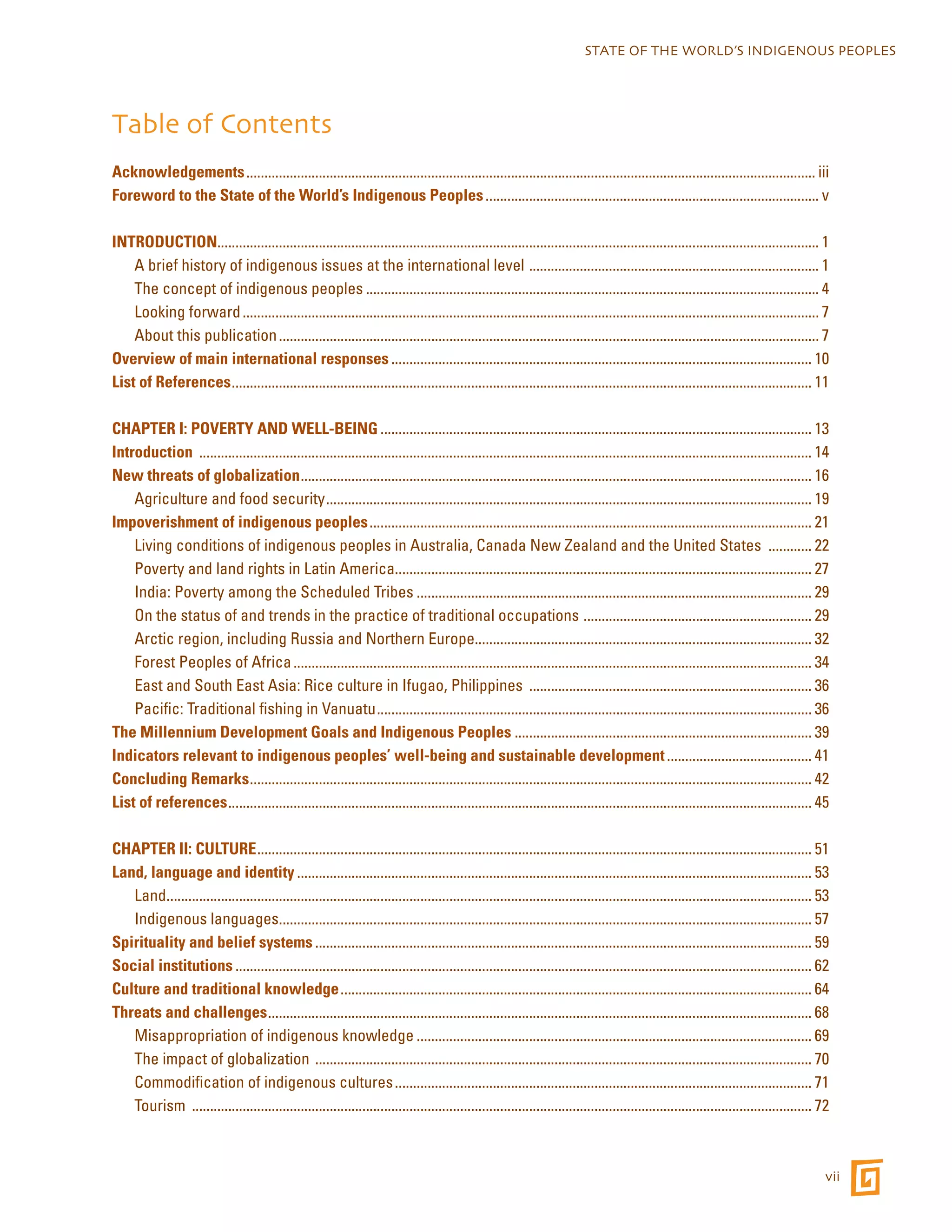
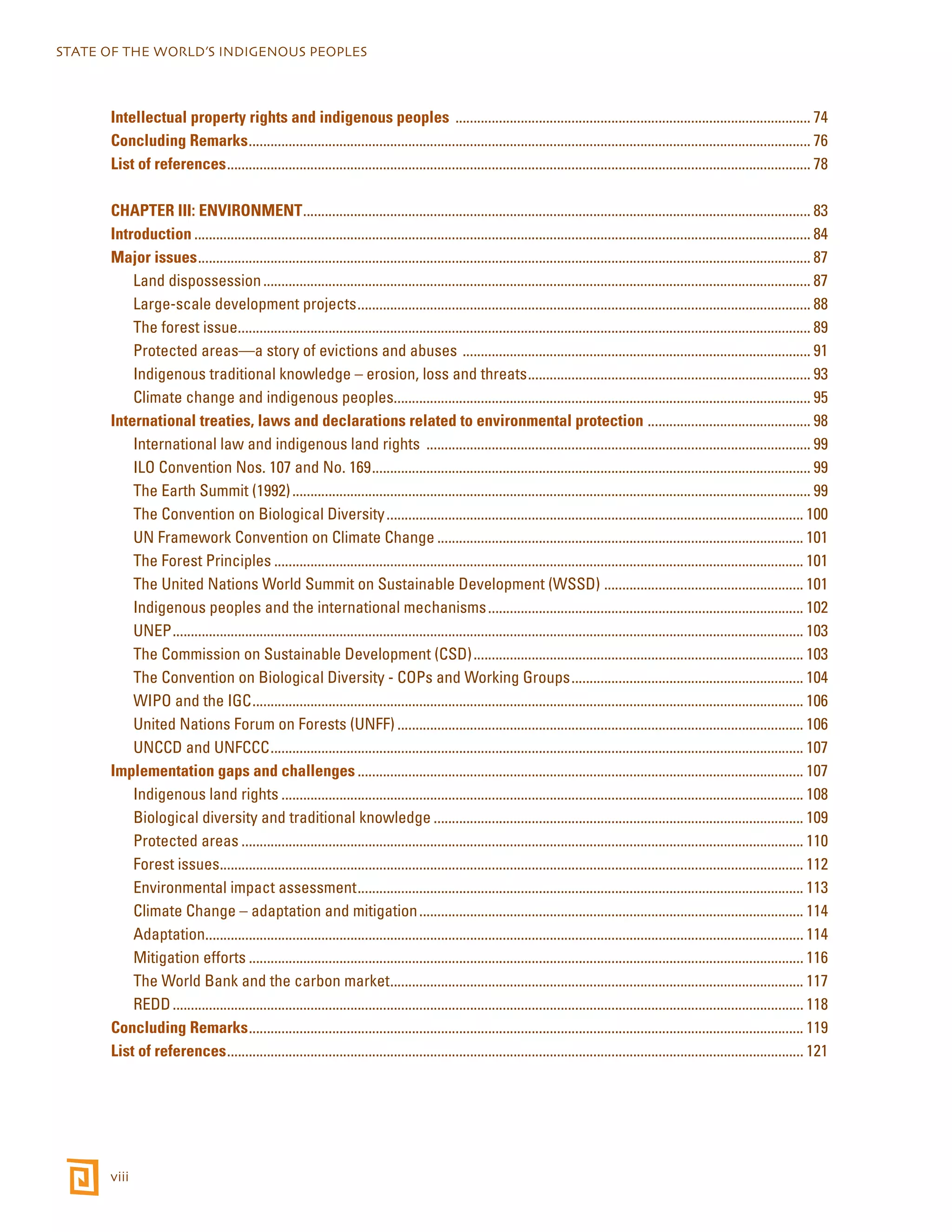
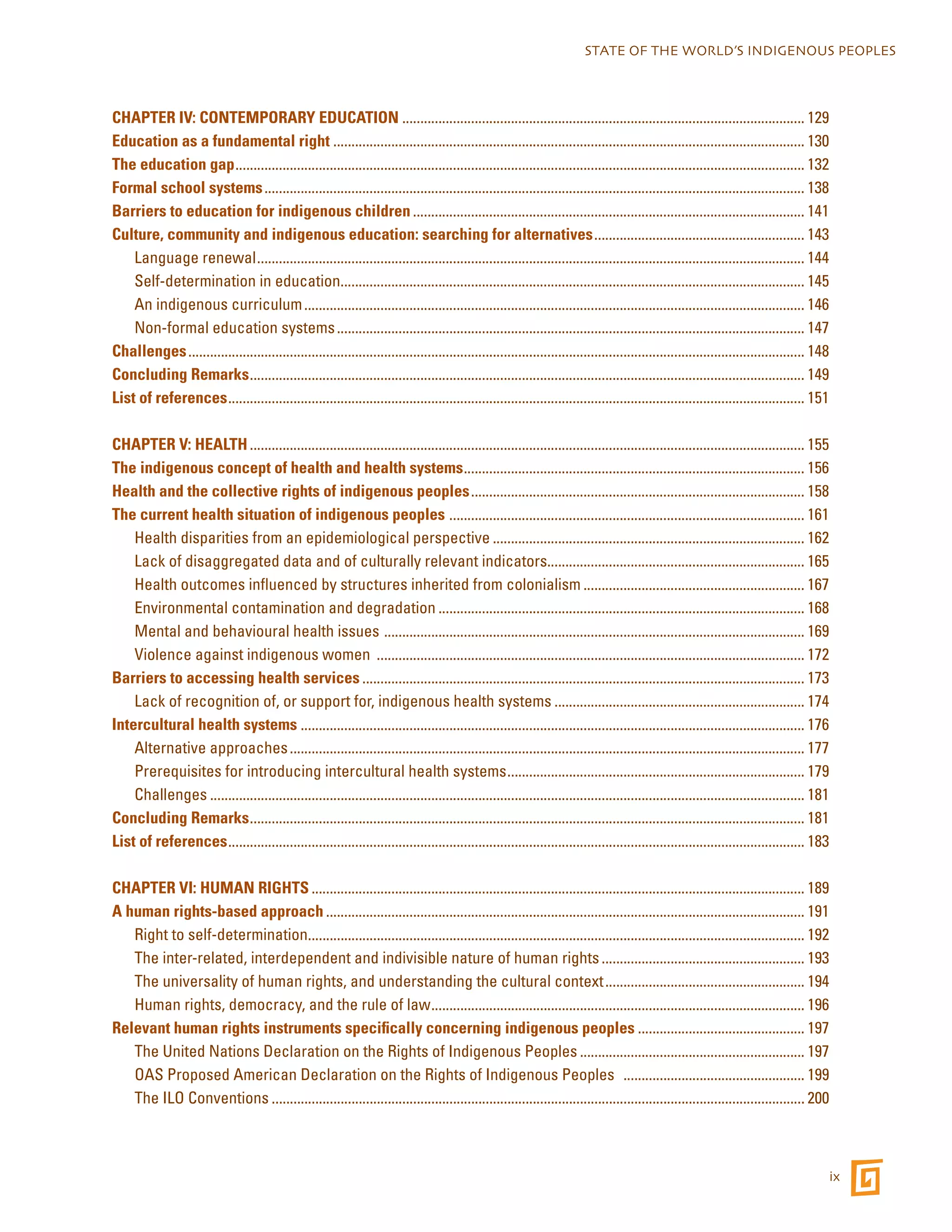
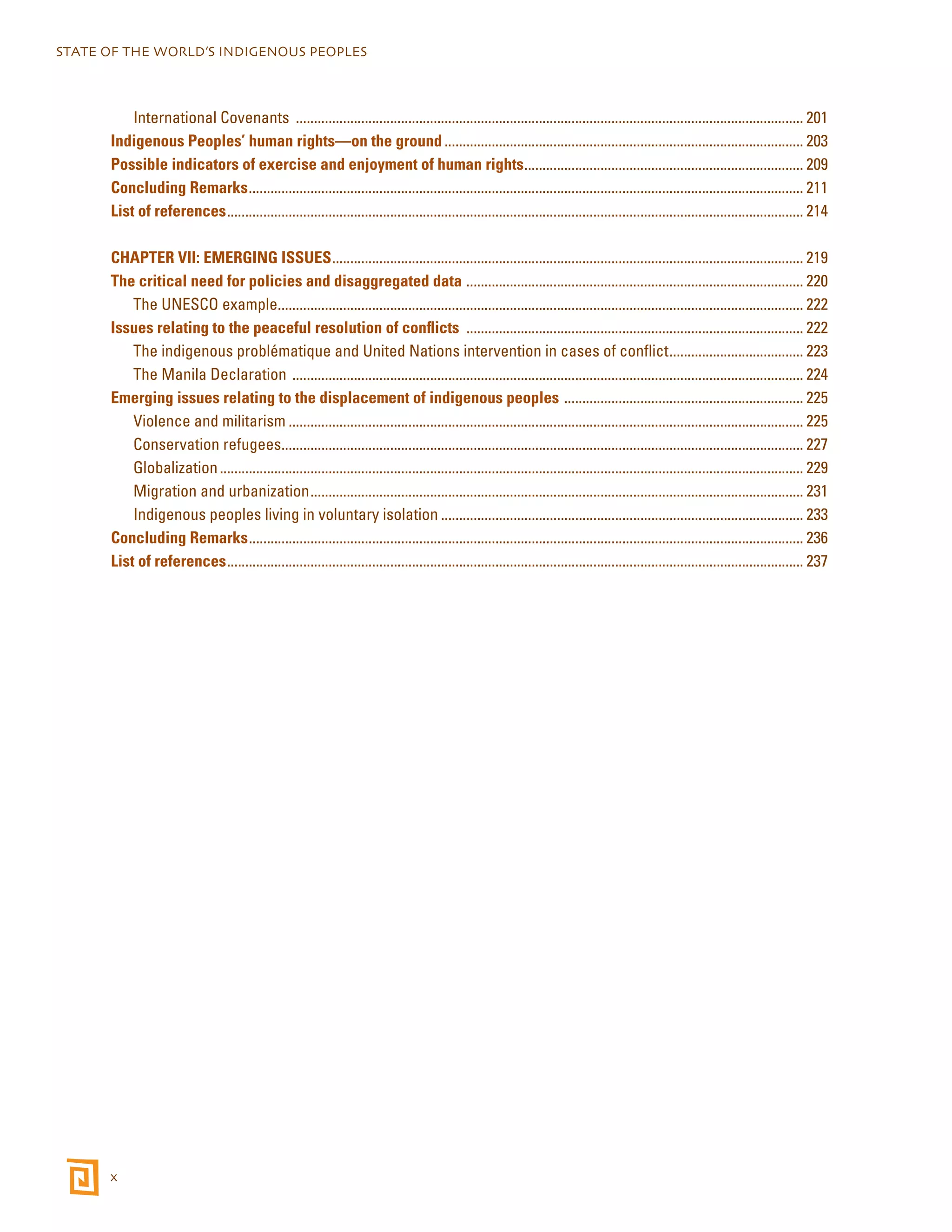
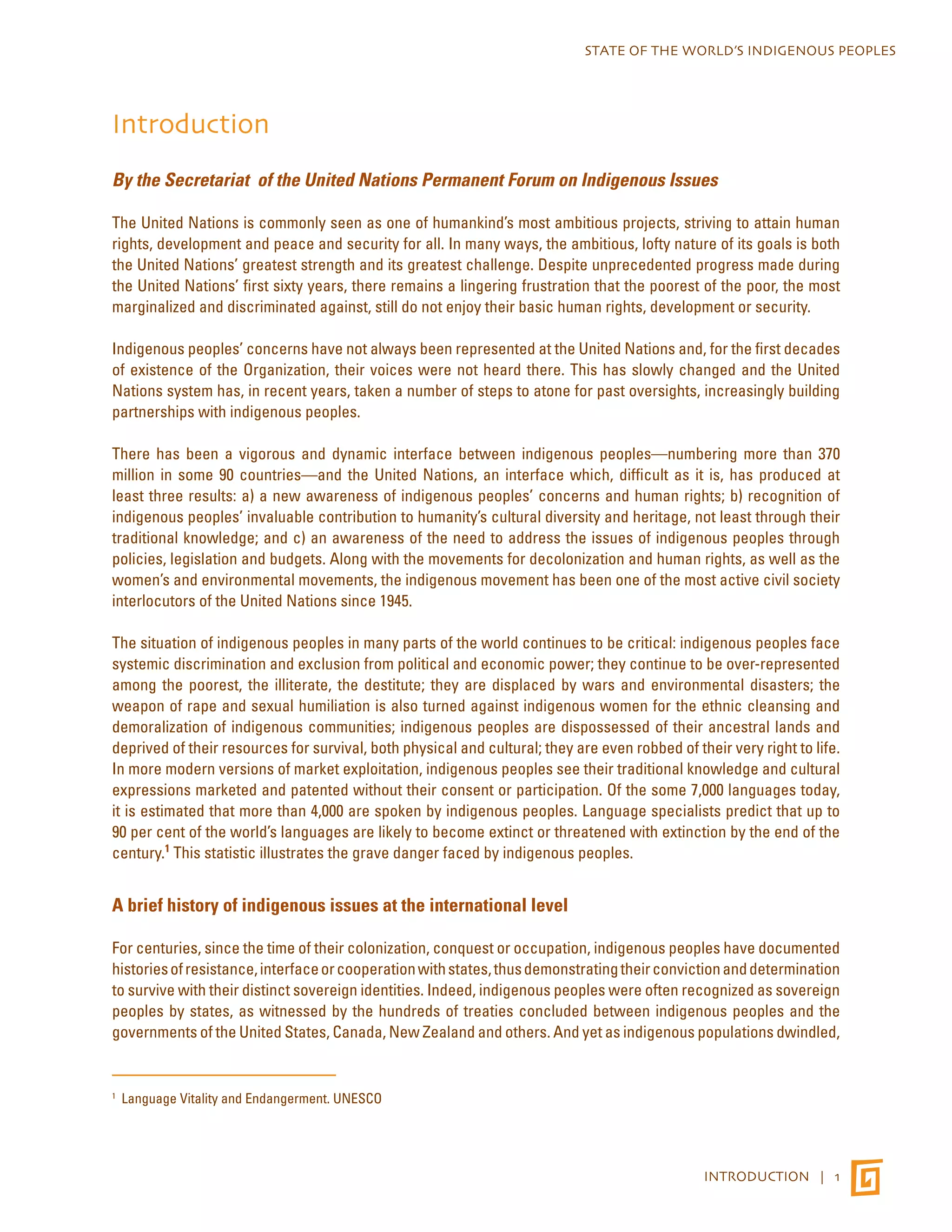
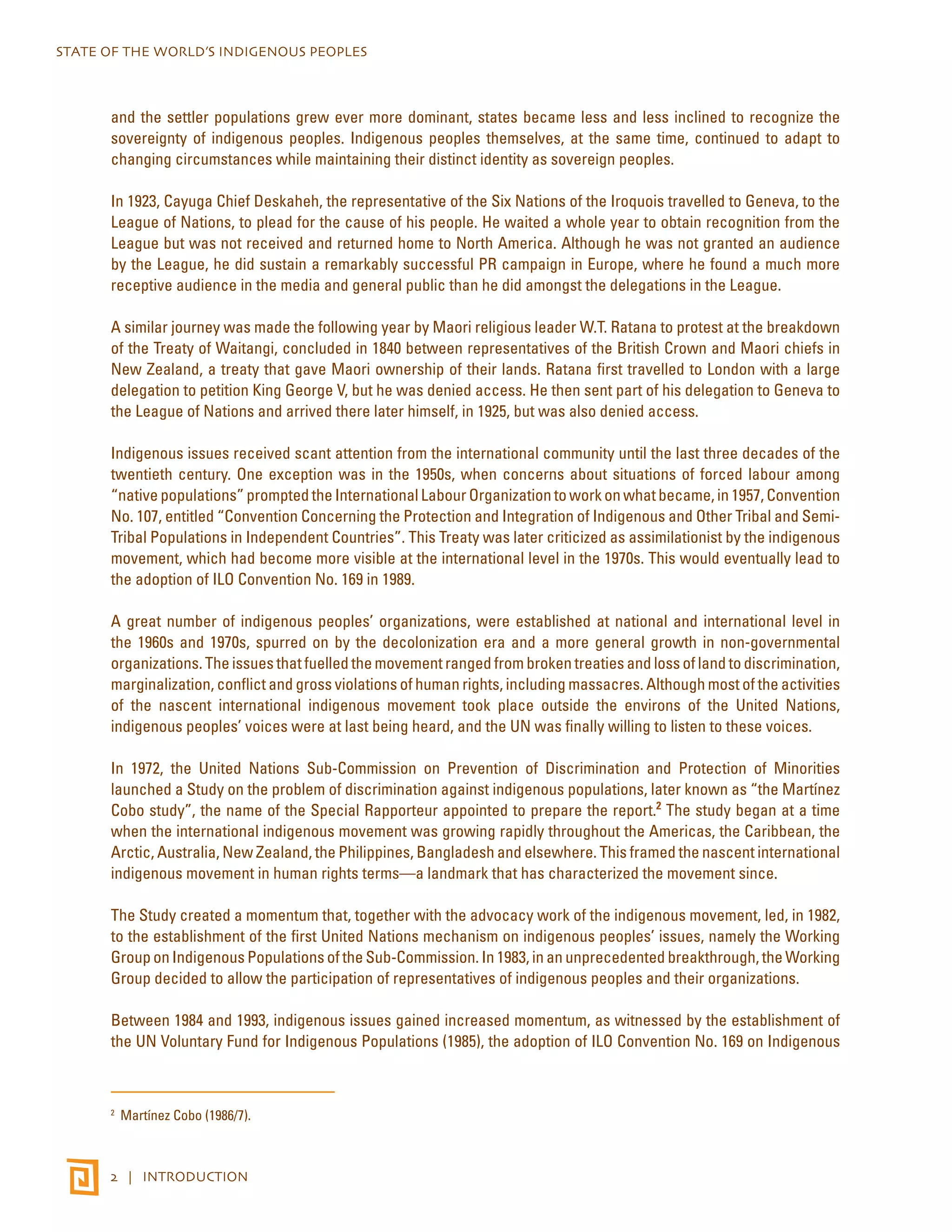


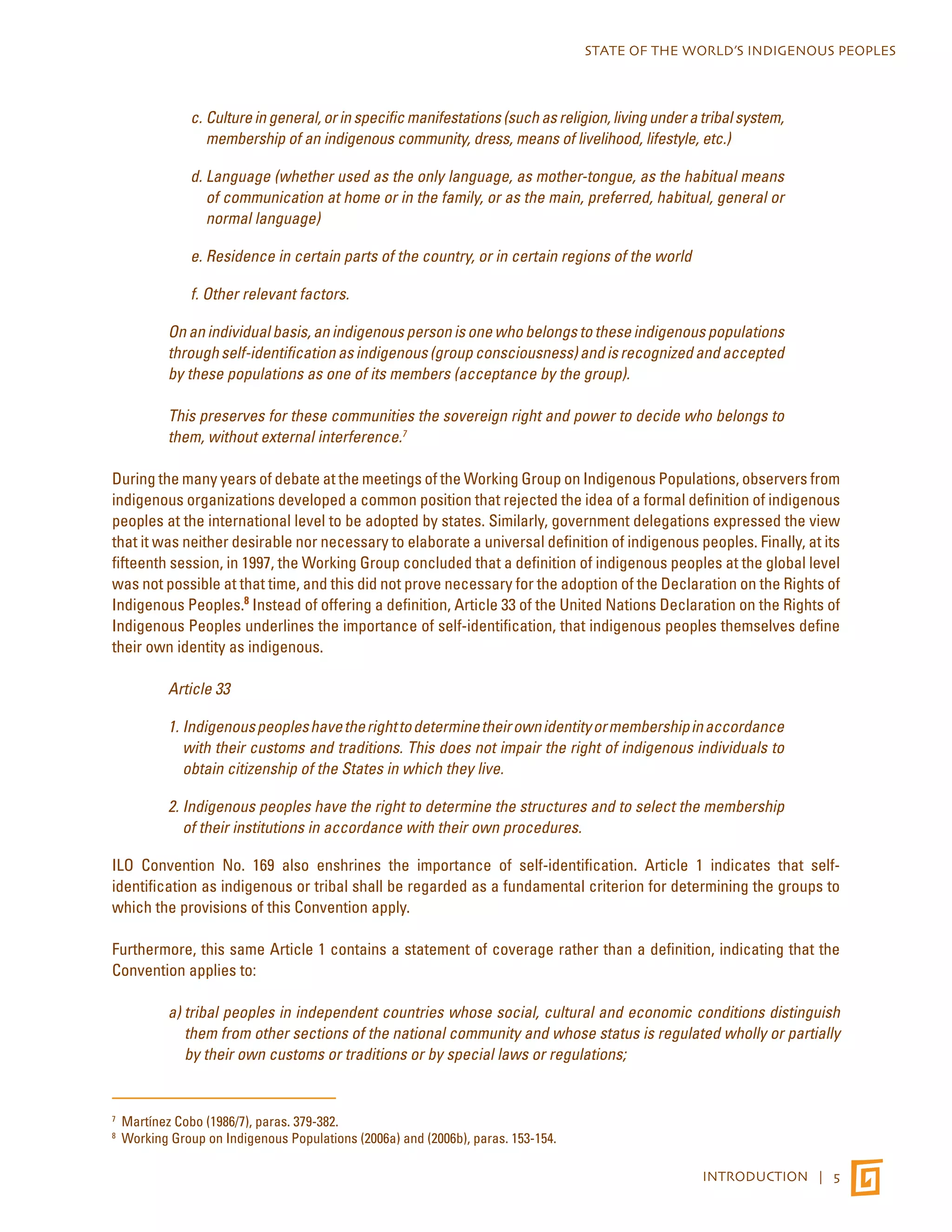
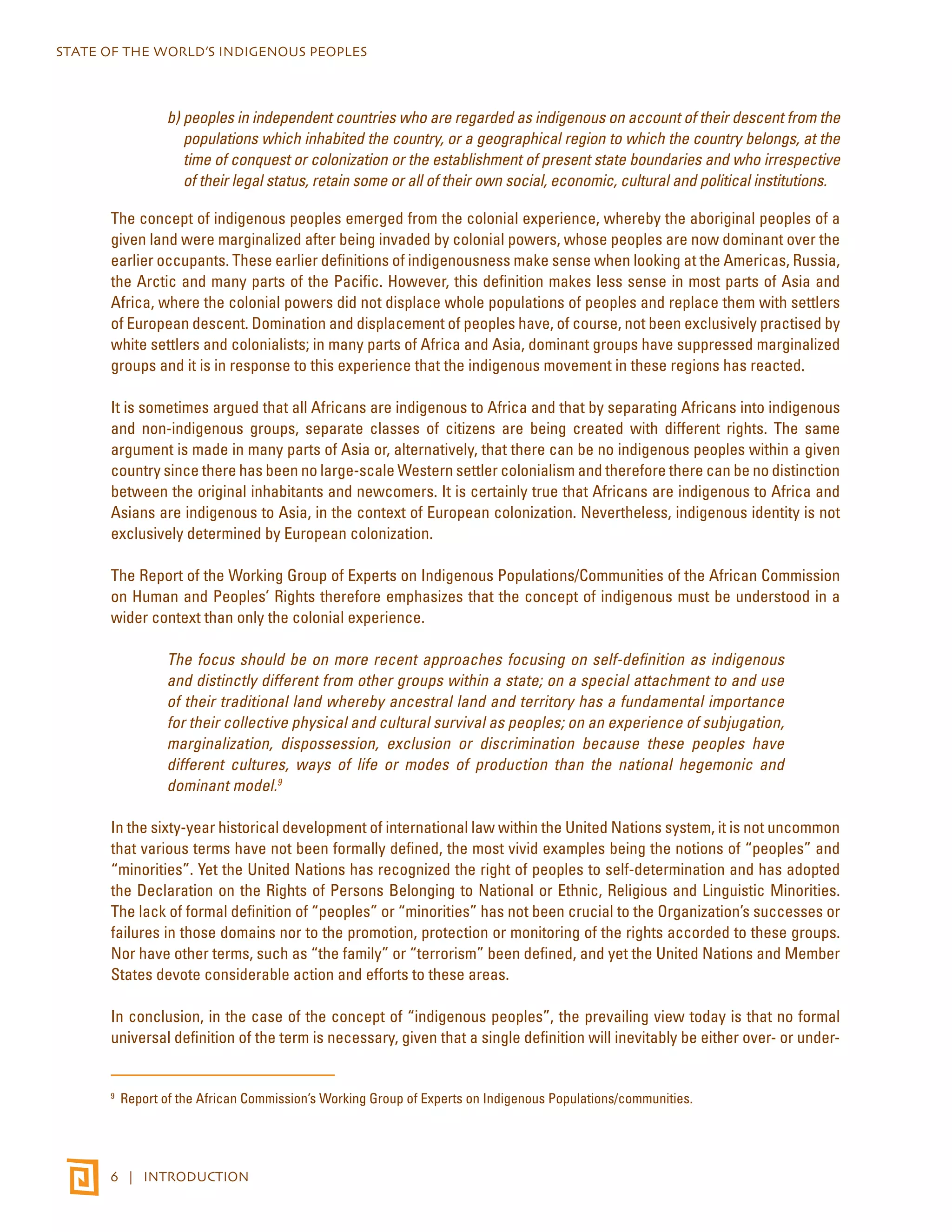
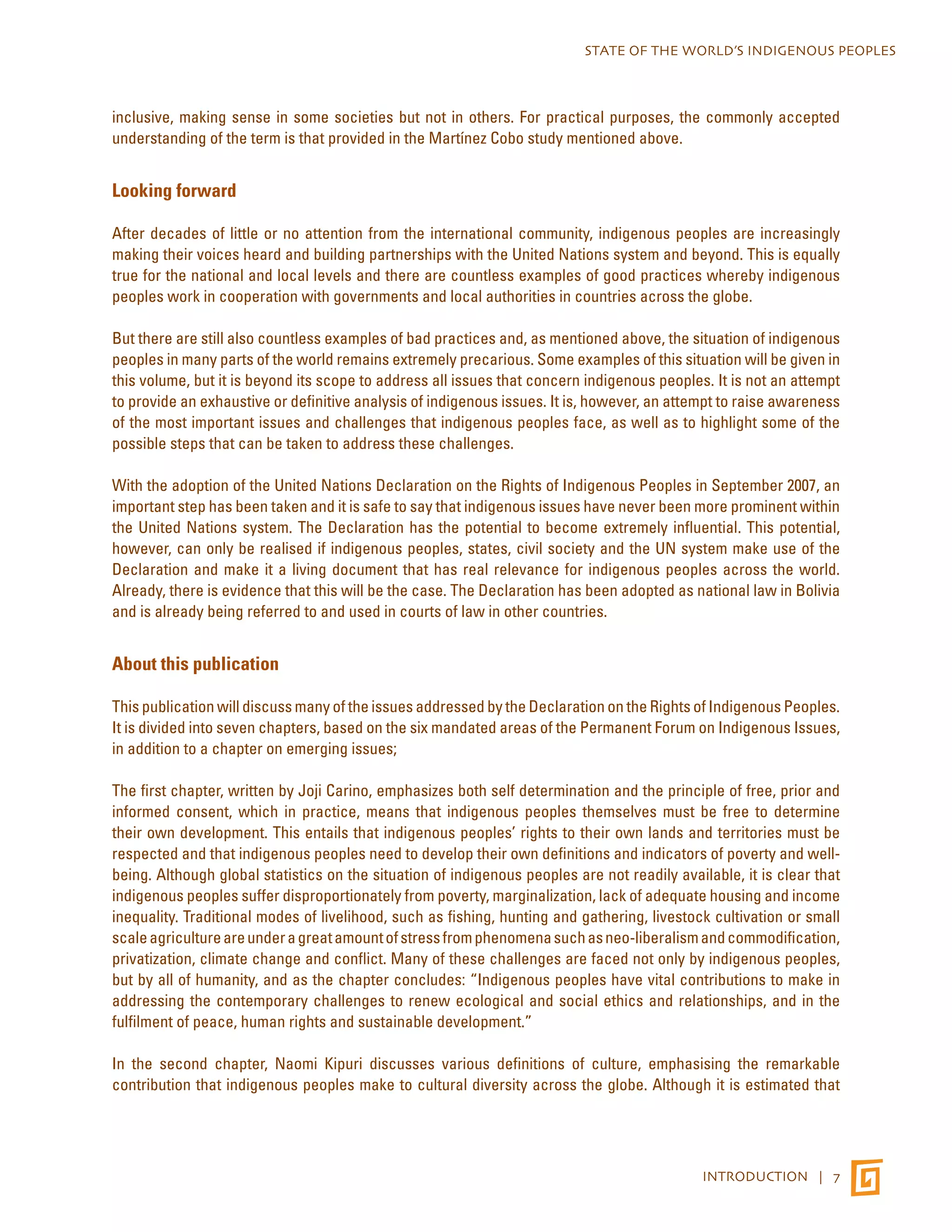
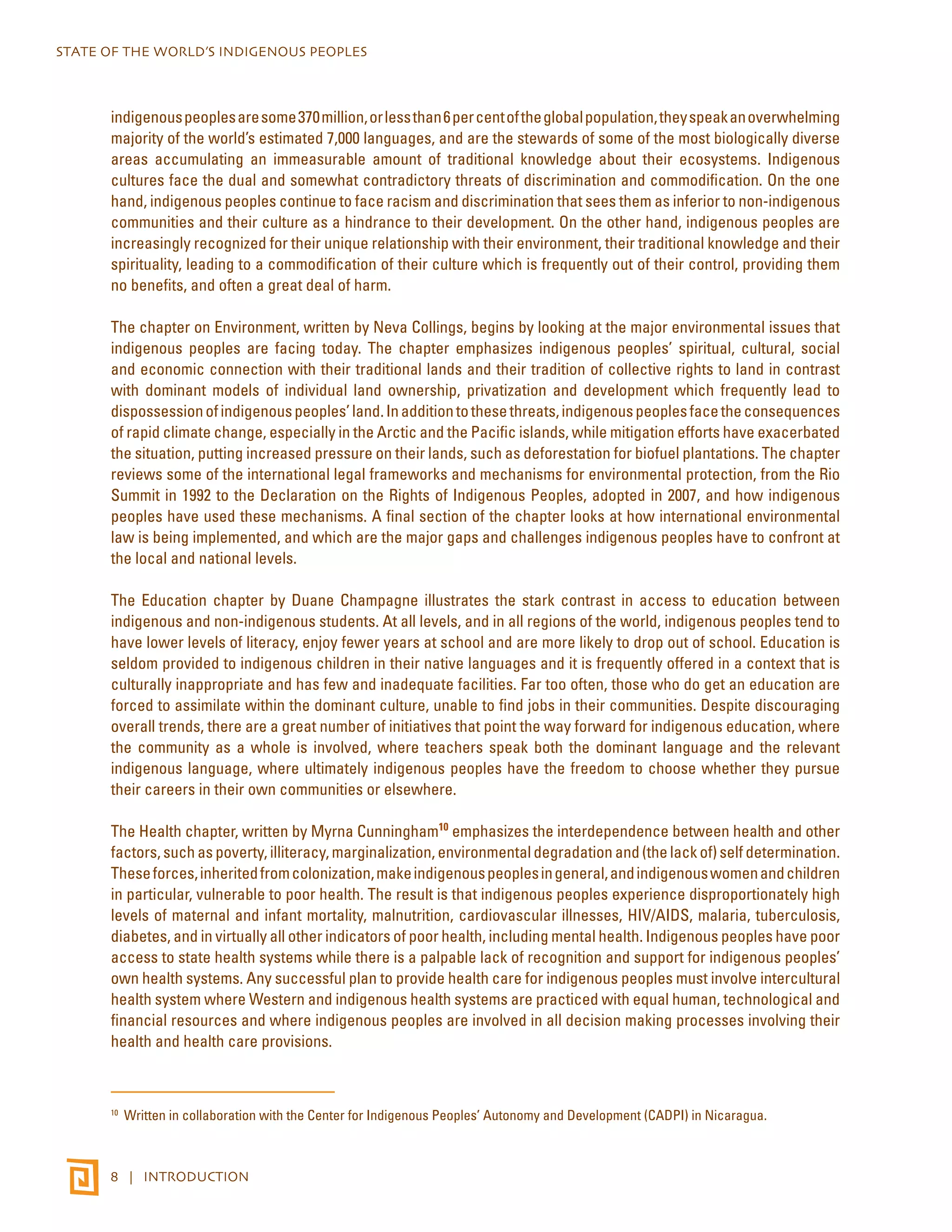
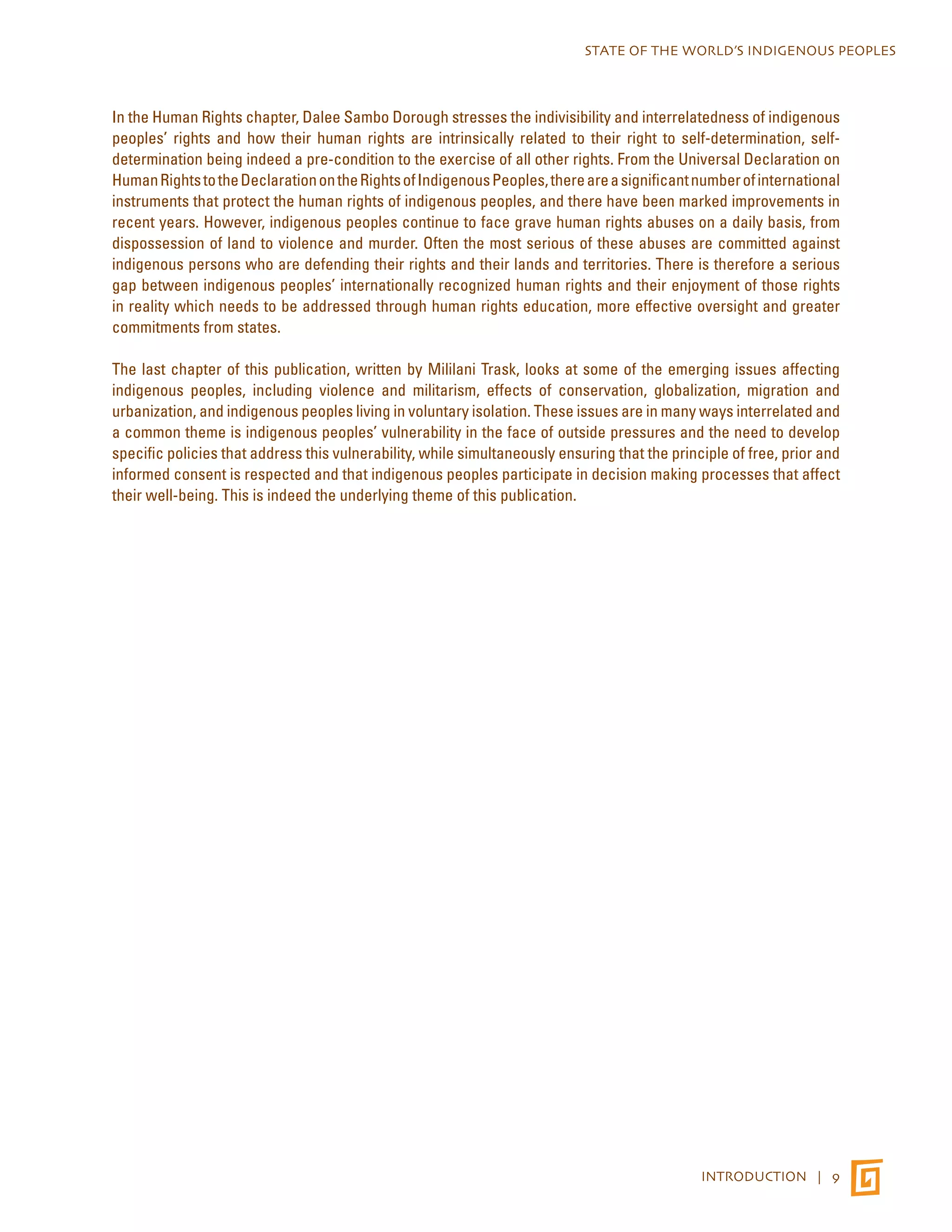
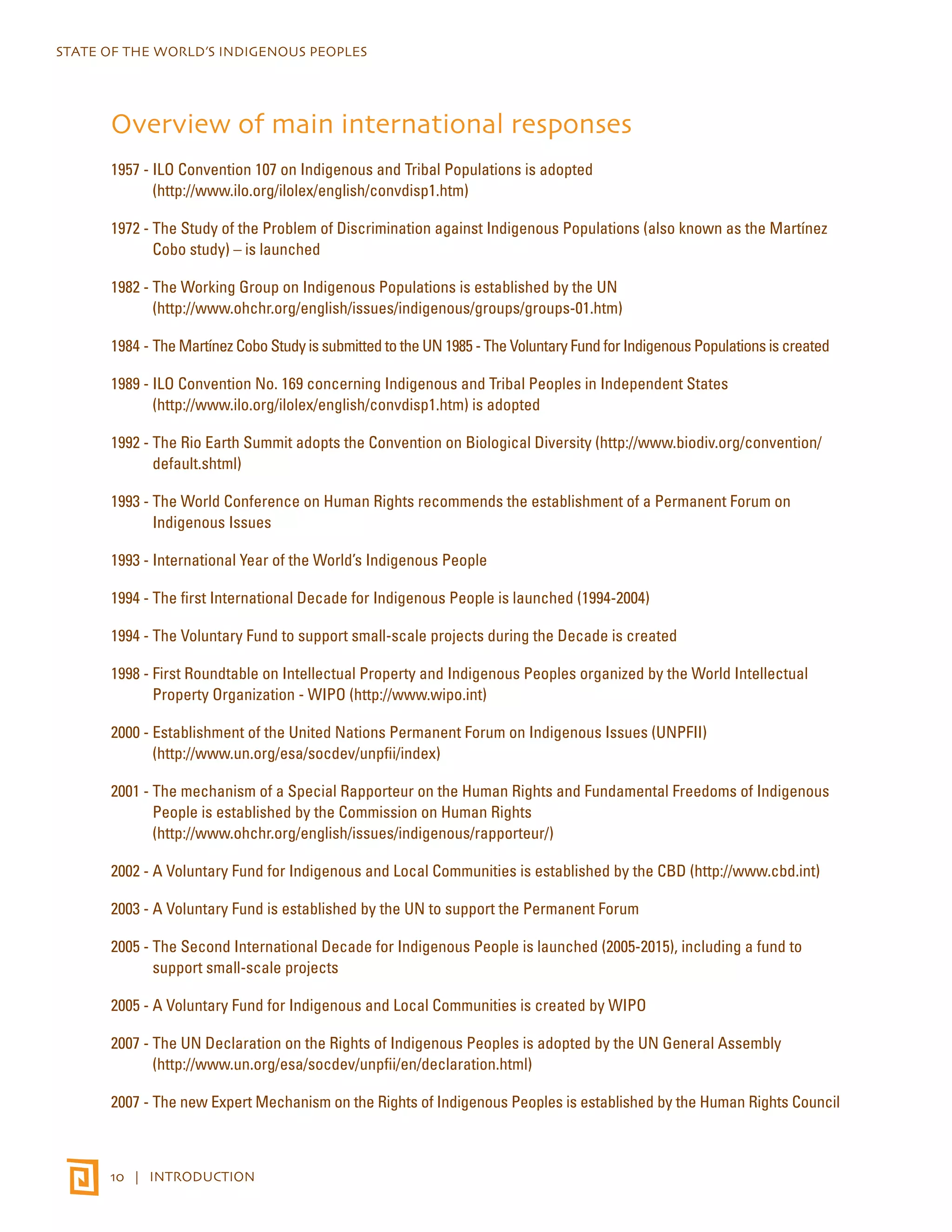
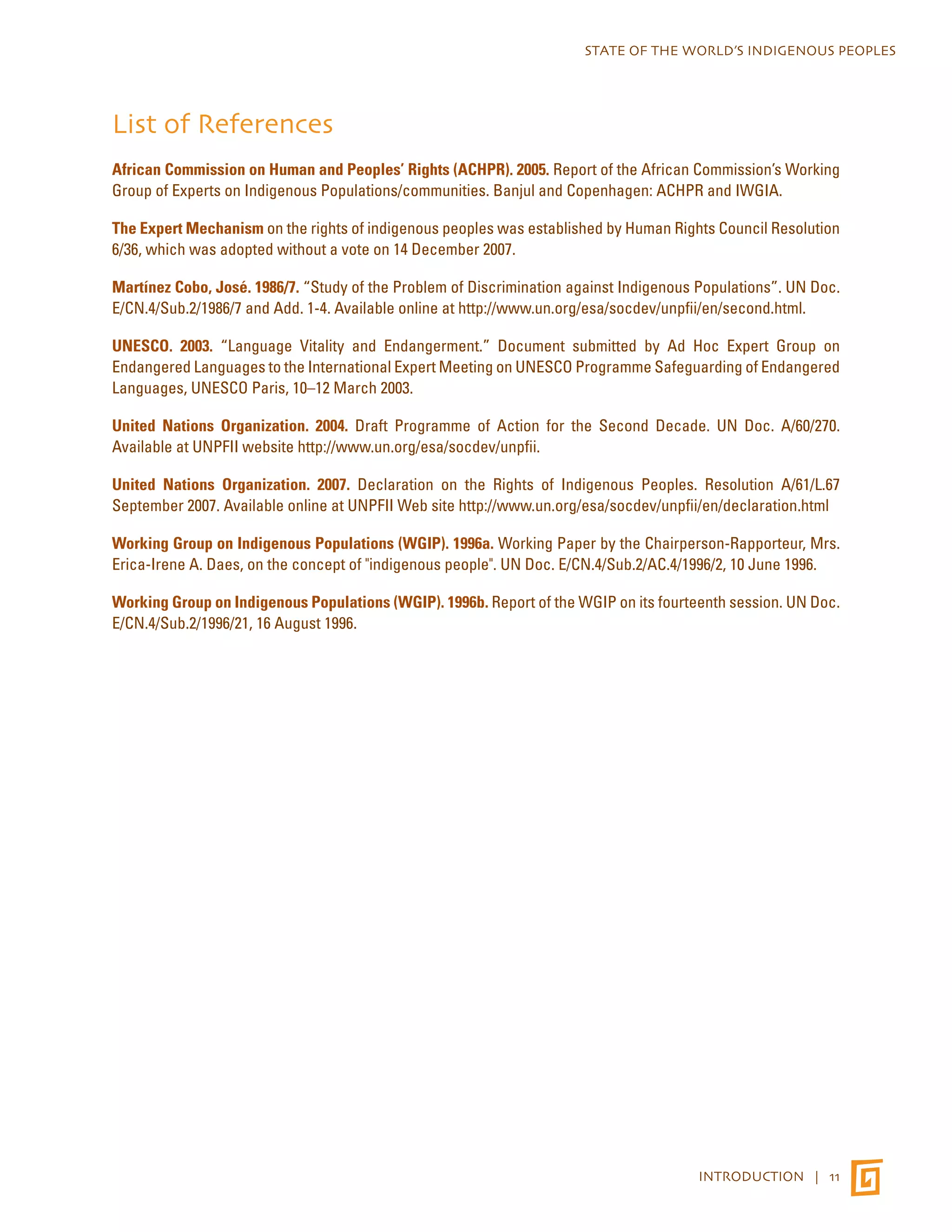

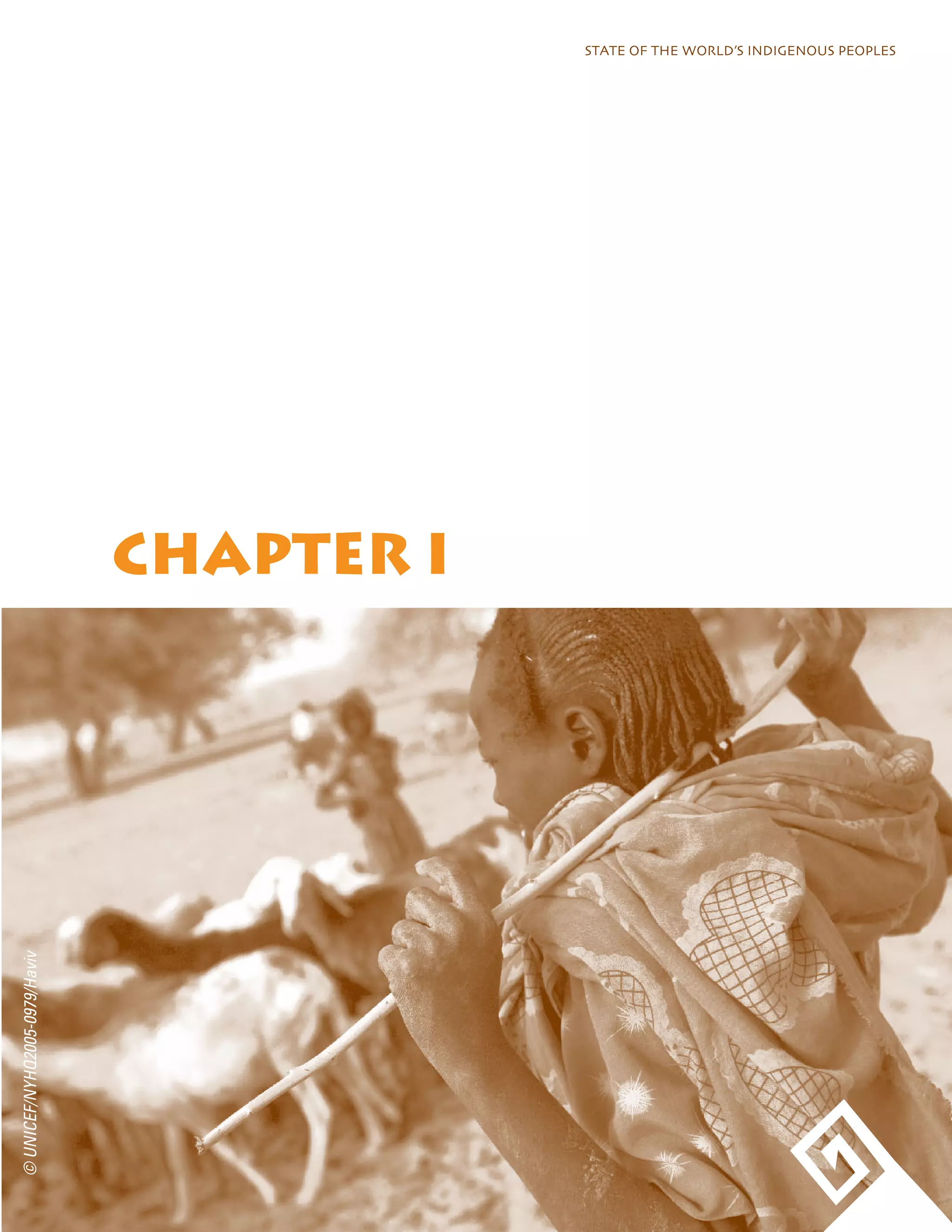
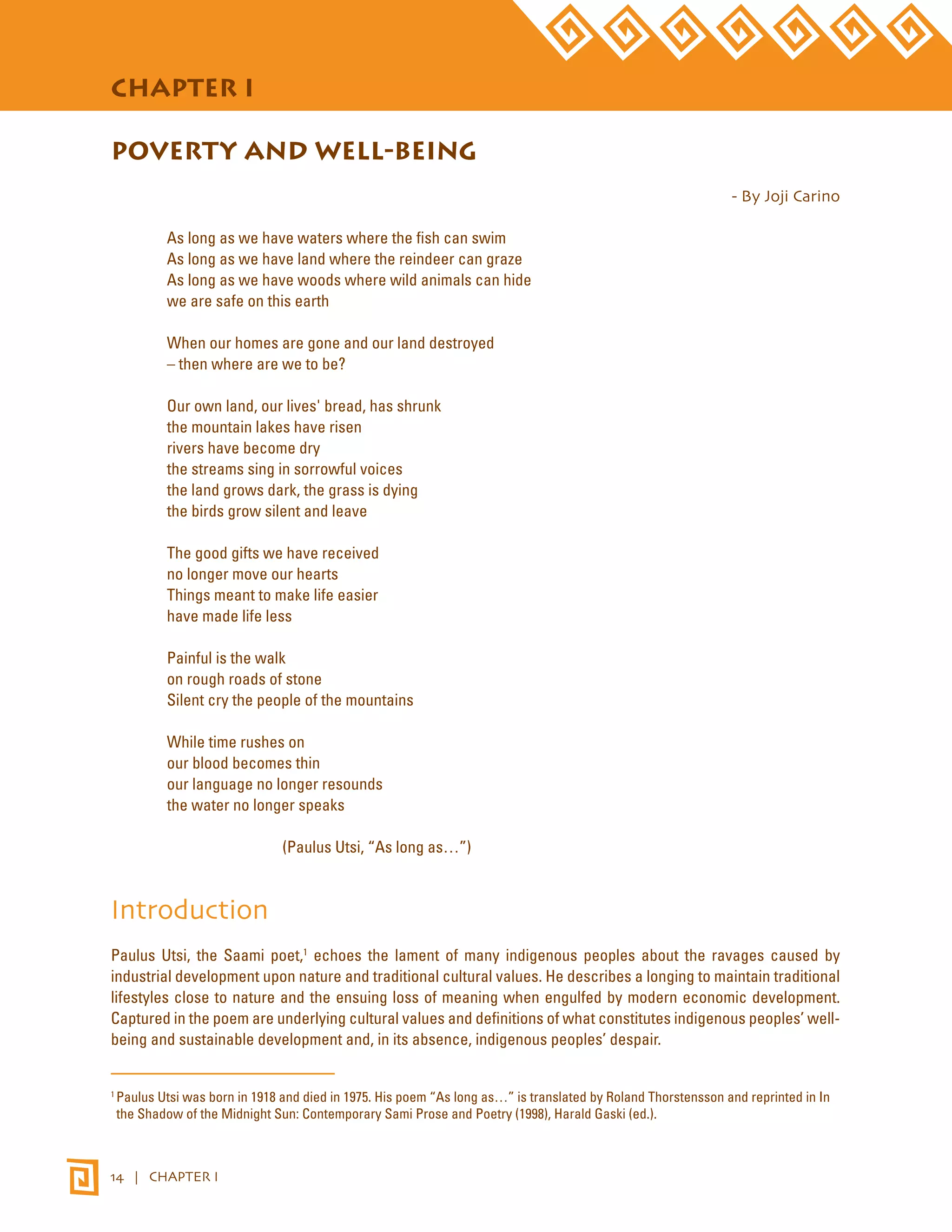
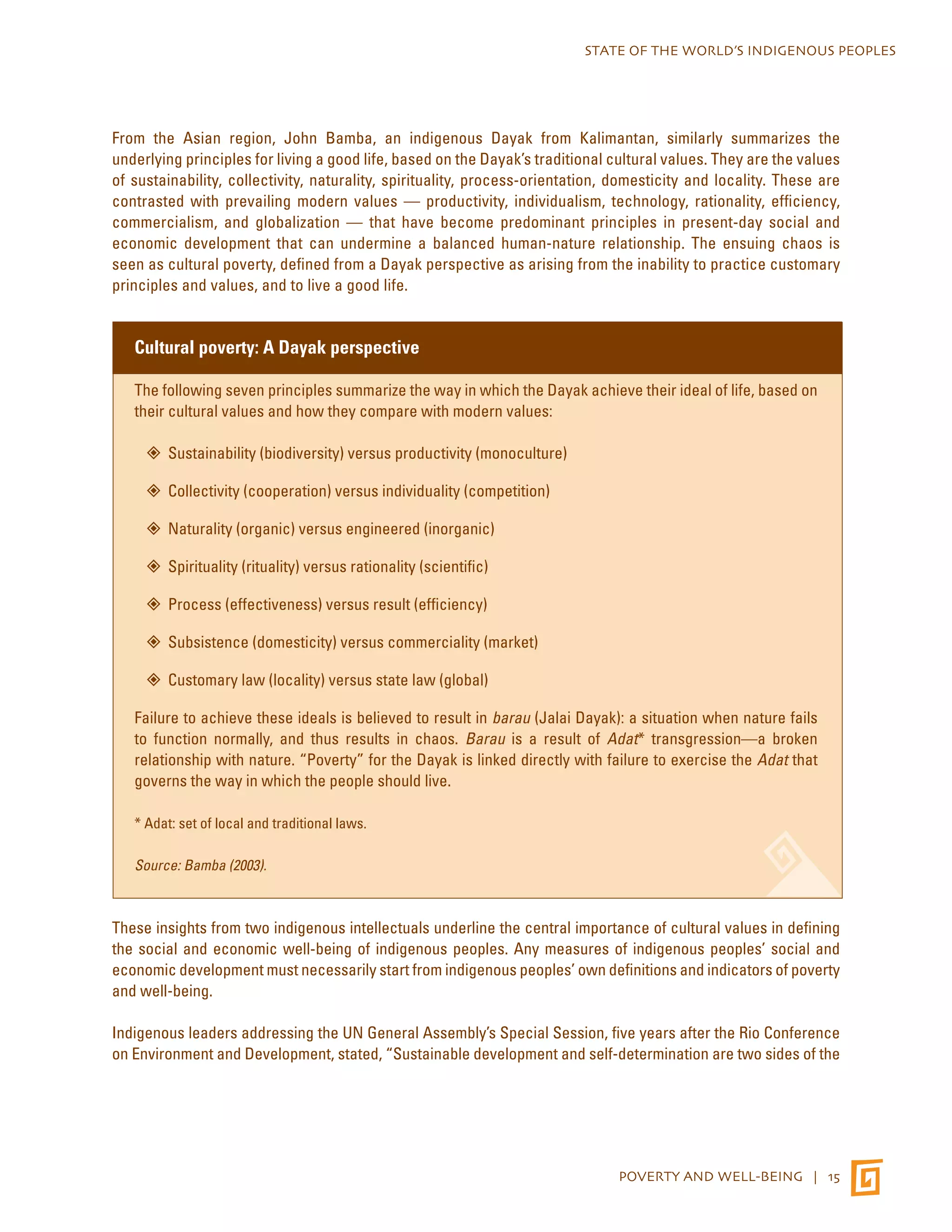
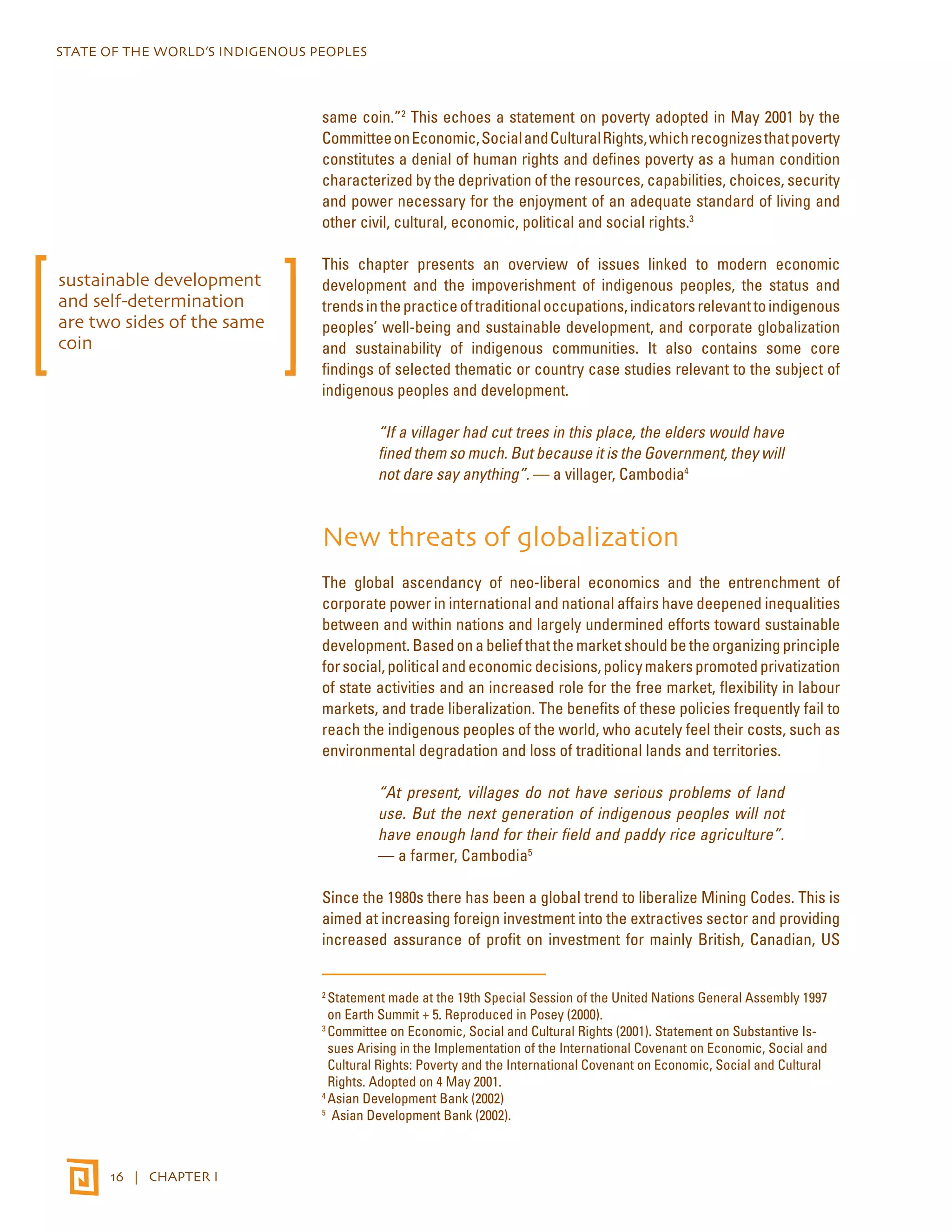
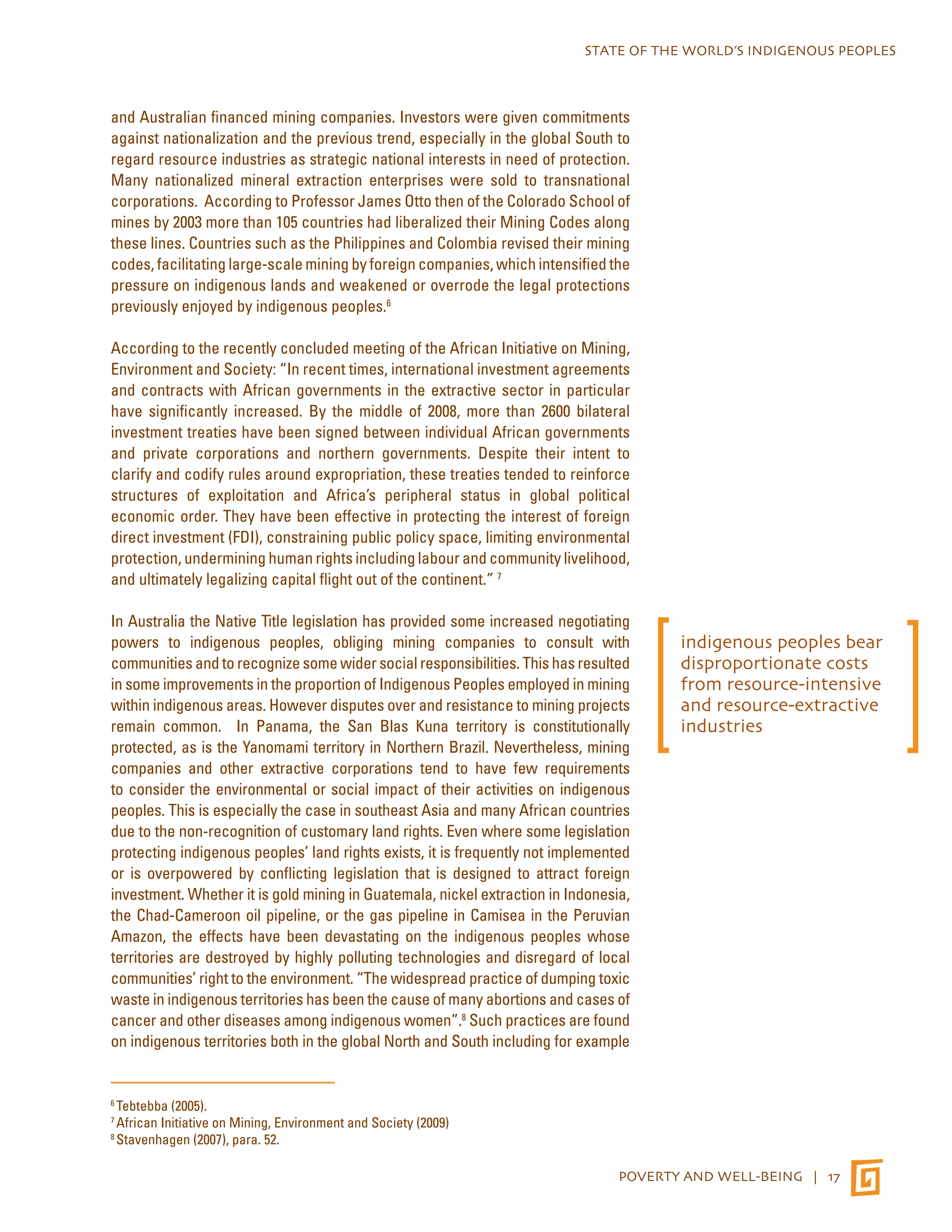
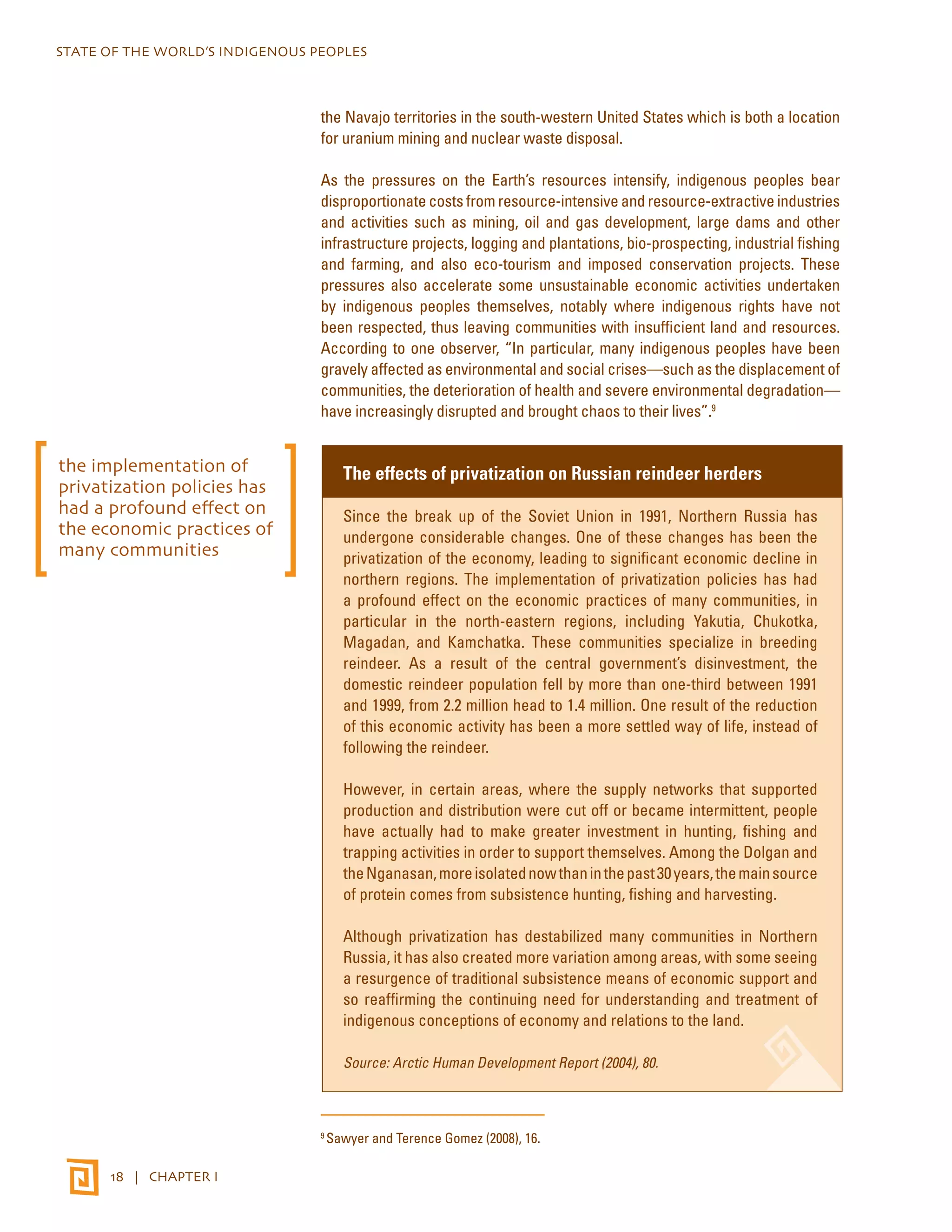
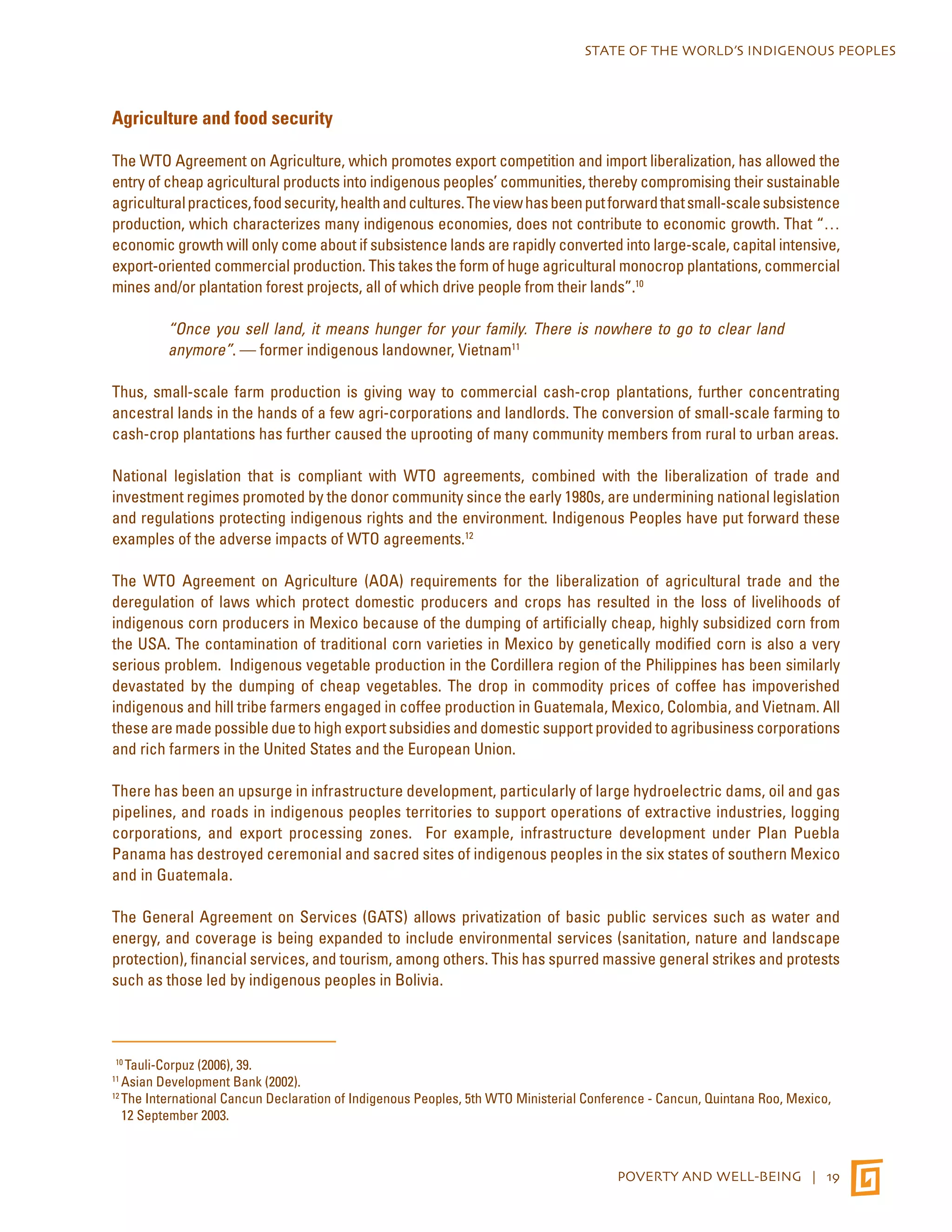
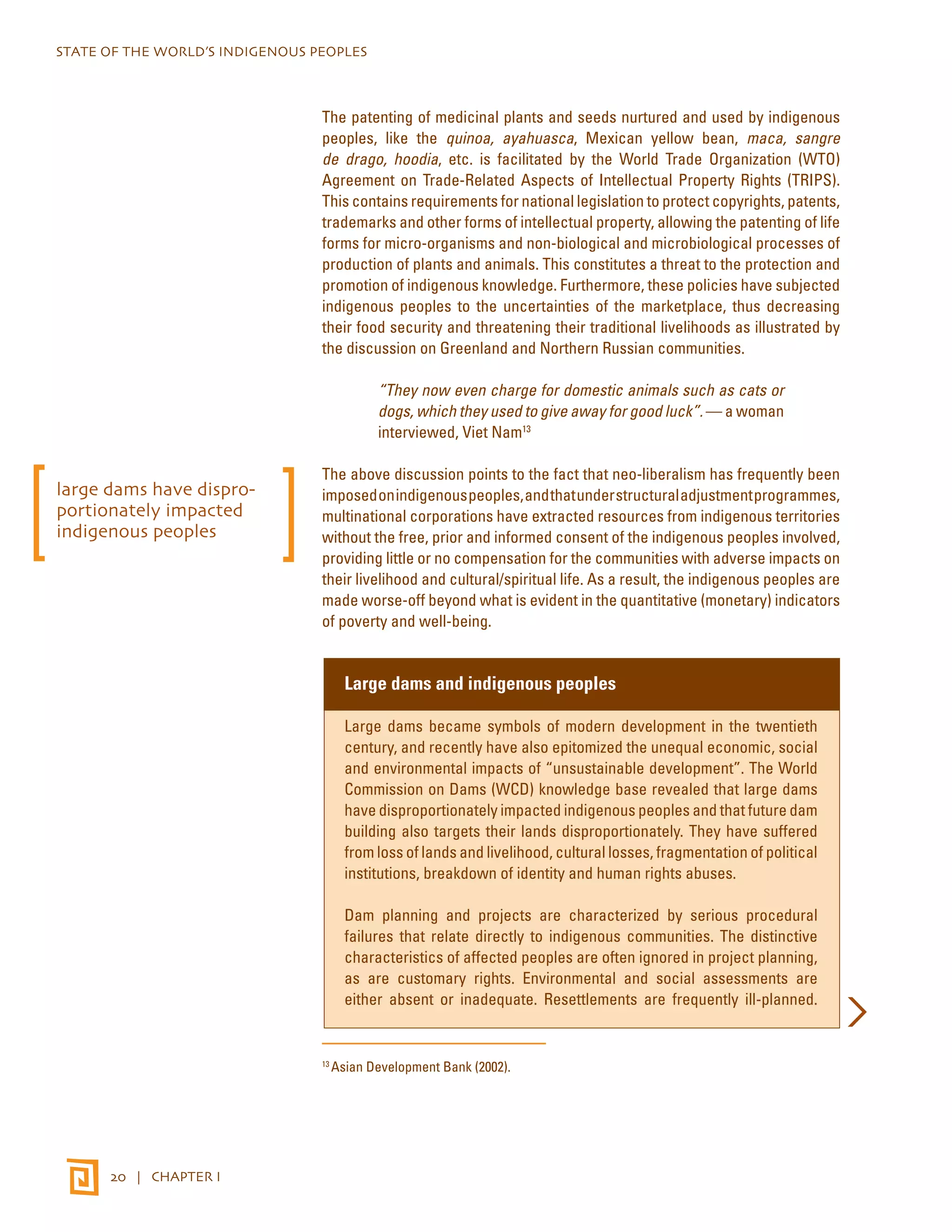
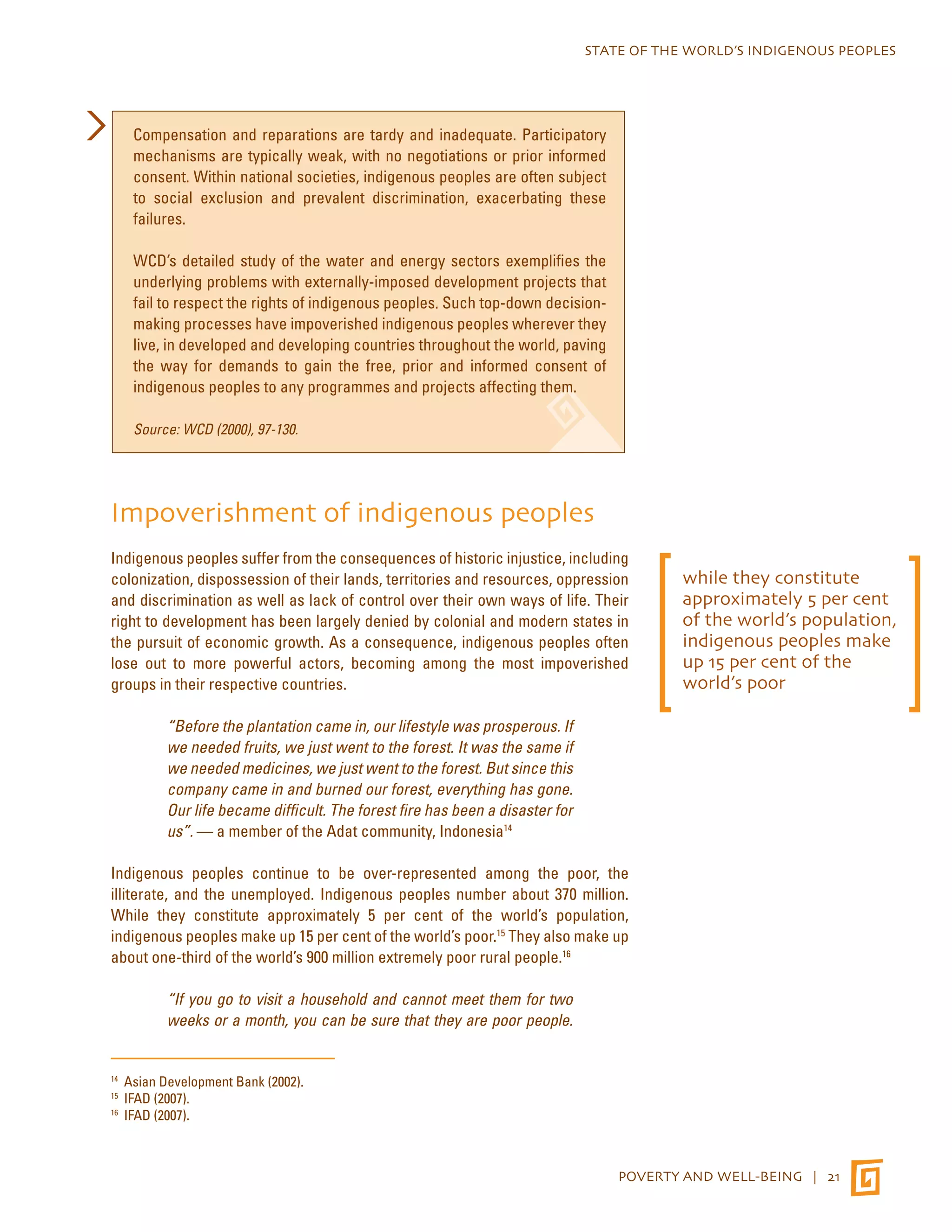
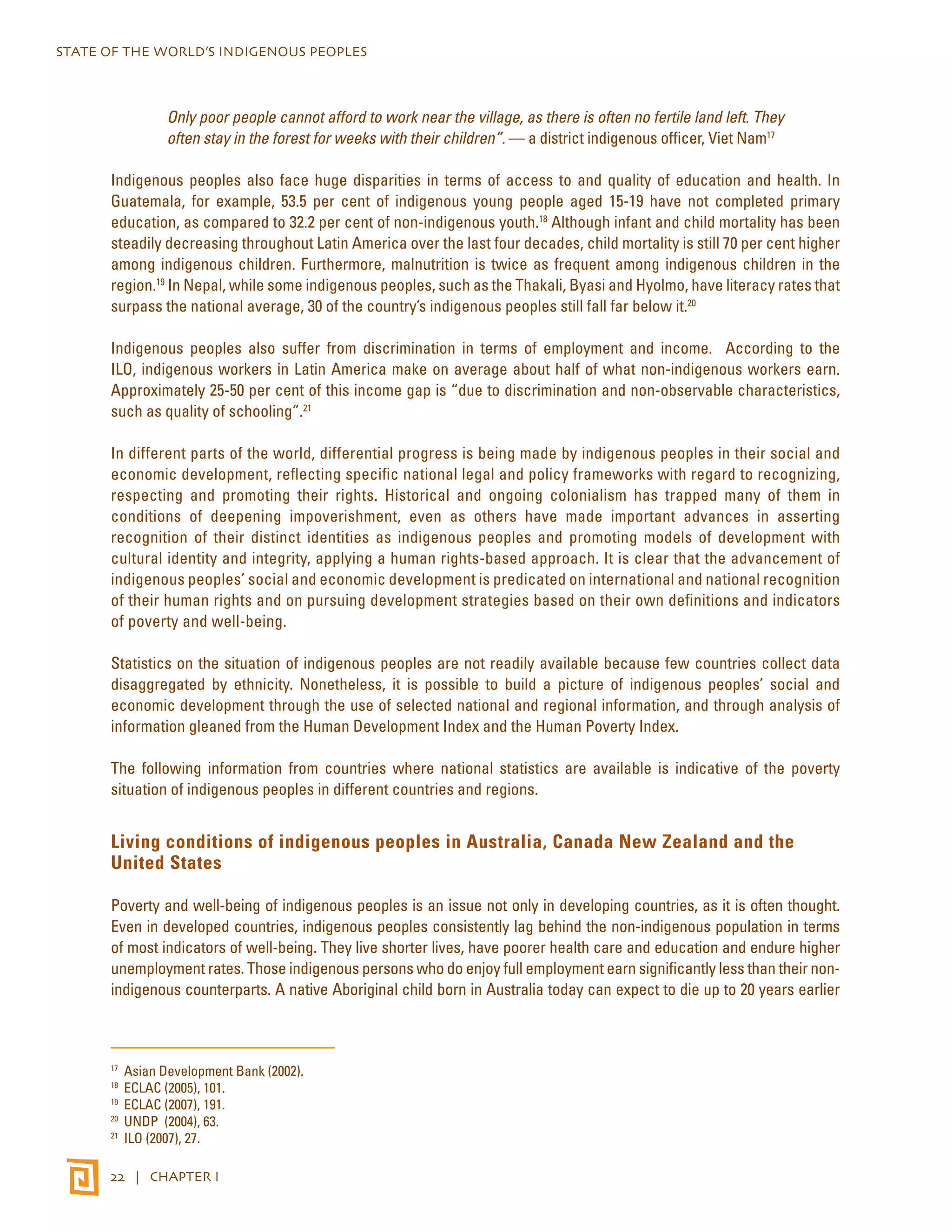
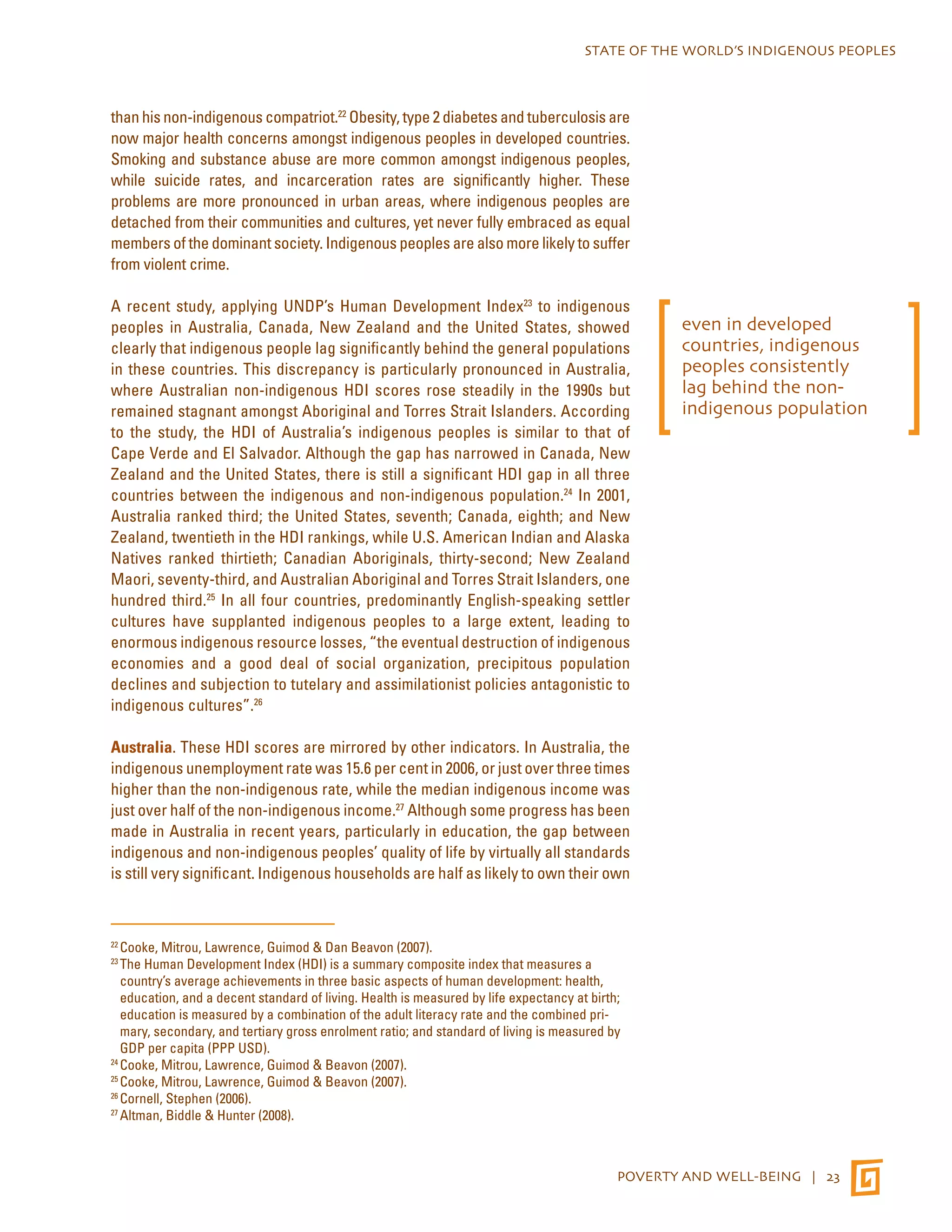
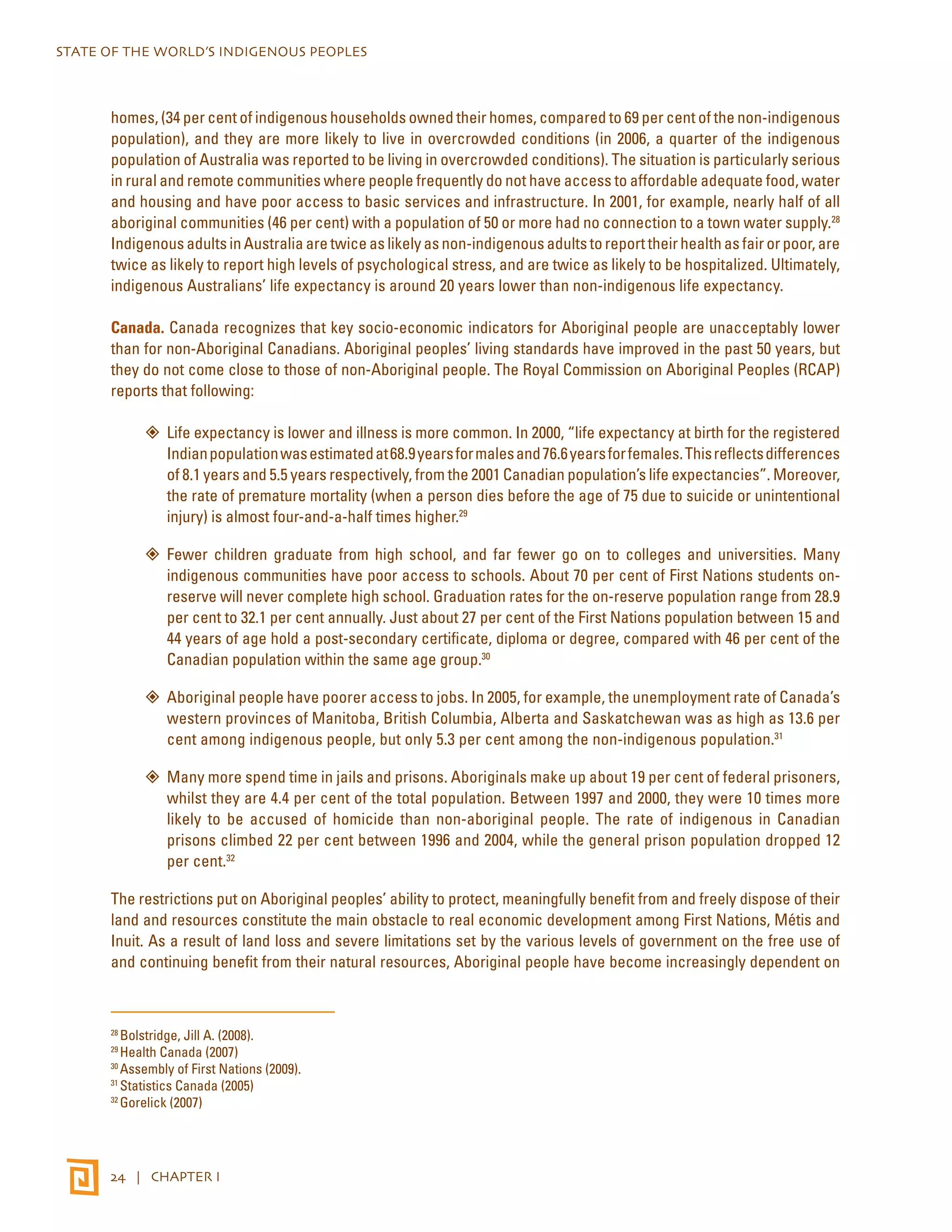
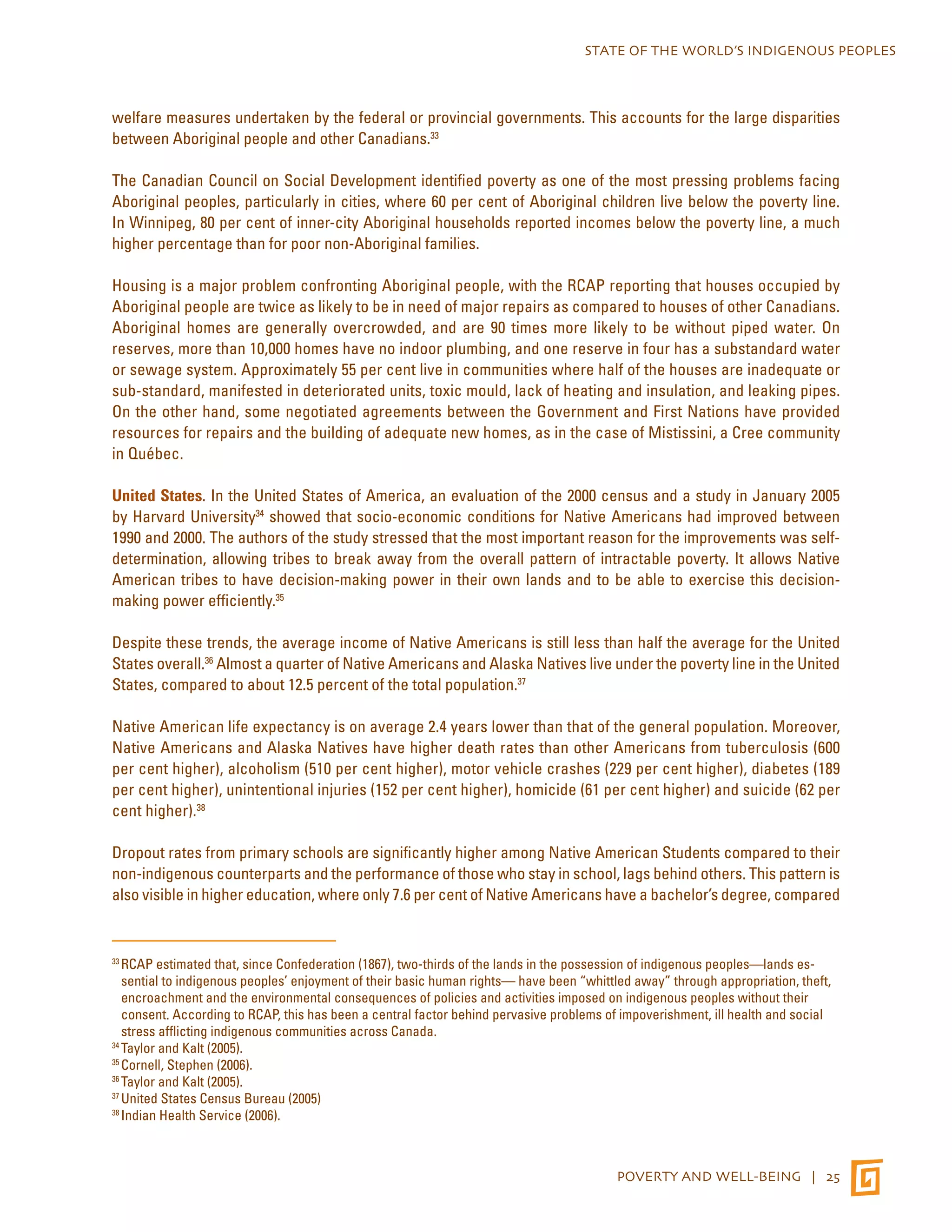

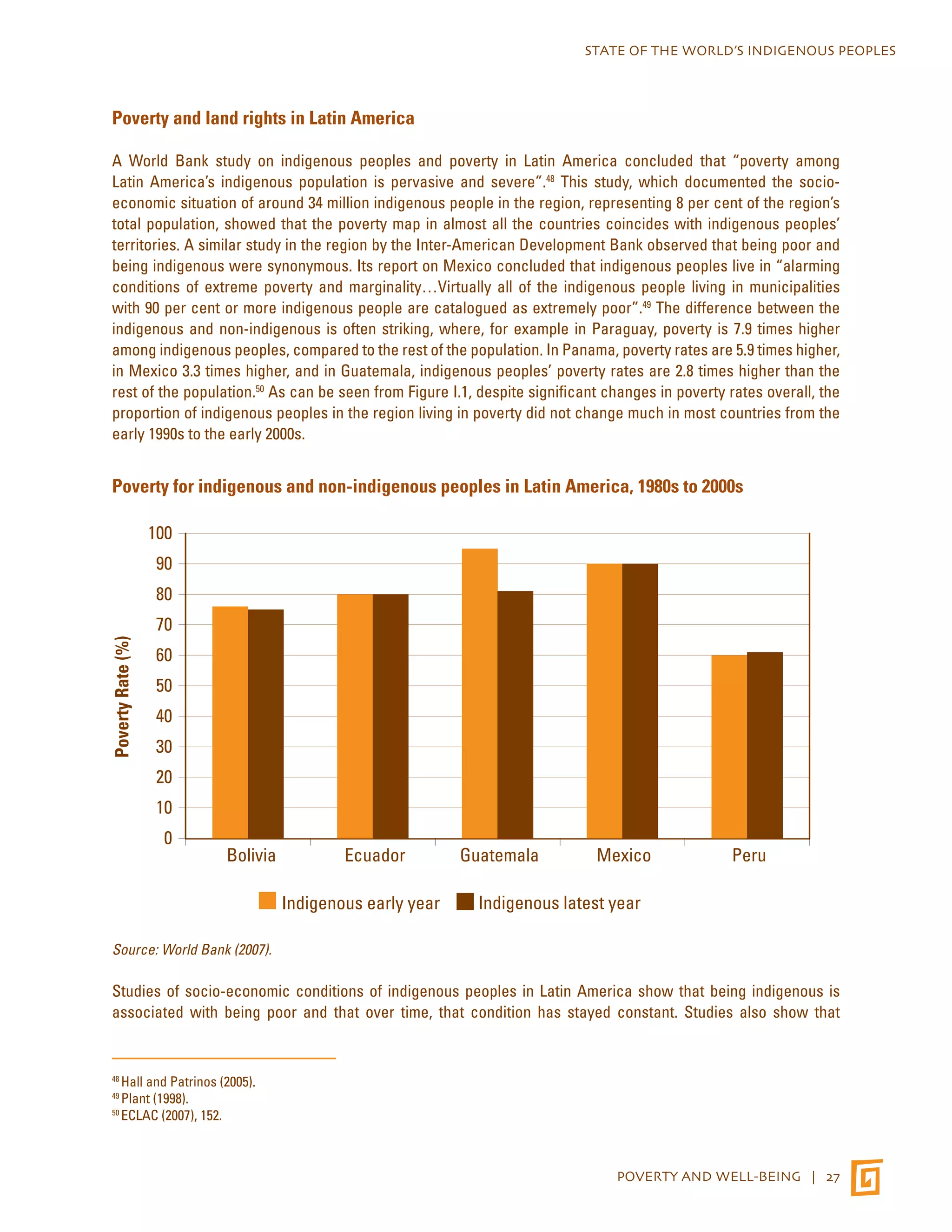
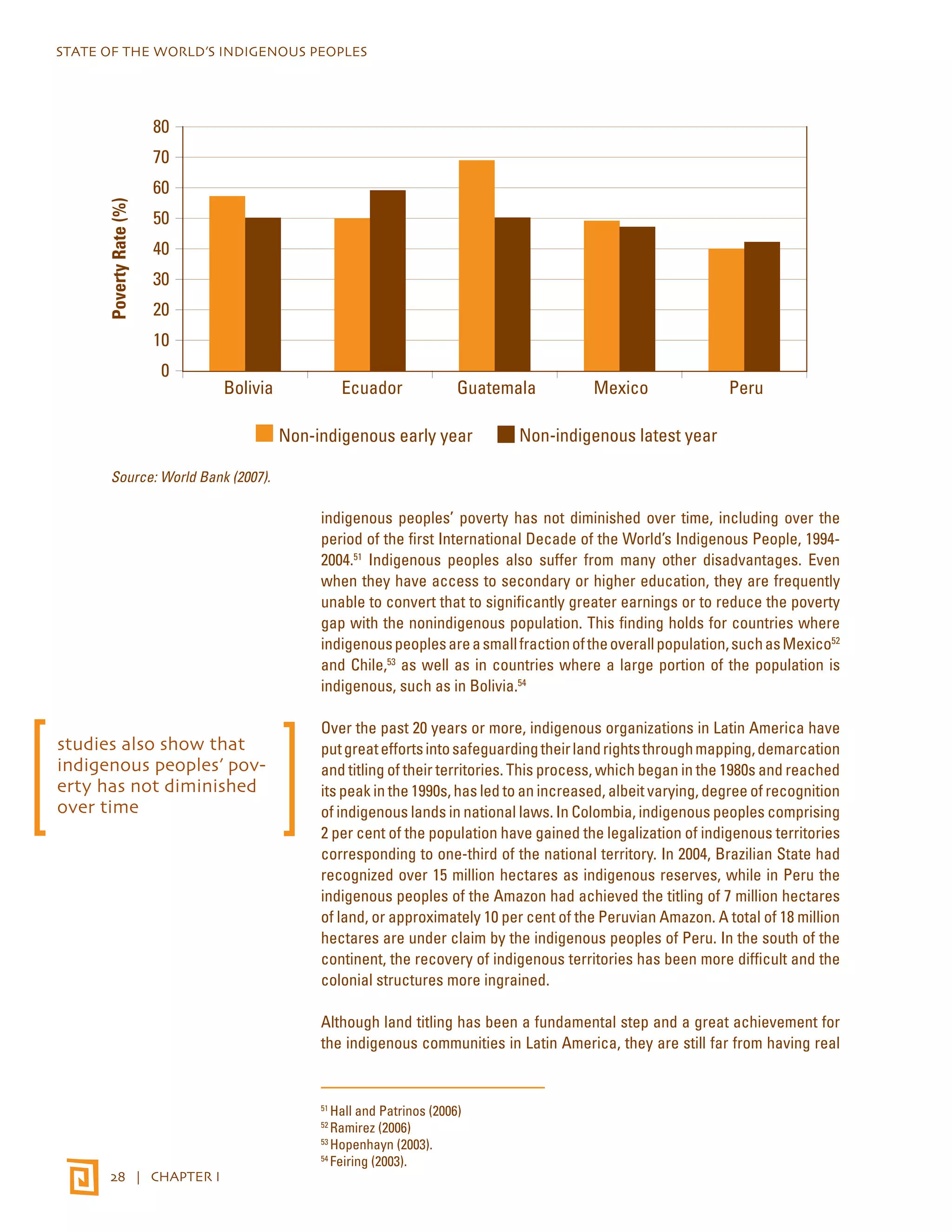

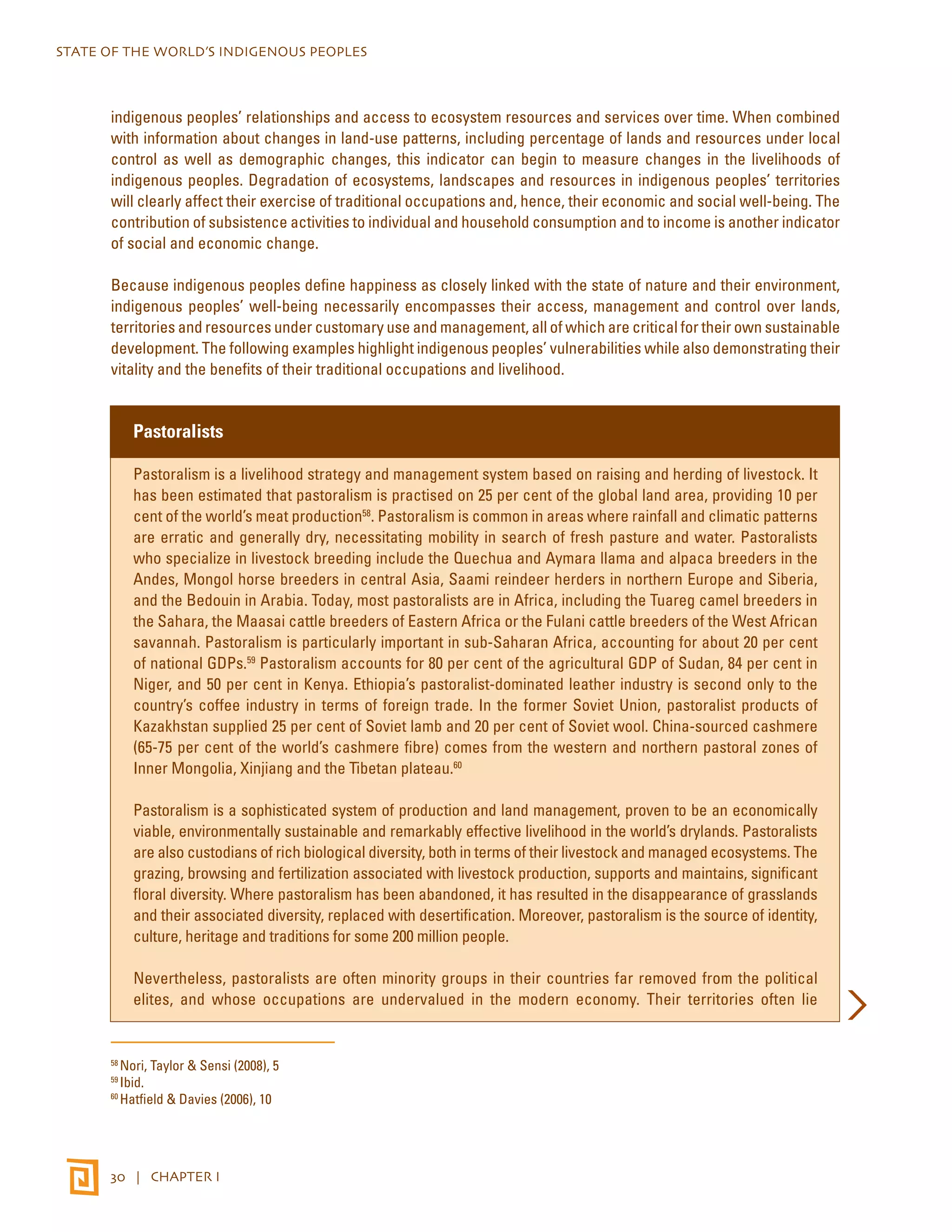
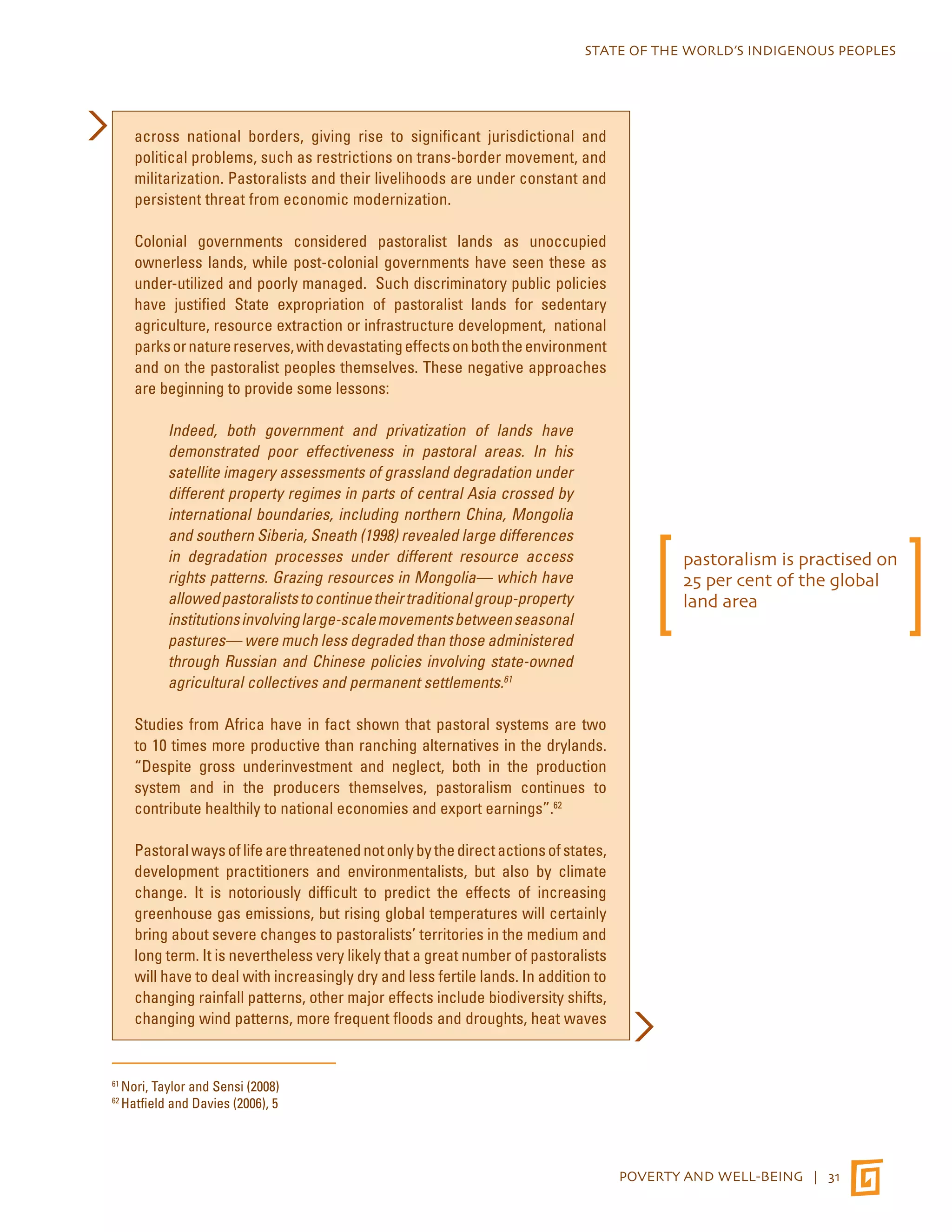
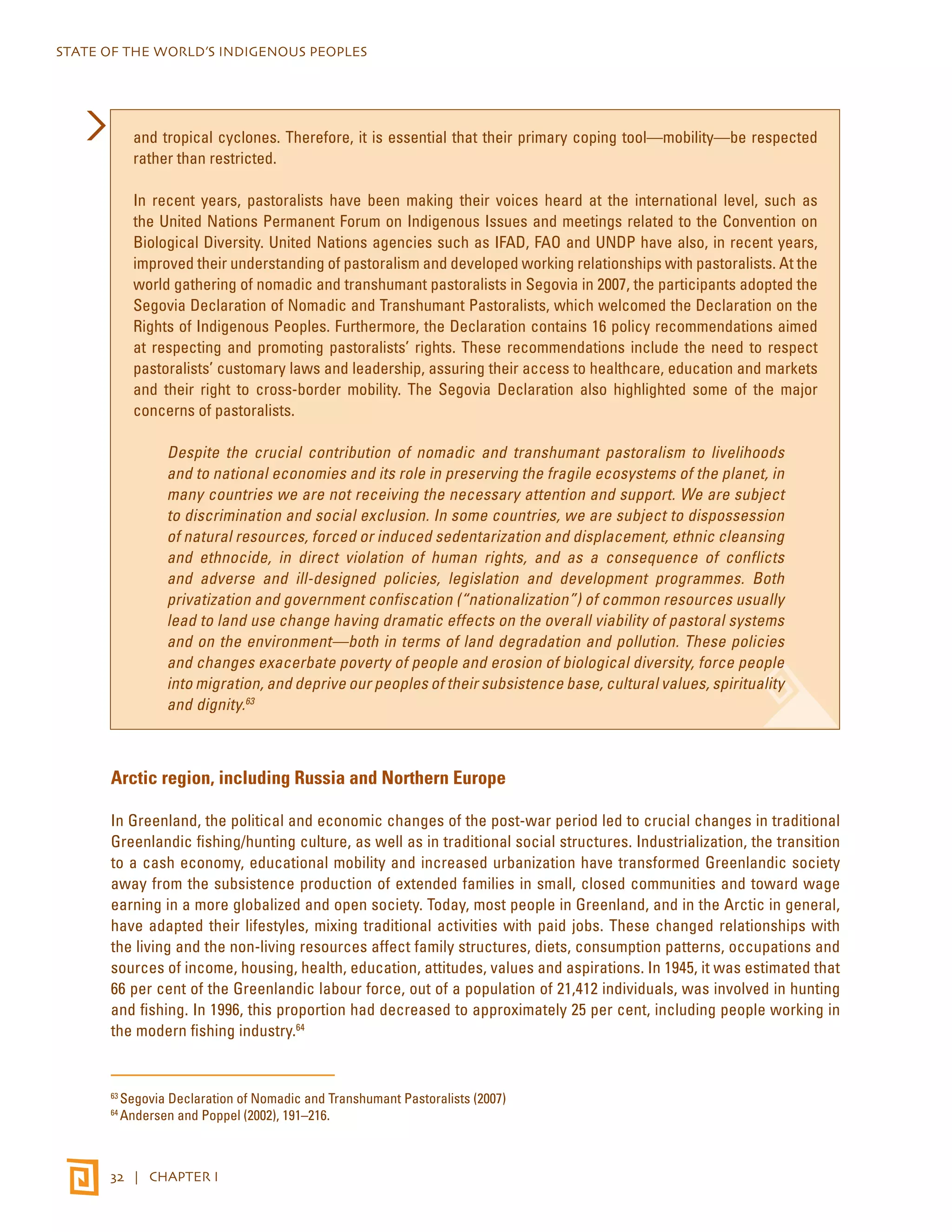
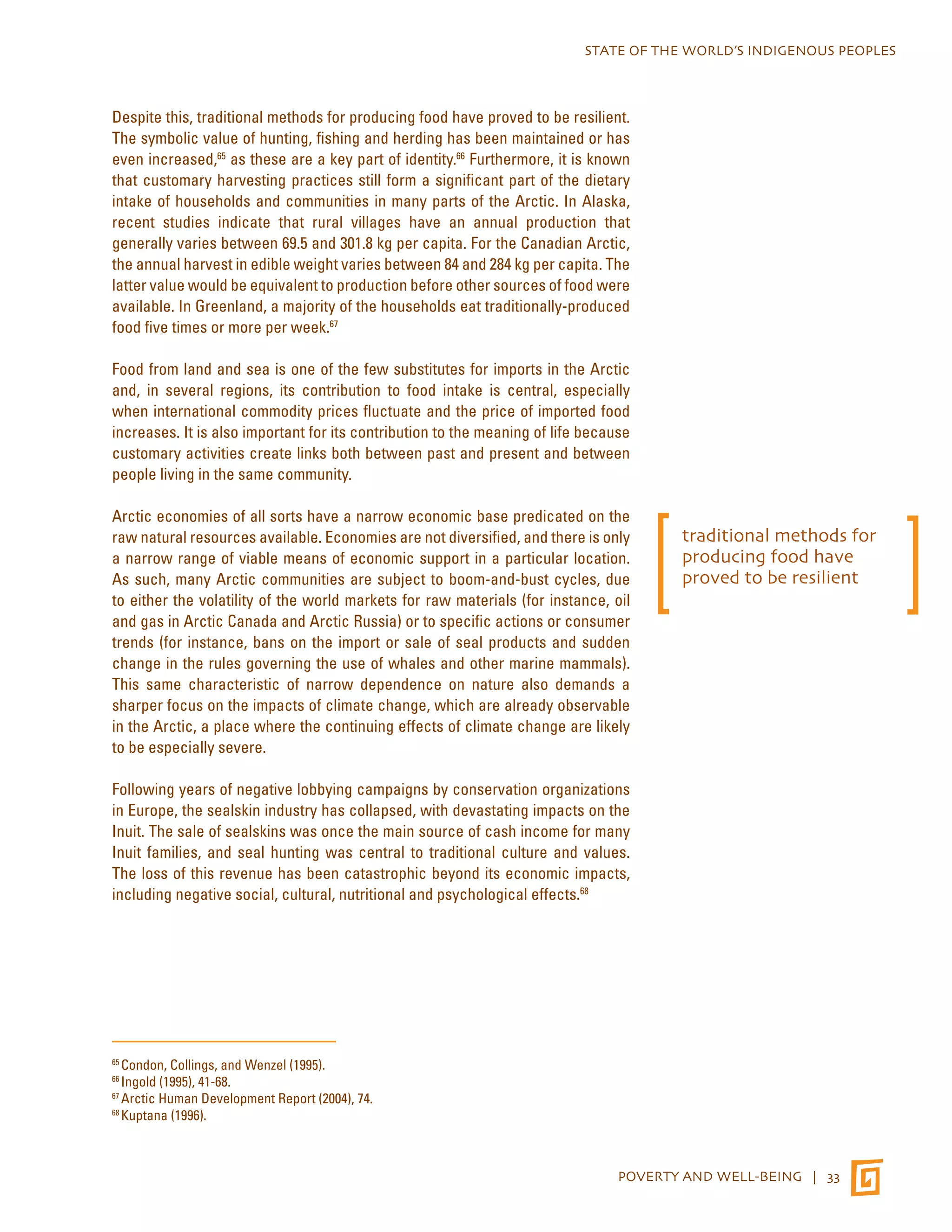
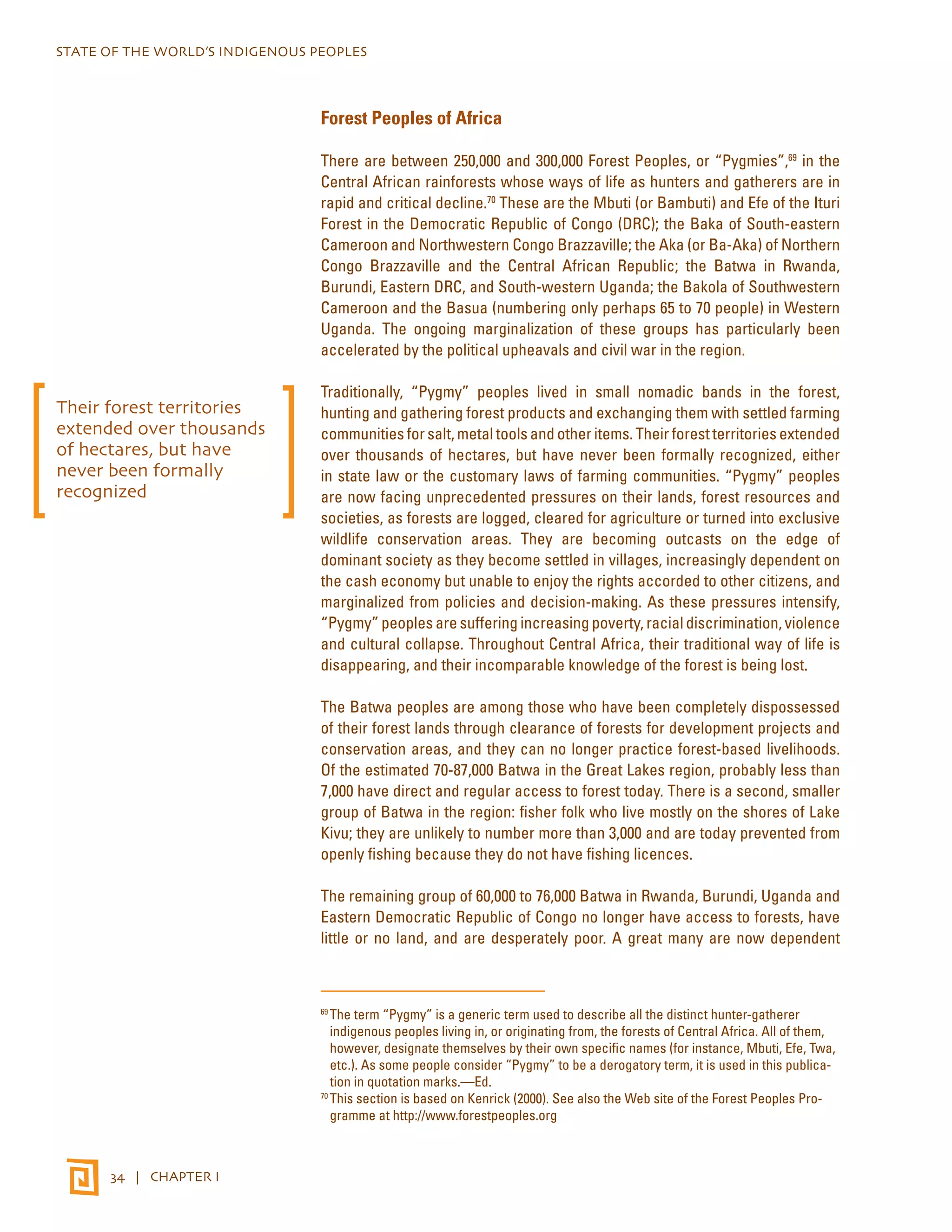
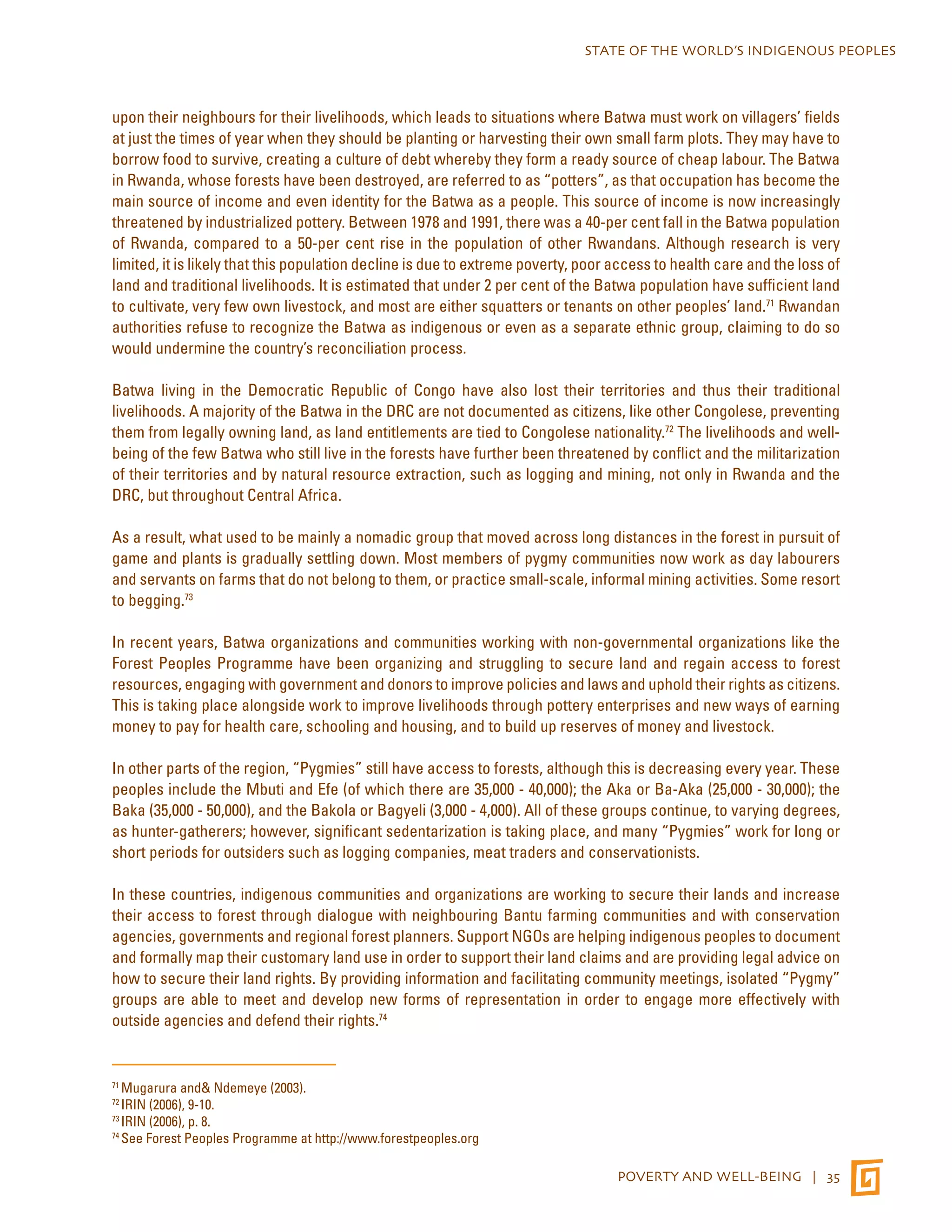
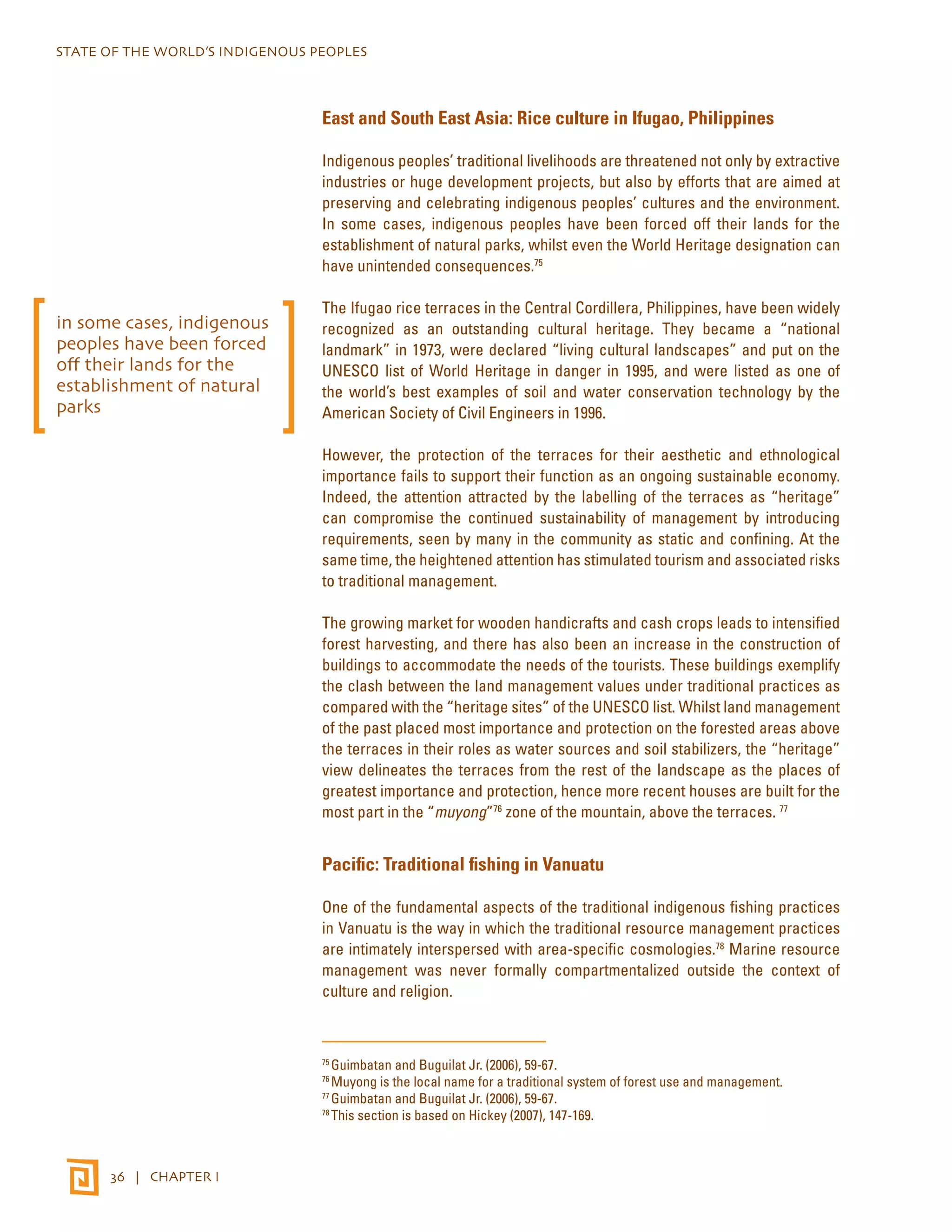
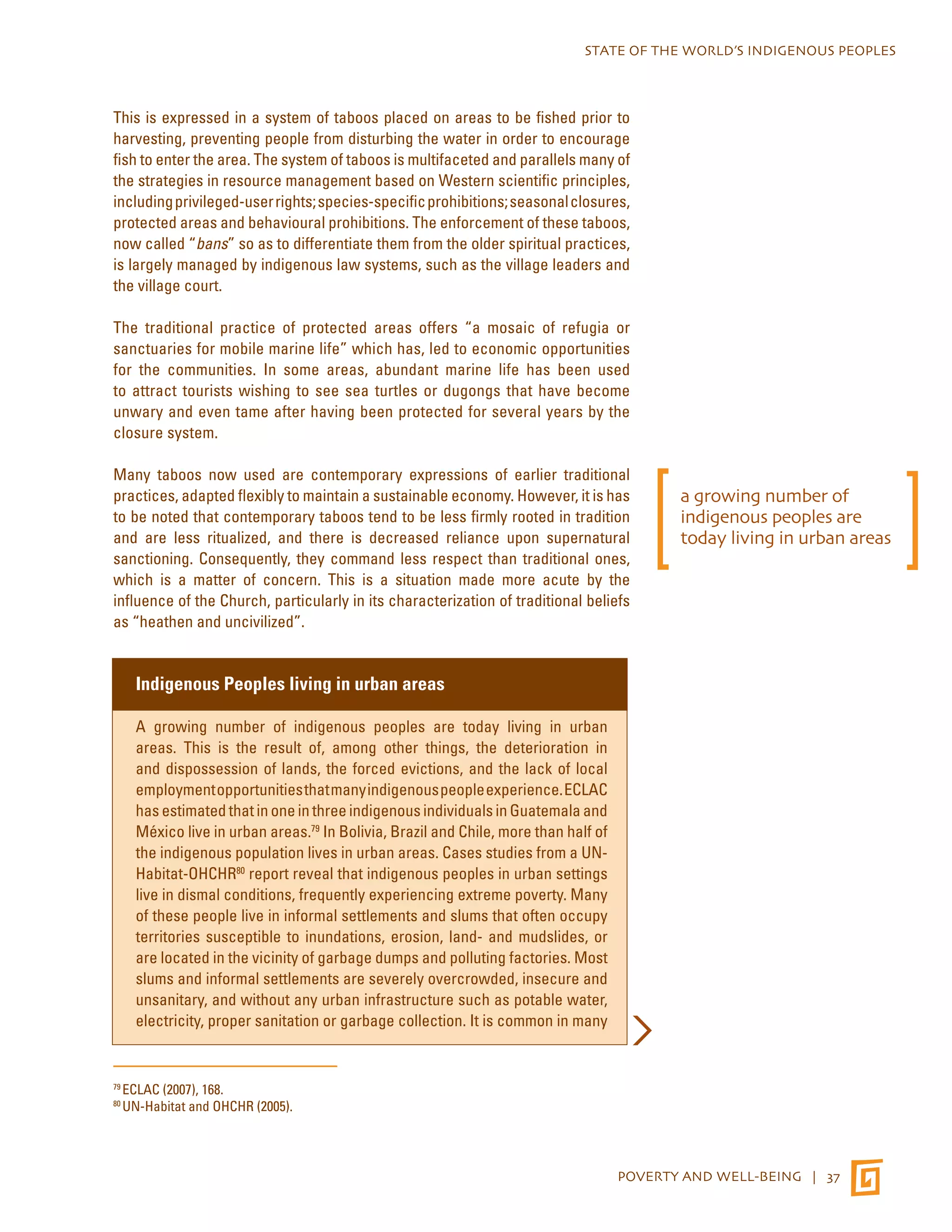
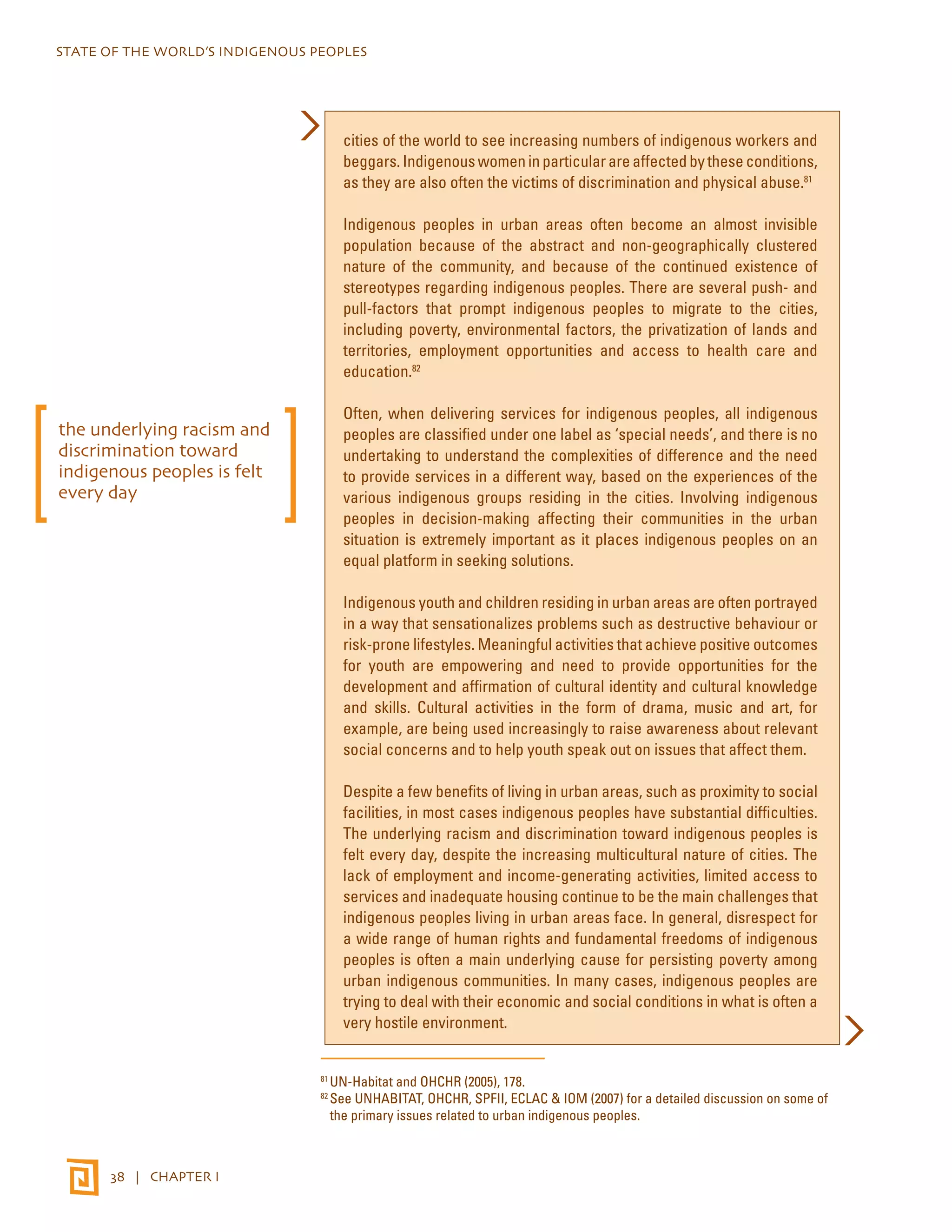
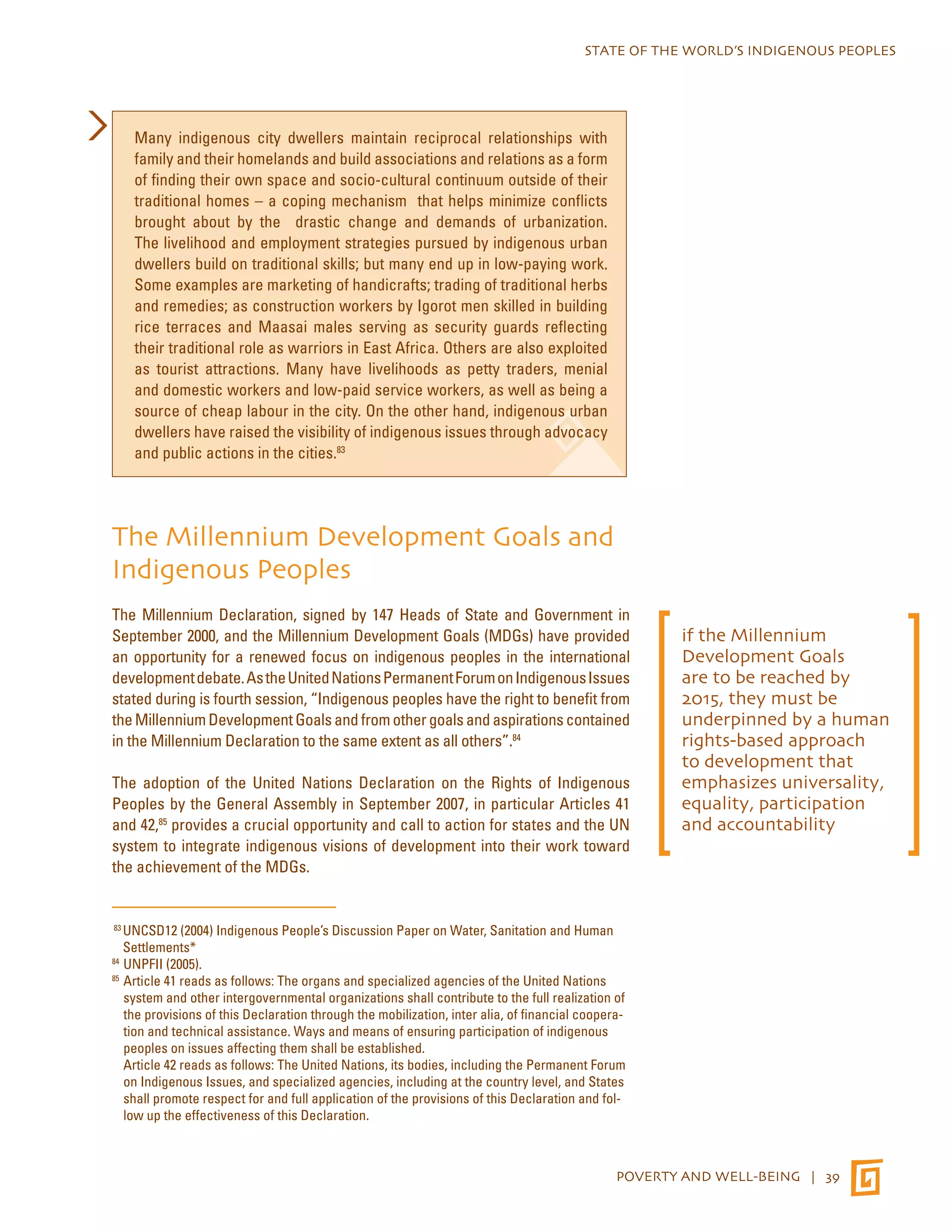

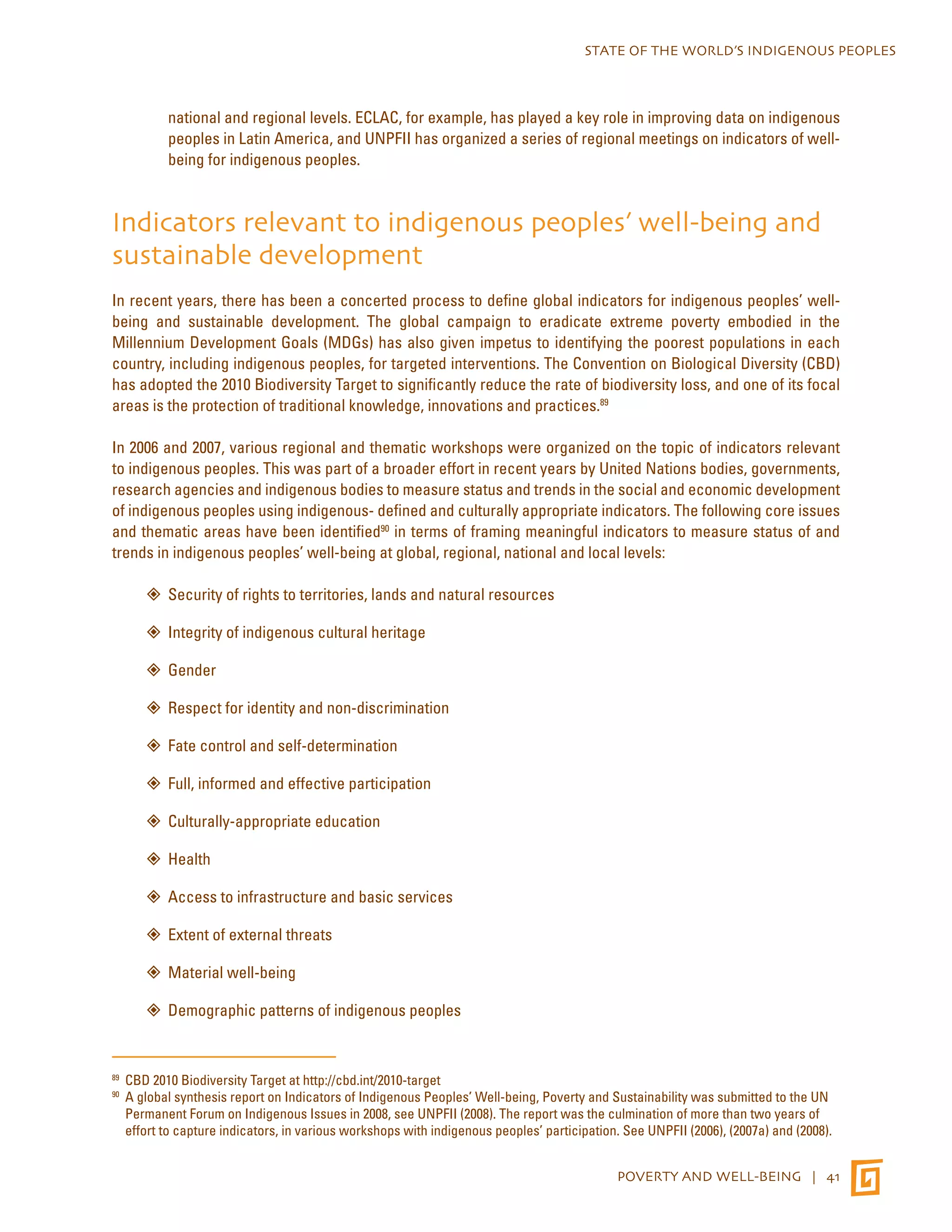
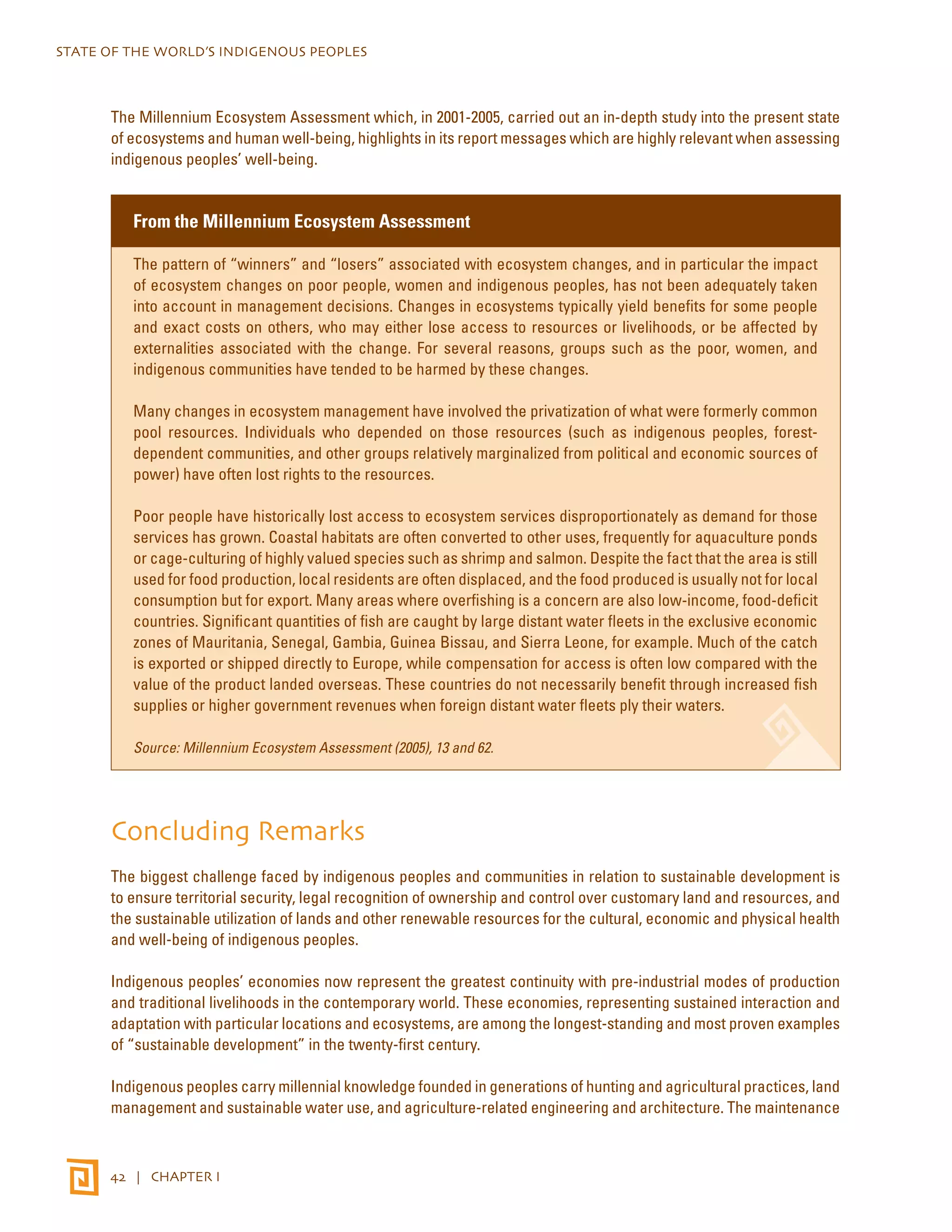
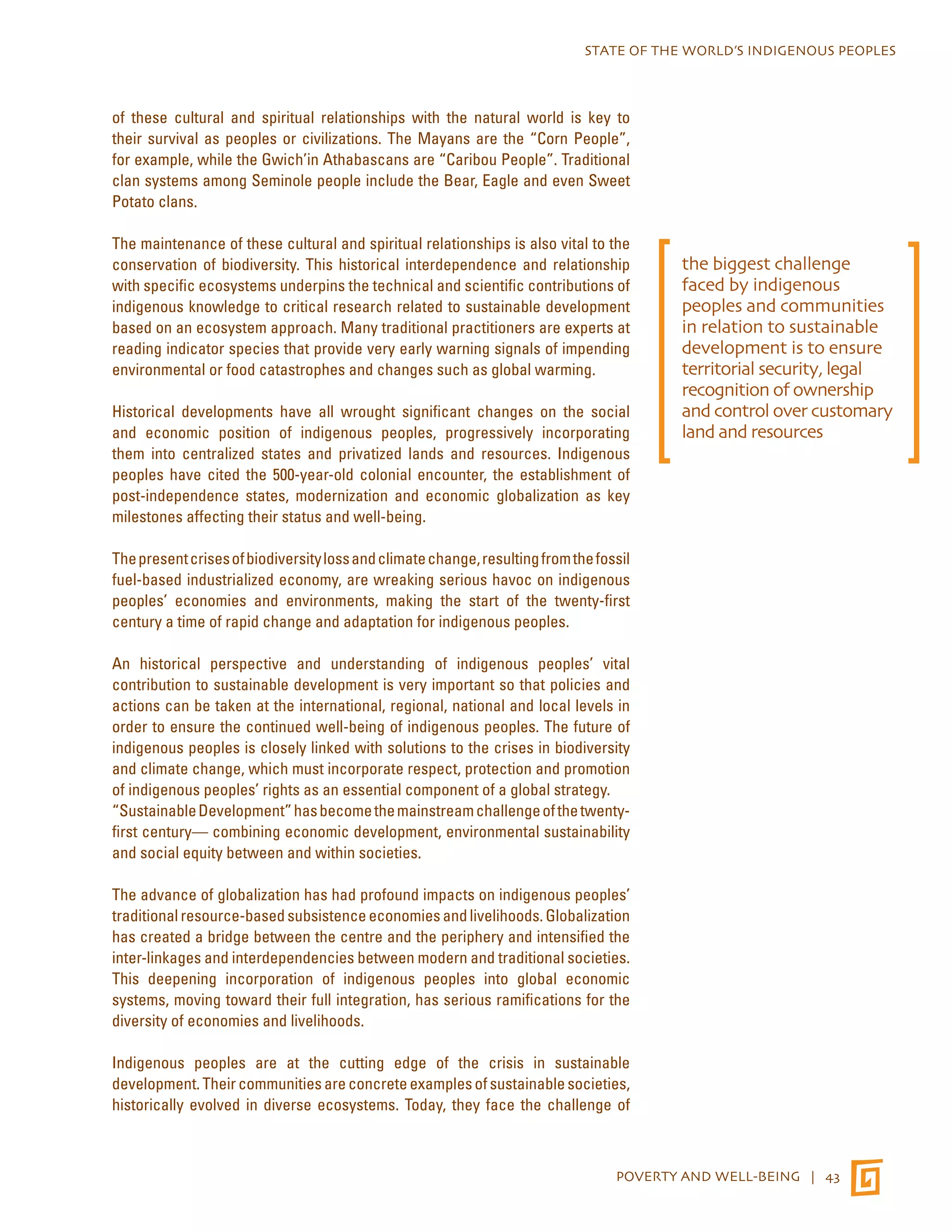
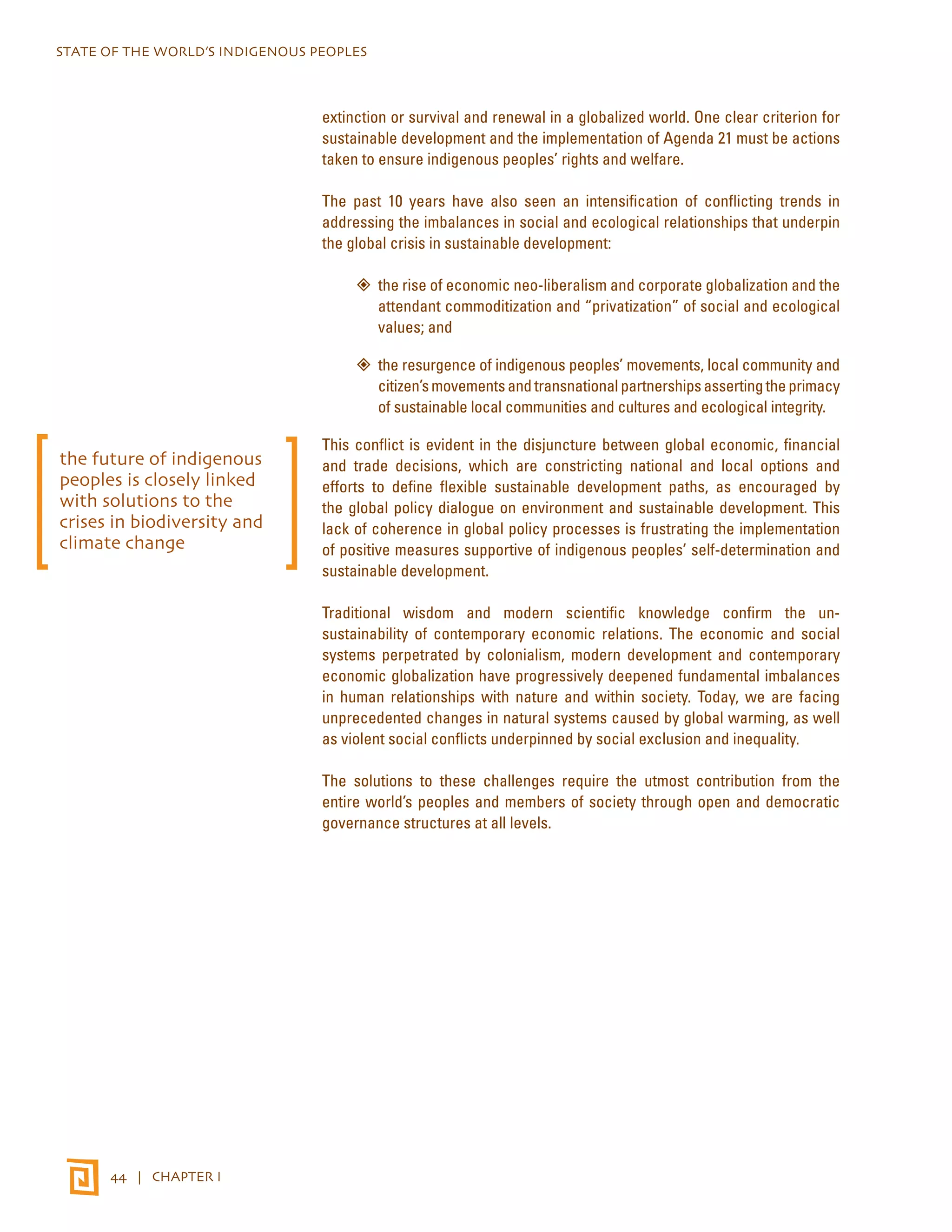
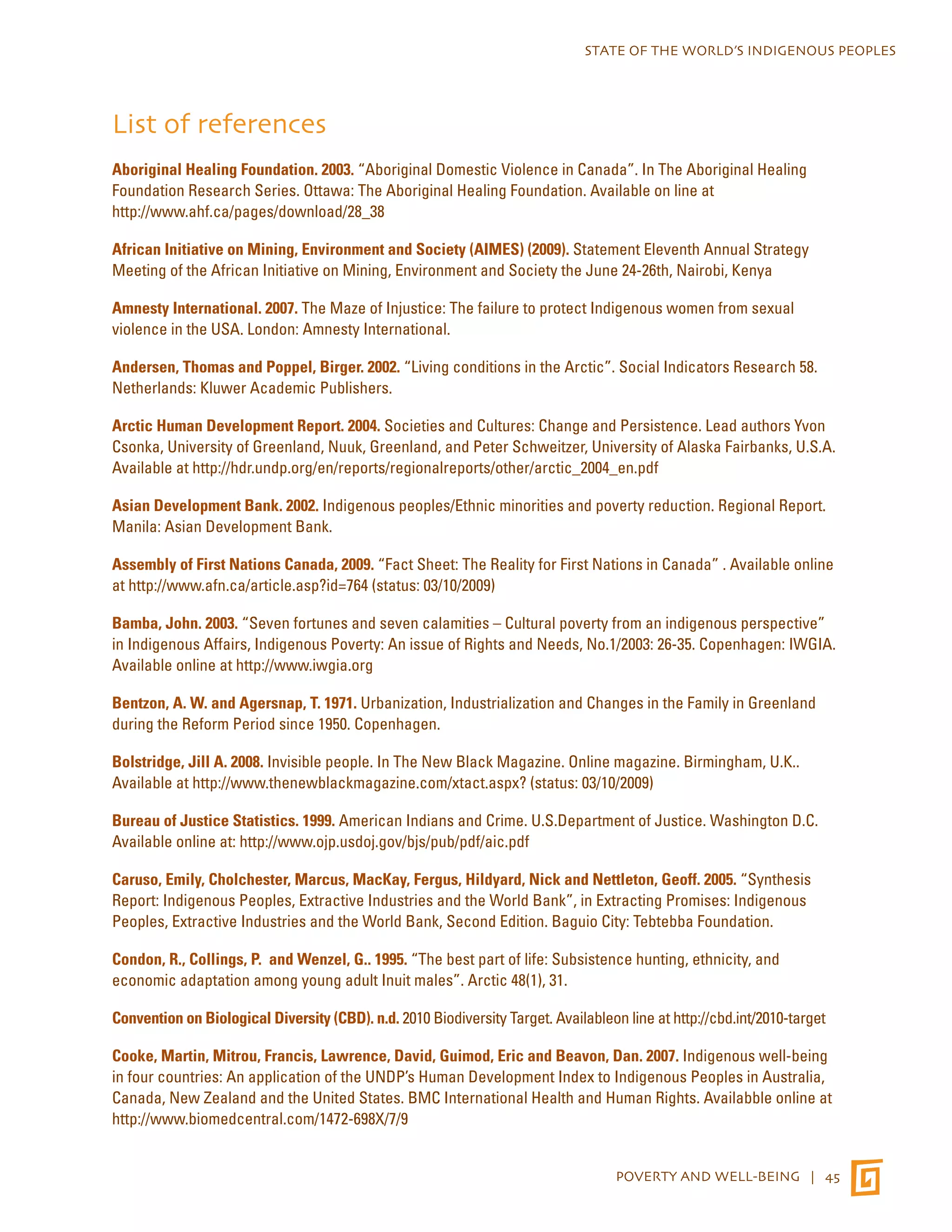
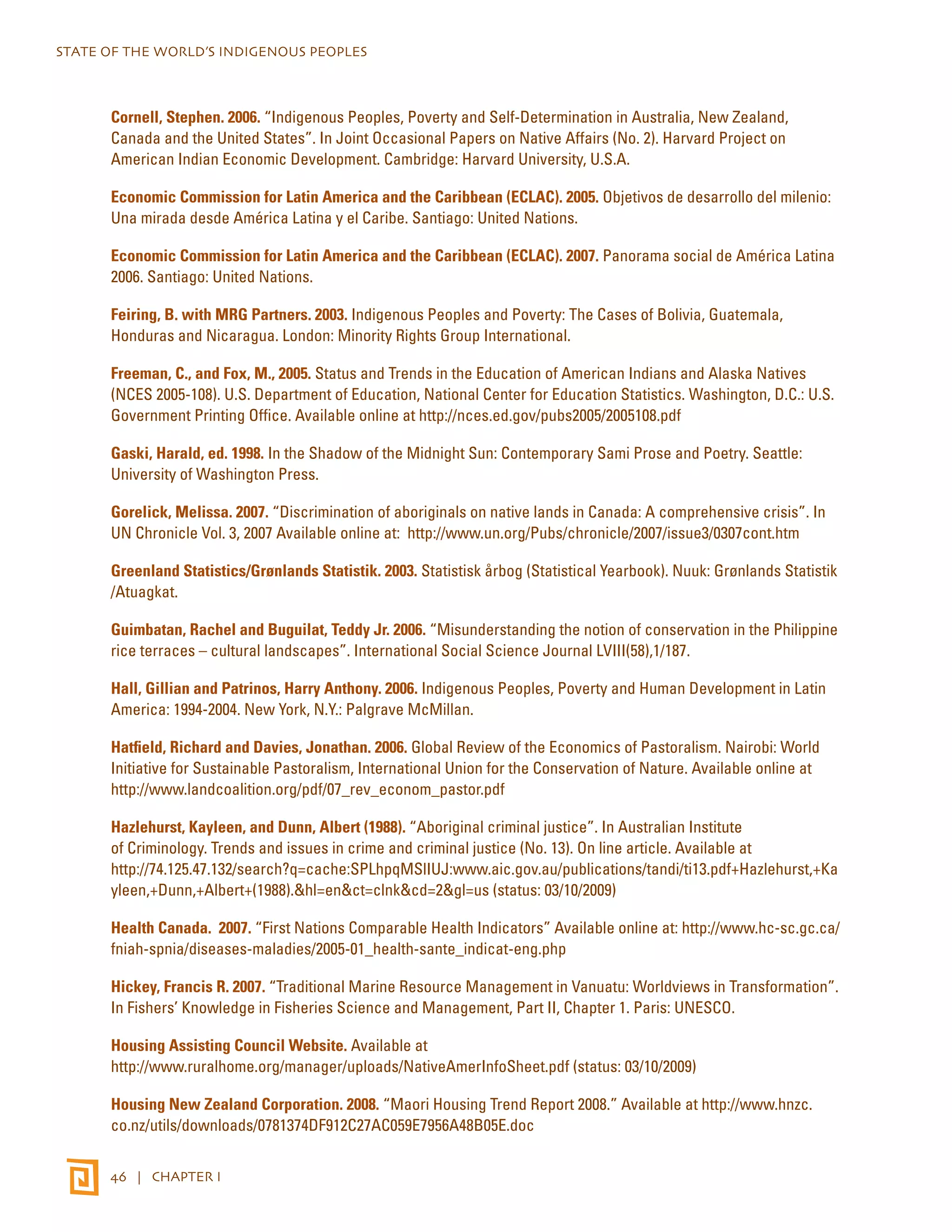
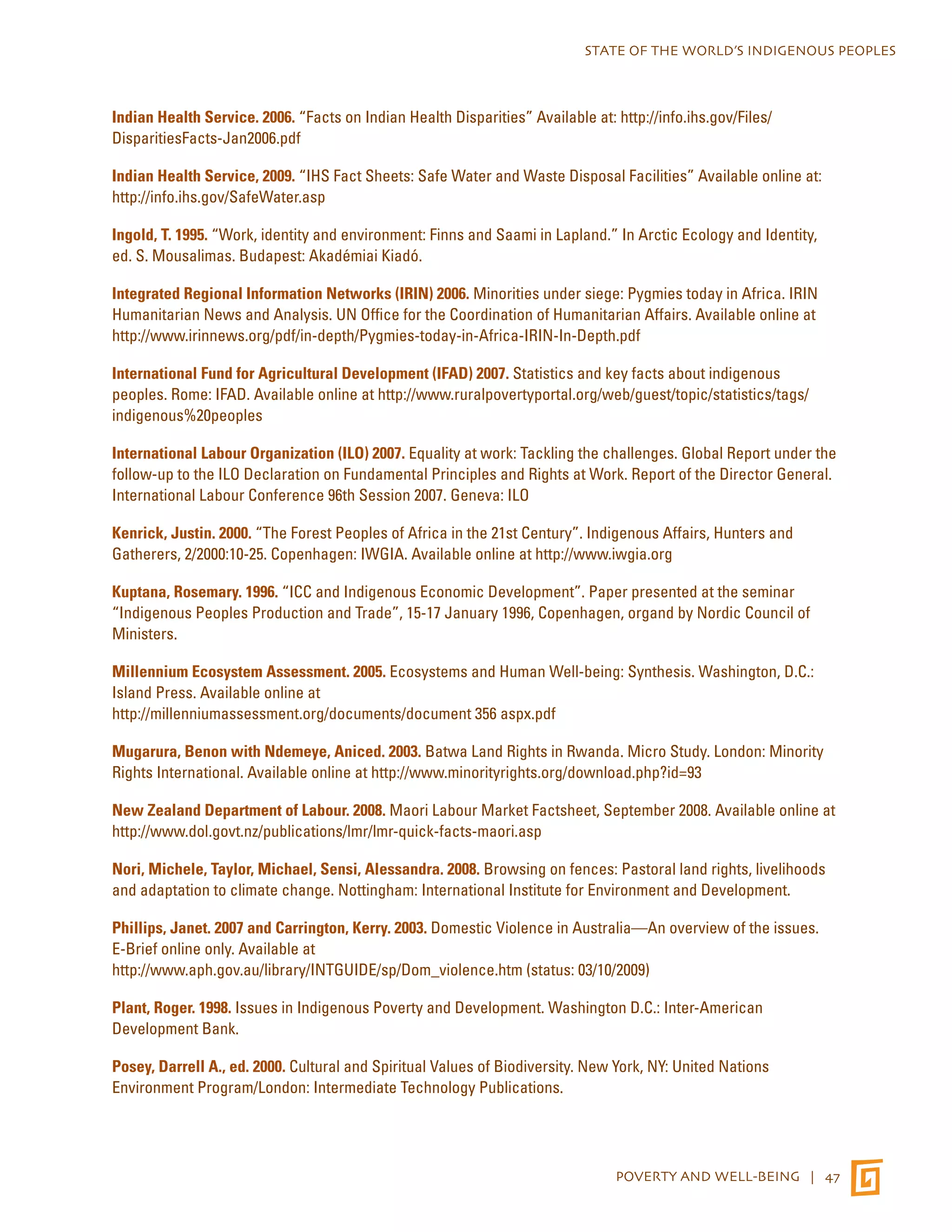
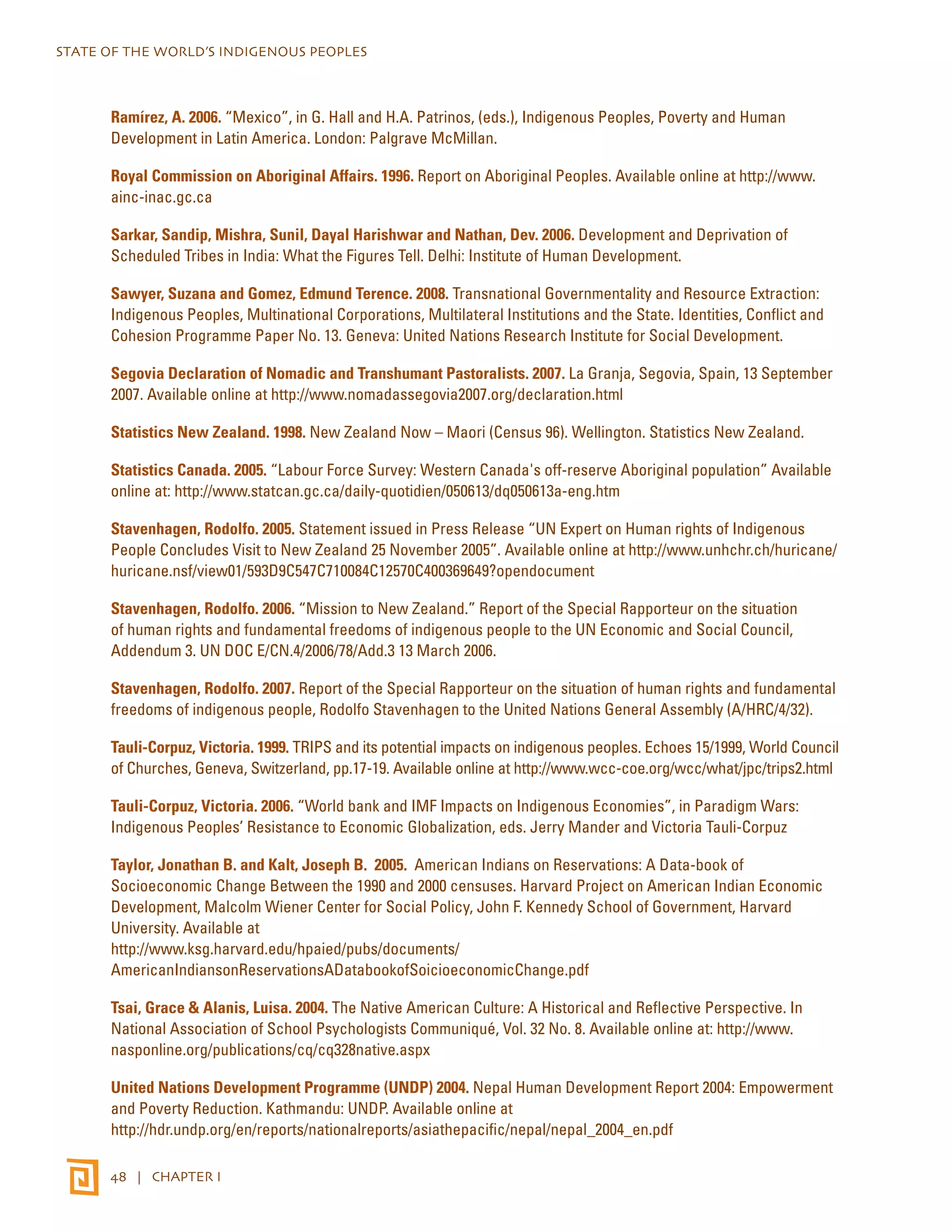
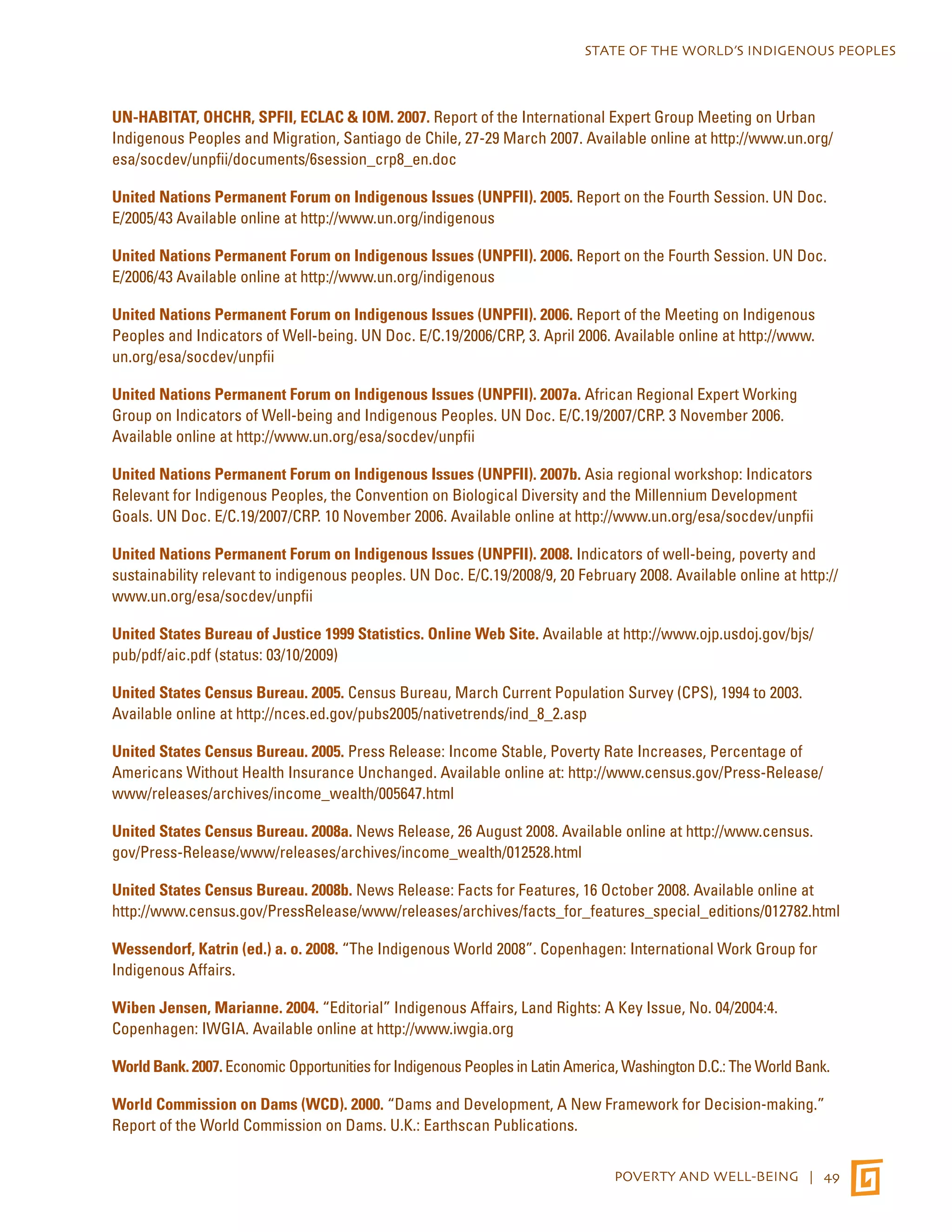

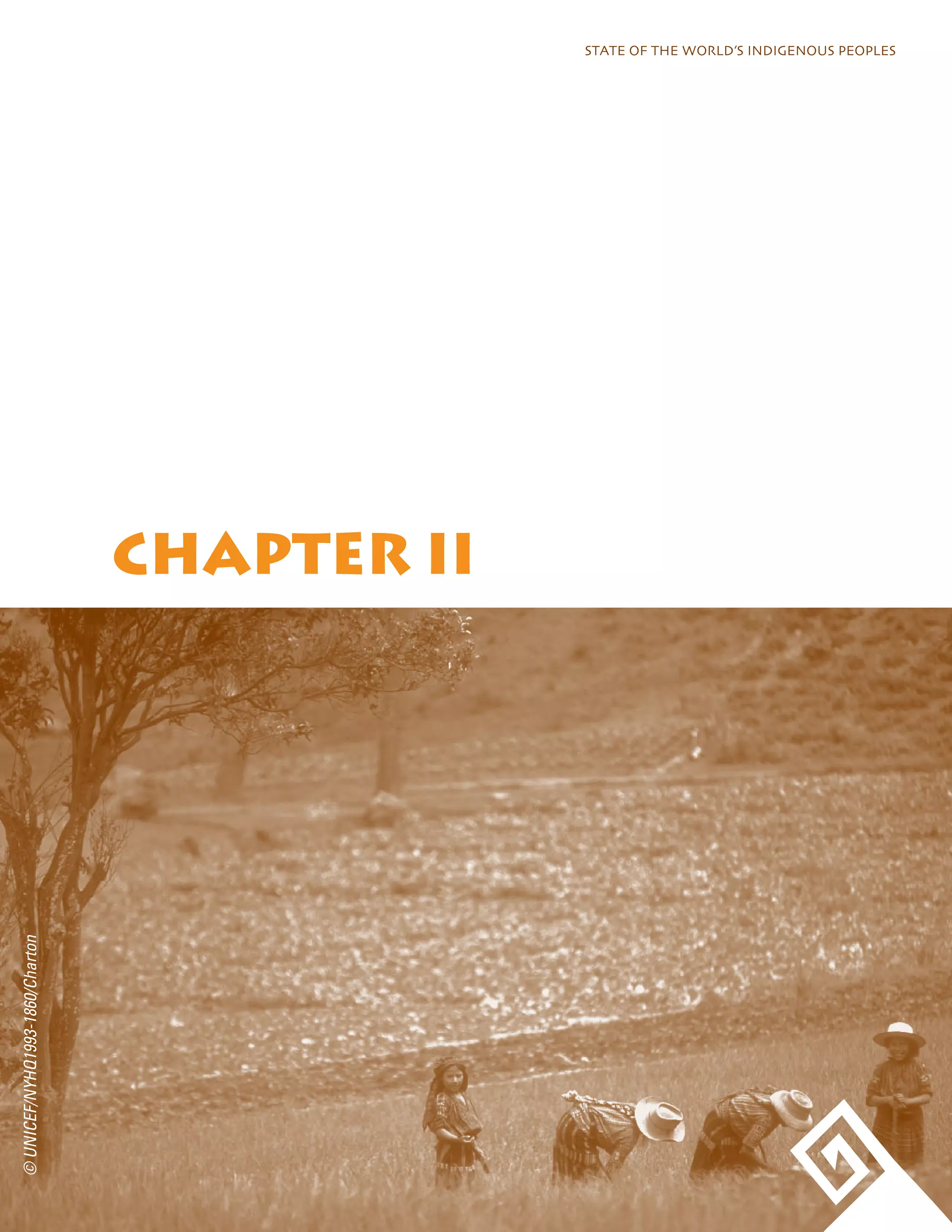
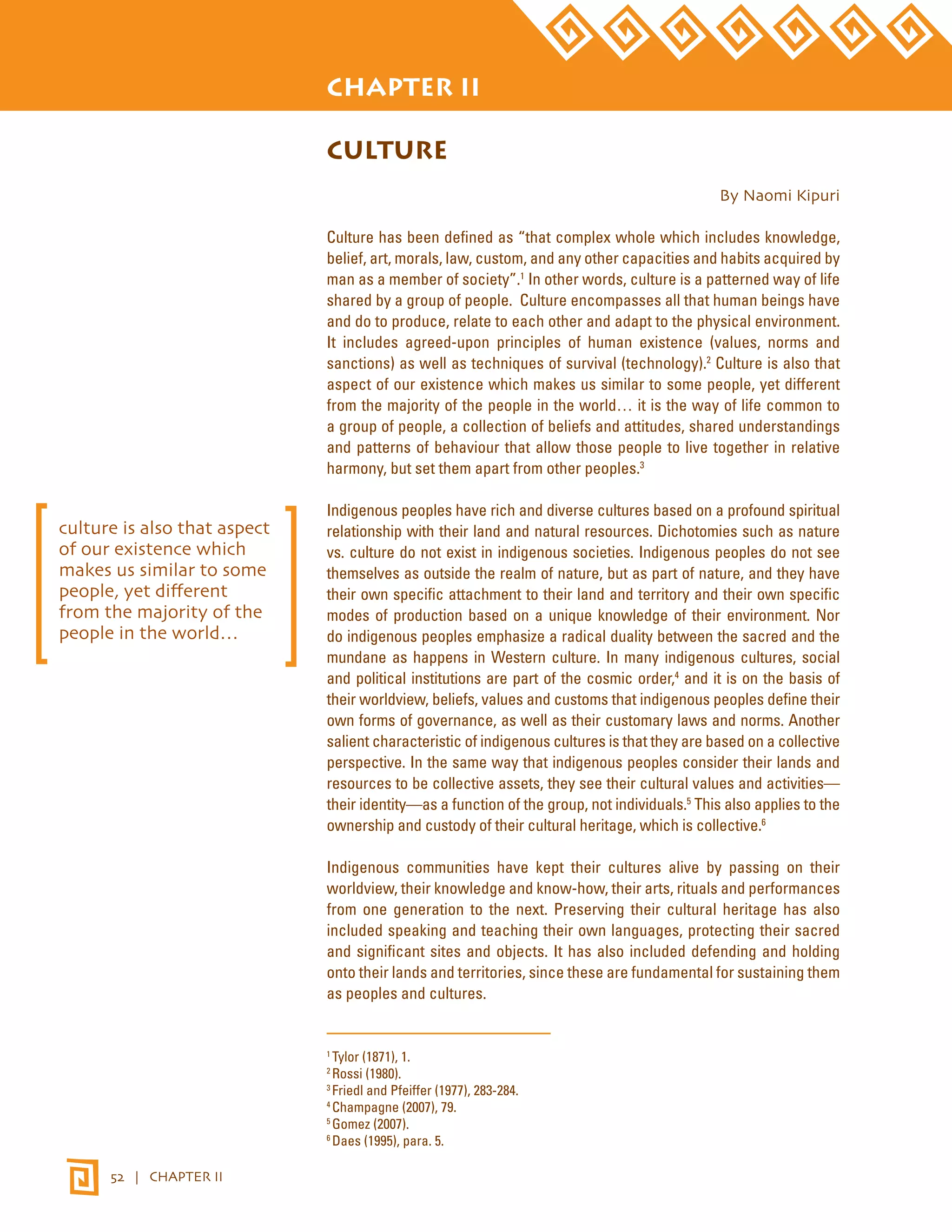
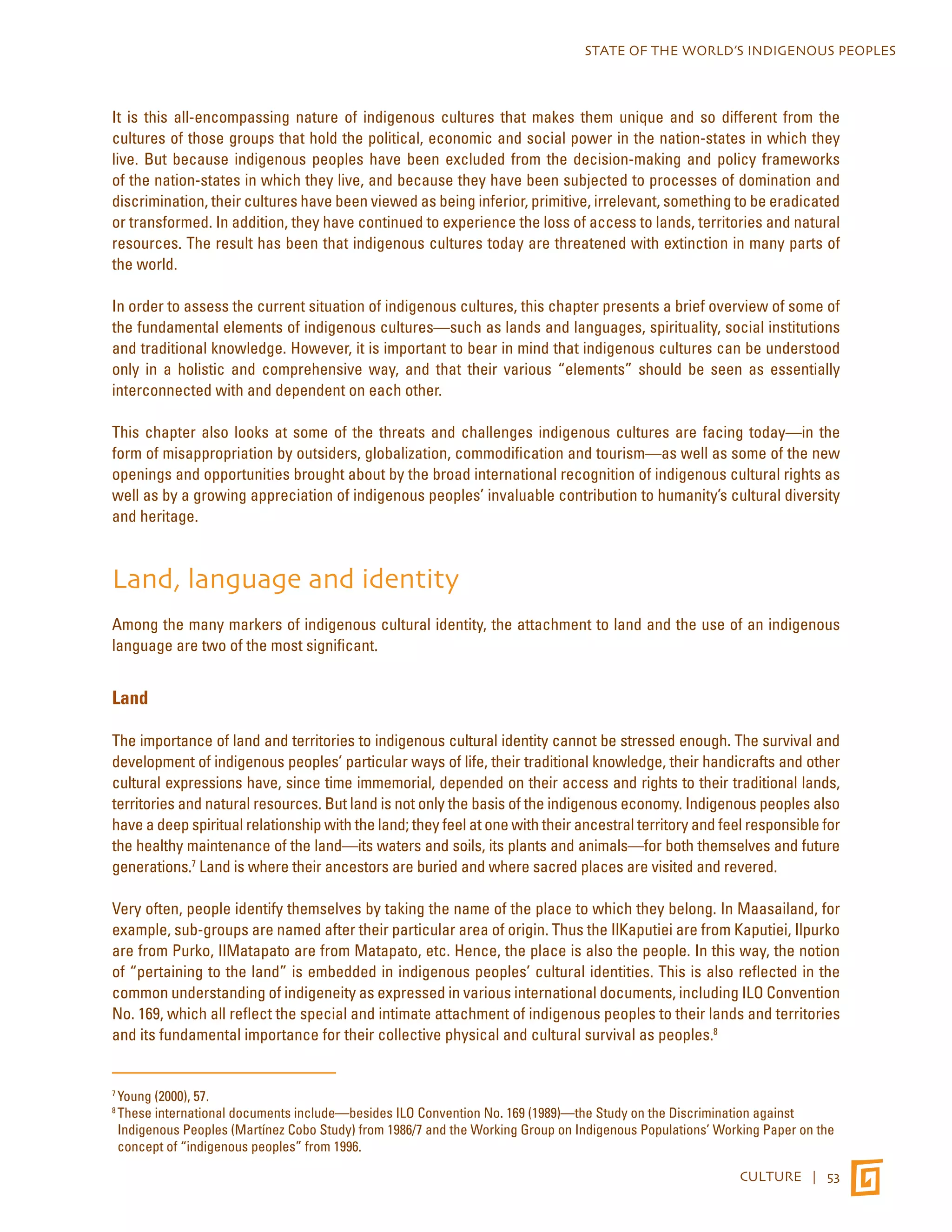
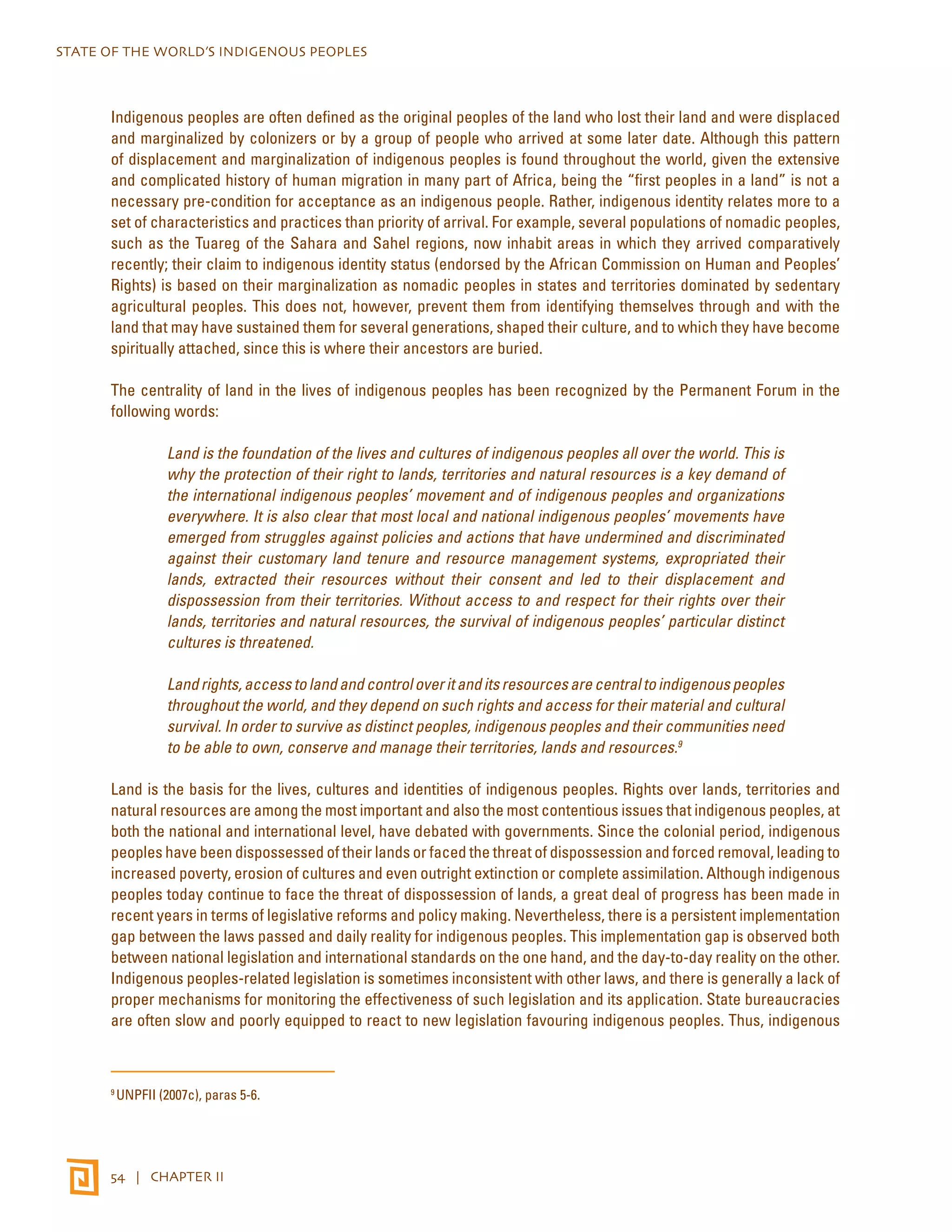
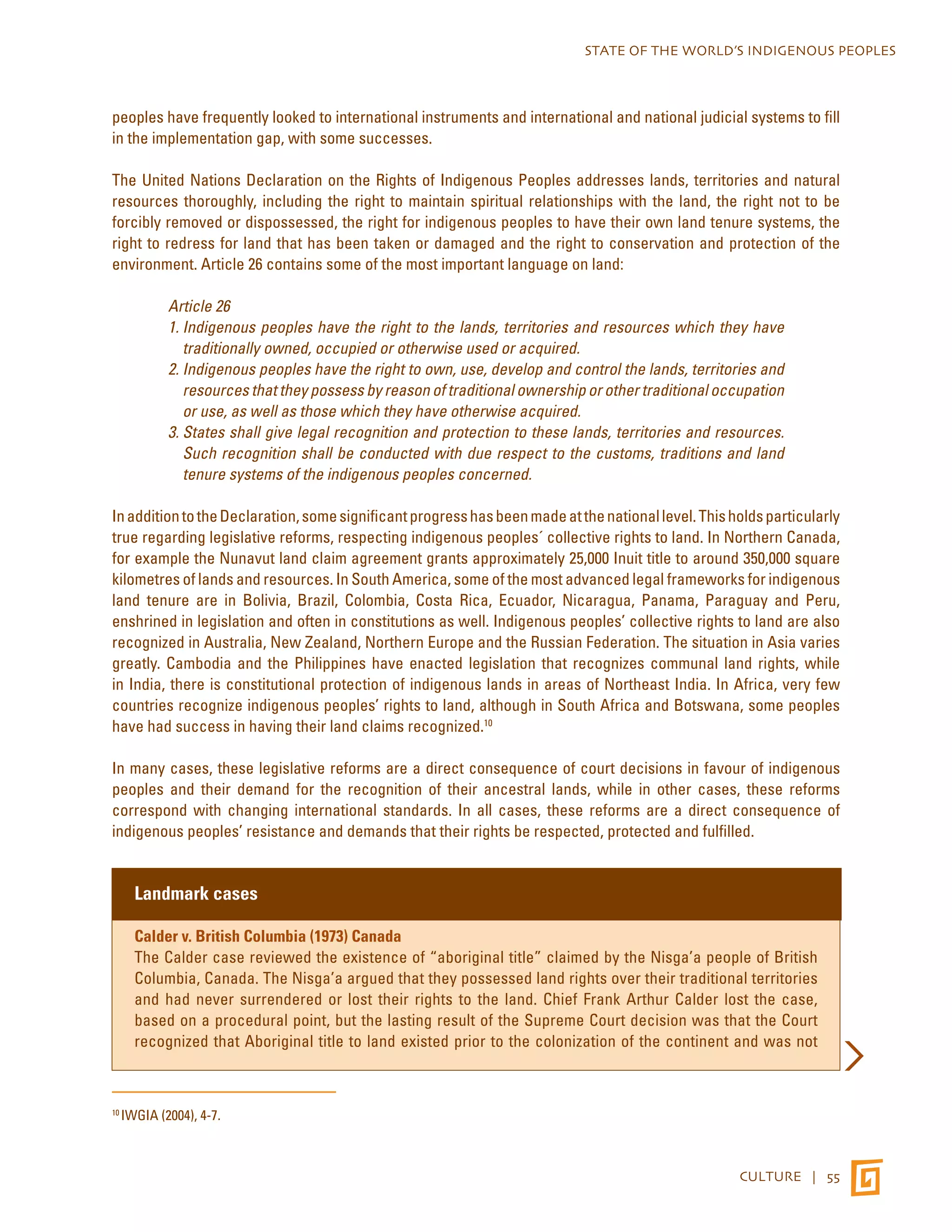
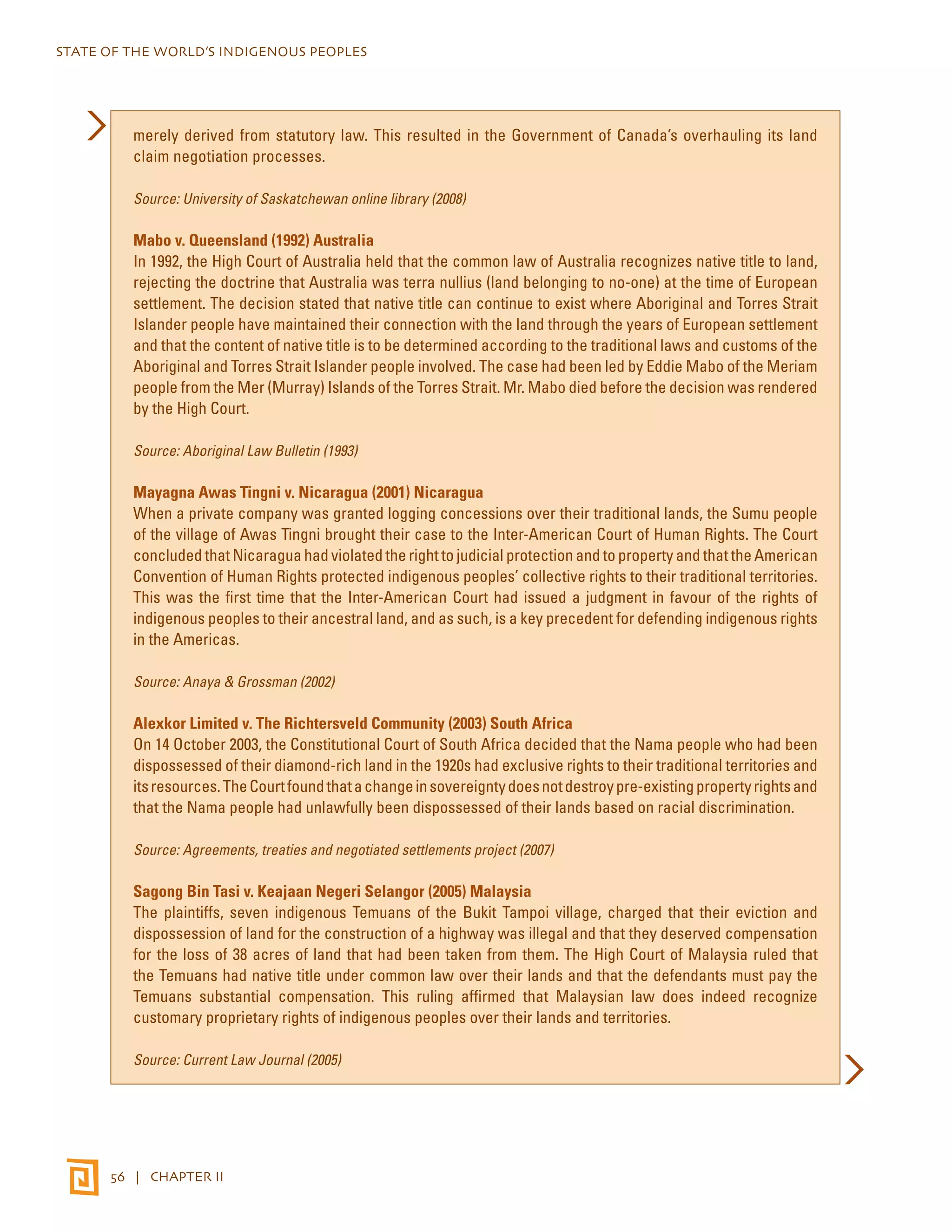



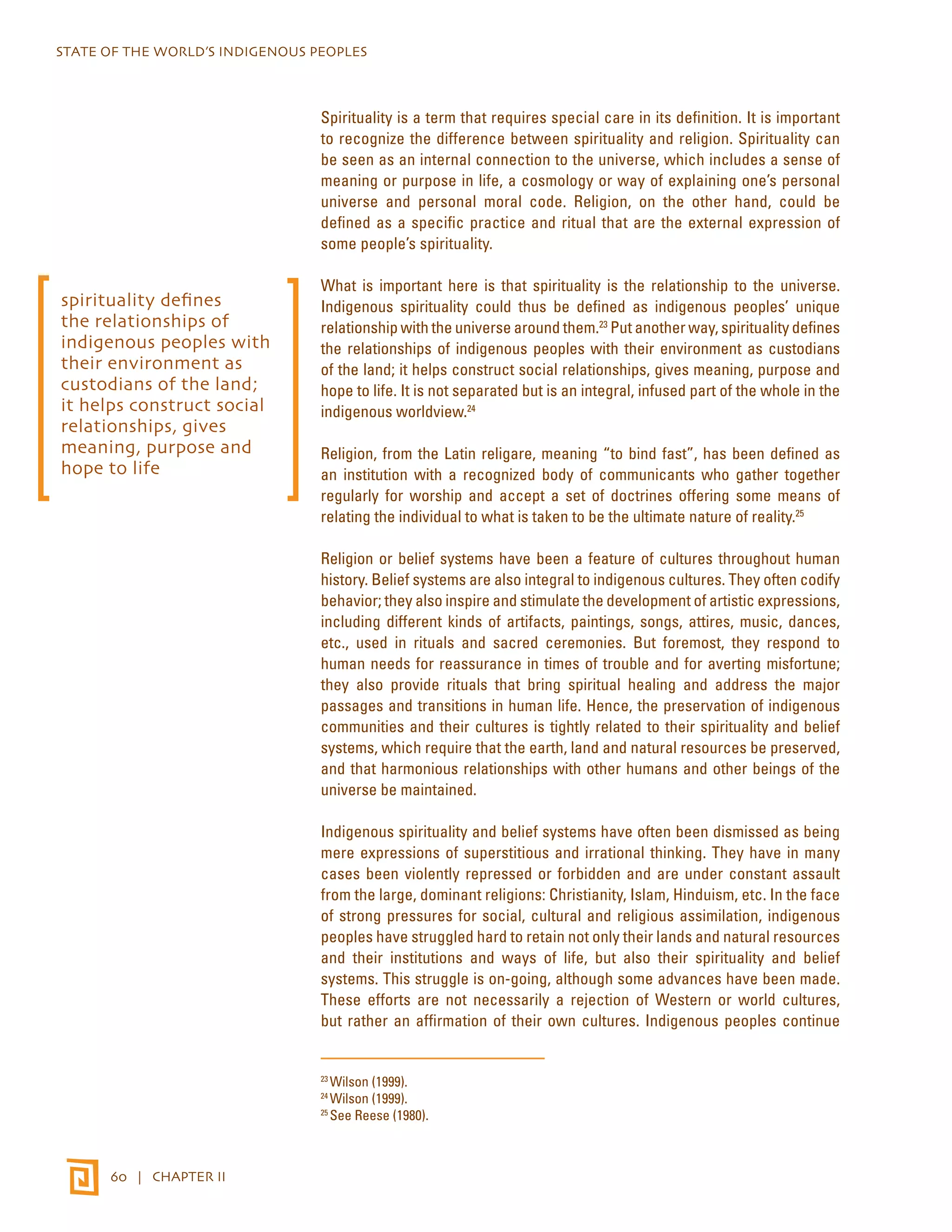
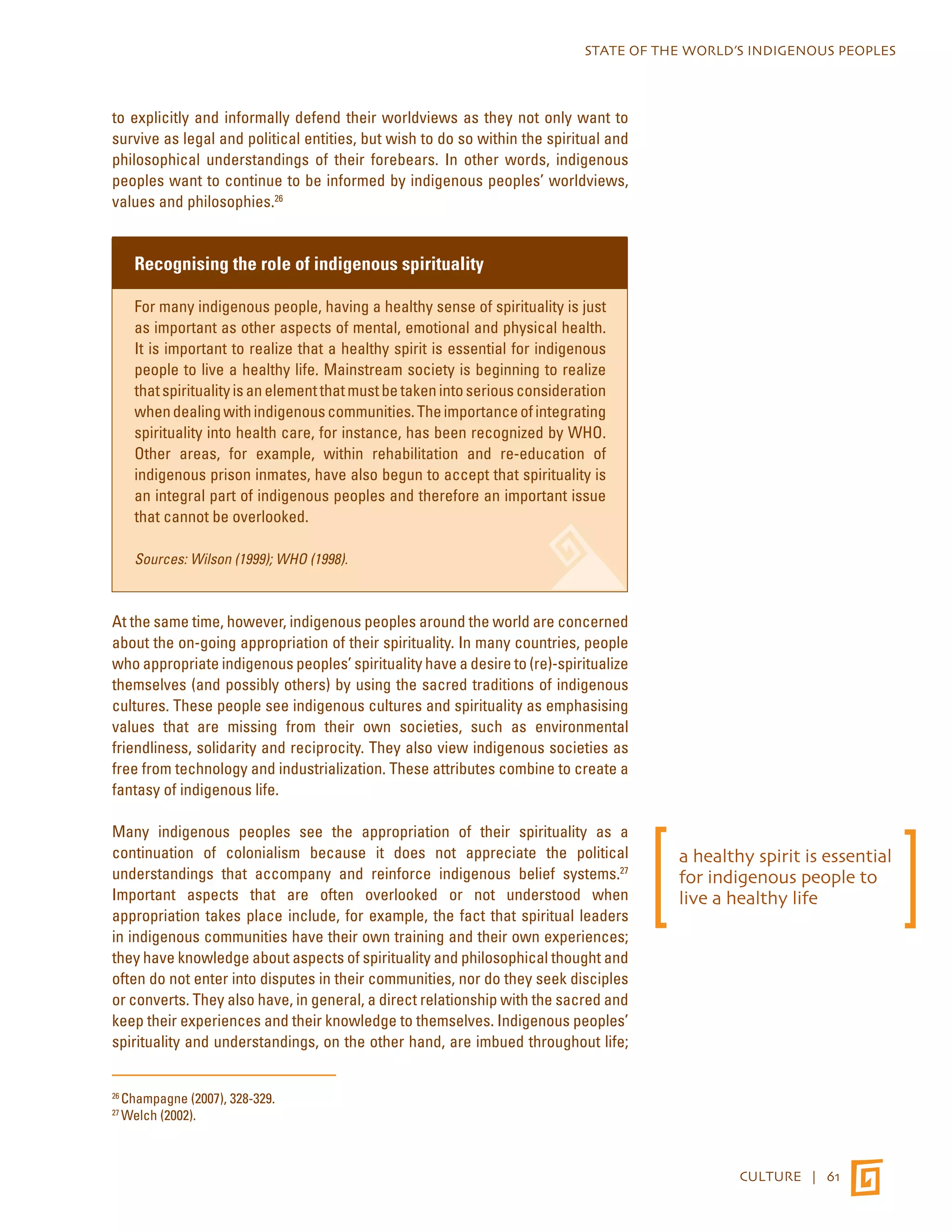
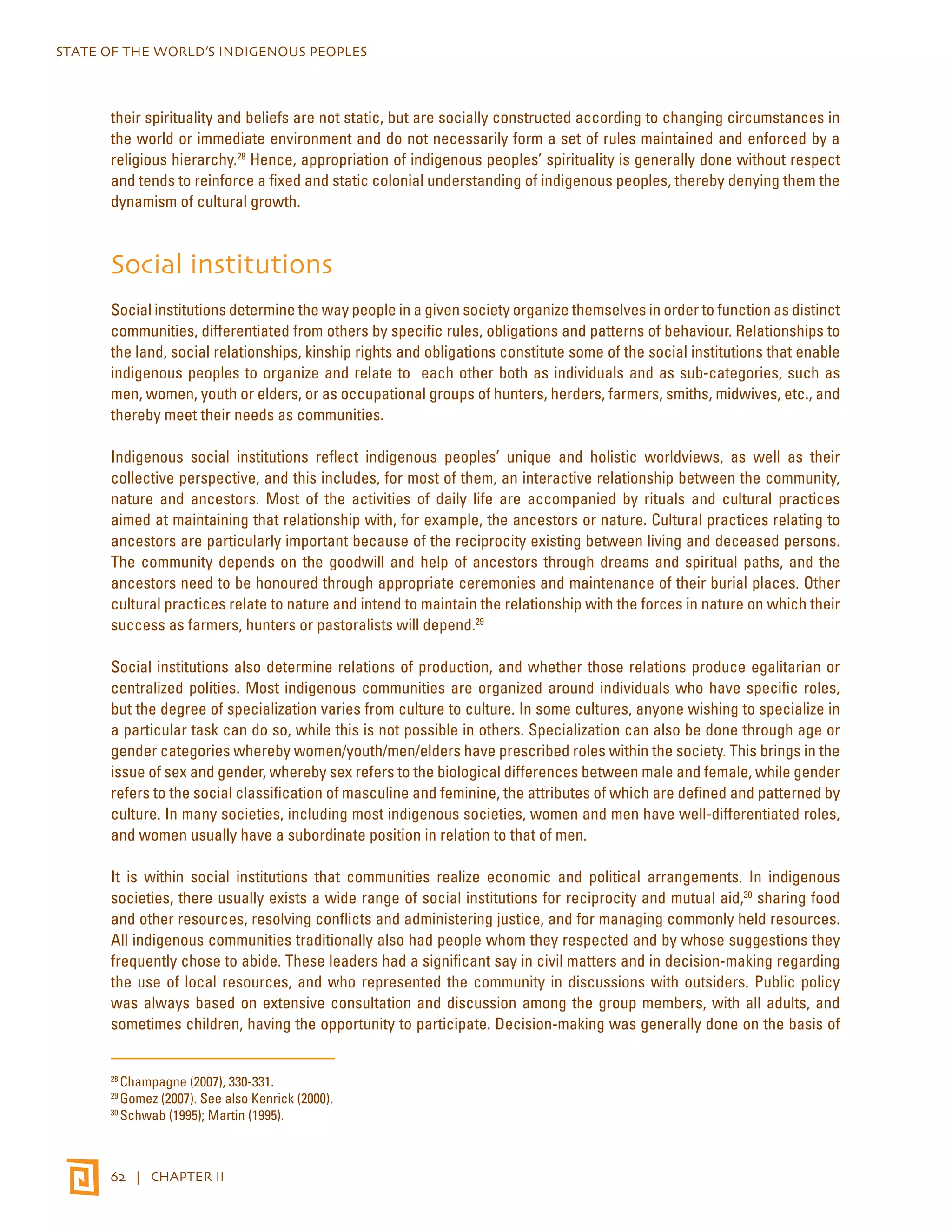
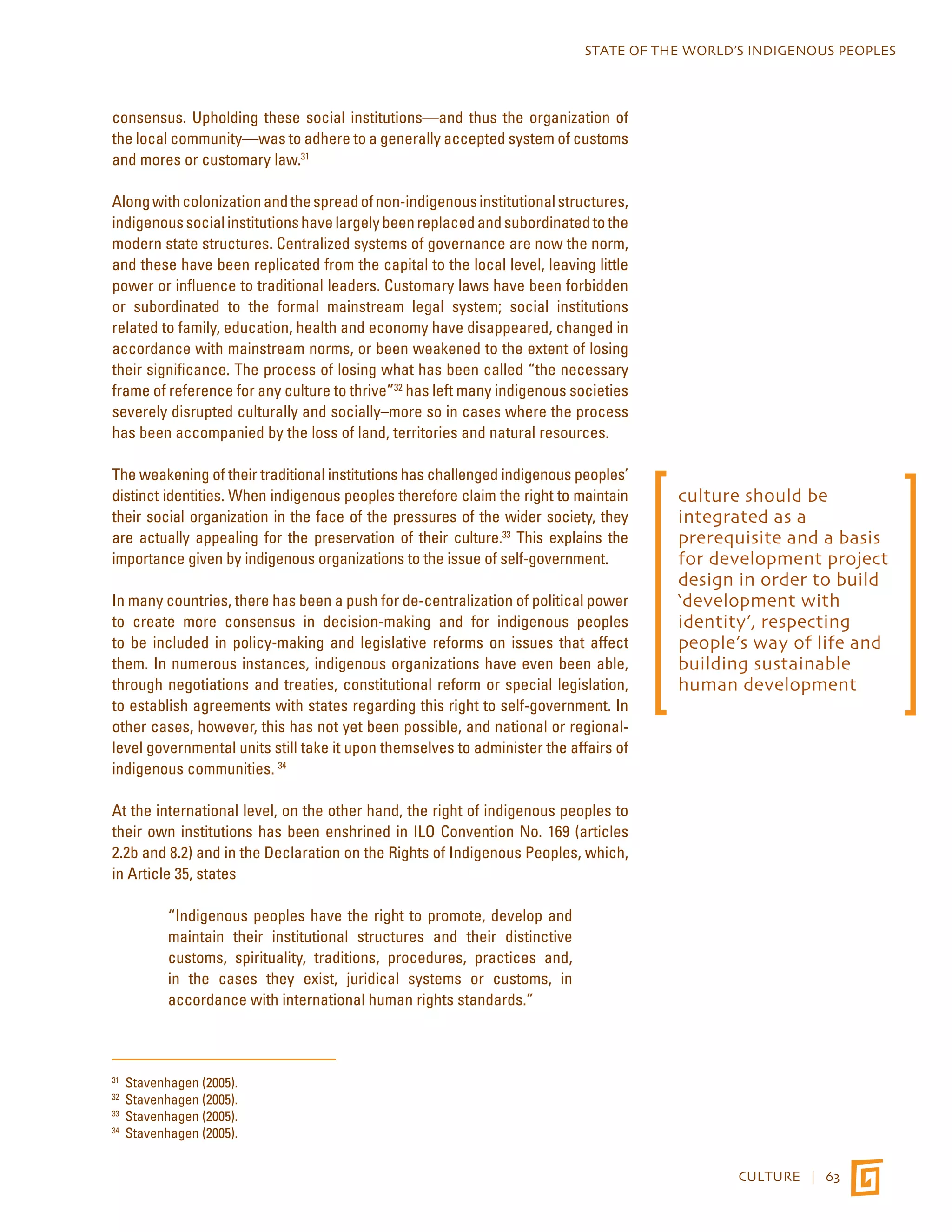
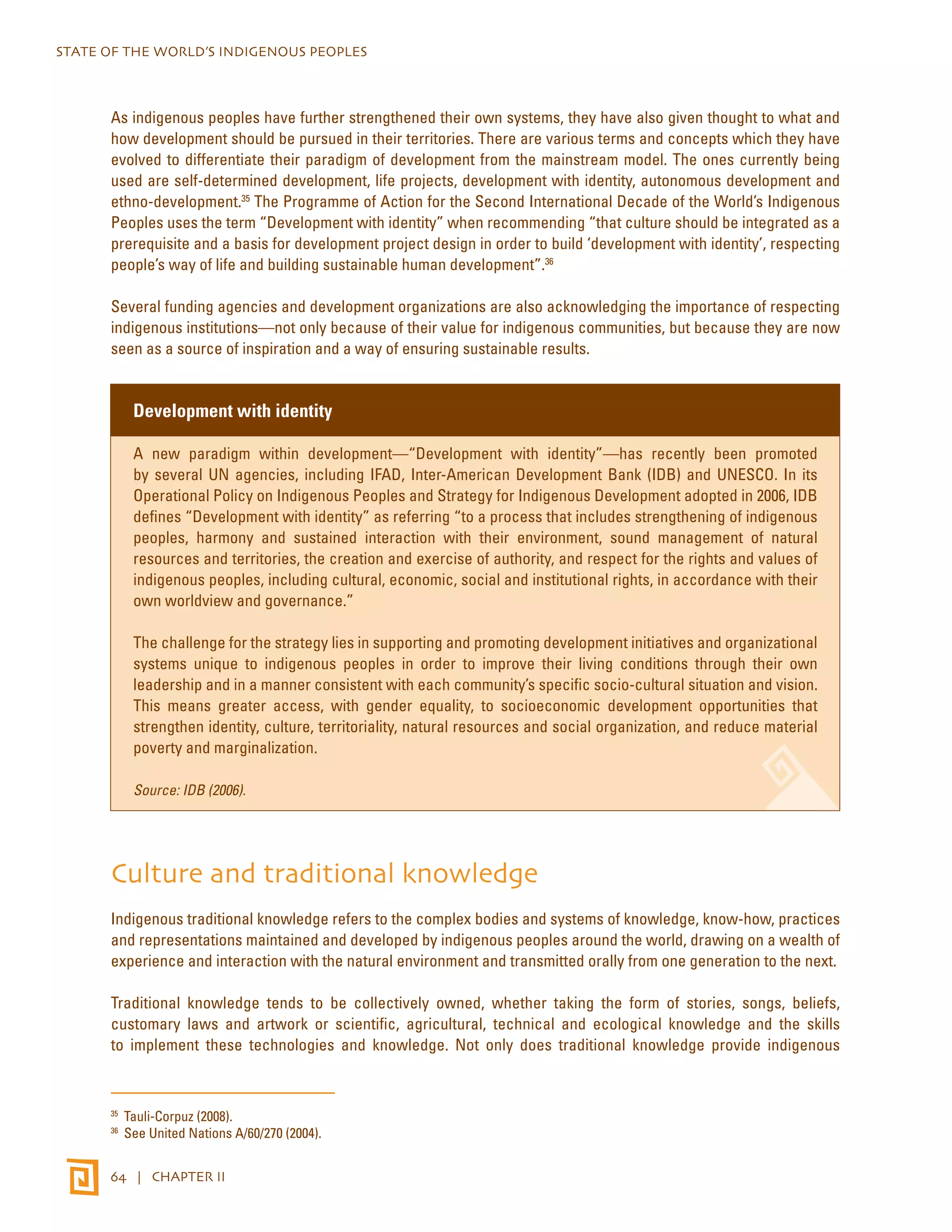
![STATE OF THE WORLD’S INDIGENOUS PEOPLES
CULTURE | 65
peoples with tremendous possibilities for their daily life and sustainable and
collective development as peoples, it also reflects indigenous peoples’ holistic
worldviews, which are considered as a most important source of the world’s
cultural and biological diversity.37
Indigenous knowledge is embedded in community practices, institutions,
relationships and rituals and is inextricably linked to indigenous peoples’
identity, their experiences with the natural environment and hence their
territorial and cultural rights. Indigenous peoples therefore place a great deal
of importance on passing this knowledge on to future generations—not only
for the sake of preserving the knowledge, but also for preserving their own
cultures and identities.
The transmission of traditional knowledge
Tom Mexsis Happynook belongs to what he calls a hereditary whaling
family that comes from Cha-cha-tsi-us, which is part of the Huu-ay-aht
First Nation on the west coast of Vancouver Island, British Columbia,
Canada. He recalls the following:
As a child, I was fortunate to be raised and taught by my
grandfather, two great-grandmothers and two great-aunts. I am
still being taught by my grandmother, who has turned 85. She
was taught by her grandmother, who died in 1958 at the age of
108. I am still receiving the teachings from the mid-1800s.
What did they teach me? I was taught that there is a natural law
of nature which we must live by; that we are only one component
in the web of life; that we are not dominant over the environment
but, in fact, related; that we take only what we need and utilize all
that we take; that everything is inter-connected, and when one
component in the environment or ecosystem is over-exploited
and not protected, the balance is lost.
Source: Happynook (2000), 64.
Traditional knowledge is also directly linked to the concept of self-determination
in the sense that indigenous peoples have the right to manage their own heritage,
knowledge and biodiversity and, in order to do so, their rights to their territories
and resources must be fully recognized and protected. In other words, “the right
to self-determination requires that [indigenous peoples] must be able to freely
dispose of their wealth and resources, and they must not be deprived of their
means of subsistence”.38
37 SPFII (2005), 4.
38 See, e.g., the UN Human Rights Committee Observations on Norway and Canada (1999).
traditional knowledge
tends to be collectively
owned](https://image.slidesharecdn.com/sowipweb-141112214427-conversion-gate02/75/Sowip-web-76-2048.jpg)
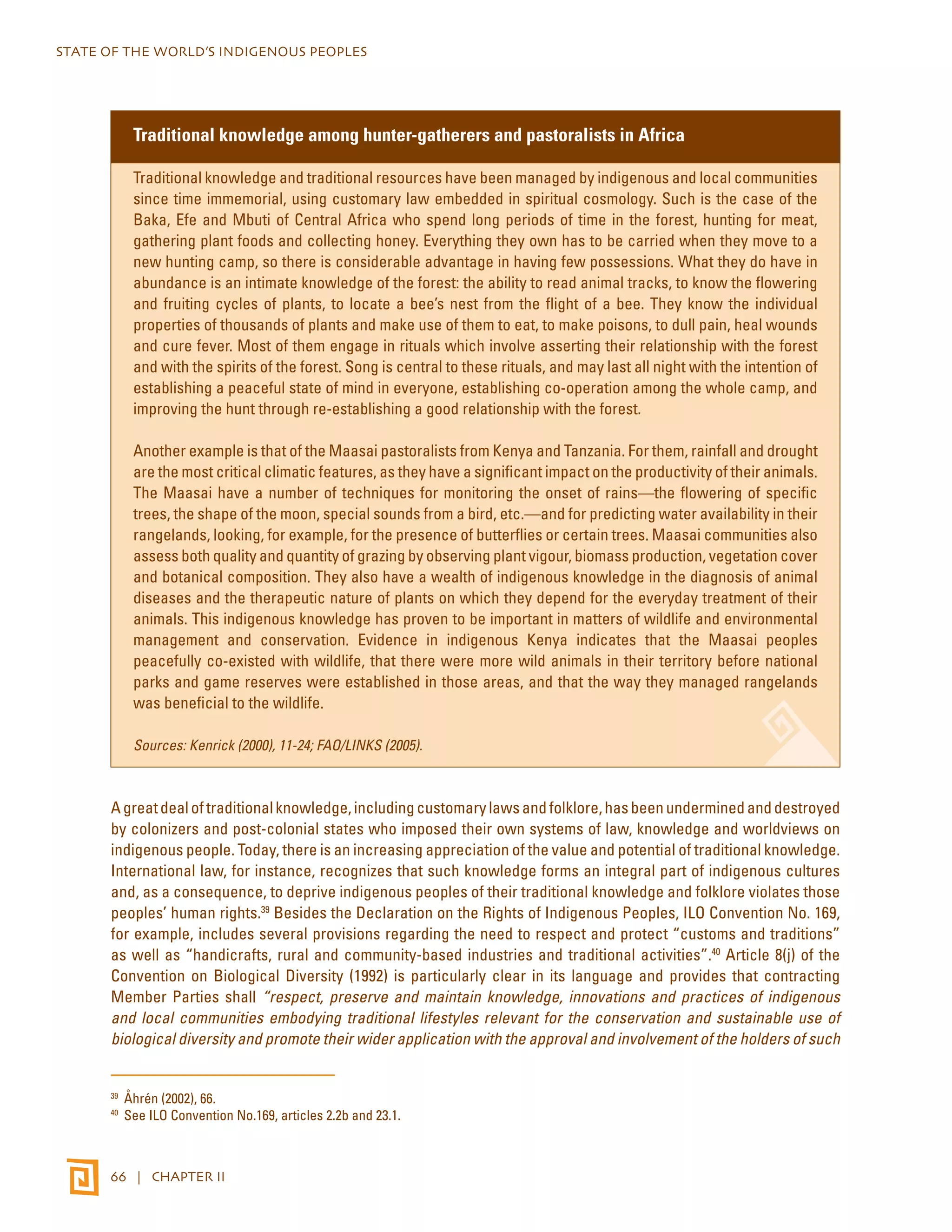
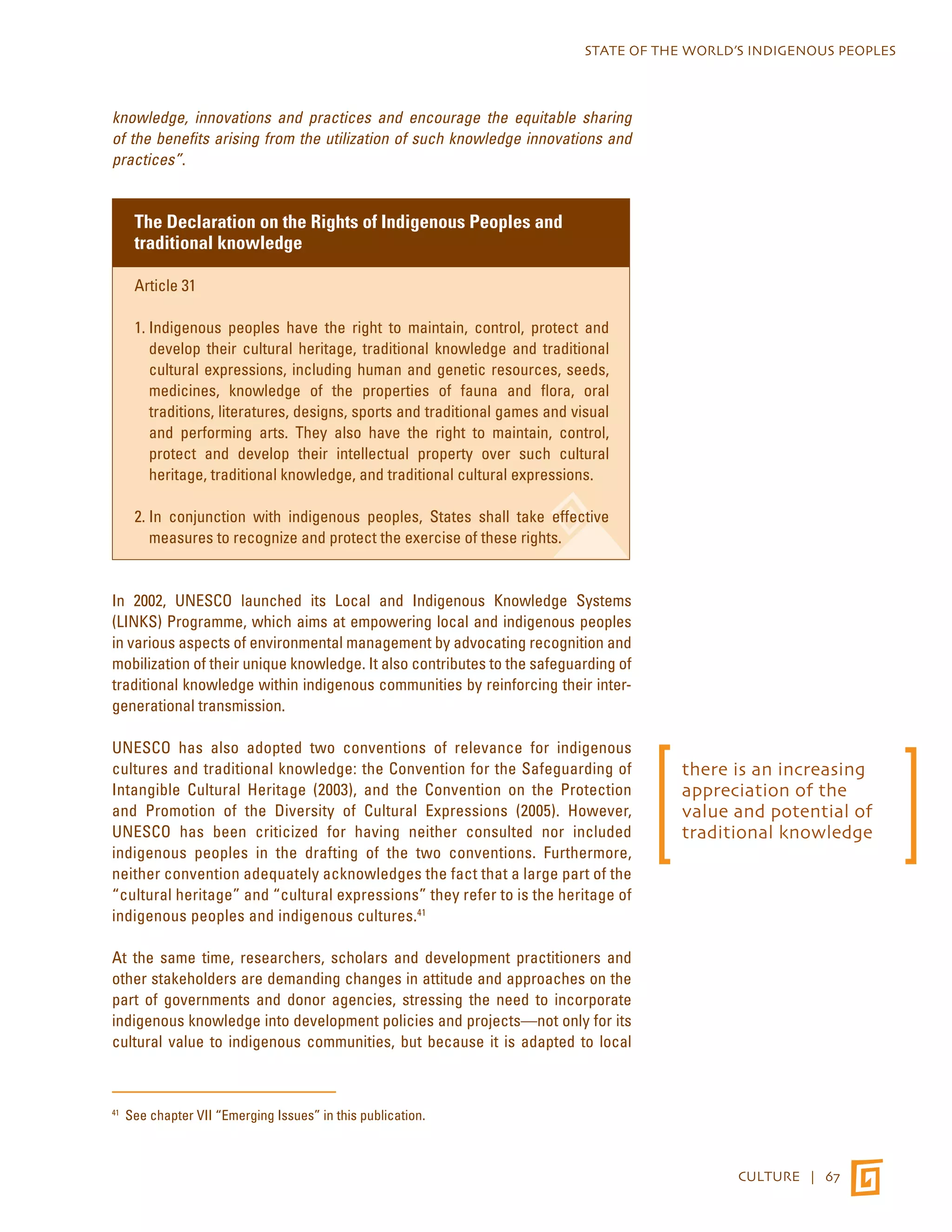
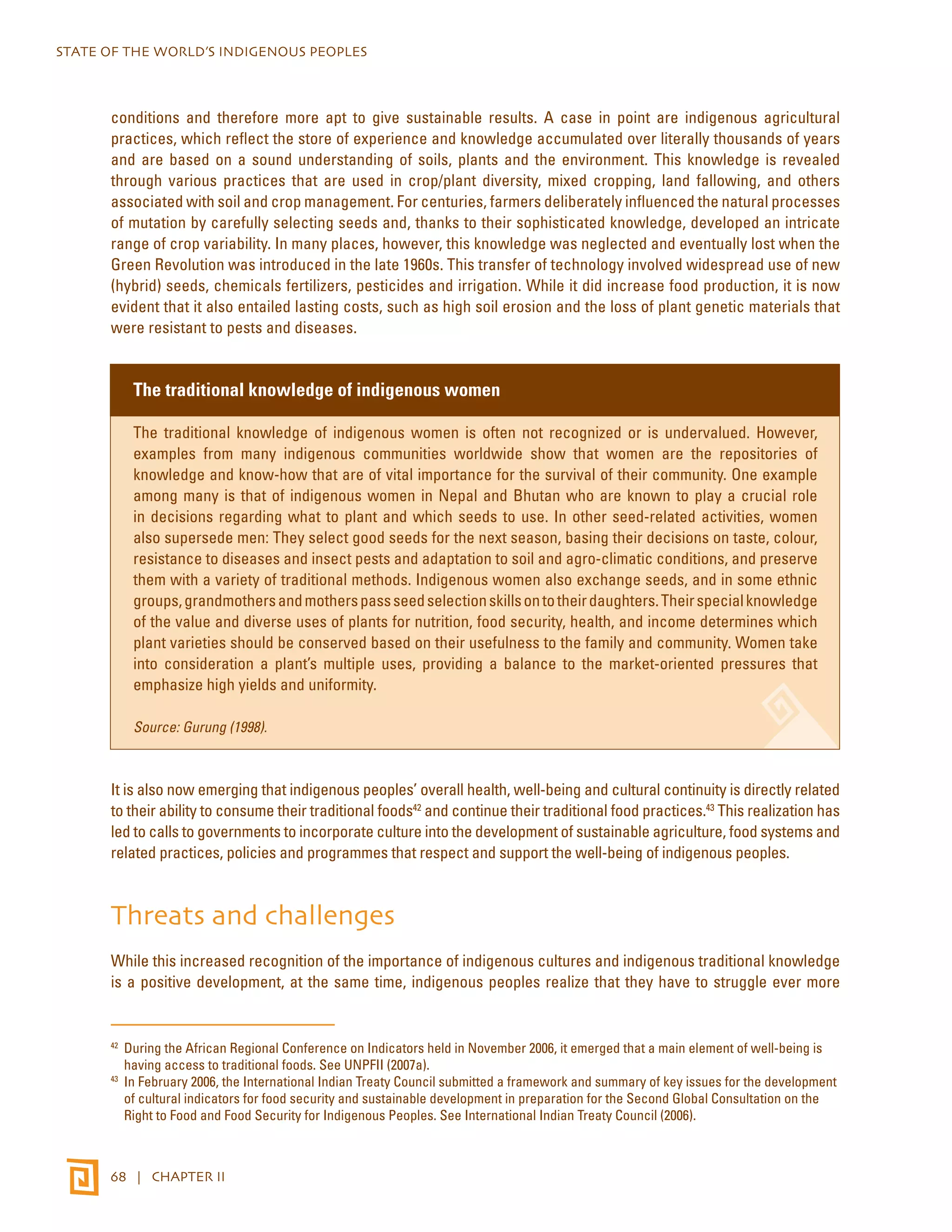

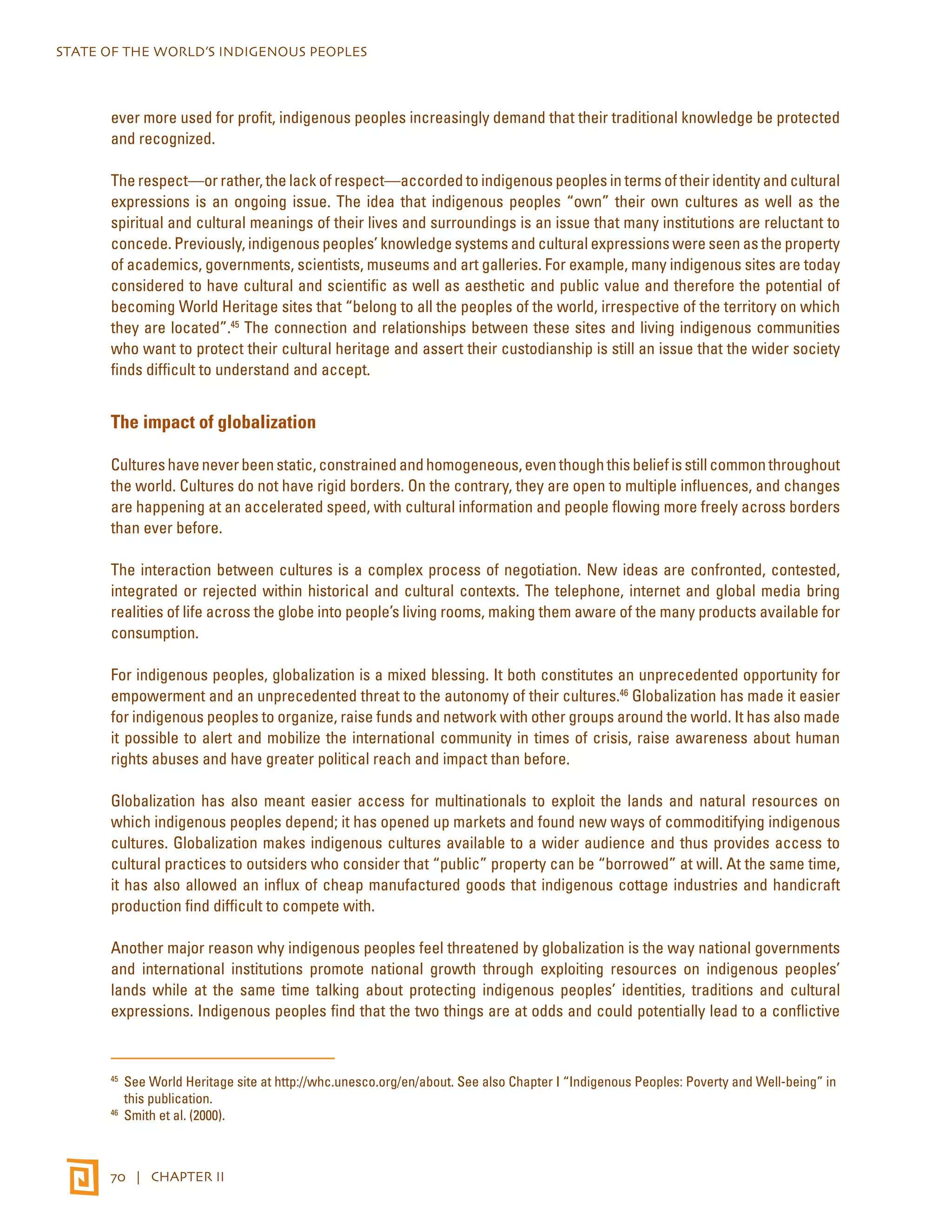
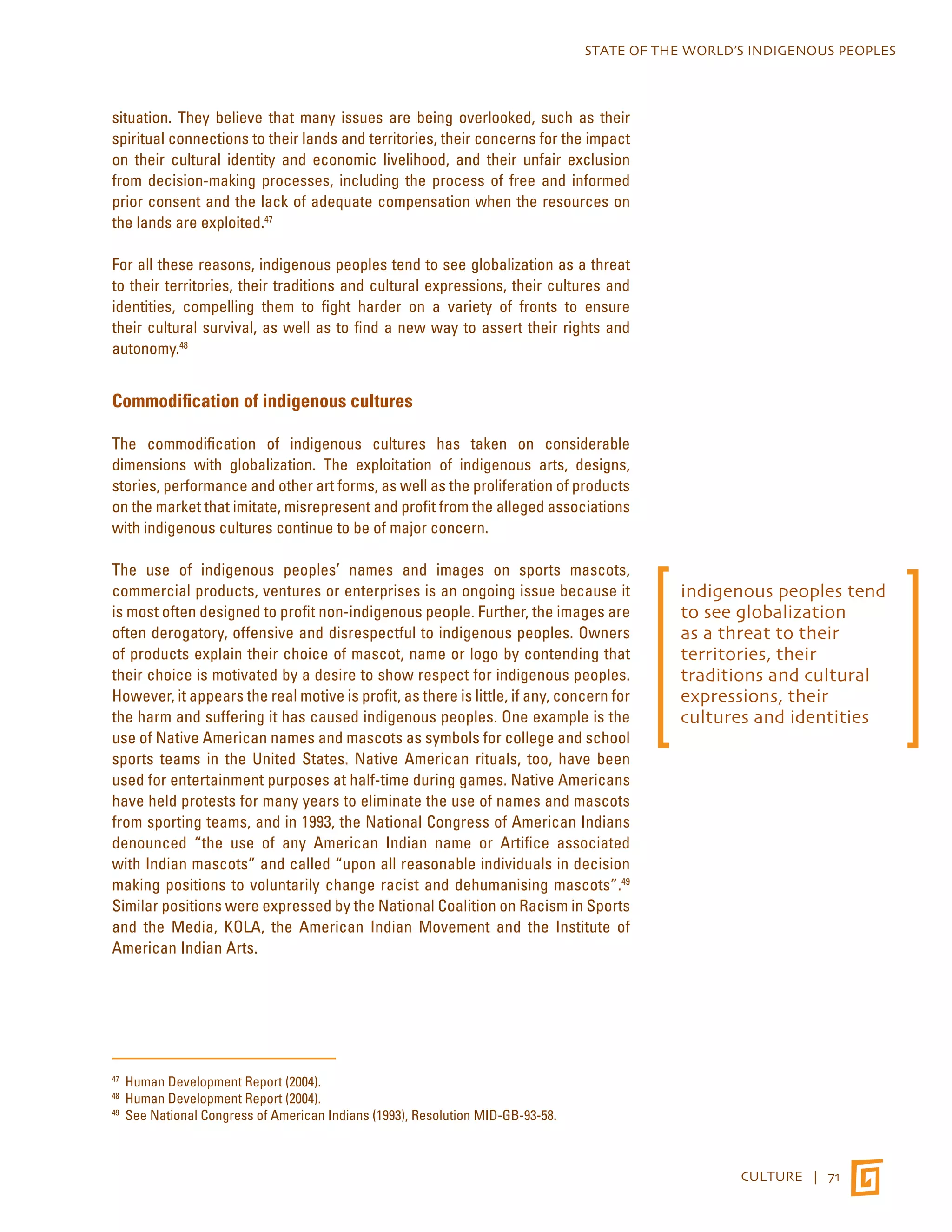

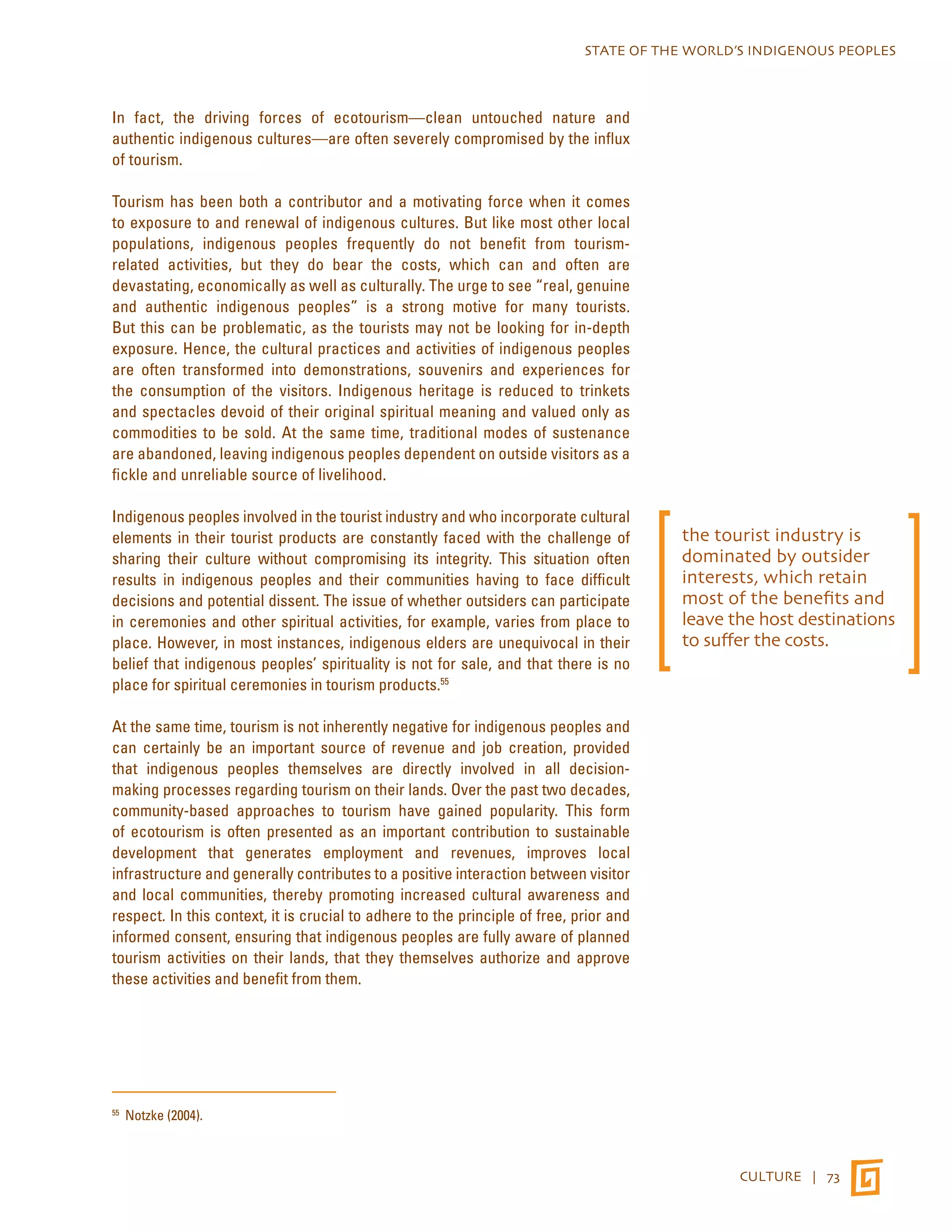

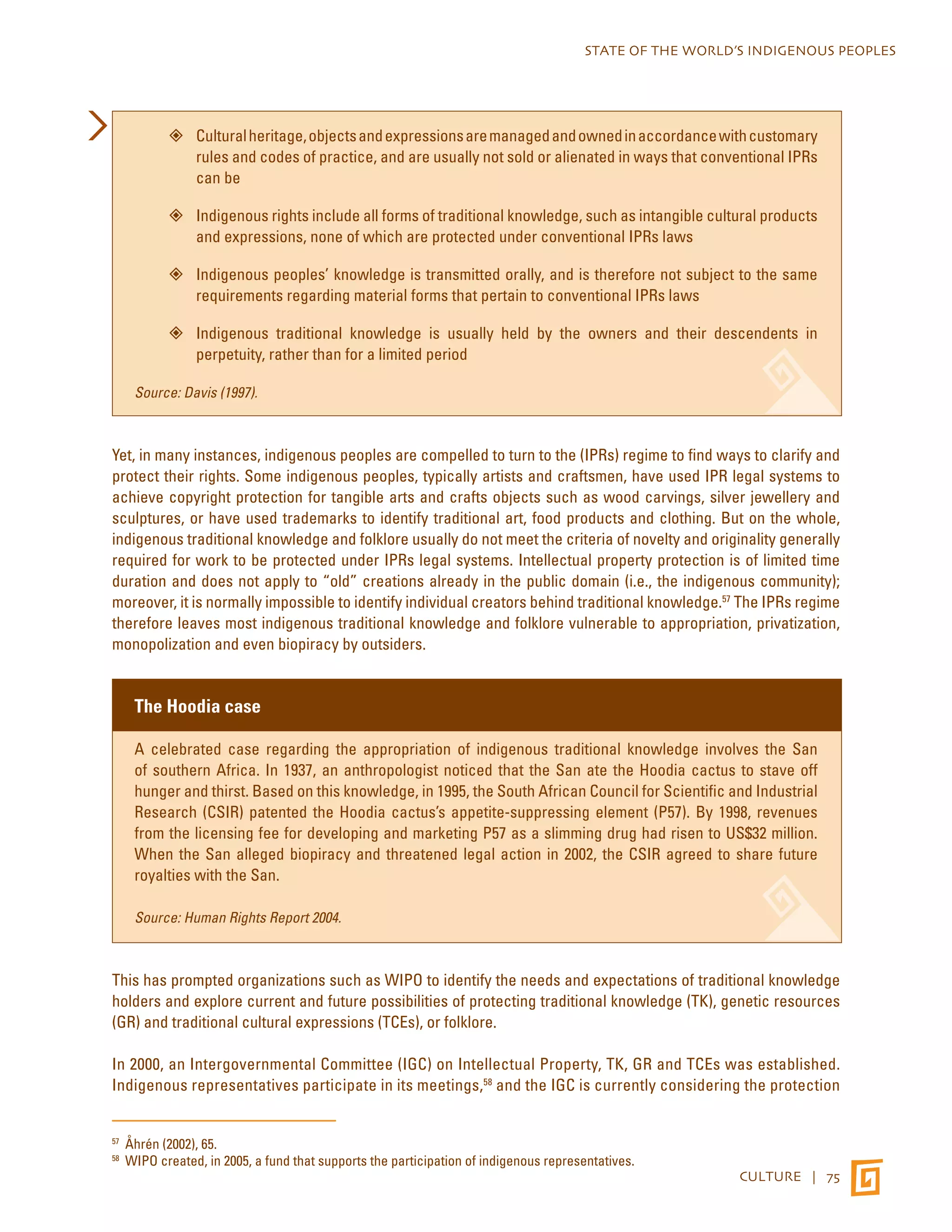
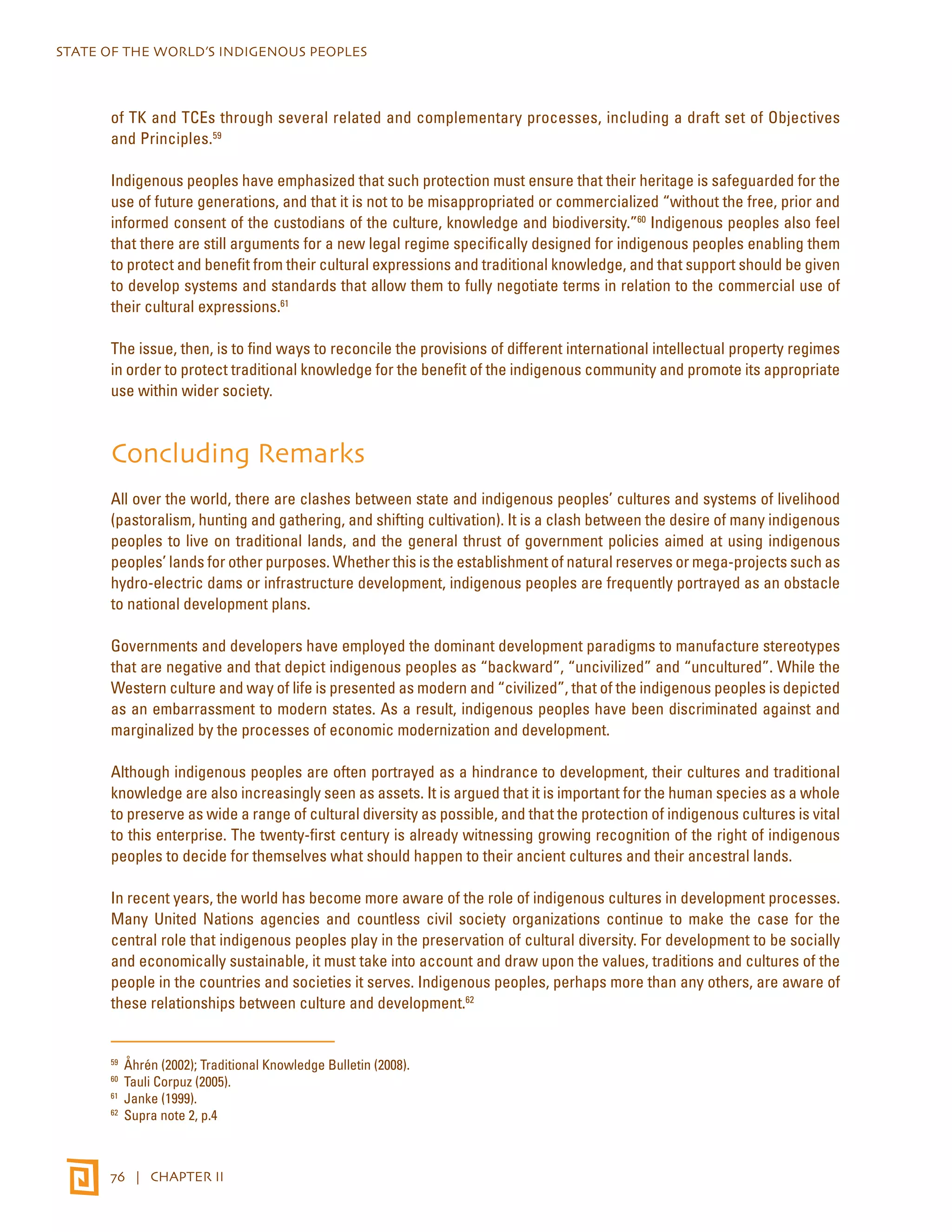
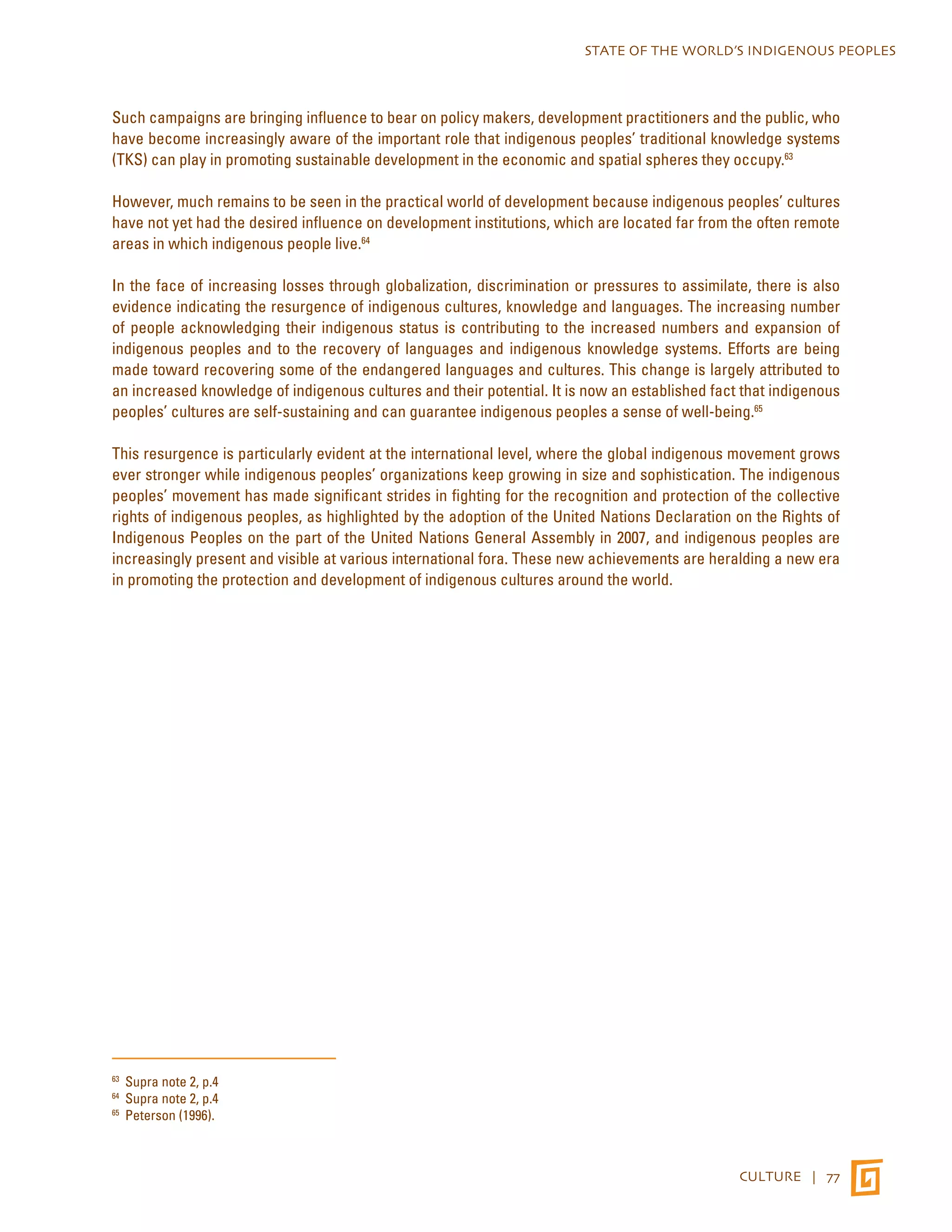
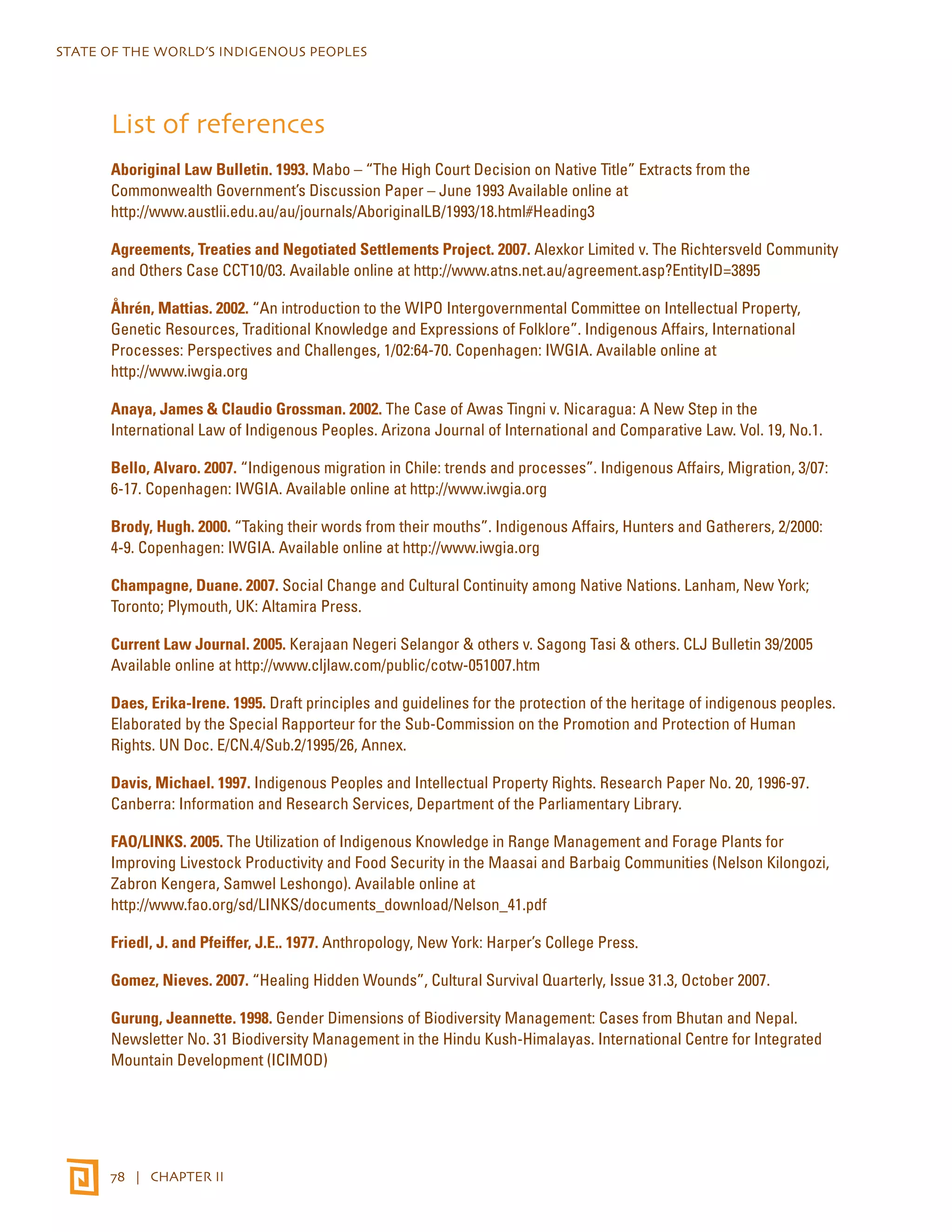
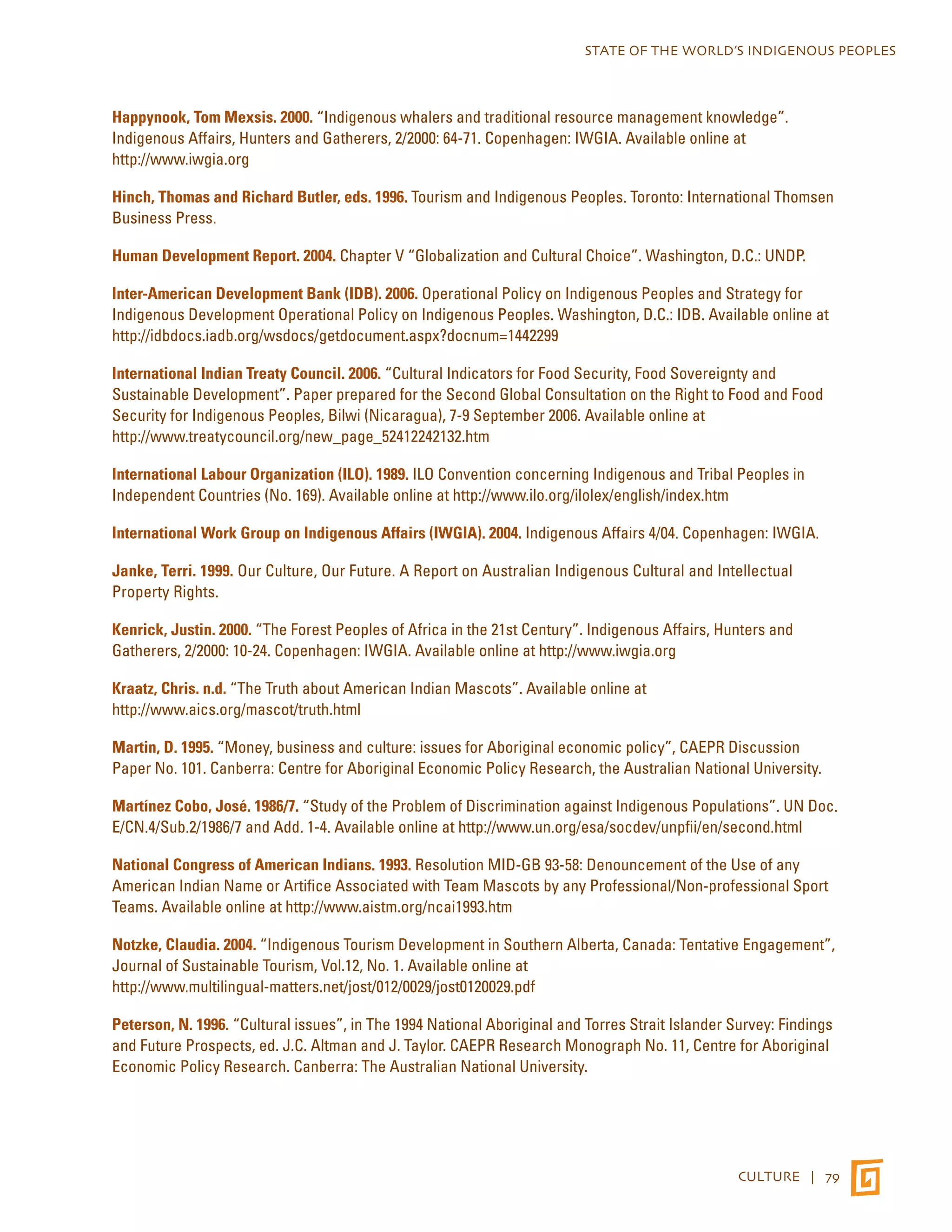
![STATE OF THE WORLD’S INDIGENOUS PEOPLES
Reese, William L. 1980. Dictionary of Philosophy and Religion: Eastern and Western Thought. Atlantic
Highlands, N.J.: Humanities Press
Rossi, I., ed. 1980. People in Culture: A Survey of Cultural Anthropology. New York: Praeger.
Schwab, R.G. 1995. “The calculus of reciprocity: principles and implications of Aboriginal sharing”, CAEPR
Discussion Paper No. 100, Centre for Aboriginal Economic Policy Research. Canberra: The Australian National
University.
Skutnabb Kangas, Tove. 2000. Linguistic Genocide in Education – or worldwide diversity and human rights?
Mahwah, N.J.: Lawrence Erlbaum Associates.
Smith, Claire, Burke, Heather and Ward, Graeme K.. 2000. “Globalisation and Indigenous Peoples: Threat or
Empowerment?” In Indigenous Cultures in an Interconnected World, ed. Graeme Ward and Claire Smith. St
Leonards, N.S.W.: Allen & Unwin.
Secretariat of the Permanent Forum on Indigenous Issues (UNPFII). 2005. Background note prepared by the
Secretariat of the Permanent Forum for the International Workshop on Traditional Knowledge, Panama City, 21-
23 September 2005. Doc. PFII/2005/WS.TK. Available online at
http://www.un.org/esa/socdev/unpfii/documents/workshop_TK_background_note.pdf
South African Legal Information Institute. 2006. Sesana and Others v Attorney General (52/2002) [2006] BWHC 1
(13 December 2006) Available online at http://www.saflii.org/bw/cases/BWHC/2006/1.html
Stavenhagen, Rodolfo. 2005. Indigenous Peoples: An Essay on Land, Territory, Autonomy and Self-
Determination. Available online at Land Research Action Network (LRAN) website http://www.landaction.org
Tauli-Corpuz, Victoria. 2005. Biodiversity, Traditional Knowledge and Rights of Indigenous Peoples. IPRs Series
No. 5. Presented at the International Workshop on Traditional Knowledge, Panama City, 21-23 September 2005.
Available online at http://www.un.org/esa/socdev/unpfii/documents/workshop_TK_taulicorpuz.pdf
Tauli-Corpuz, Victoria. 2008. “Indigenous peoples’ concept of development with culture and identity”. Paper
presented at the UNESCO/IASG/UNPFII round-table discussion on “Indigenous Peoples: Development with
Culture and Identity” held in Paris 15 September, 2008.
Tourism Concern. 2002. “Why Tourism Concern is cautious about the International Year of Ecotourism.” Press
release 25.01.2002. Available online at http://tourismconcern.org.uk
Traditional Knowledge Bulletin. 2008. Available online at http://tkbulletin.wordpress.com
Tylor, E.B. 1924 [orig. 1871]. Primitive Culture. Researches into the Development of Mythology, Philosophy,
Religion, Language, Art and Custom. 2 vols. 7th ed. New York: Brentano’s.
UNESCO. 2003. “Language Vitality and Endangerment.” Document submitted by Ad Hoc Expert Group
on Endangered Languages to the International Expert Meeting on UNESCO Programme Safeguarding of
Endangered Languages, UNESCO Paris, 10–12 March 2003.
UNESCO. 2008. Background paper for “Thematic Debate: Protection Indigenous and Endangered Languages
and the Role of Languages in promoting EFA in the Context of Sustainable Development” prepared for the 180th
session of the Executive Board. Doc. 180 EX/INF.8.
80 | CHAPTER II](https://image.slidesharecdn.com/sowipweb-141112214427-conversion-gate02/75/Sowip-web-91-2048.jpg)
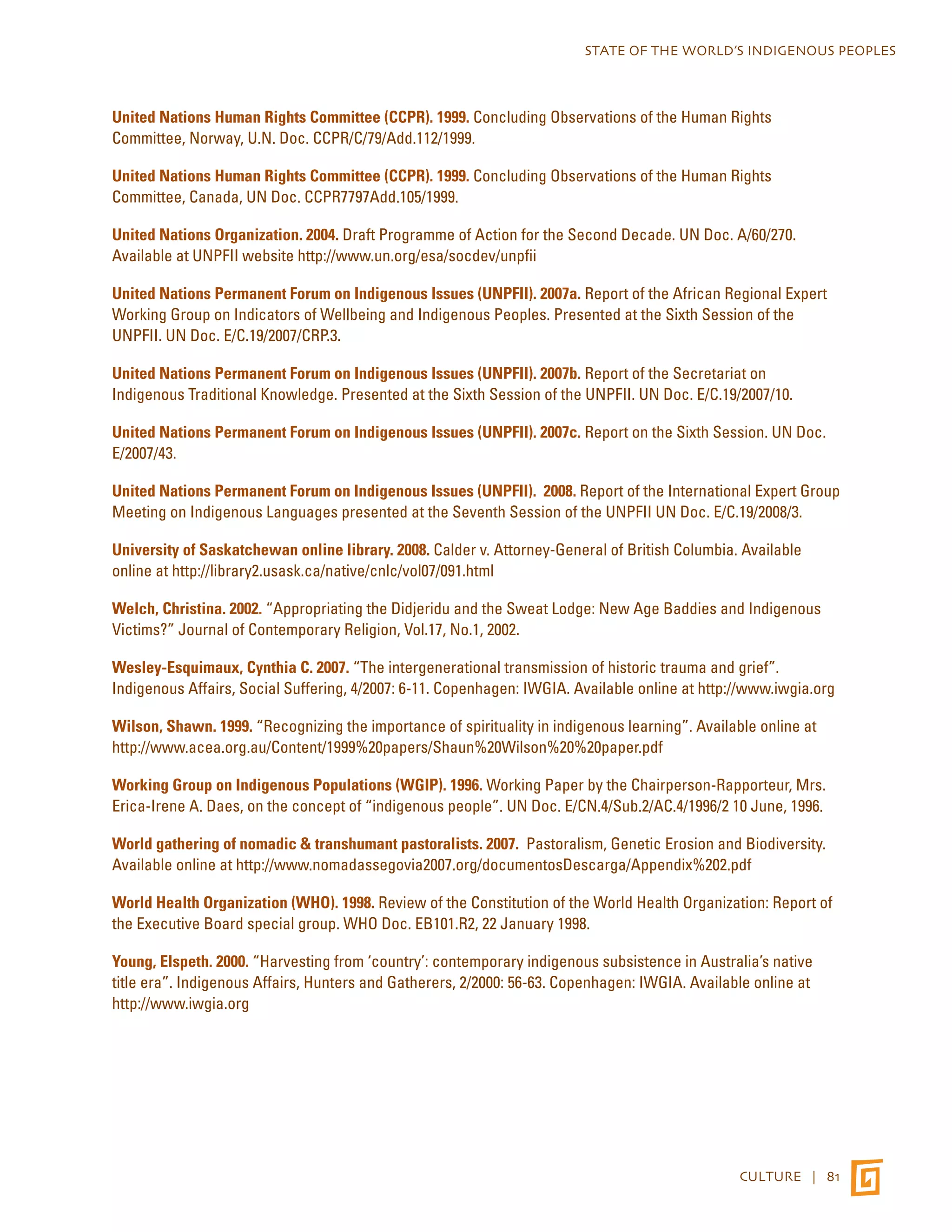

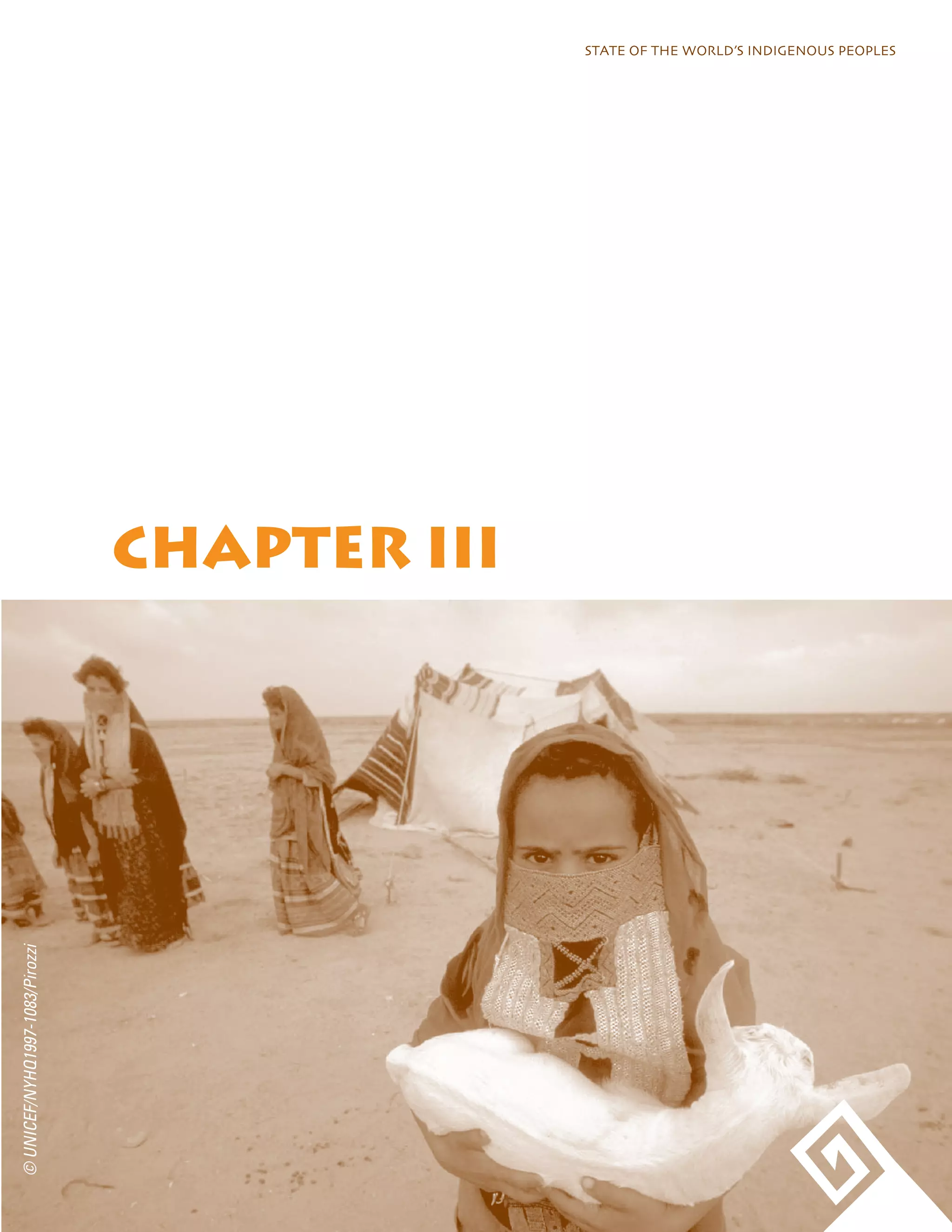

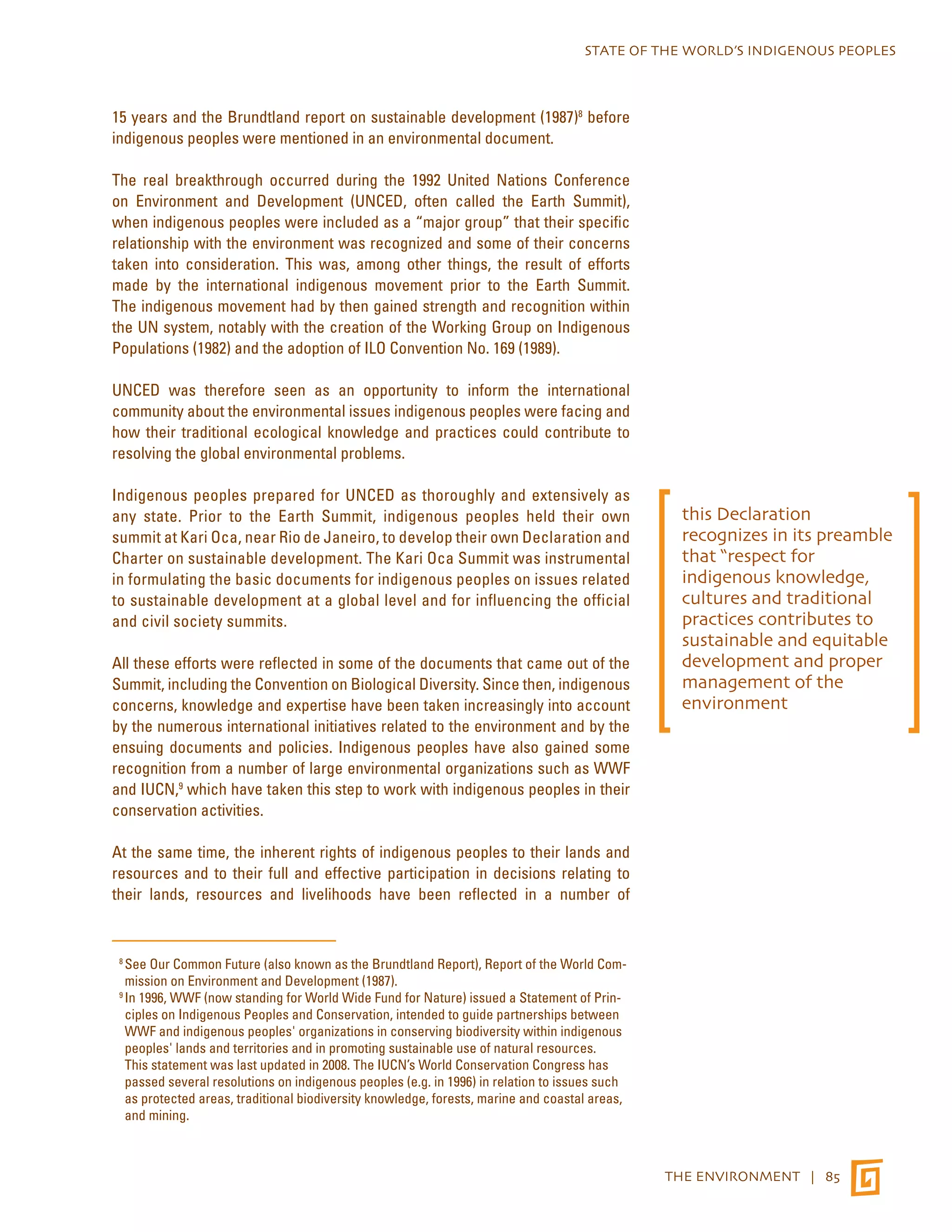
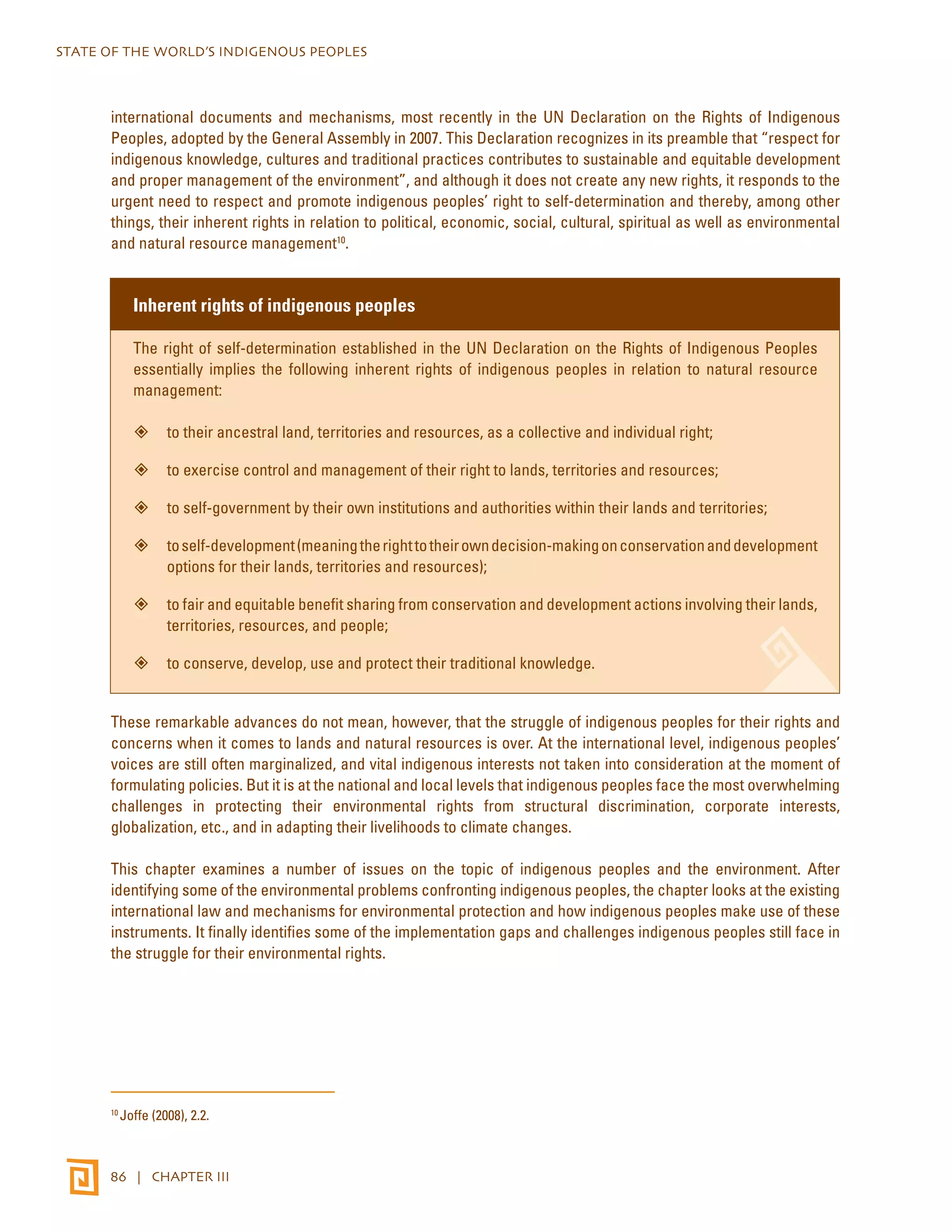
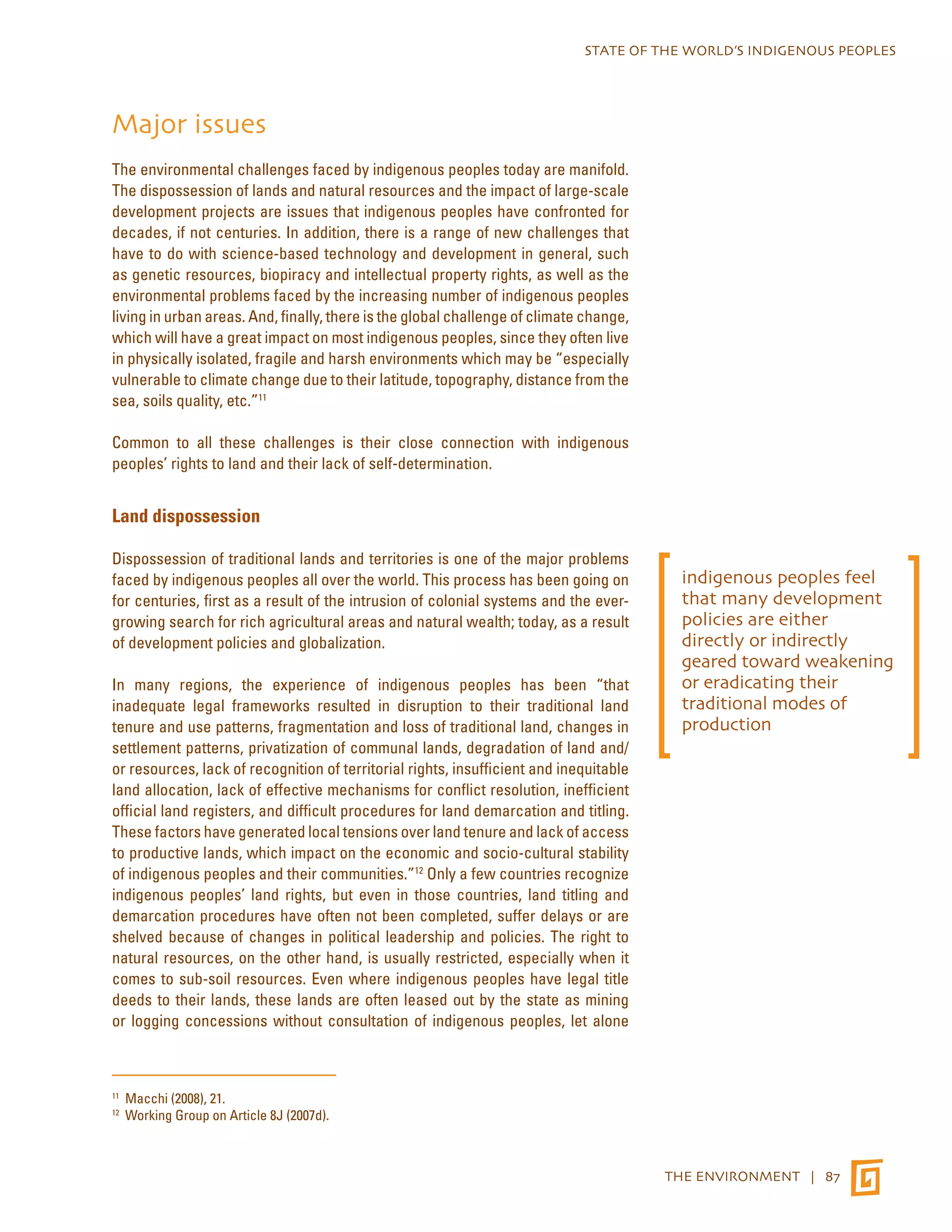
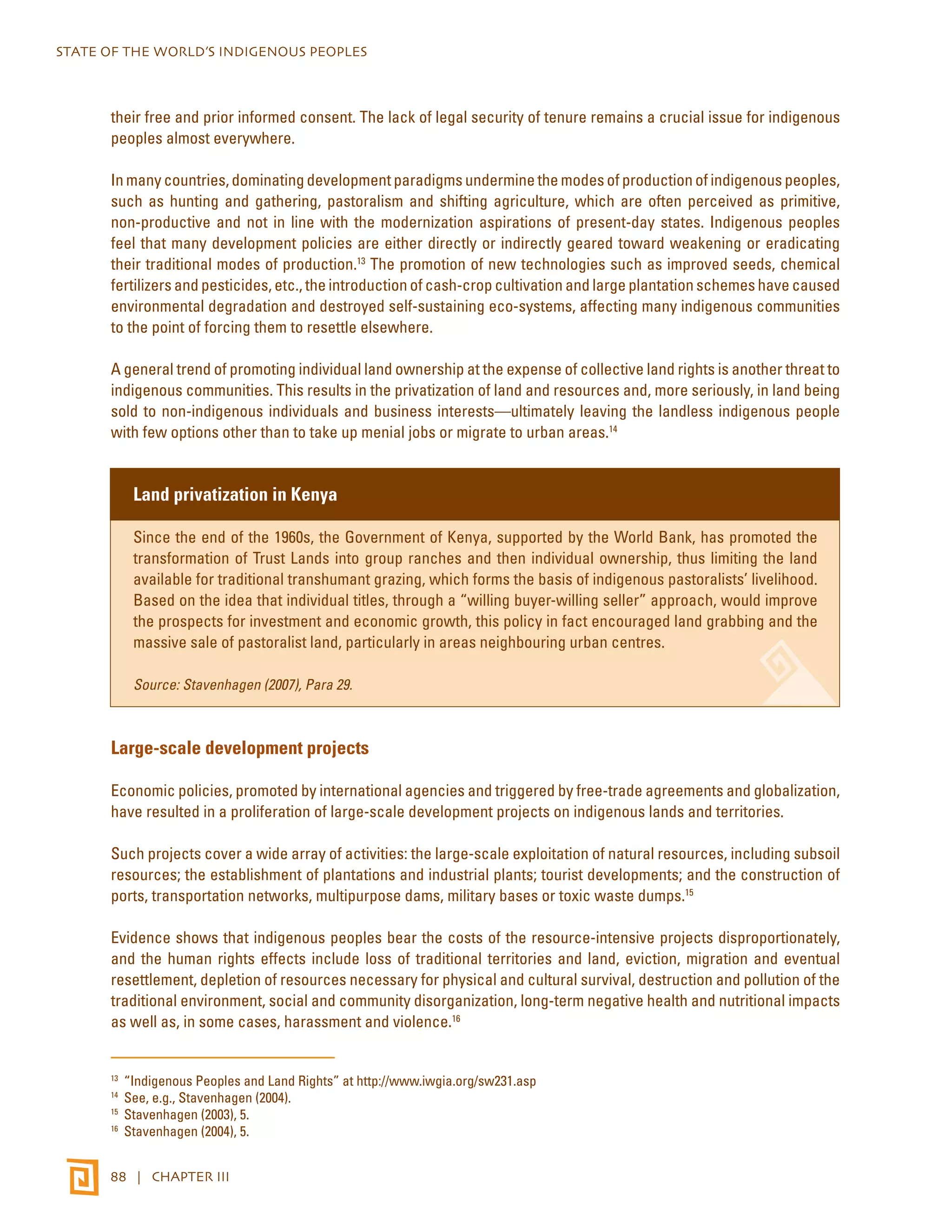
![STATE OF THE WORLD’S INDIGENOUS PEOPLES
THE ENVIRONMENT | 89
Large-scale developments and displacements of indigenous peoples
The Bakun Dam in Malaysia is reported to have caused the forced
displacement of 5,000-8,000 indigenous persons from 15 communities by
clear-cutting 80,000 hectares of rainforest. Indigenous peoples in Manipur,
India, were reported to have suffered a similar fate caused by the building
of 25 hydroelectric dams. Thousands of families of the Santhal Adivasi
people in Jharkhand province of India have reportedly been displaced
as a result of extraction of minerals, without proper compensation or
economic security. In Thailand, several highland communities, including
the Karen people, have reportedly been moved out of national parks
against their will, while tourist development in Hawaii has resulted in the
displacement of indigenous people and their increasing poverty.
Asian indigenous representatives informed the Working Group on
Indigenous Populations (WGIP) at its eighteenth session in 2000 that
“conflict and development interventions had resulted in large-scale
displacements, internal and external, and serious consequences for
[indigenous] children and youth resulting from the implementation of
inappropriate and non-consultative development projects”.
Source: Stavenhagen (2003), Para. 22
The forest issue
The example of indigenous forest-dwellers is illustrative. For many indigenous
peoples, the forest plays an essential part in ensuring their physical, cultural,
spiritual and economic well-being by giving them access to secure means of
subsistence, medicinal plants and the ability to practice their customs. However,
all this is in severe jeopardy as their forest refuge is increasingly being degraded,
destroyed or placed off-limits.
Logging is the most prominent cause of deforestation, but agri-business, large-scale
infrastructure projects such as hydroelectric dams and gas and oil pipelines,
oil exploration and mining operations are also taking their toll.
Oil palm plantations in Indonesia
Indonesia is experiencing the biggest rate of increase in terms of forests
converted into oil palm plantations. In a period of 30 years (1967-1997) oil
palm plantations have increased 20 times with 12 per cent average annual
increases in crude palm oil (CPO) production. From 106,000 hectares in
1960 this has increased to 6 million hectares, although there were around
18 million hectares of forests cleared purportedly for oil palm in 2006. It
economic policies,
promoted by
international agencies
and triggered by free-trade
agreements and
globalization, ave resulted
in a proliferation of
large-scale development
projects on indigenous
lands and territories](https://image.slidesharecdn.com/sowipweb-141112214427-conversion-gate02/75/Sowip-web-100-2048.jpg)
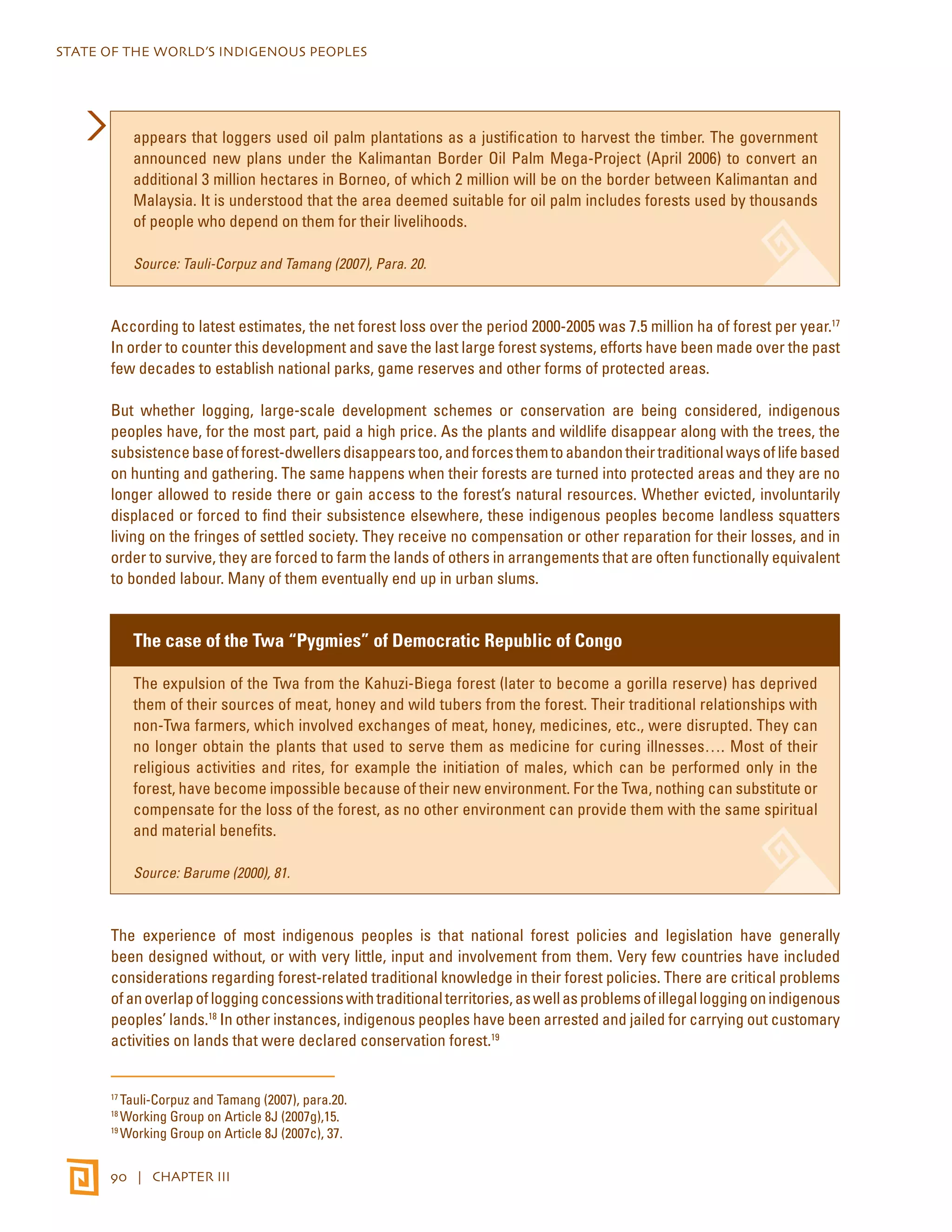
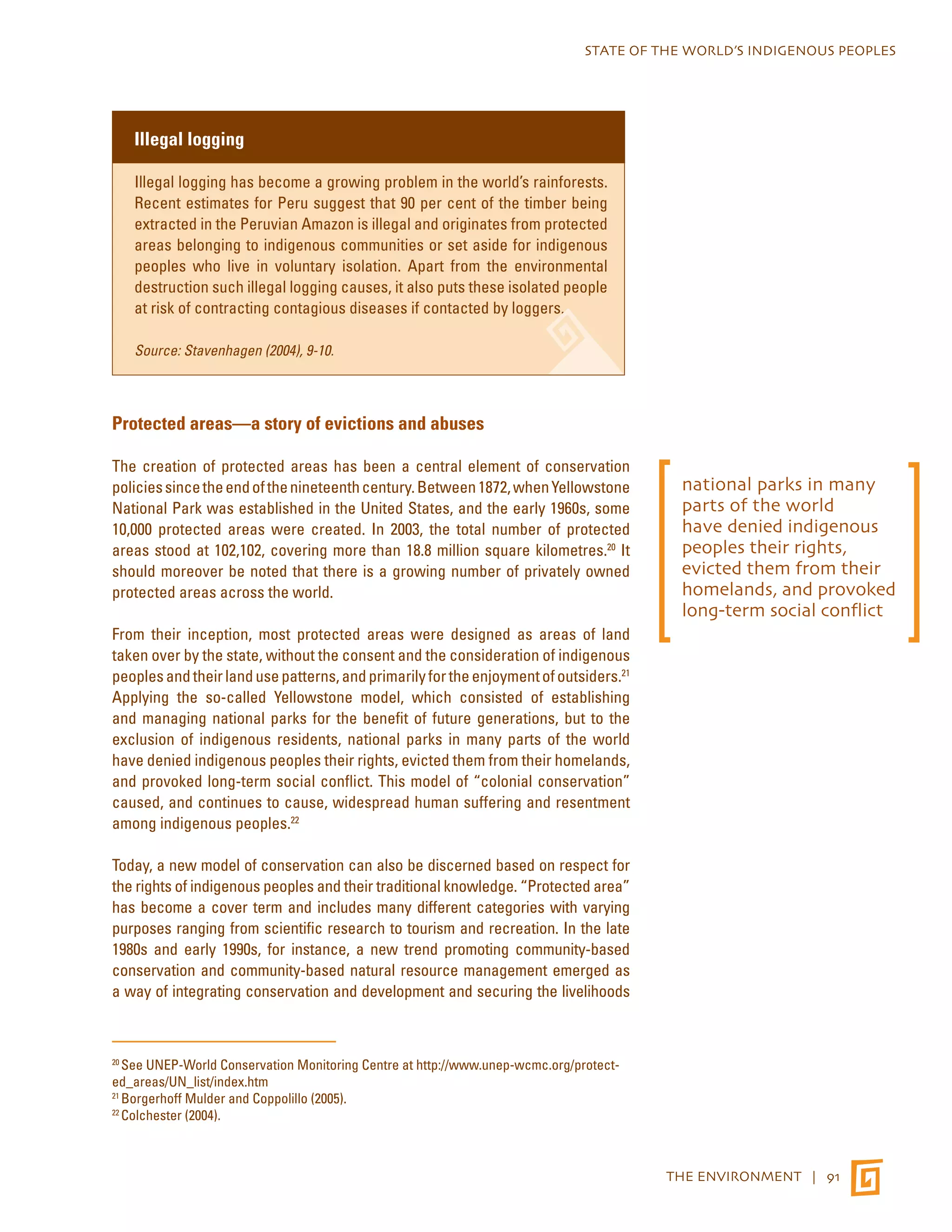
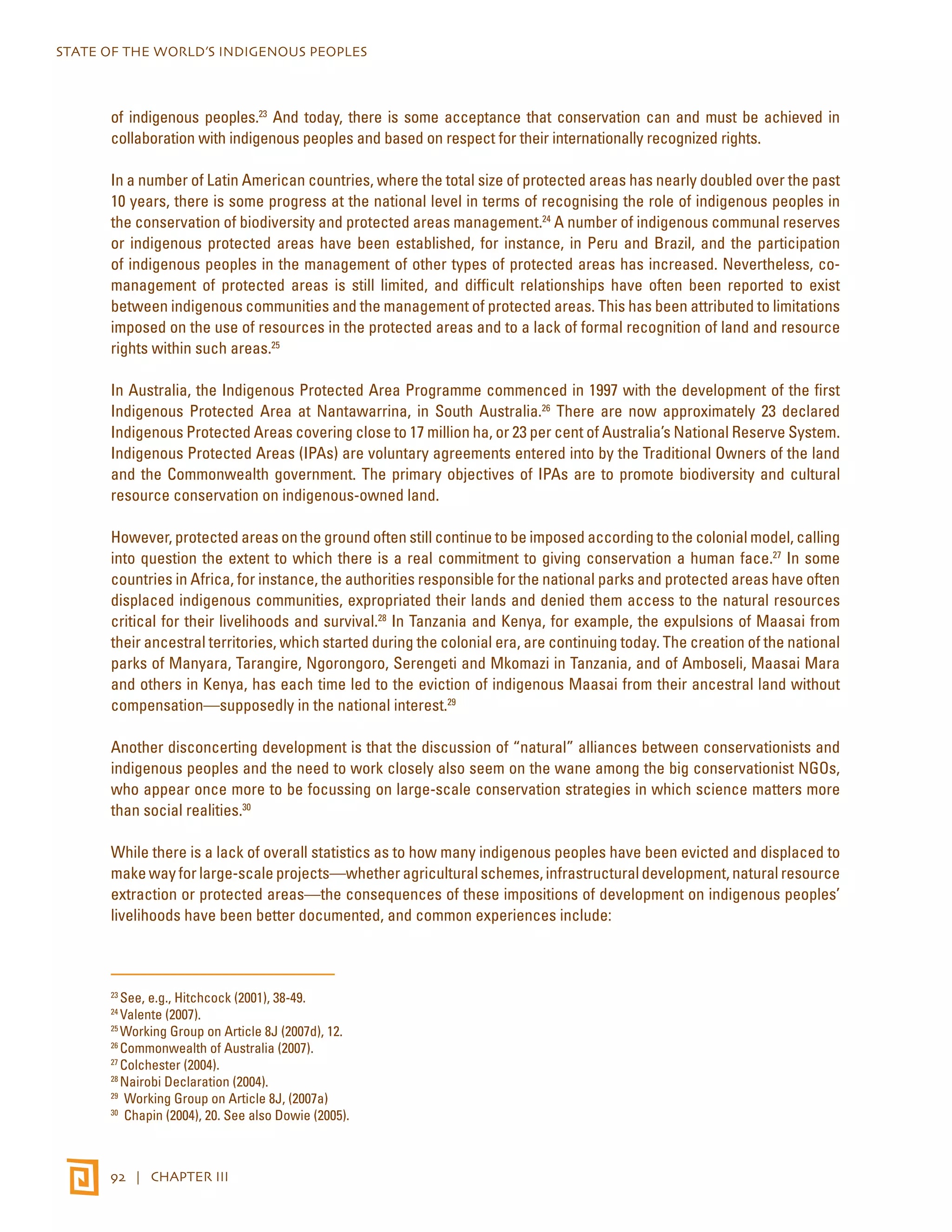
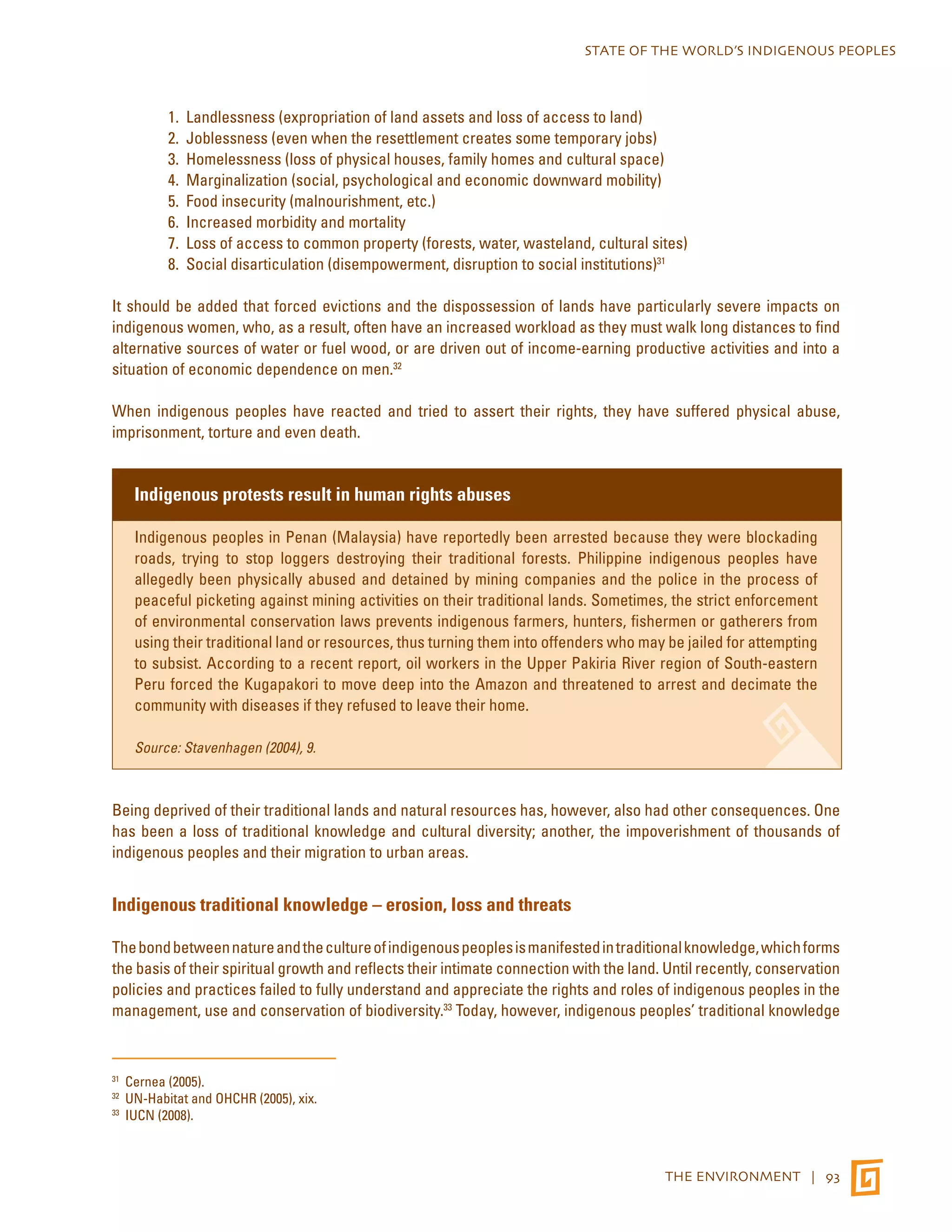
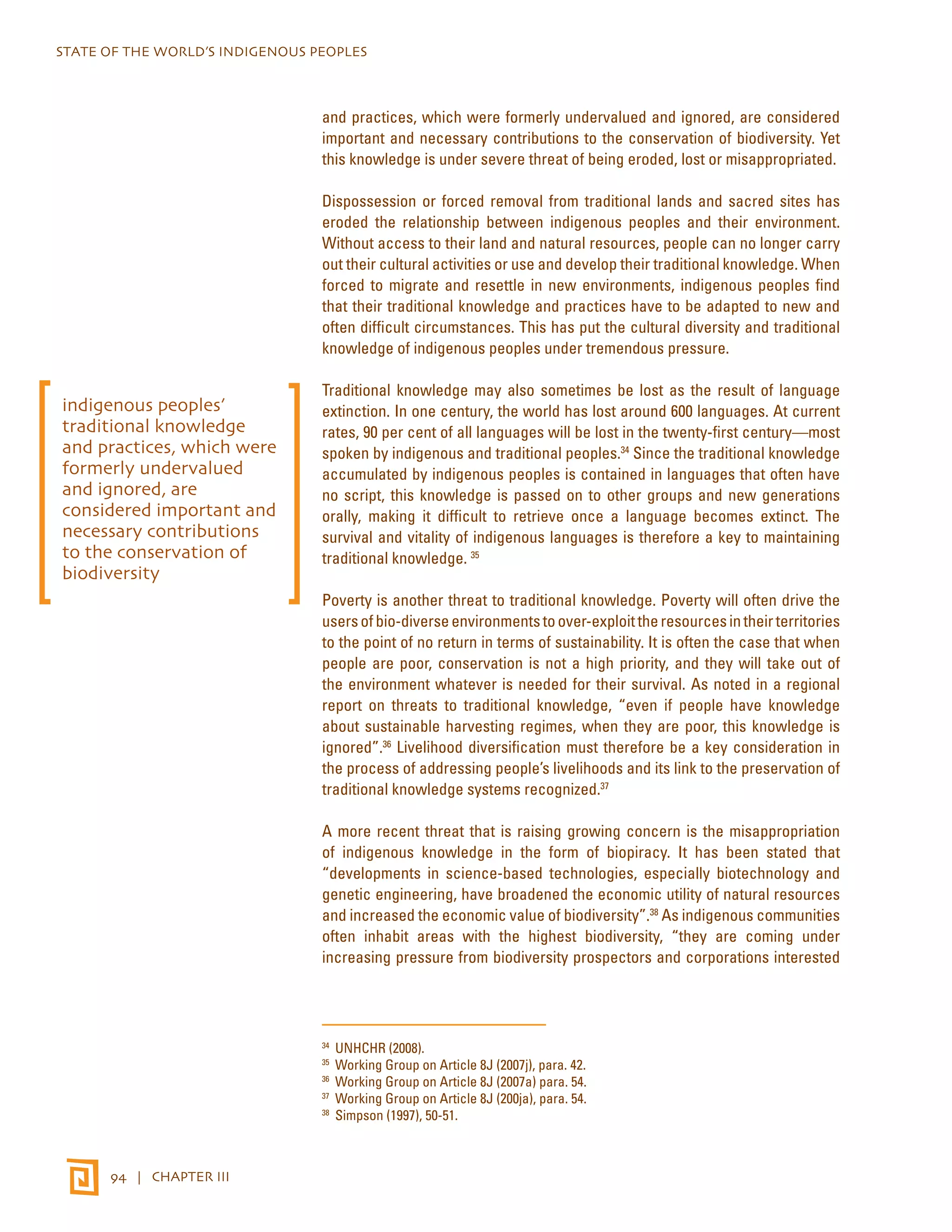
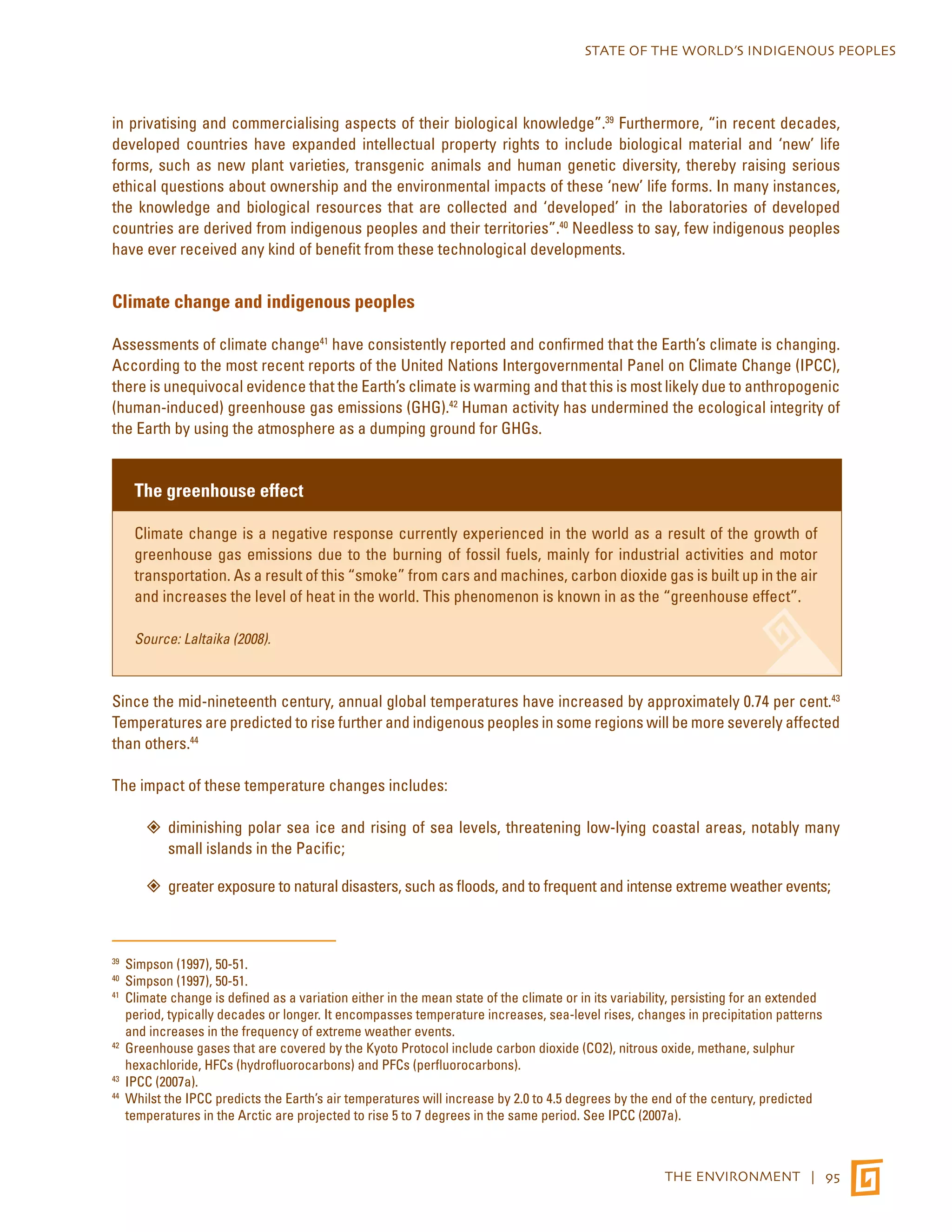
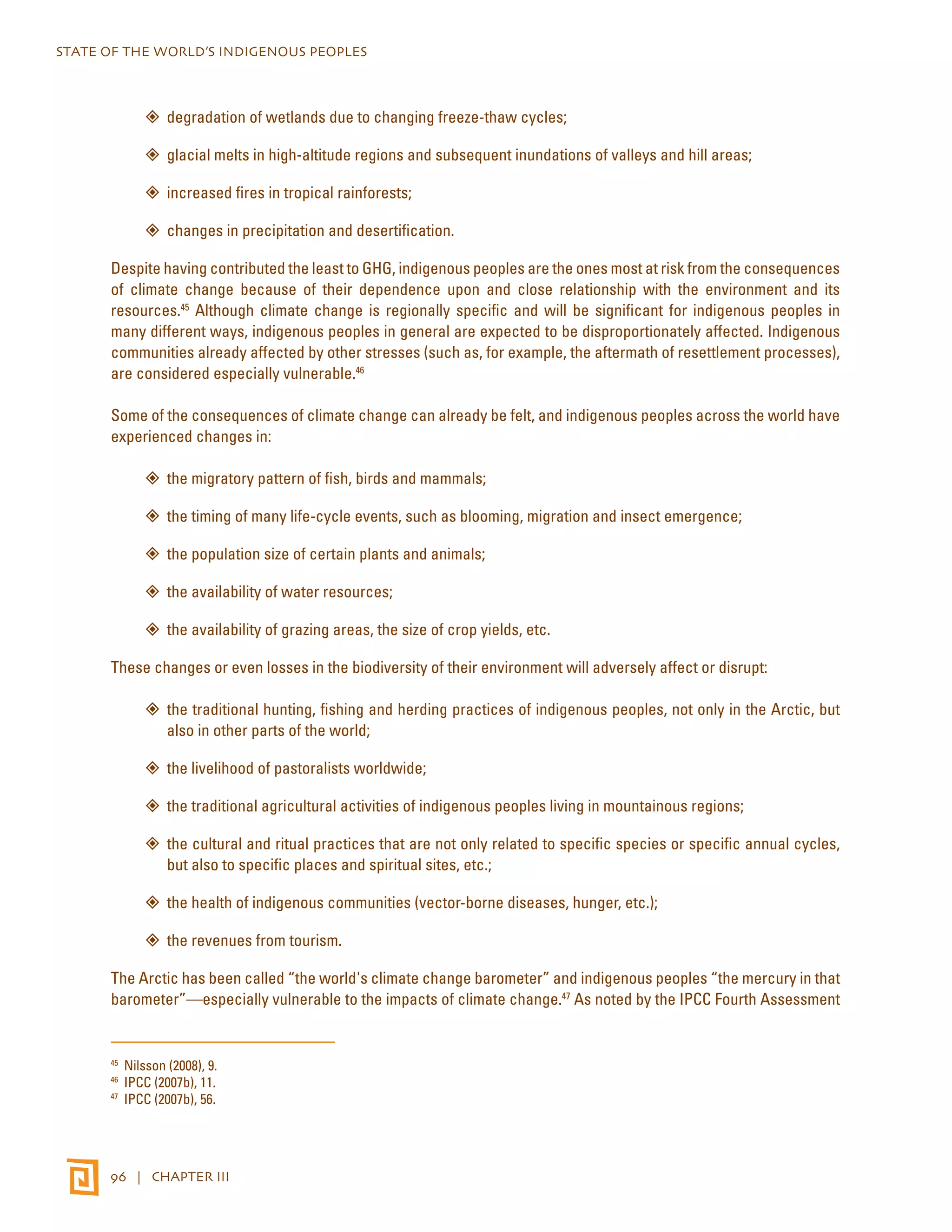

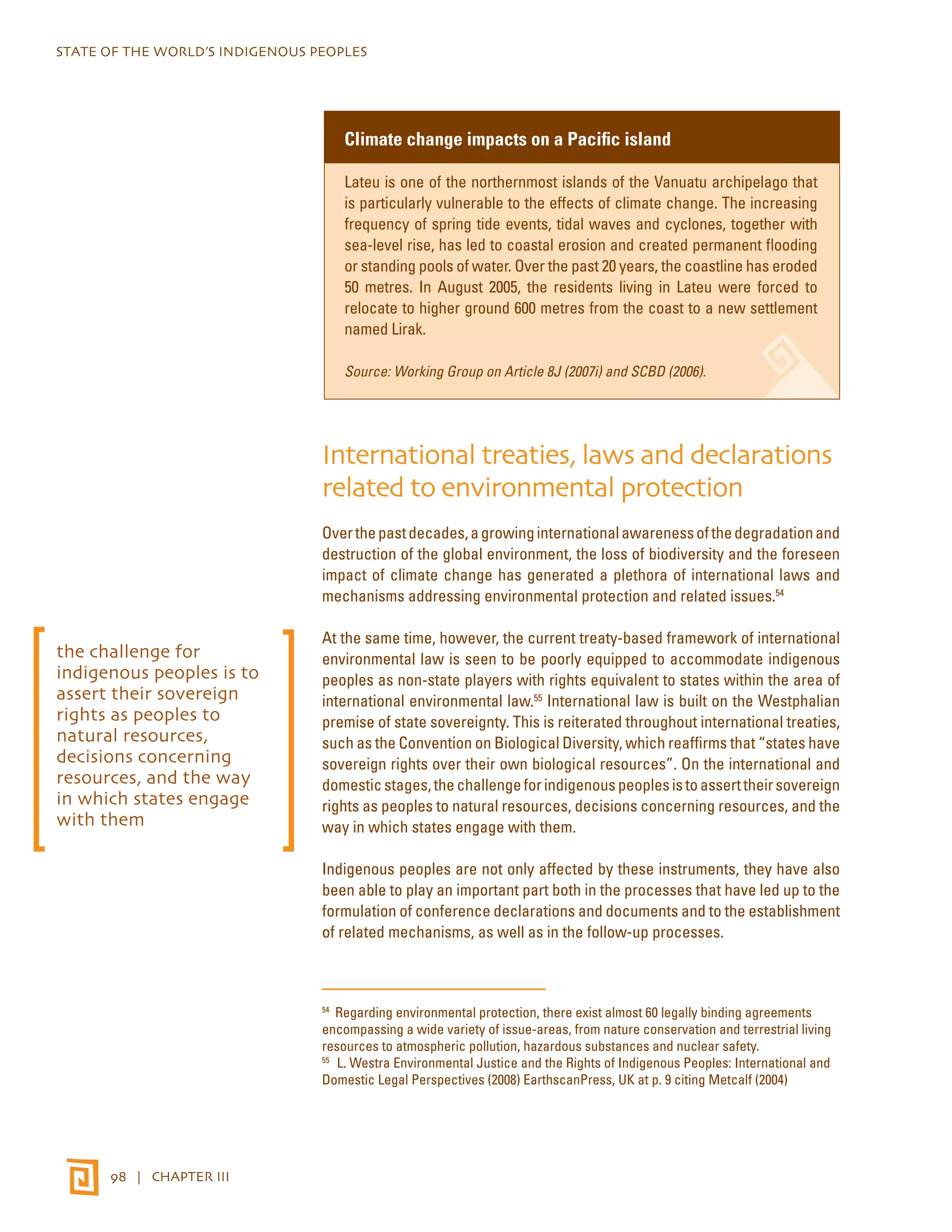
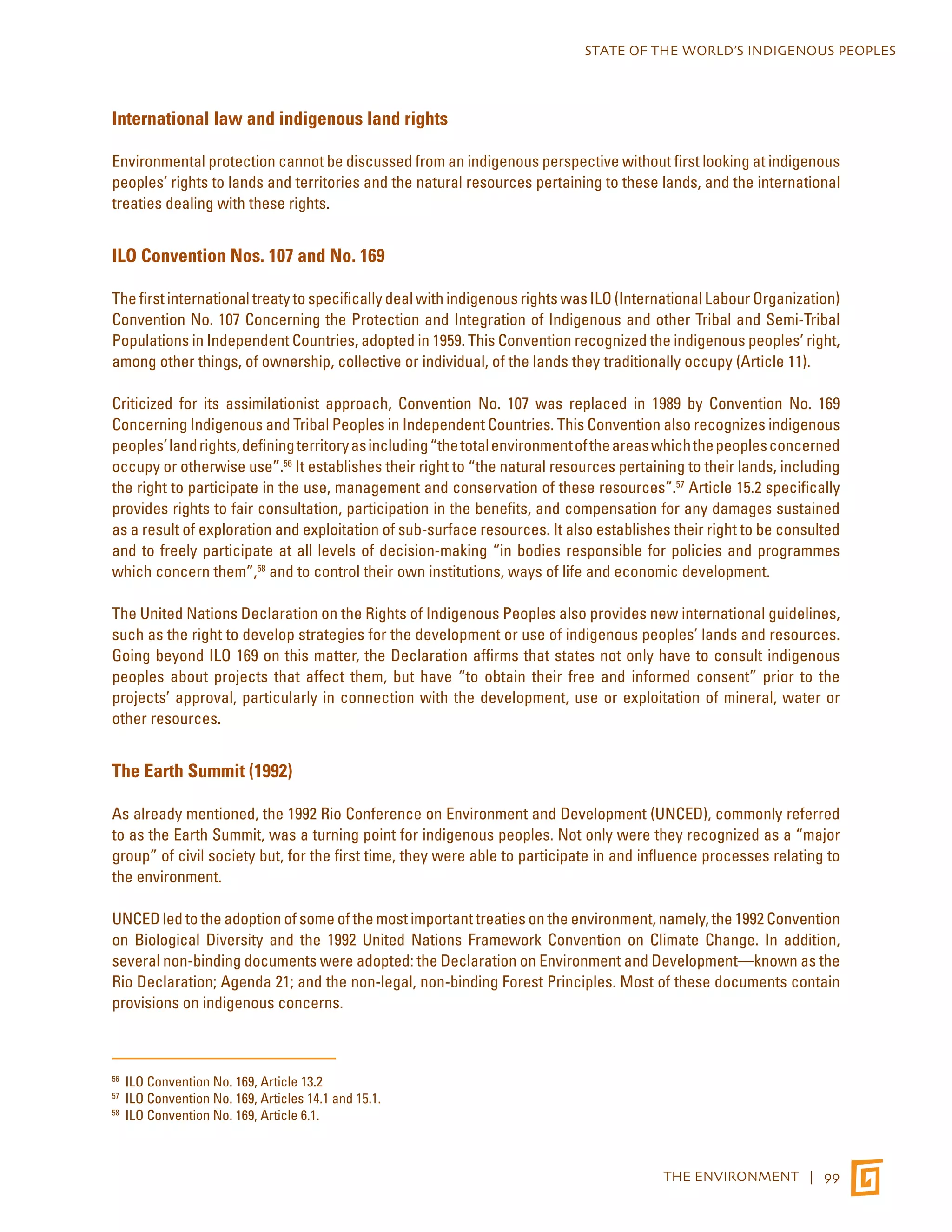
![STATE OF THE WORLD’S INDIGENOUS PEOPLES
The Rio Declaration, Agenda 21 and the Convention on Biological Diversity all recognize the unique relationship
indigenous peoples59 have with their traditional lands and establish international legal standards that go toward
protecting indigenous peoples’ rights to their traditional knowledge and practices in the area of environmental
management and conservation.
Agenda 21 and indigenous peoples’ role in sustainable development
Agenda 21 is perhaps the most ambitious document to have come out of the UNCED process. A 300-page
plan for achieving sustainable development in the twenty-first century, it is divided into four sections,
40 chapters and more than 100 programmes, and it covers all areas of the world in which environment
and development intersect and major social groups are affected. The third section, “Strengthening the
Role of Major Groups”, gives extensive and formal recognition to indigenous peoples and recommends
the incorporation of indigenous peoples’ rights and responsibilities into national legislation. Agenda 21
recognizes that, with respect to indigenous peoples, “[t]heir ability to participate fully in sustainable
development practices on their lands has tended to be limited as a result of factors of an economic, social
and historical nature. In view of the interrelationship between the natural environment and its sustainable
development and the cultural, social, economic and physical well-being of indigenous people, national and
international efforts to implement environmentally sound and sustainable development should recognize,
accommodate, promote and strengthen the role of indigenous people and their communities”.
Source: Agenda 21 (1992), chapter 26.1.
The Convention on Biological Diversity
The objectives of the UN Convention on Biological Diversity (CBD) “are the conservation of biological diversity,
the sustainable use of its components and the fair and equitable sharing of the benefits arising out of the utilization
of genetic resources….”60 In its preamble, the Convention recognizes “the close and traditional dependence of
indigenous and local communities” on biological diversity, and, in Article 8 on In-situ Conservation, which mainly
deals with the establishment of protected areas,61 paragraph (j) recommends that a Party shall,
subject to its national legislation, respect, preserve and maintain knowledge, innovations and
practices of indigenous and local communities embodying traditional lifestyles relevant for the
conservation and sustainable use of biological diversity and promote their wider application with
the approval and involvement of the holders of such knowledge, innovations and practices and
encourage the equitable sharing of the benefits arising from the utilization of such knowledge,
innovations and practices.62
Other relevant articles are Article 10(c) on customary sustainable use and Article 15 on access and sharing of the
benefits arising out of the utilization of genetic resources.
59 It should be noted that these documents do not refer to “indigenous peoples” but to “indigenous people and their communities”
or “indigenous and local communities”.
60 Convention on Biological Diversity (1992), Article 1.
61 CBD, Article 8 reads: “Each contracting party shall... (a) establish a system of protected areas or areas where special measures
need to be taken to conserve biological diversity”.
62 CBD, Article 8(j).
100 | CHAPTER III](https://image.slidesharecdn.com/sowipweb-141112214427-conversion-gate02/75/Sowip-web-111-2048.jpg)
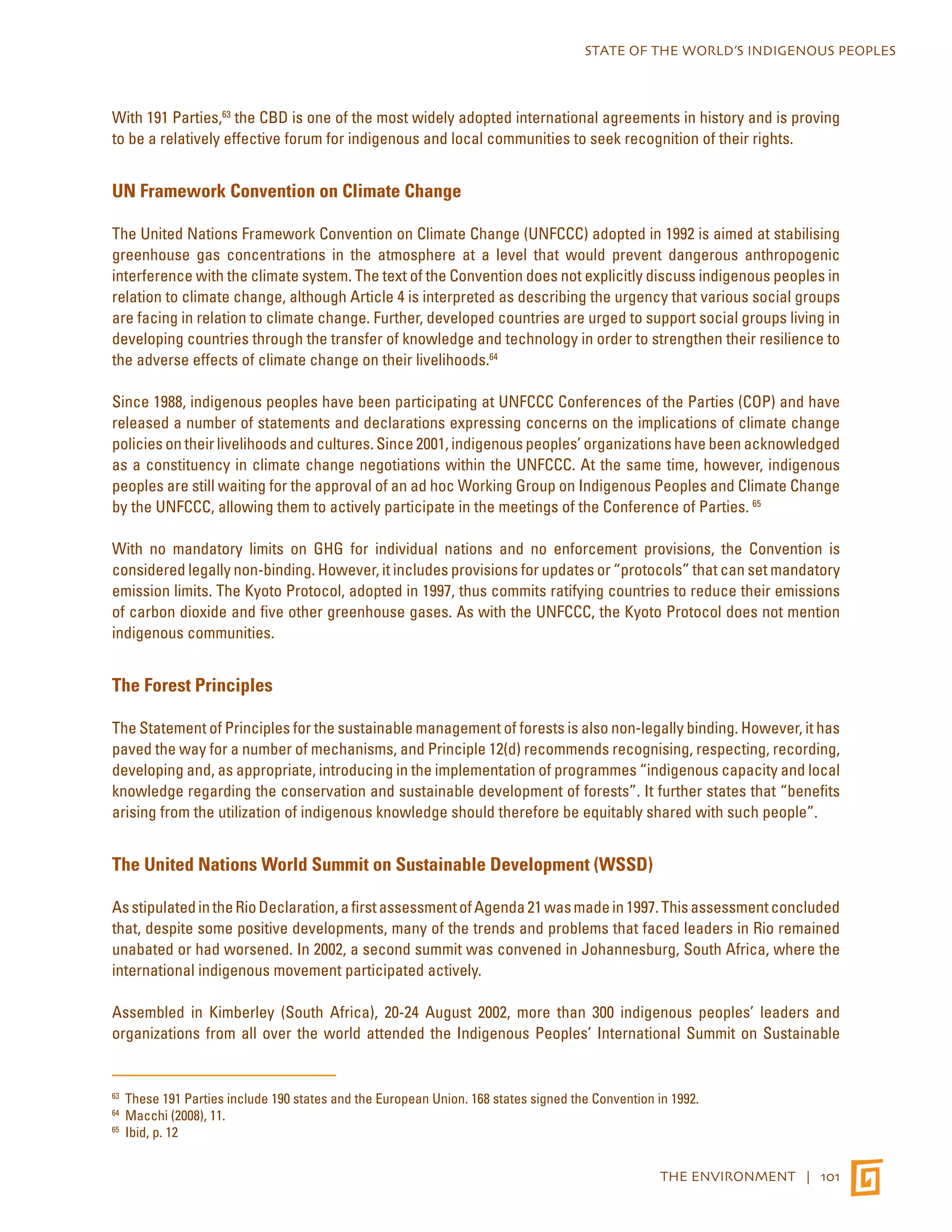
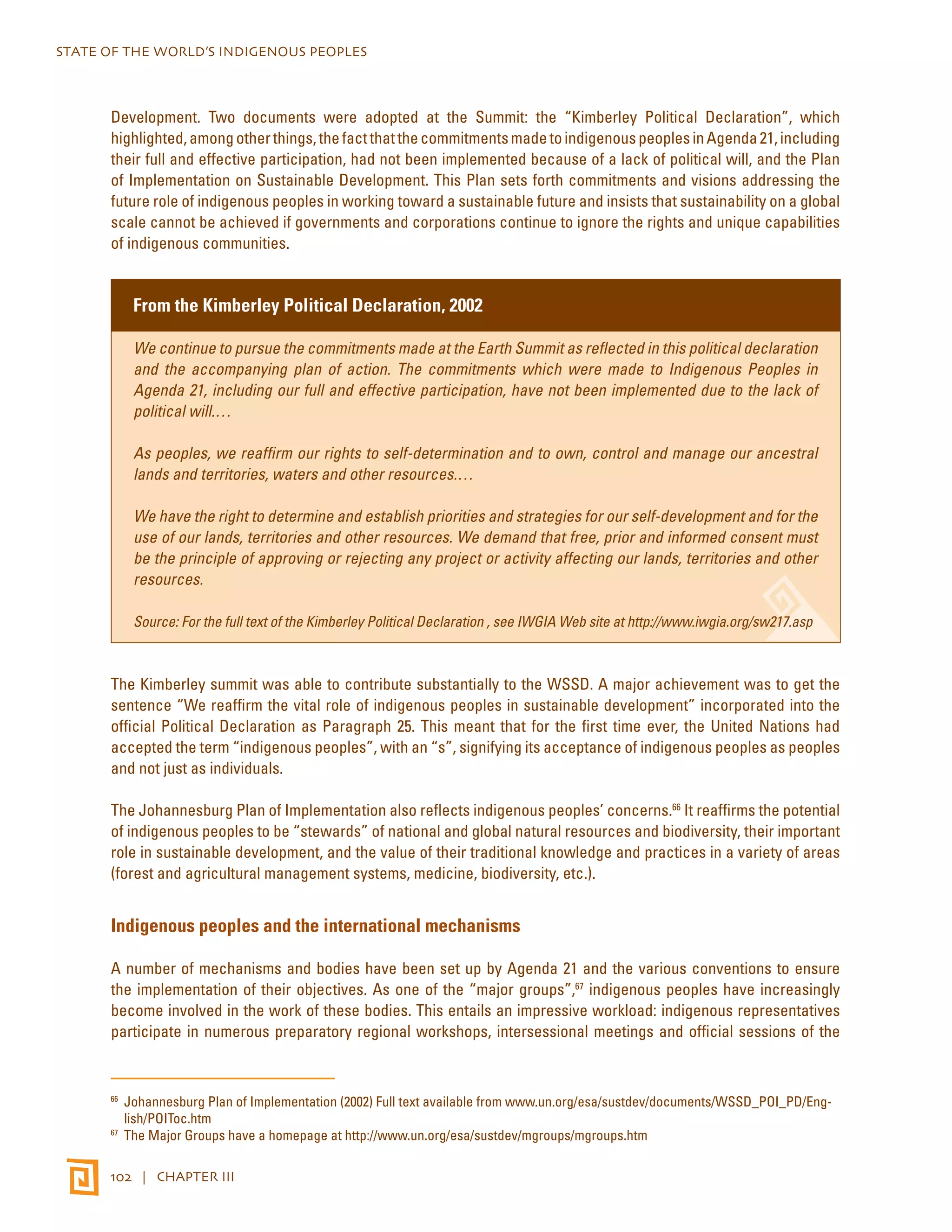
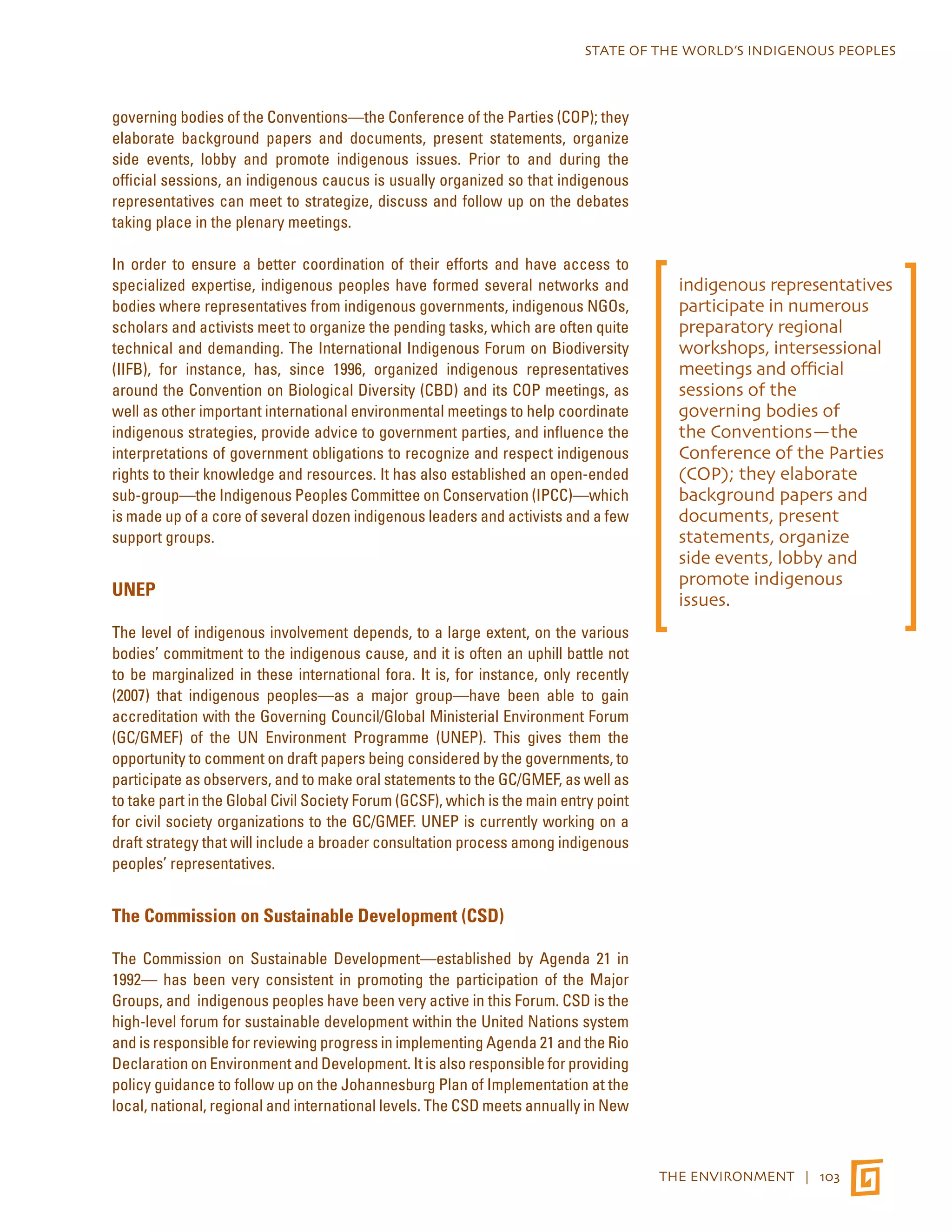
![STATE OF THE WORLD’S INDIGENOUS PEOPLES
104 | CHAPTER III
York in two-year cycles, with each cycle focusing on clusters of specific thematic
and cross-sectoral issues. Through, among other things, its multi-stakeholder
dialogue sessions, the CSD provides direct interaction between governments
and civil society and thus gives indigenous peoples the possibility of directly
voicing their concerns and suggestions.
The Convention on Biological Diversity - COPs and Working Groups
For indigenous peoples, the Conference of the Parties (COP) of the CBD is
particularly important because it has established seven thematic programmes of
work that correspond to some of the major biomes, or ecological communities,
on the planet. Each programme establishes a vision for and basic principles to
guide future work. The COP has also initiated work on cross-cutting issues and
set up a number of bodies and working groups to work toward achieving the
commitments made in the Convention in, among other things, Article 8(j) (Ad
Hoc Open-Ended Working Group on Article 8[j] and related provisions - WG8J),
Article 25 (Subsidiary Body on Scientific, Technical and Technological Advice -
WGSBSTA), Articles 15 and 8(j) (Ad Hoc Open-ended Working Group on Access
and Benefit-sharing - WGABS), and on protected areas (Ad Hoc Open-Ended
Working Group on Protected Areas - WGPA).
The CBD has also developed specific mechanisms such as, for example,
financial support through the recently established Voluntary Fund to facilitate
the full and effective participation of indigenous peoples in meetings under the
Convention, including the meetings of its governing body—the Conference of
the Parties (COP). This has allowed indigenous peoples to be very active and to
be represented in, among other groups, the Advisory Group/Steering Committee,
where it assists with the completion of the composite report on the status and
trends regarding traditional knowledge relevant to biological diversity. However,
it is within the Working Groups that the role of indigenous peoples has been
particularly crucial for the promotion of indigenous views and interests.
This is particularly the case with WG8J, the Working Group under Article 8(j) and
related provisions. Its programme of work and plan of action “for the retention
of traditional knowledge, innovations and practices” were adopted in 2000 and
form the main instruments that Parties to the Convention have given themselves
to achieve the commitments in Article 8(j) to “respect, preserve and maintain
the knowledge, innovations and practices of indigenous and local communities
embodying traditional lifestyles relevant for the conservation and sustainable
use of biological diversity, to promote their wider application with the approval
and involvement of the holders of such knowledge, and encourage the equitable
sharing of the benefits arising from the utilization of such knowledge”.68
One of the main achievements of WG8J has been the Akwe: Kon Voluntary
Guidelines, developed in cooperation with indigenous peoples. The name of the
68 See http://www.cbd.int/traditional
for indigenous peoples,
the Conference of the
Parties (COP) of the CBD
is particularly important](https://image.slidesharecdn.com/sowipweb-141112214427-conversion-gate02/75/Sowip-web-115-2048.jpg)

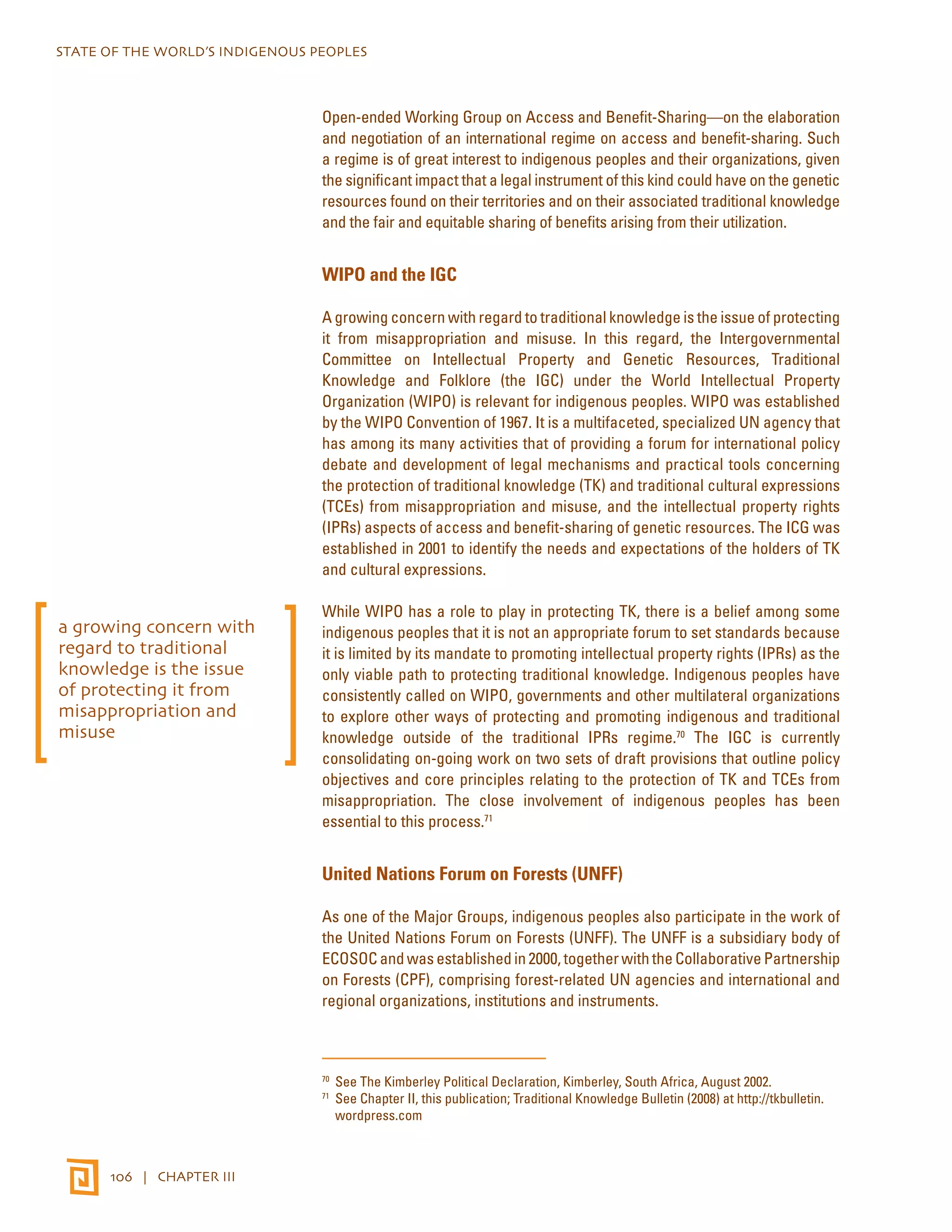
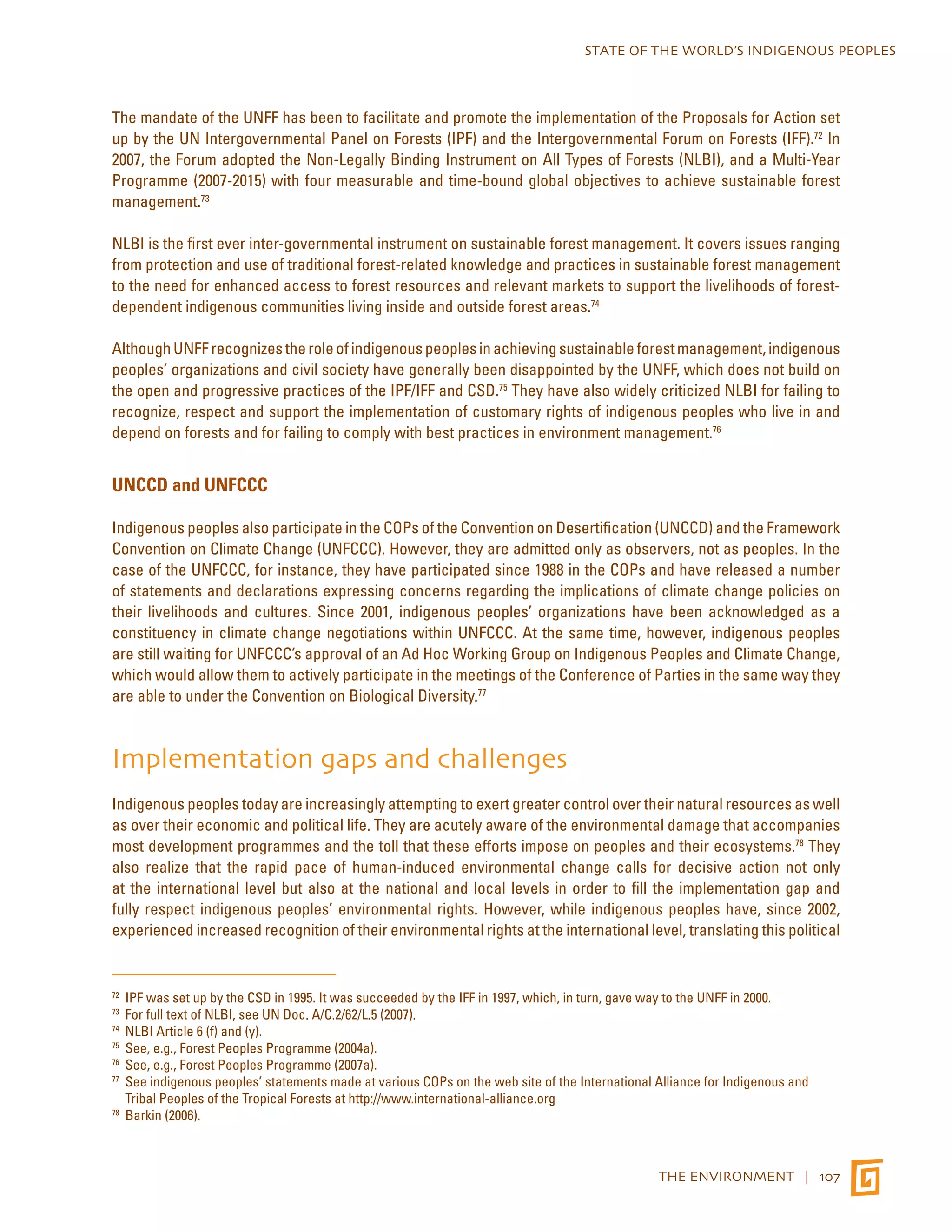
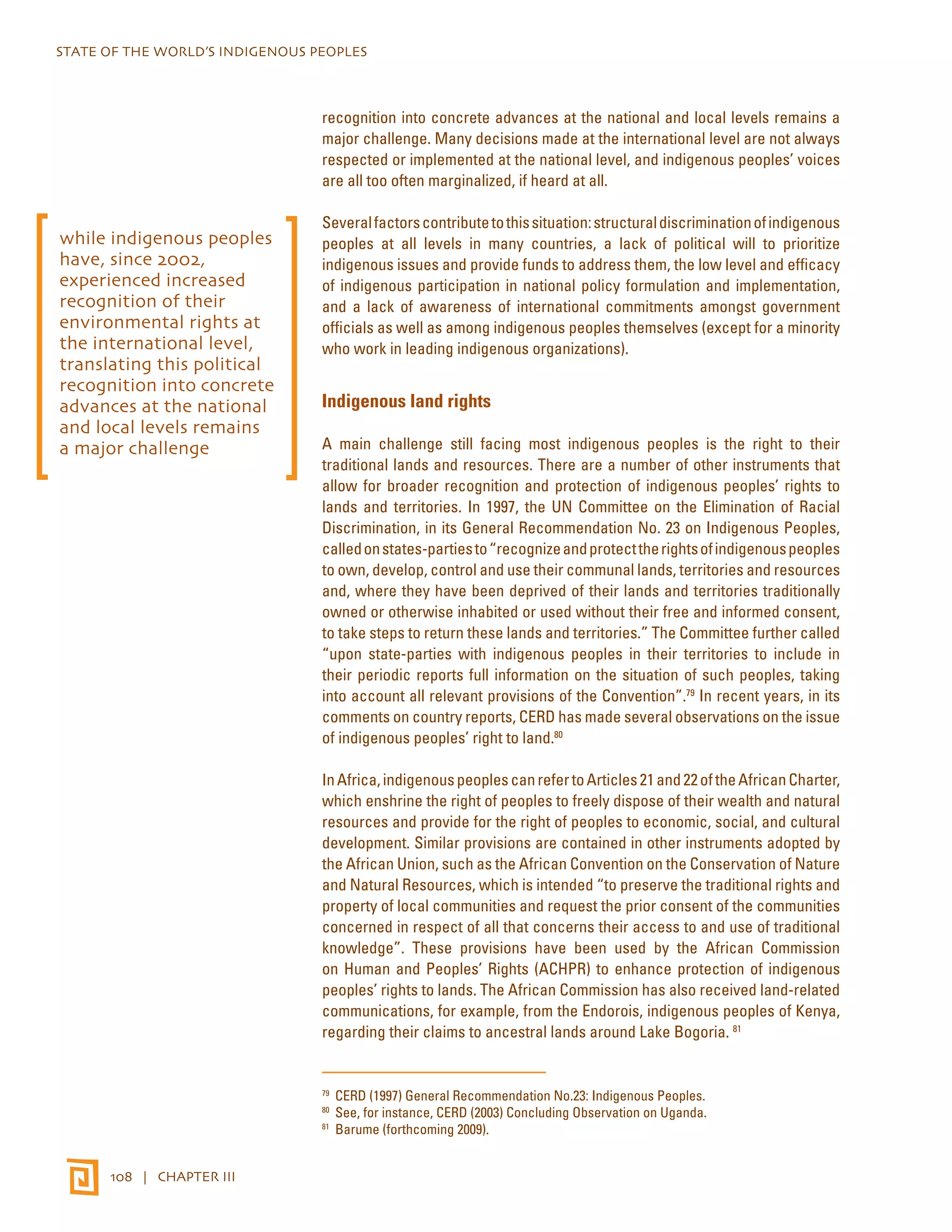
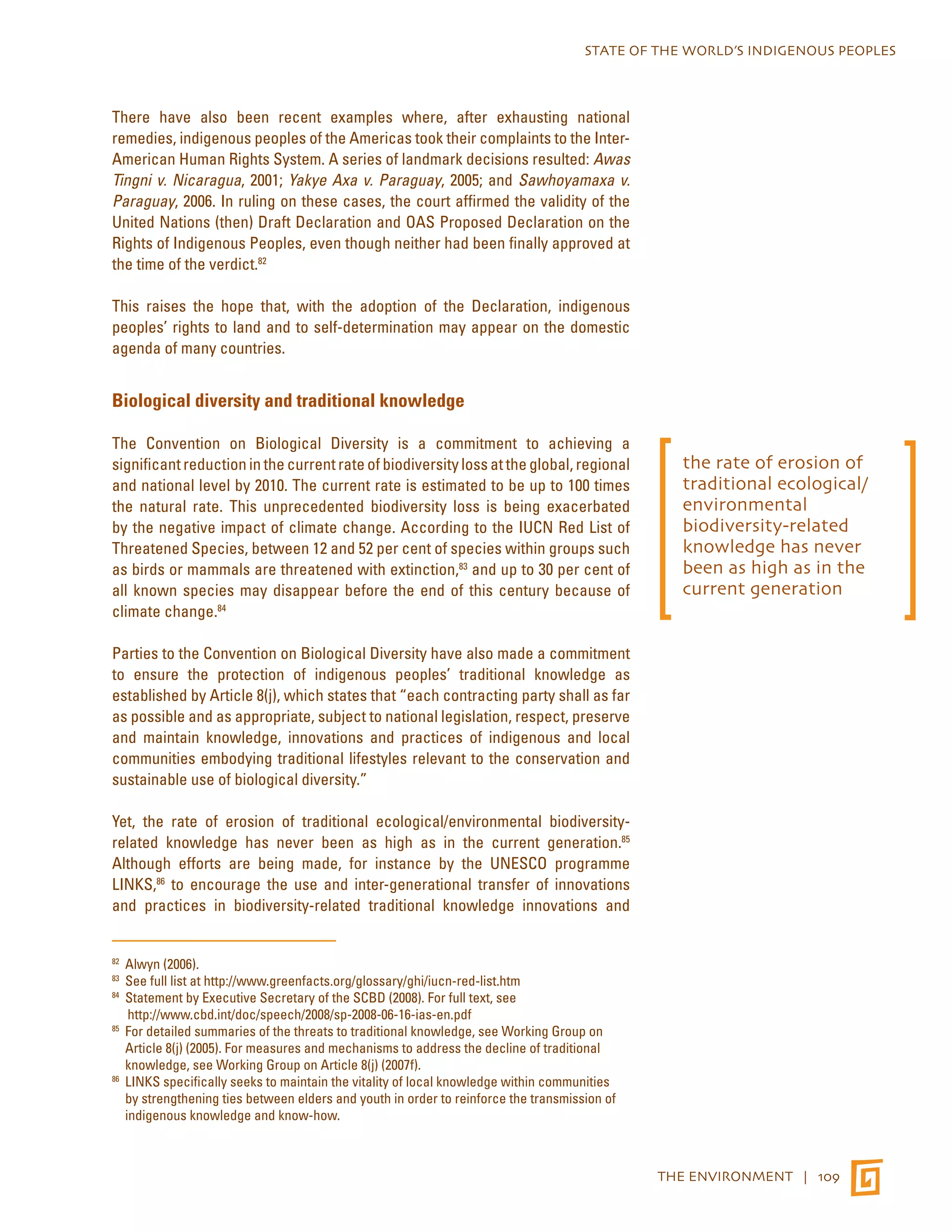
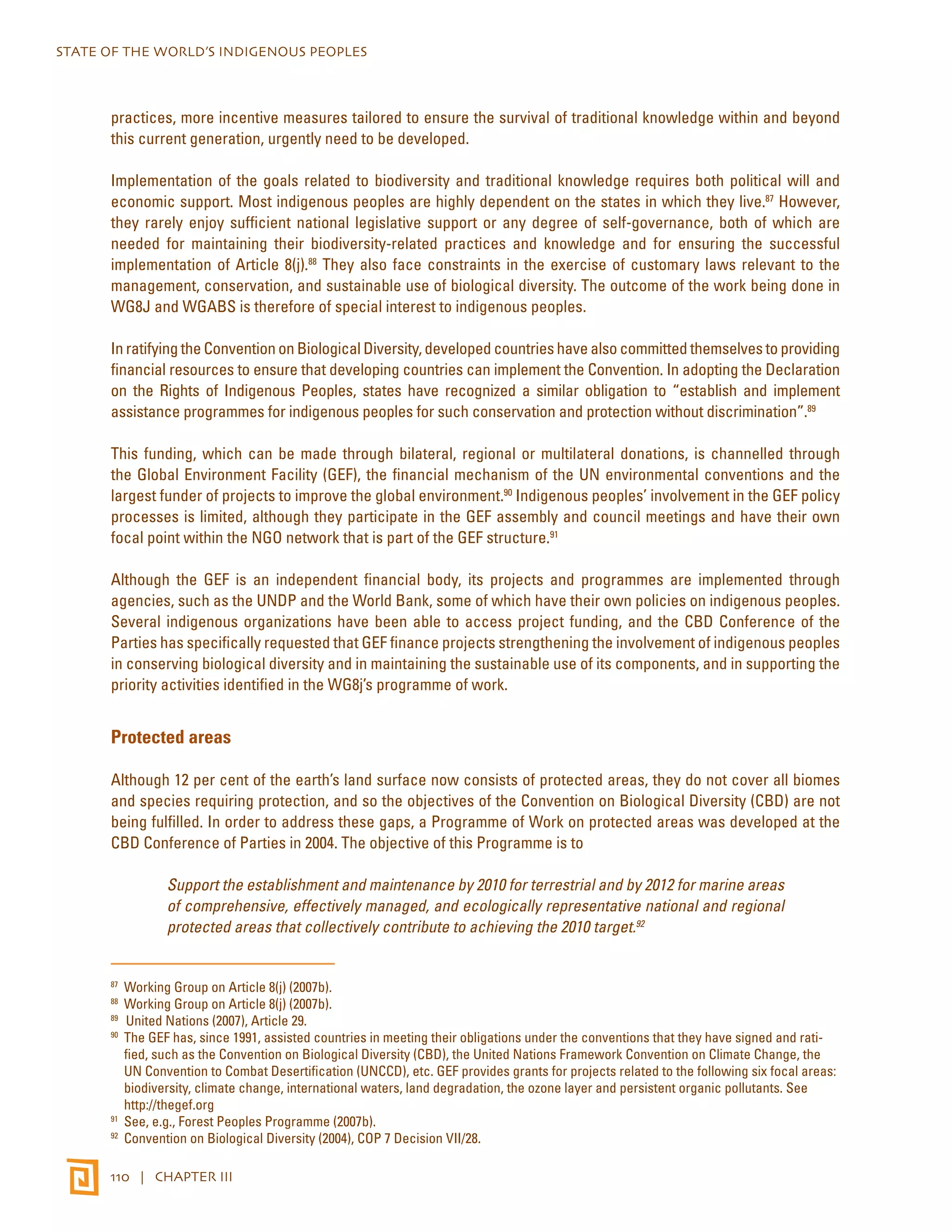
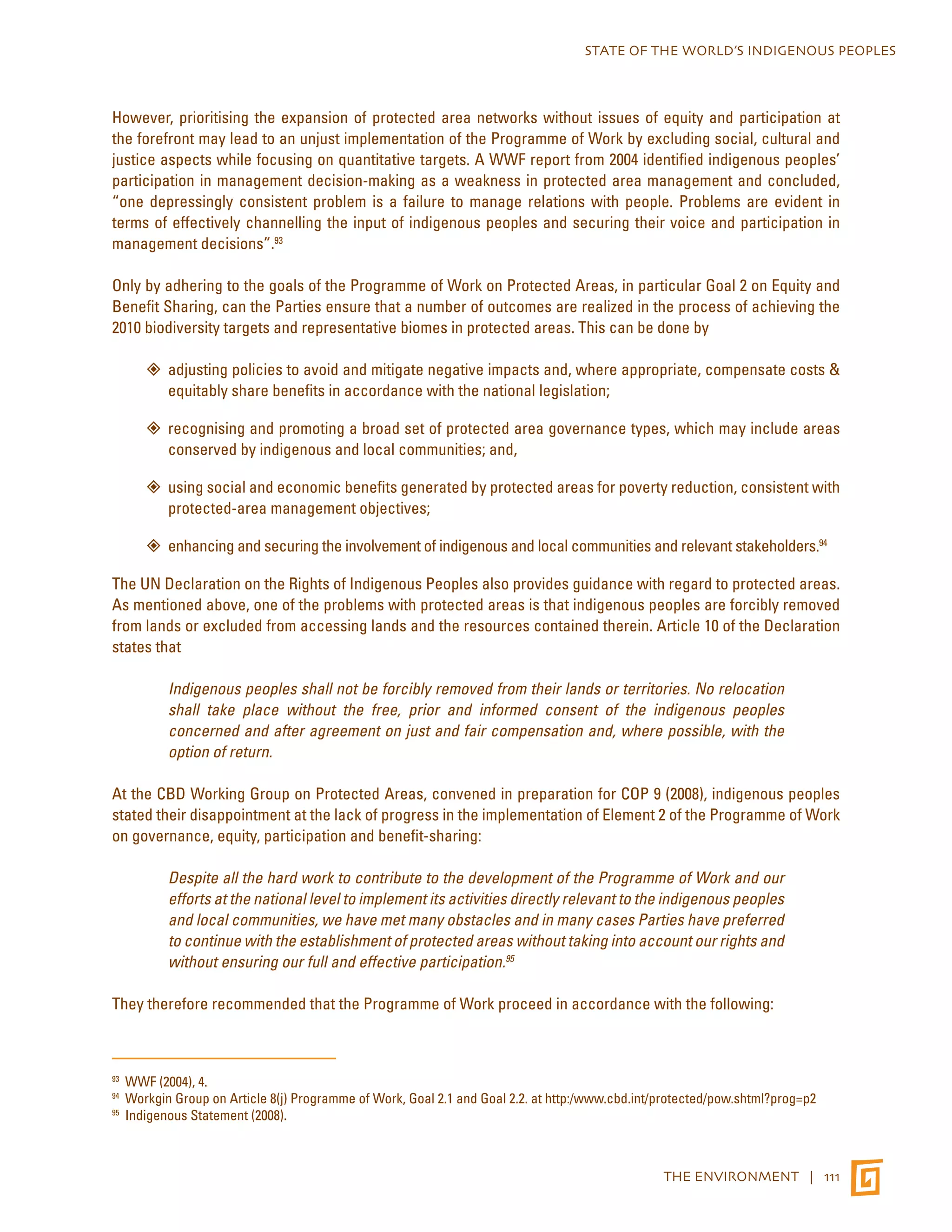
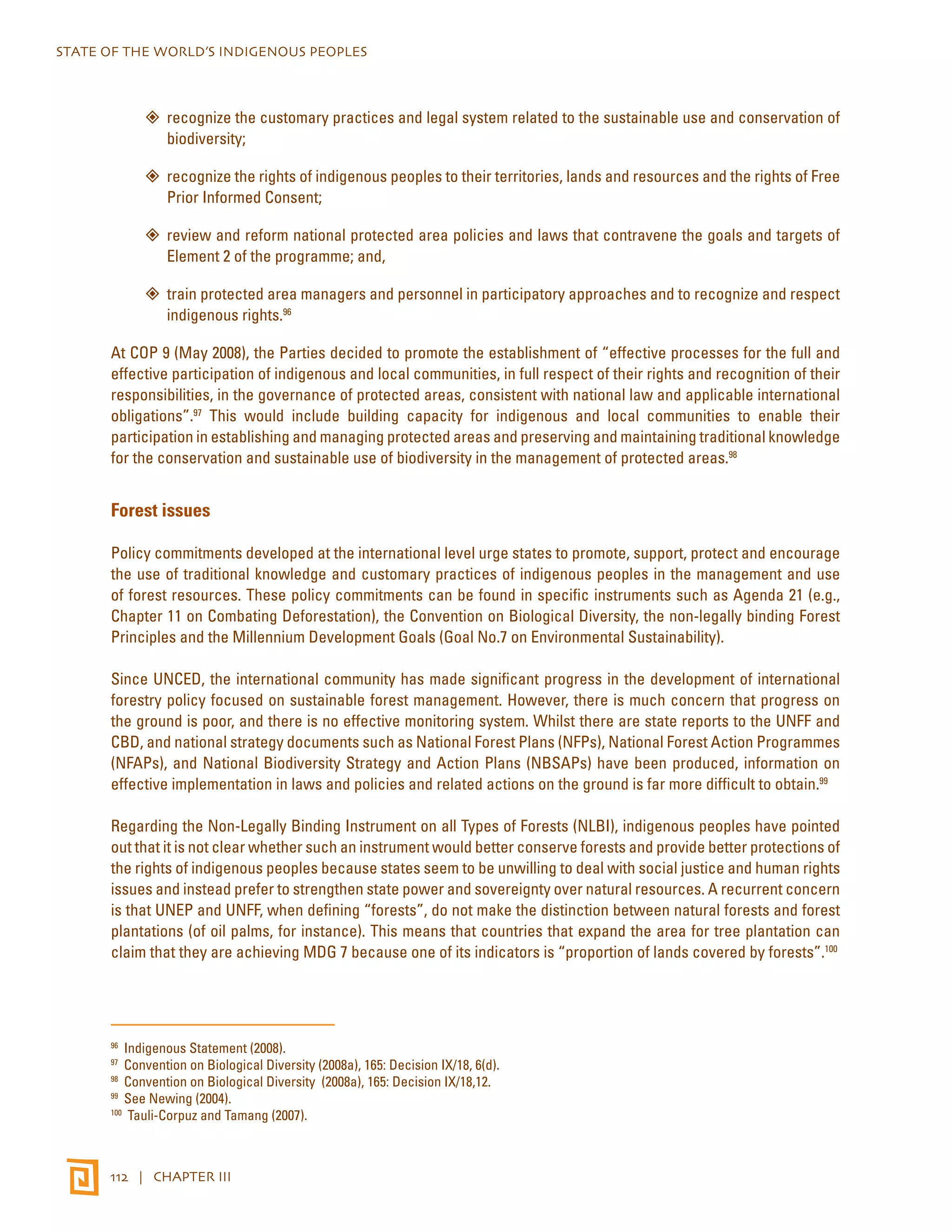
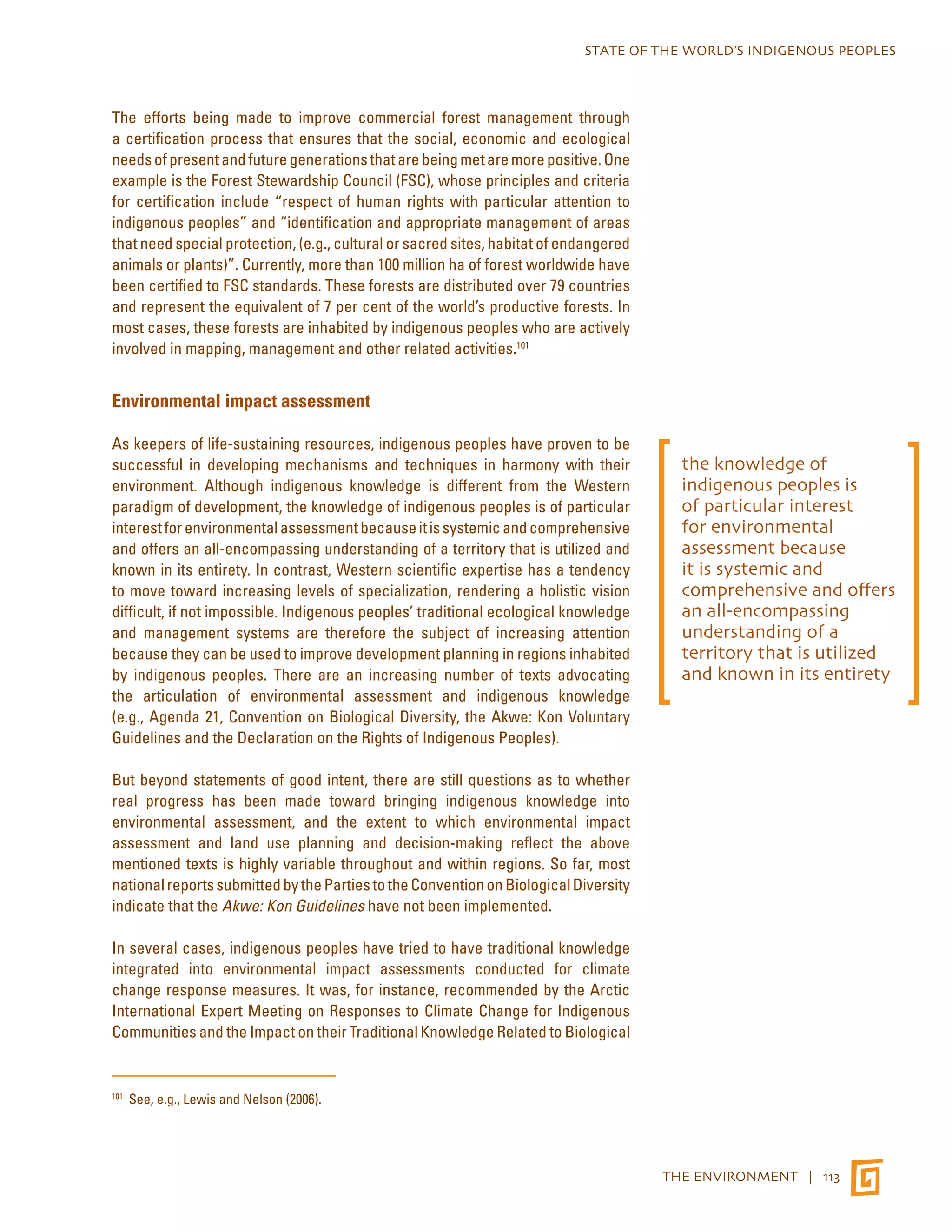
![STATE OF THE WORLD’S INDIGENOUS PEOPLES
114 | CHAPTER III
Diversity, which also noted the relevance of the Akwe: Kon Guidelines. It also
recommended that processes be developed to link local-level adaptation to
national planning.102
In many parts of the world, the “environment” is still not a priority when dealing
with difficult development decisions, and cultural factors are almost always absent
from decision-making processes. In the case of extractive industries in Latin
America, for instance, there is insufficient evaluation of their impacts on traditional
knowledge and practices, even if it is argued that such impacts, especially indirect
impacts, are of considerable magnitude. 103
In 2005, indigenous peoples living in the Russian Federation protested against
the oil industry, demanding the implementation of an “ethnological impact
assessment” in addition to the environmental impact assessment. In 2007, the
Committee of Nationalities Affairs of the Russian State Duma drafted a federal
law “[o]n the protection of the environment, traditional way of life, and traditional
natural resource use of the small numbered indigenous peoples in the Russian
Federation”. Such a law would have made ethnological impact assessments a
reality and secured traditional lands and natural resource management for the
indigenous peoples’ communal enterprises. The Department of Nationalities
Affairs has, however, reacted negatively to the draft law and the general feeling
is therefore that it will not be passed by Duma, even though several regional
administrations have stressed the need for such a law.104
Climate Change – adaptation and mitigation
For many indigenous peoples, climate change is already a reality, and they are
increasingly realising that climate change is clearly not just an environmental
issue, but one with severe socioeconomic implications. The World Bank, among
other things, also sees climate change as having the potential to hamper
achievement of the Millennium Development Goals, including those on poverty
eradication, child mortality, combating malaria and other diseases, as well as
environmental sustainability. For indigenous peoples, already vulnerable and
marginalized, climate change therefore represents a major challenge to which
the only answer so far seems to be adaptation and mitigation.
Adaptation
Indigenous peoples have survived many kinds of environmental changes and are
therefore often seen as having a special capacity to adapt. As Nuttall observes,
however, “adaptive capacity and resilience depend on the strength of culture, of
human-environment relations, cohesiveness of community, identity, and of strong
social relationships… Adaptation may well begin at the local level in individual,
household and community decisions, but it also requires strong policy measures
102 Convention on Biological Diversity (2008b).
103 Working Group on Article 8(j) (2007g).
104 IWGIA (2008), 40.
for many indigenous
peoples, climate change
is already a reality, and
they are increasingly
realising that climate
change is clearly not
just an environmental
issue, but one with
severe socioeconomic
implications](https://image.slidesharecdn.com/sowipweb-141112214427-conversion-gate02/75/Sowip-web-125-2048.jpg)
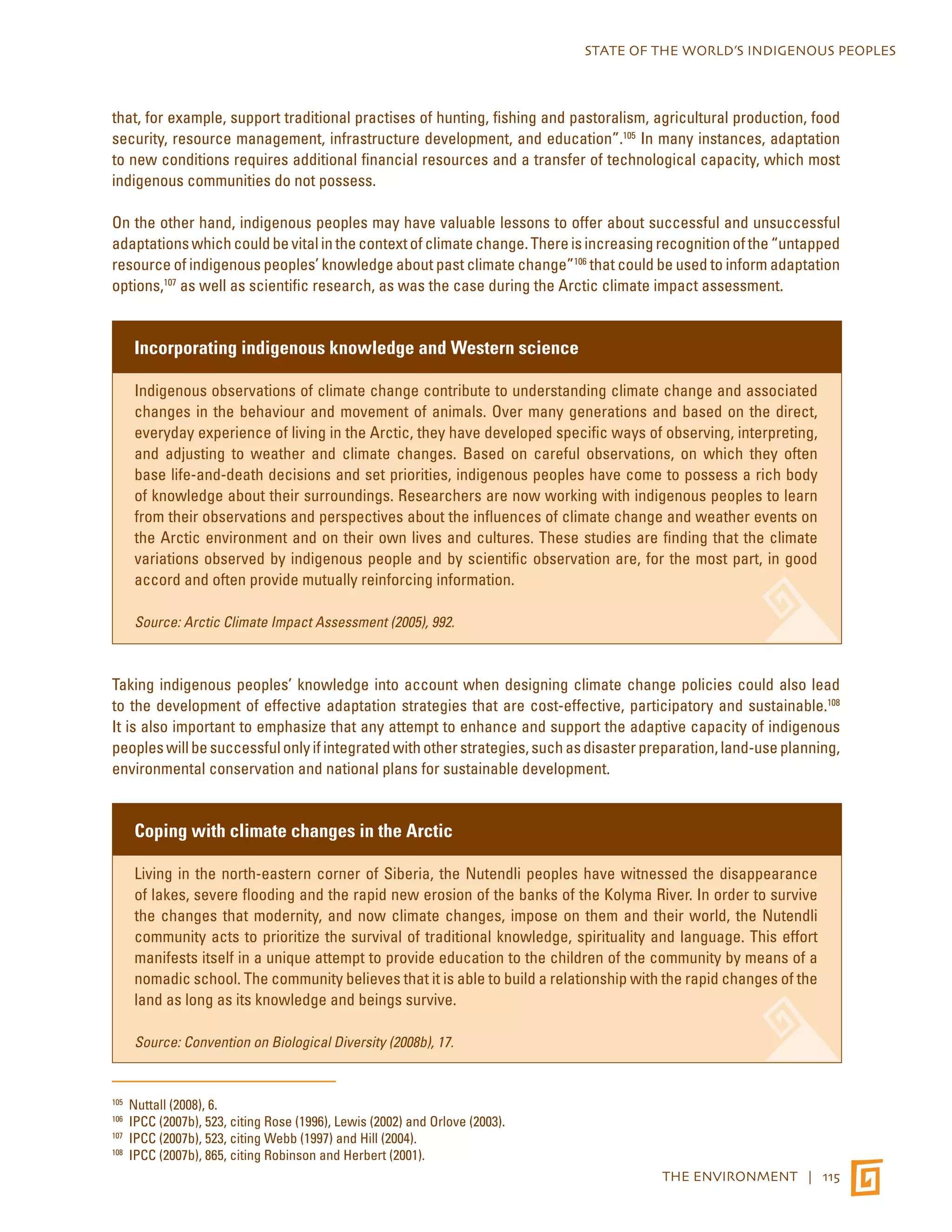
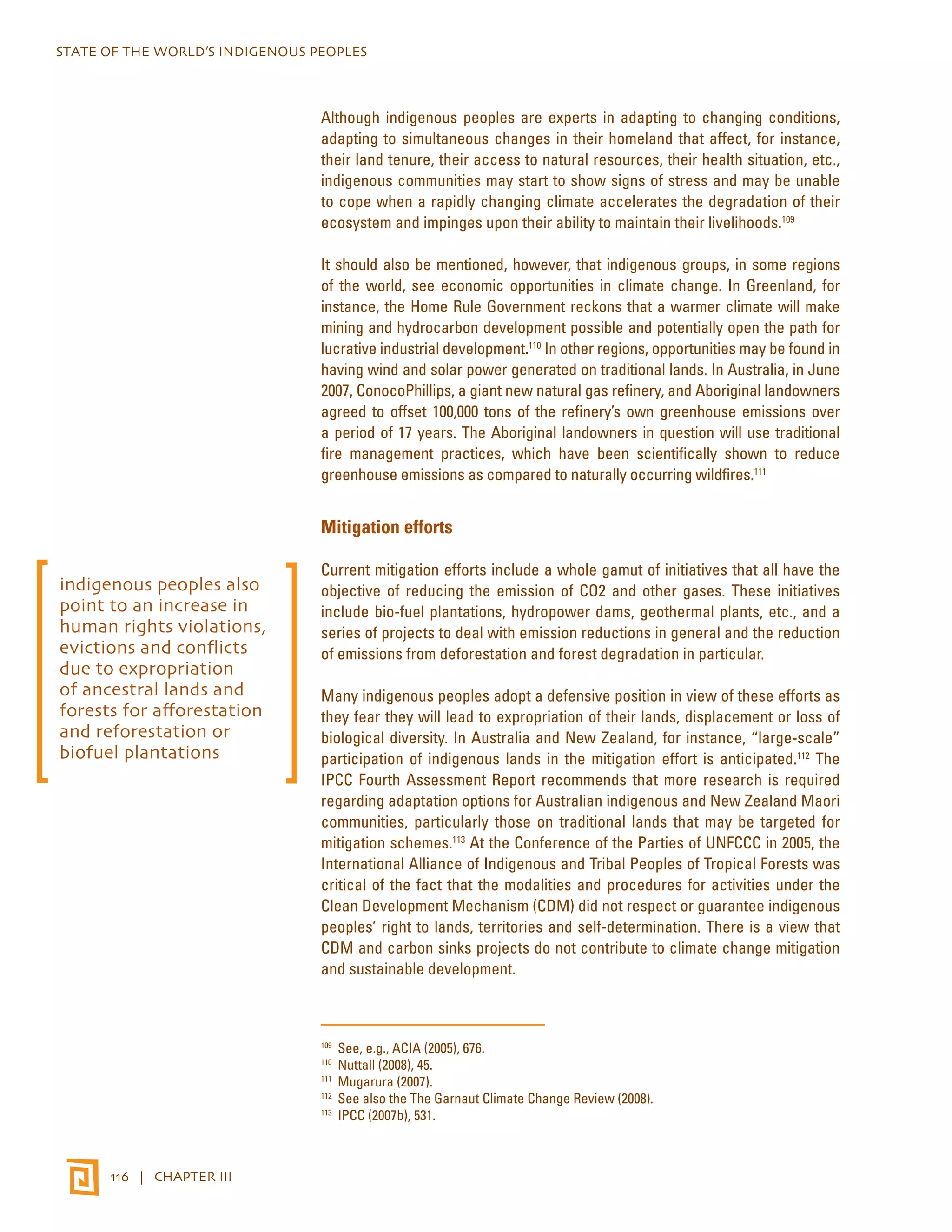

![STATE OF THE WORLD’S INDIGENOUS PEOPLES
Regarding the Global Forest Partnership (GFP), concerns included, among others things, that
”” the GFP does not recognize indigenous peoples as rights holders;
”” it risks undermining or impoverishing indigenous forest-based livelihoods and traditional practices in
forests by supporting conventional protected area systems;
”” it would enable activities that could lead to the expropriation of indigenous peoples’ forest lands;
”” it would deliver only minimal or token benefits to indigenous peoples and forest communities;
”” it would marginalize indigenous peoples through top-down implementation processes, as well as by its
centralized planning and design structure;
”” a lack of transparency and accountability in its governance arrangements does not provide indigenous
peoples and affected communities with avenues for effective involvement or representation.121
Indigenous peoples were also critical of the fact that they had been excluded from the FCPF/GFP process in spite
of the fact they are the main stakeholders in tropical and subtropical regions. In response, the World Bank held
consultations with indigenous peoples in Asia, Latin America and Africa in early 2008.
Many people, including indigenous peoples in developing countries, have questioned the logic of having a
multilateral bank that has been and continues to be involved in funding the drivers of deforestation and climate
change (fossil fuel energy extraction, mining, industrial logging, industrial plantations and infrastructure—
including dams, roads, oil and gas pipelines and coastal developments) fund mitigation and adaptation efforts.
These critics have called upon the Bank to cease the funding of fossil fuel activities and to prevent its projects
from resulting in deforestation.122
REDD
At the COP meeting, a programme on Reducing Emissions from Deforestation and Forest Degradation (REDD) was
launched by the Norwegian government, which pledged to spend NOK 3 billion annually to support developing
countries in fighting deforestation and reducing global CO2 emissions. The REDD programme, too, has met with
criticism. It makes no reference to indigenous peoples’ rights, and it is argued that it will reinforce a centralized,
top-down management of forests and undermine indigenous rights.
The concerns regarding the Forest Carbon Partnership Facility and REDD were also raised at the Seventh
Session of the UN Permanent Forum on Indigenous Issues in May 2008, where the theme was Climate Change.
Recommendations related to adaptation and mitigation initiatives were made, and it was emphasized that all
actions to be taken should be implemented with the participation or consent of indigenous peoples and in
accordance with the UN Declaration. In particular, it was recommended that
[i]ndigenous peoples should be effectively involved in the design, implementation and evaluation
of the Forest Carbon Partnership Facility. Displacement and exclusion of indigenous peoples
from their forests, which may be triggered by projects funded by the Partnership Facility, should
121 Forest Peoples Programme (2008), 4.
122 Forest Peoples Programme (2008), 16
118 | CHAPTER III](https://image.slidesharecdn.com/sowipweb-141112214427-conversion-gate02/75/Sowip-web-129-2048.jpg)
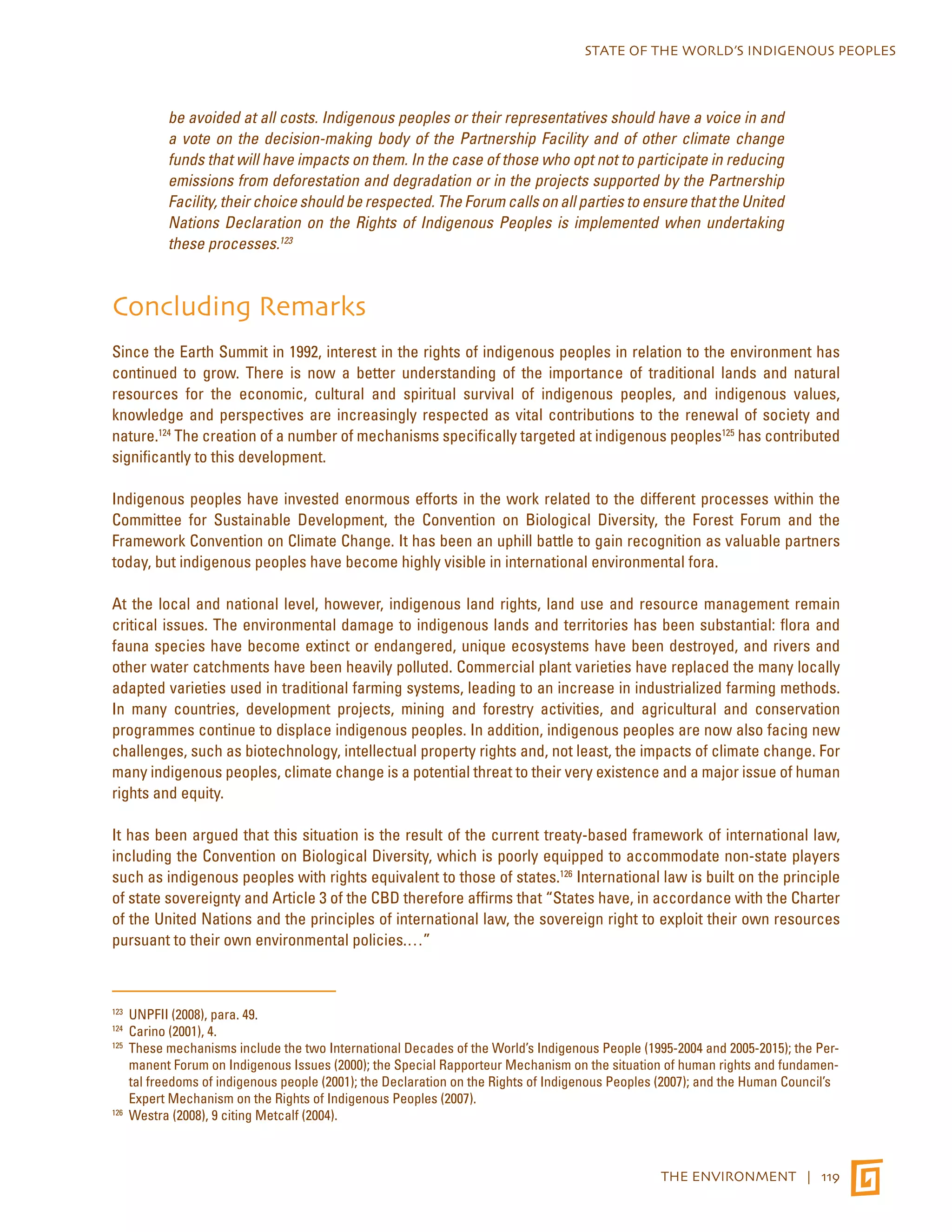
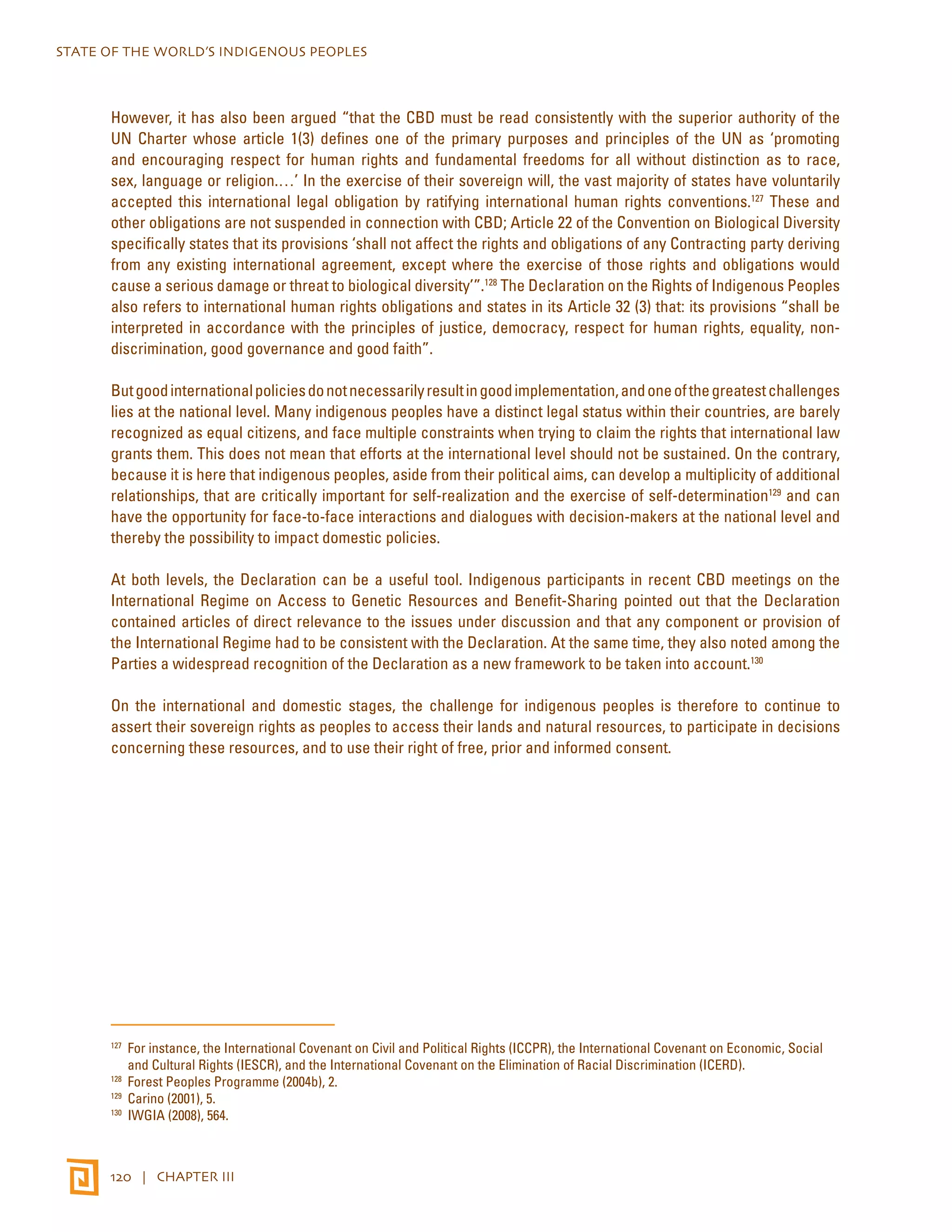
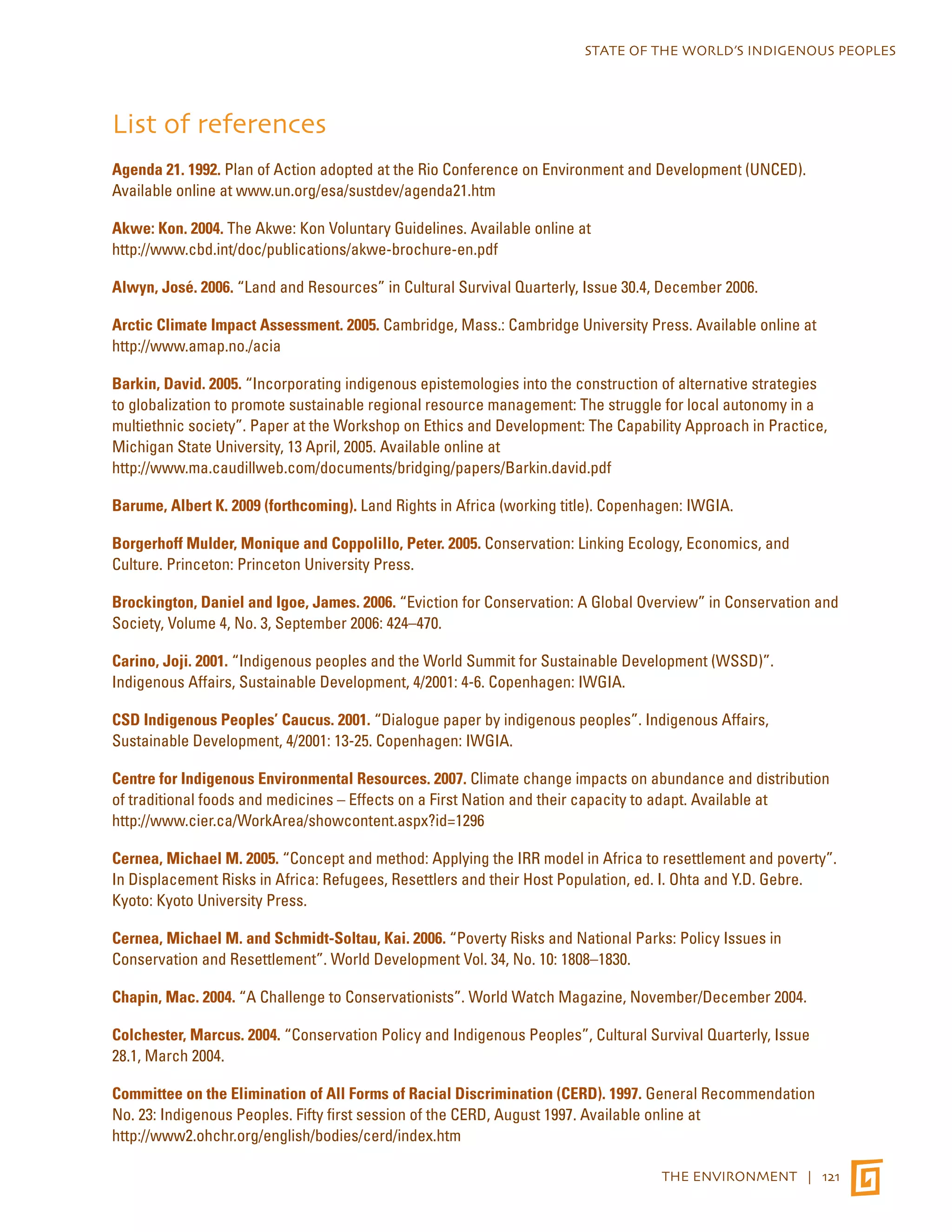
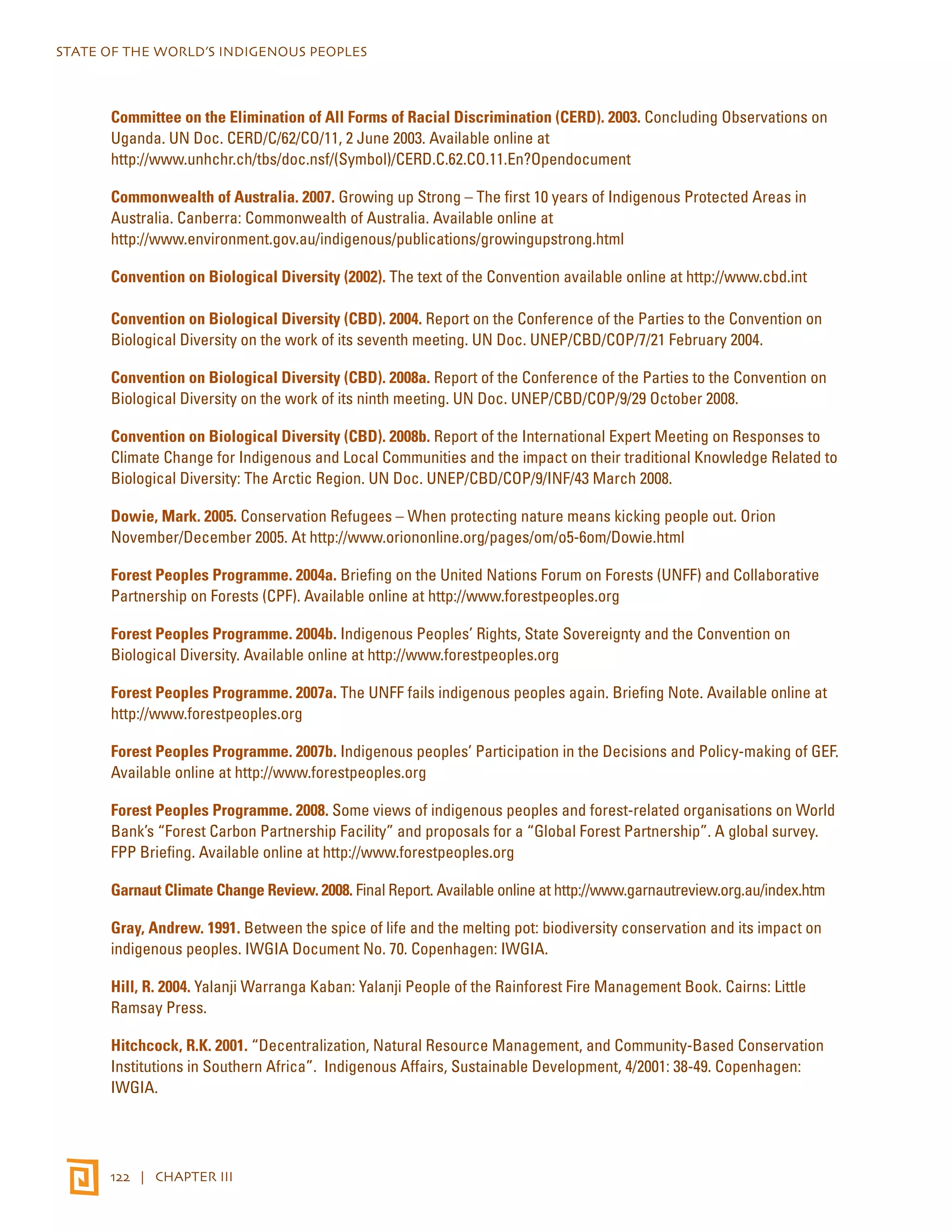



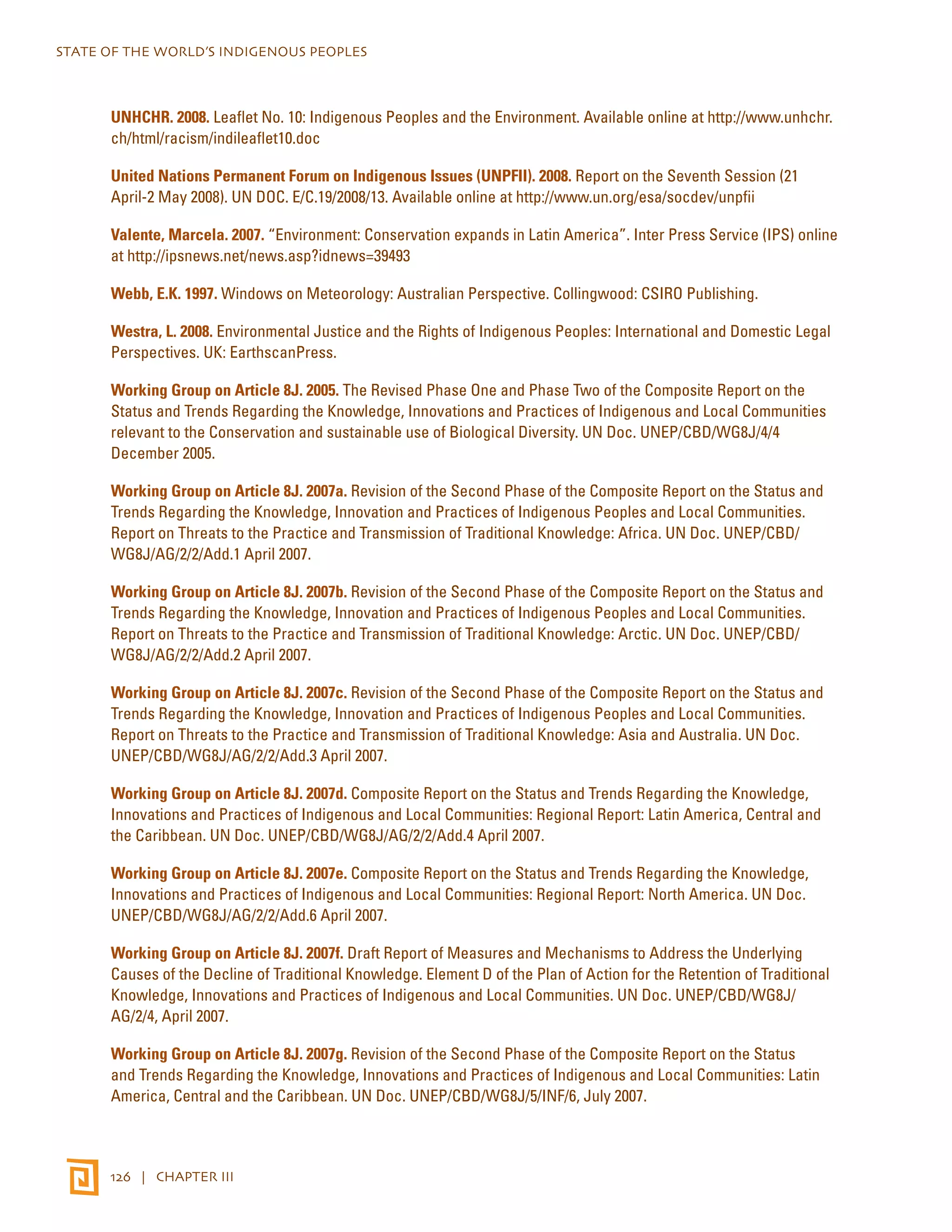
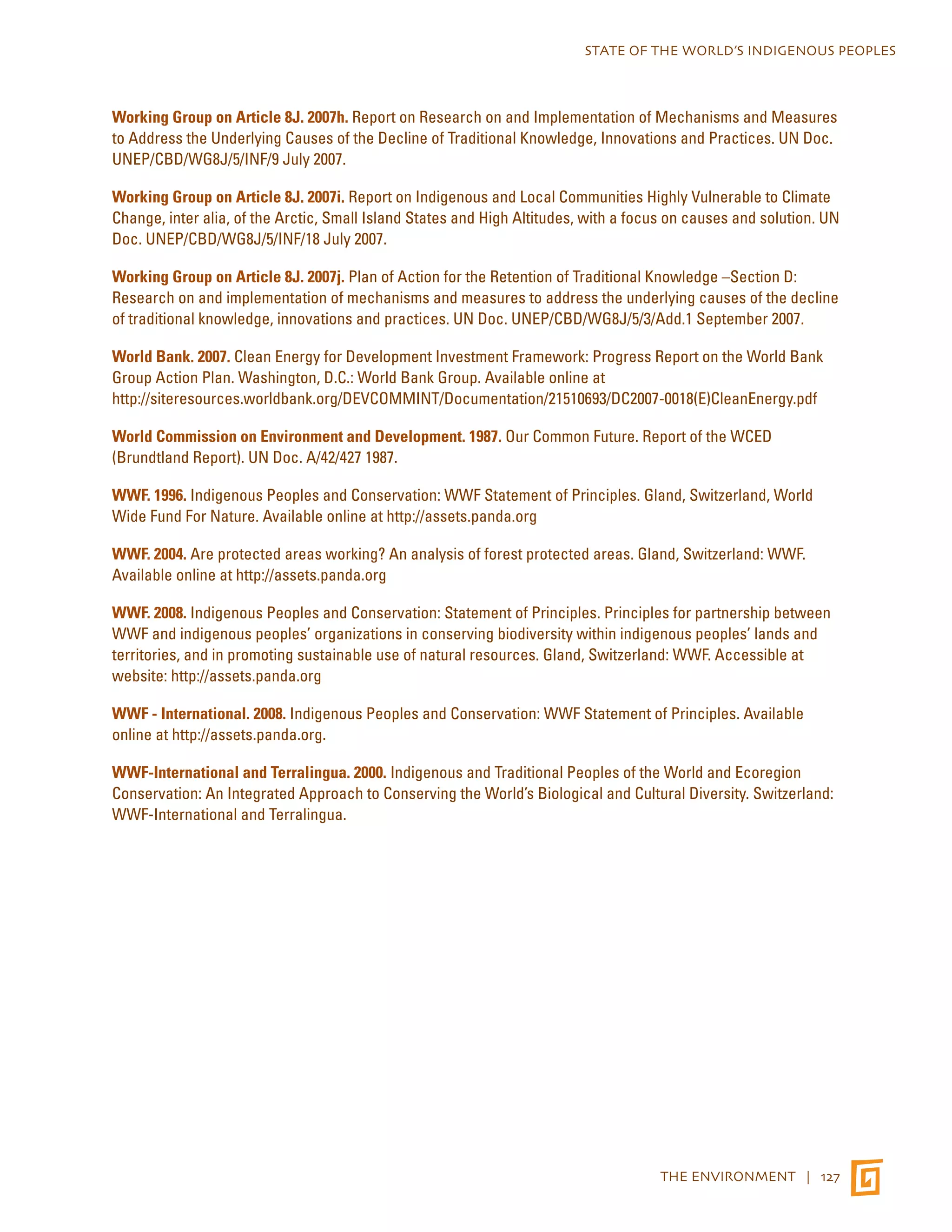

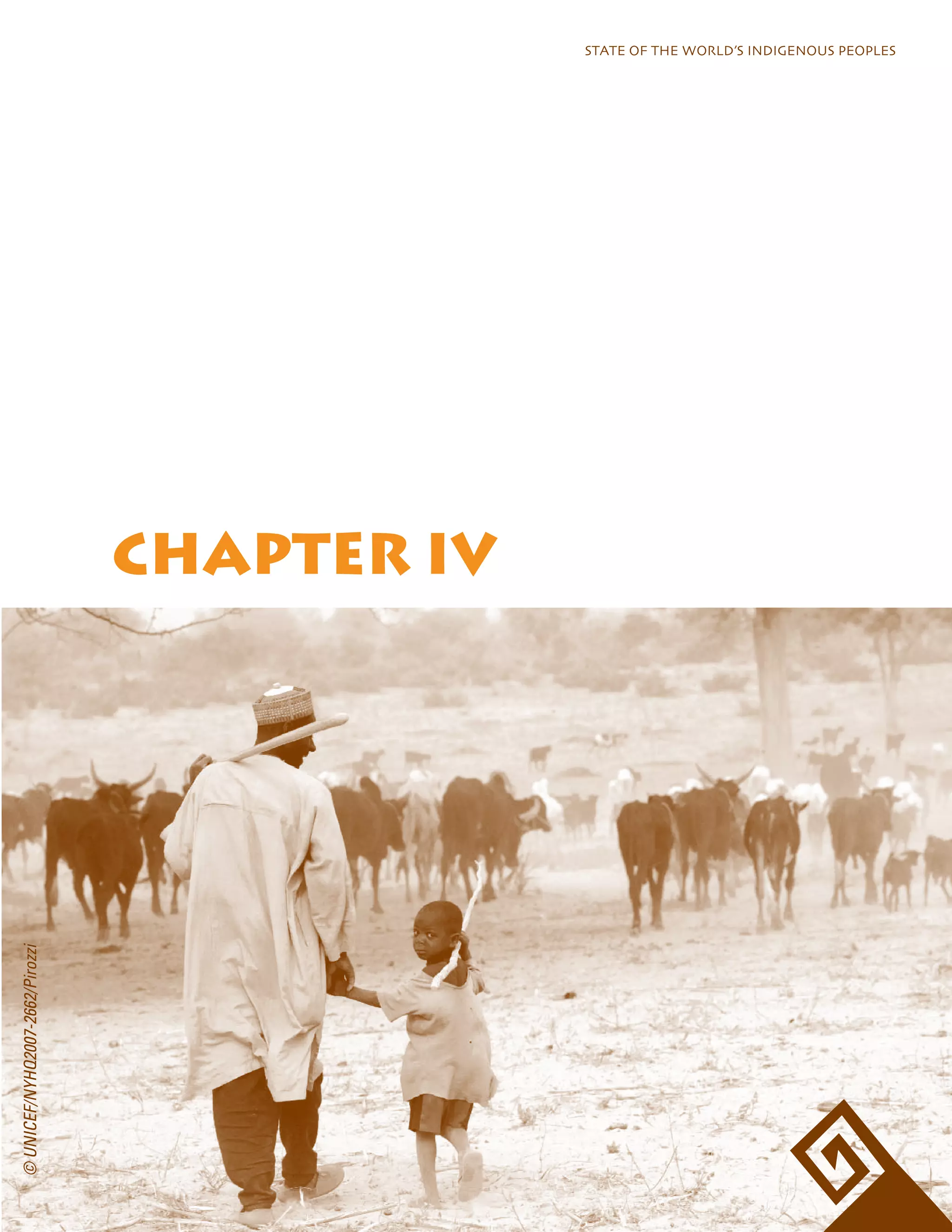
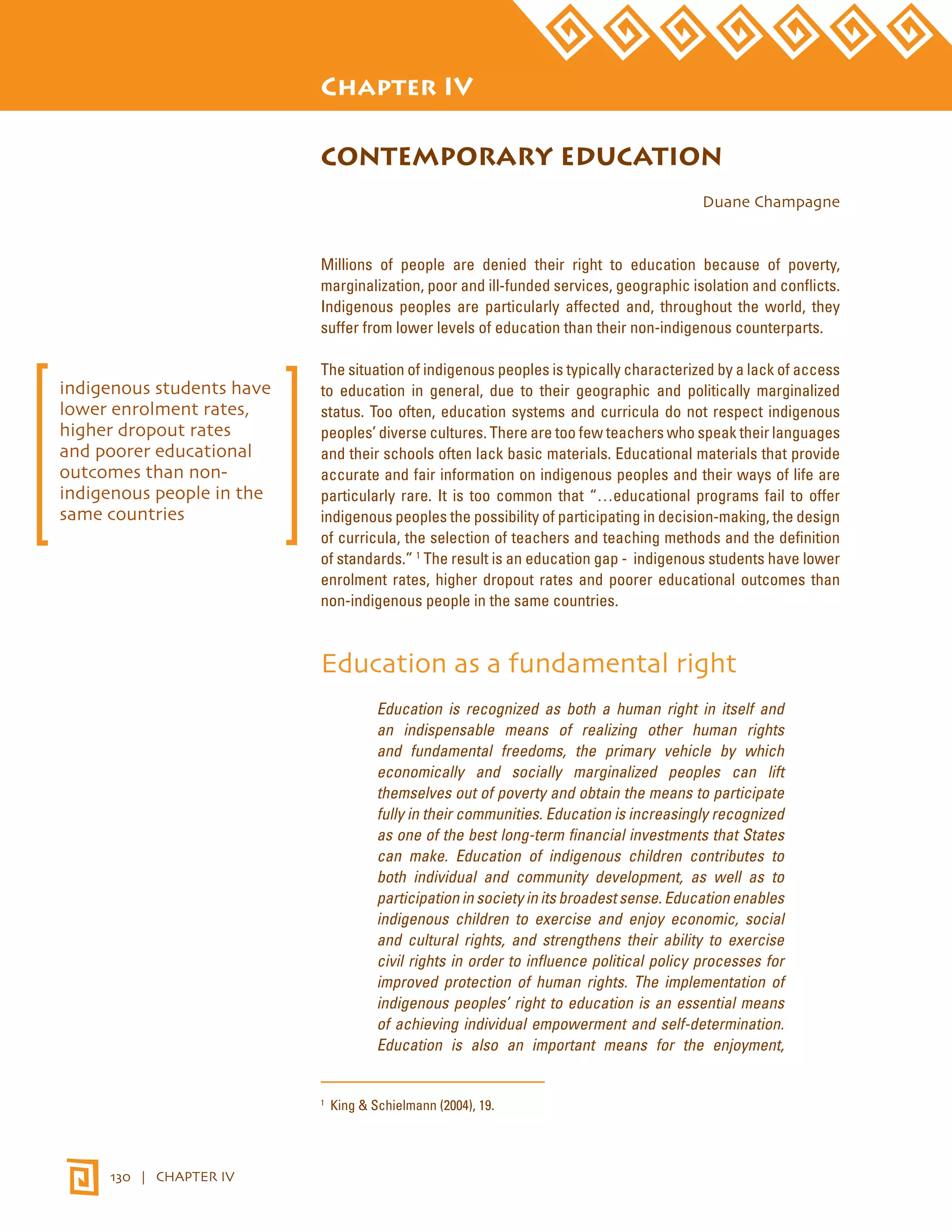

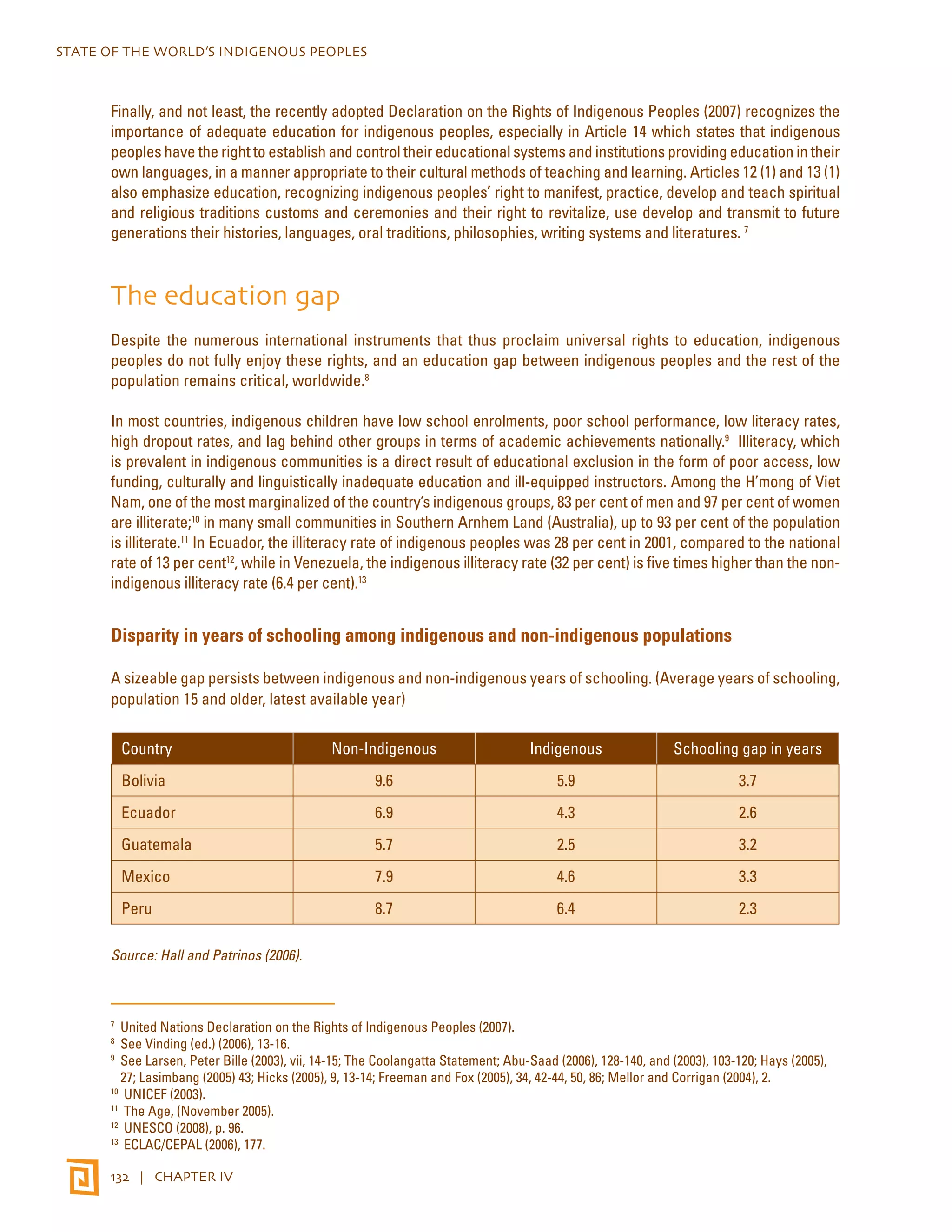
![STATE OF THE WORLD’S INDIGENOUS PEOPLES
Disparate secondary school graduation rates between indigenous
and non-indigenous students
A gap exists between indigenous and non-indigenous rates of high school
graduation. (Percentage of the population who graduated high school, latest
available year)
Country Total Population Indigenous Percentage Gap
Australiaa 49 23 26
Canadab 65 37 28
New Zealand: Mãoric 76.1 62.9 13.2
USA: Native American/
80.4 70.9 9.5
Alaska Natived
CONTEMPORARY EDUCATION | 133
USA: Native Hawaiian/
Pacific Islander
80.4 78.3 2.1
Sources: aAustralian Bureau of Statistics (2008); bStewart, S.C. (2006); cNew Zealand
Household Labour Force Survey (2008); dU.S. Census Bureau (2000).
In a recent ILO study on the MDGs,14 examples from different indigenous
communities around the world showed that primary school enrolment rates
in general were low; in the case of a Bolivian Andean community, rates were
substantially lower (75 per cent) than the national average (97 per cent); in
Cameroon, only 1.31 per cent of the indigenous Baka children in the District of
Salapoumbé attended primary school. In 2000, the UN Committee on the Rights
of the Child expressed “serious concern regarding the striking disparities in
terms of access to education, attendance at primary and secondary levels and
drop-out rates [suffered by] children belonging to scheduled castes and tribes
[in India]”.15
Speaking an indigenous or non-official language is a clear marker of
disadvantage in terms of schooling. In Mozambique, for example, 43 per cent of
people aged between 16 and 49 who speak Portuguese have at least one grade
of secondary schooling, while among speakers of Lomwe, Makhuwa, Sena
and Tsonga, the rates are between 6 and 16 per cent. In Bolivia, 68 per cent of
Spanish speakers aged 16 to 49 have completed some secondary education,
while only a third or fewer of Aymara, Quechua and Guaraní speakers have
done so.16 Indigenous girls tend to be more disadvantaged than indigenous
boys. In Guatemala, only 54 per cent of indigenous girls are in school, compared
with 71 per cent of indigenous boys. By age 16, only a quarter of indigenous
girls are enrolled, compared with 45 per cent of boys.17
14 Vinding (ed.) (2006).
15 UN Committee on the Rights of the Child (CRC) (2000).
16 UNESCO (2008), p. 96.
17 UNESCO (2008), p.104-105.
speaking an indigenous
or non-official language
is a clear marker of
disadvantage](https://image.slidesharecdn.com/sowipweb-141112214427-conversion-gate02/75/Sowip-web-144-2048.jpg)
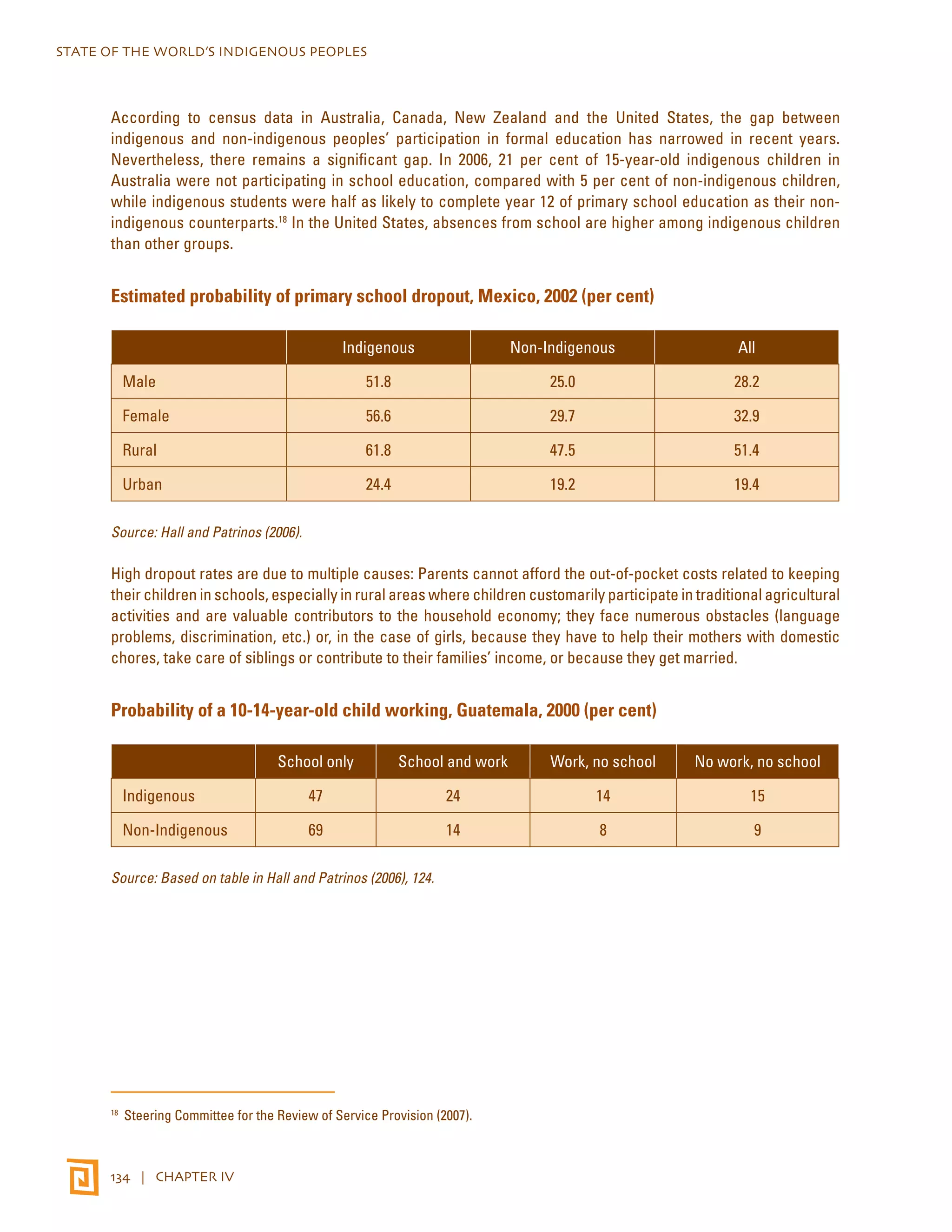
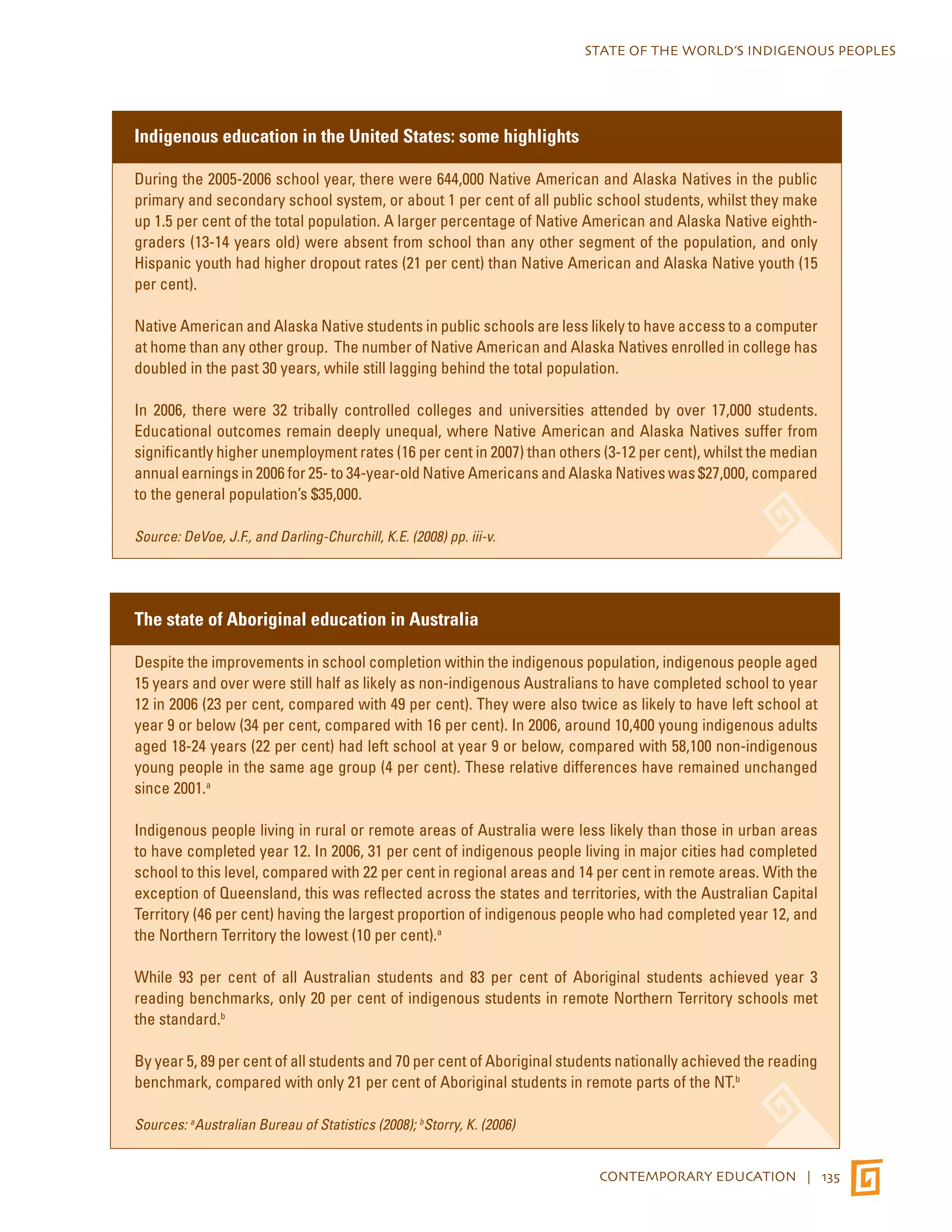

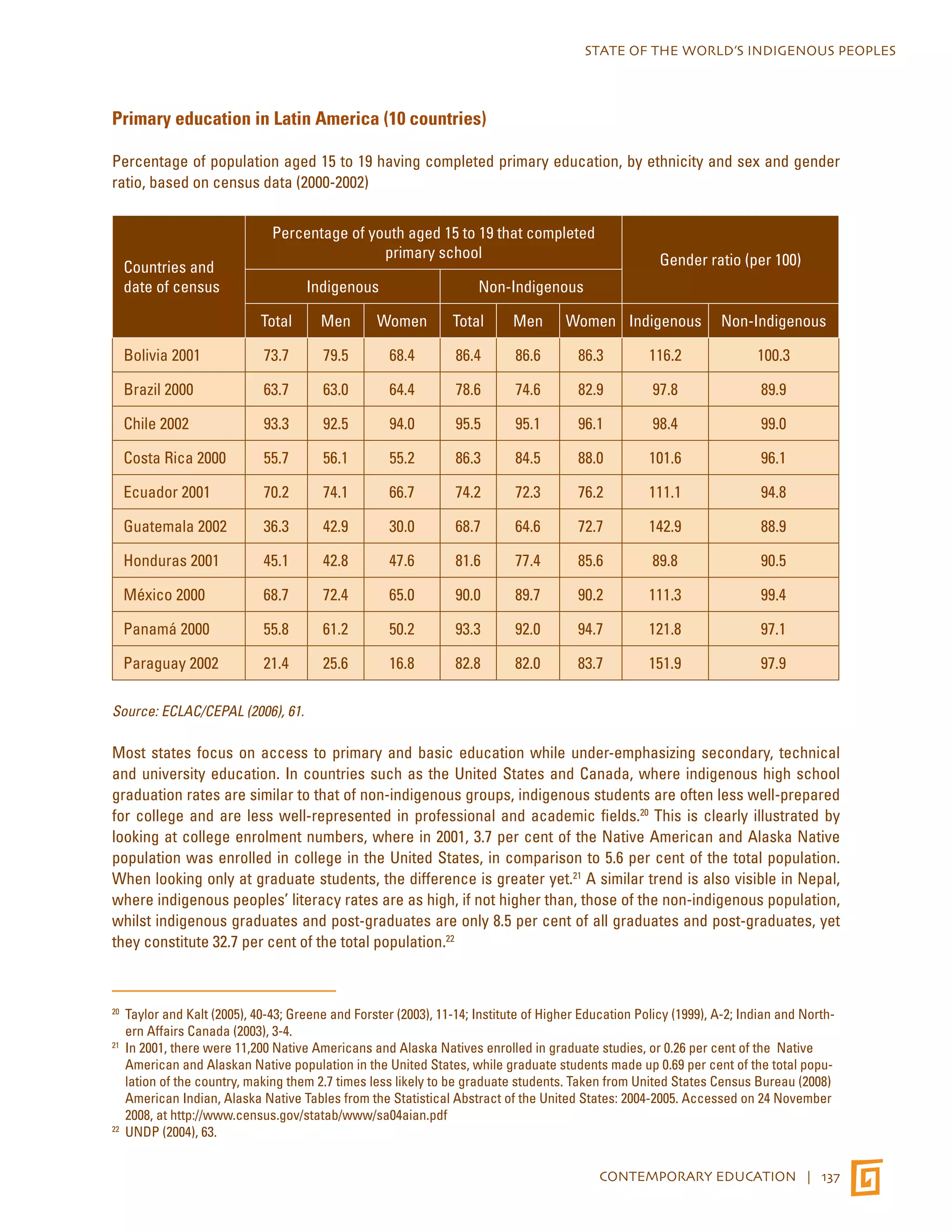
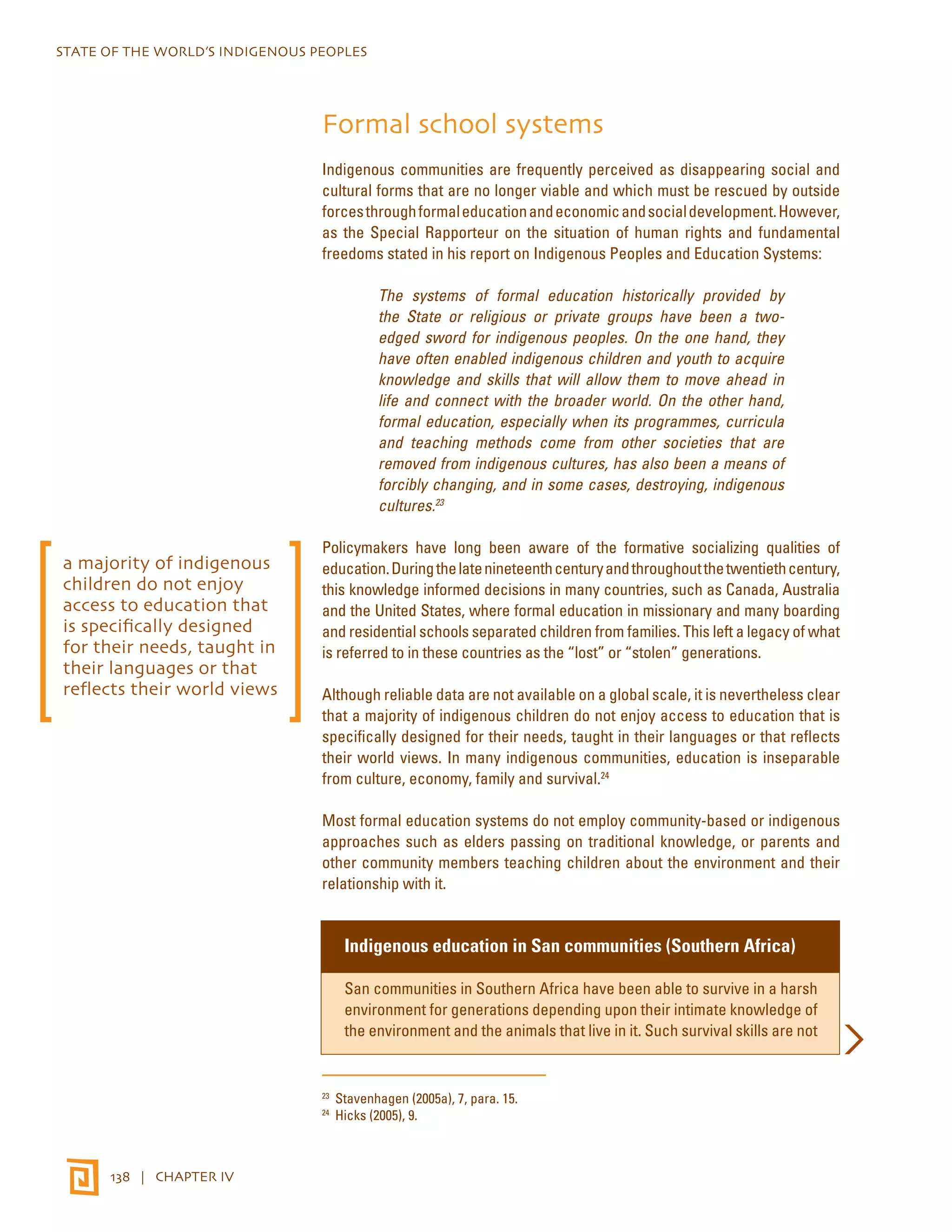
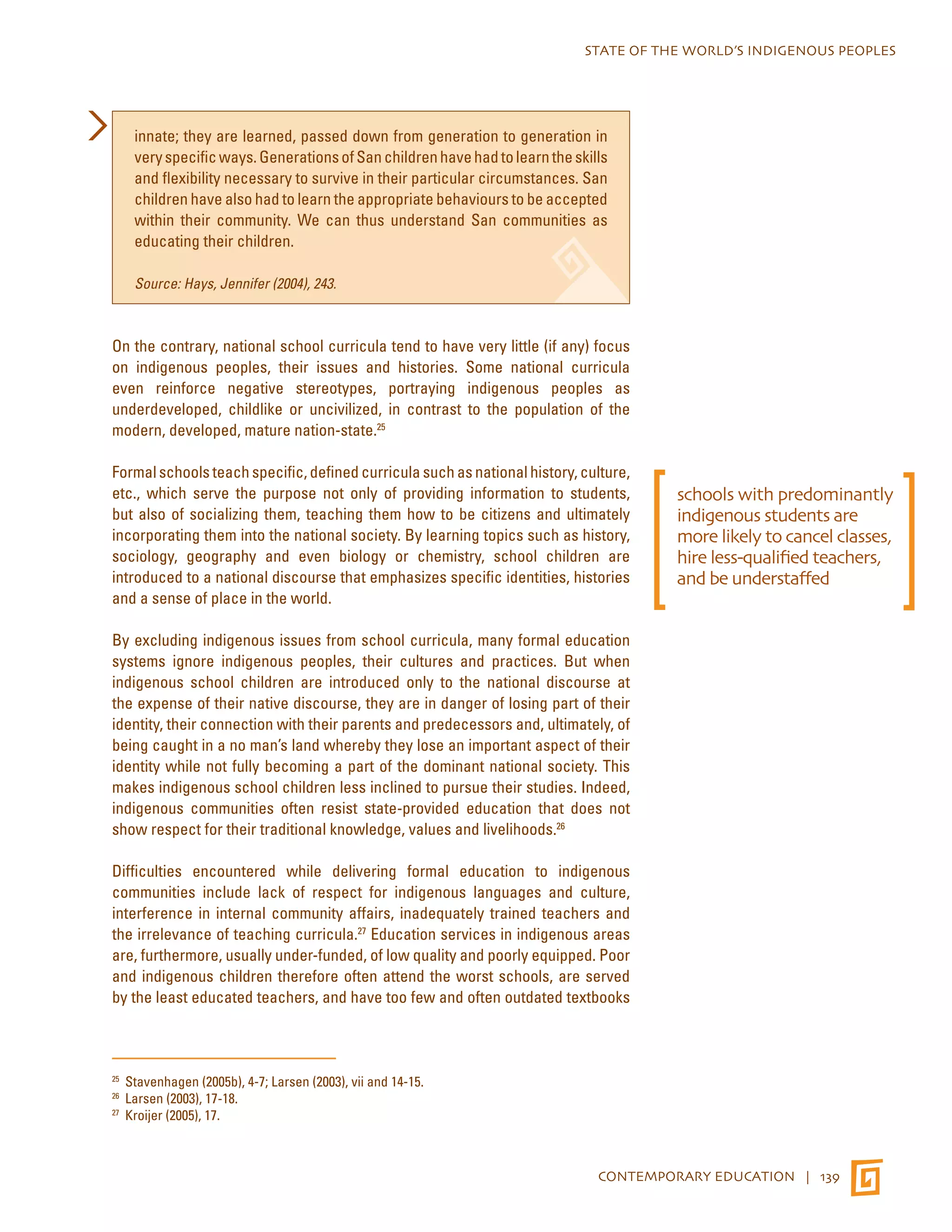
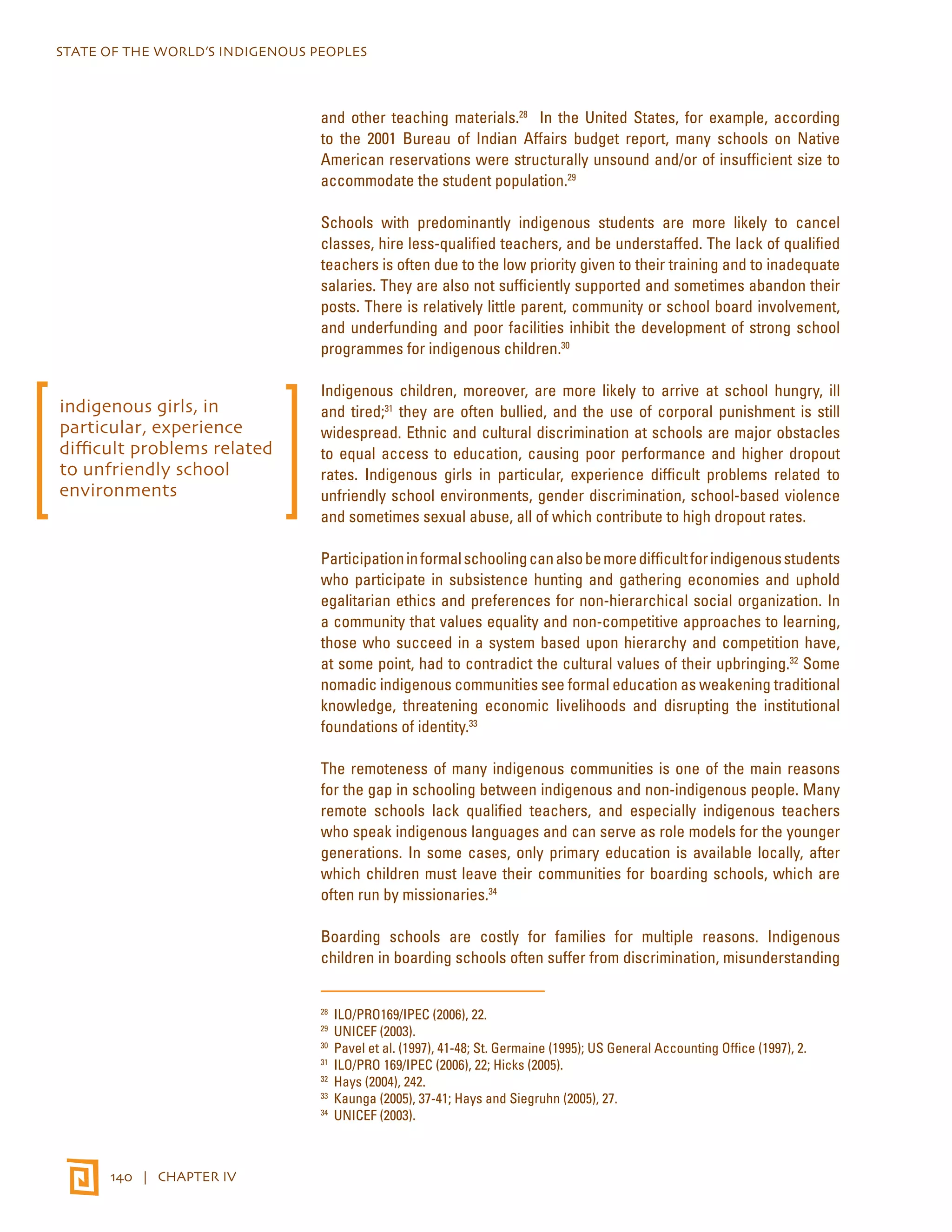

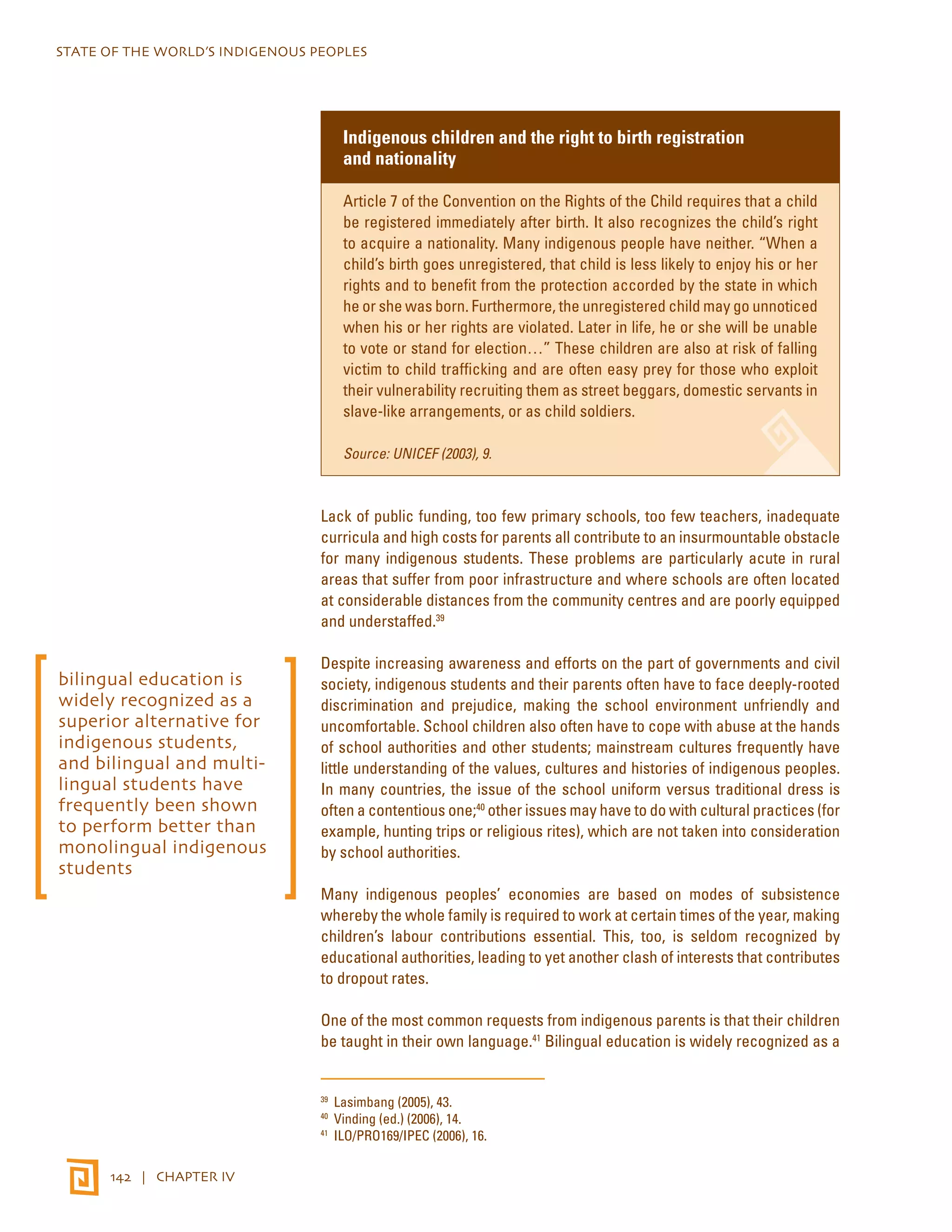
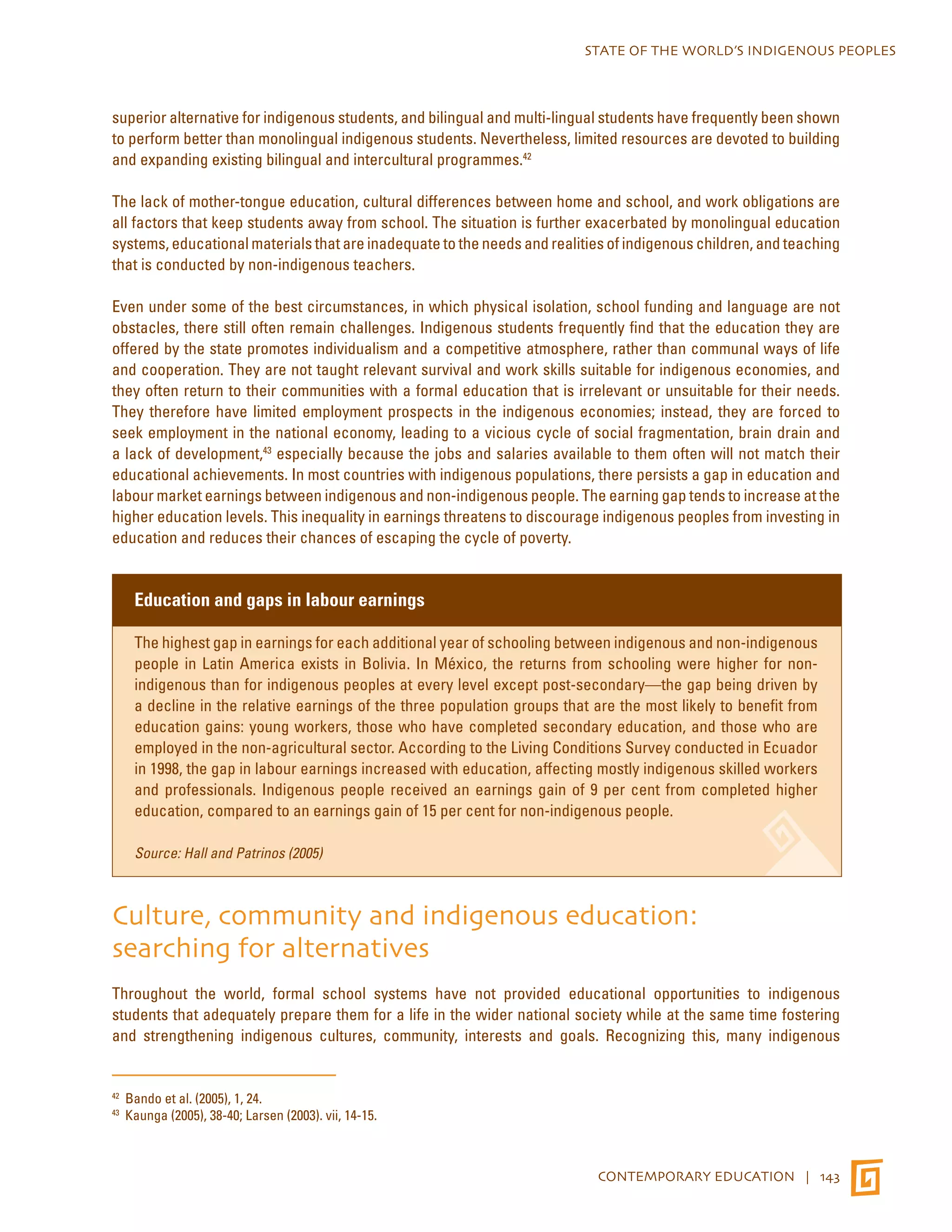
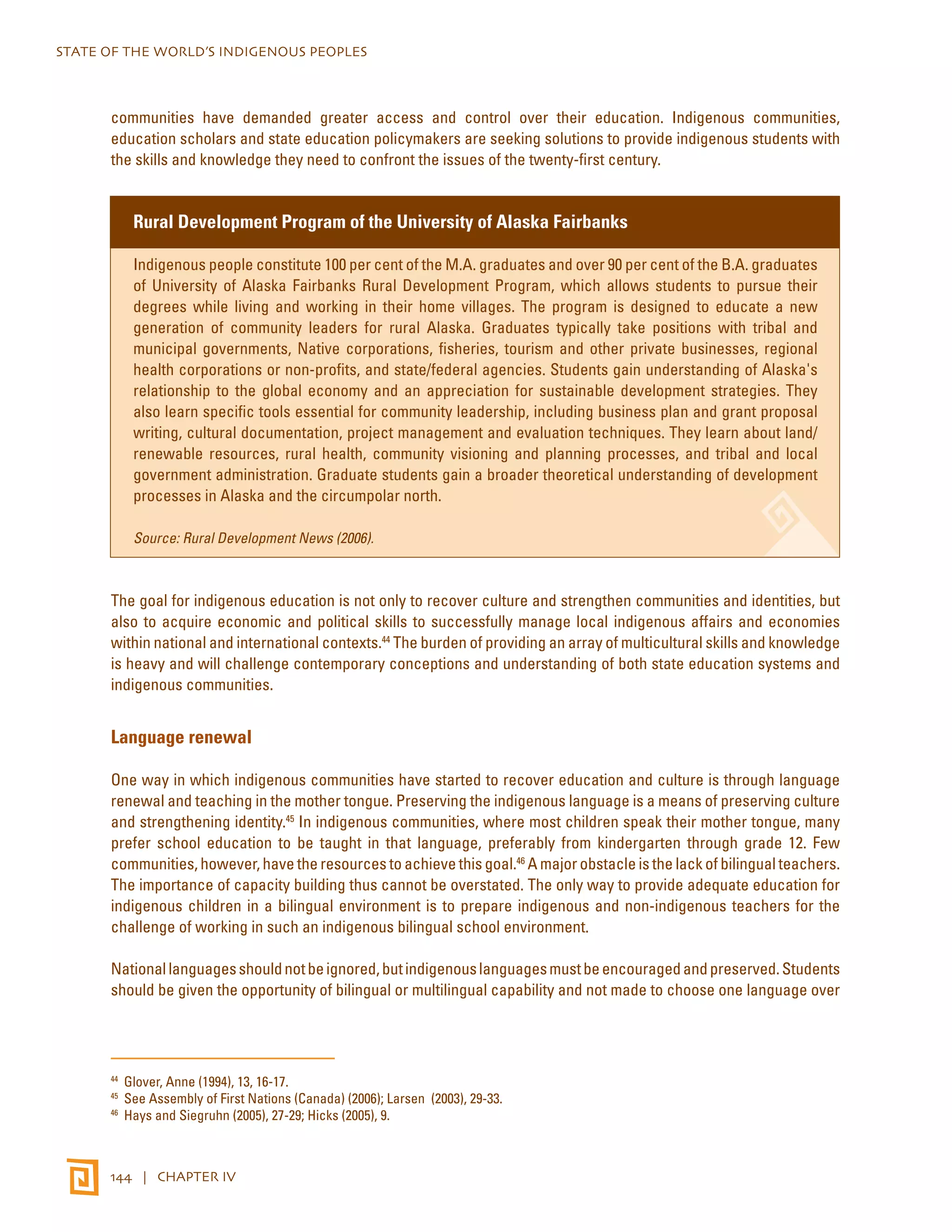
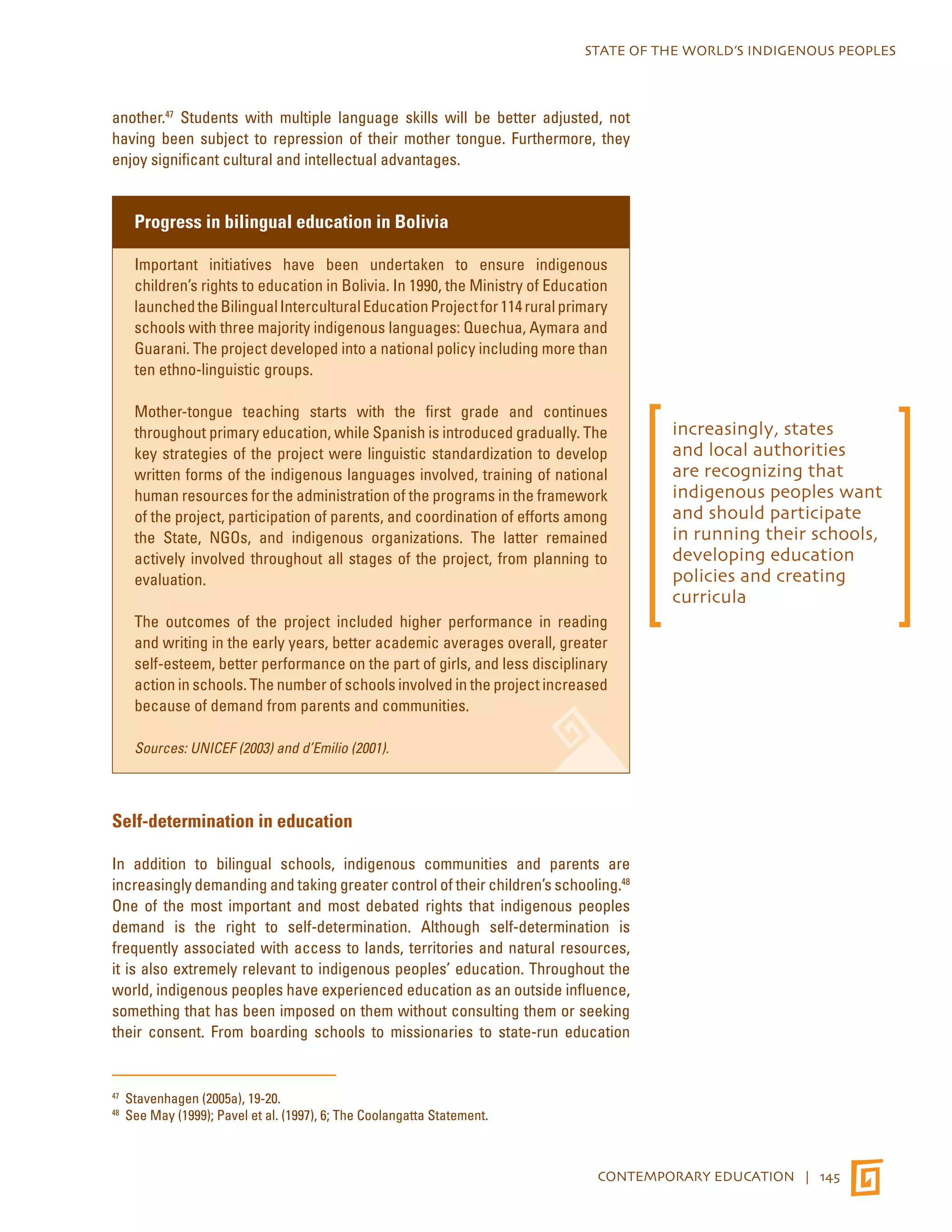
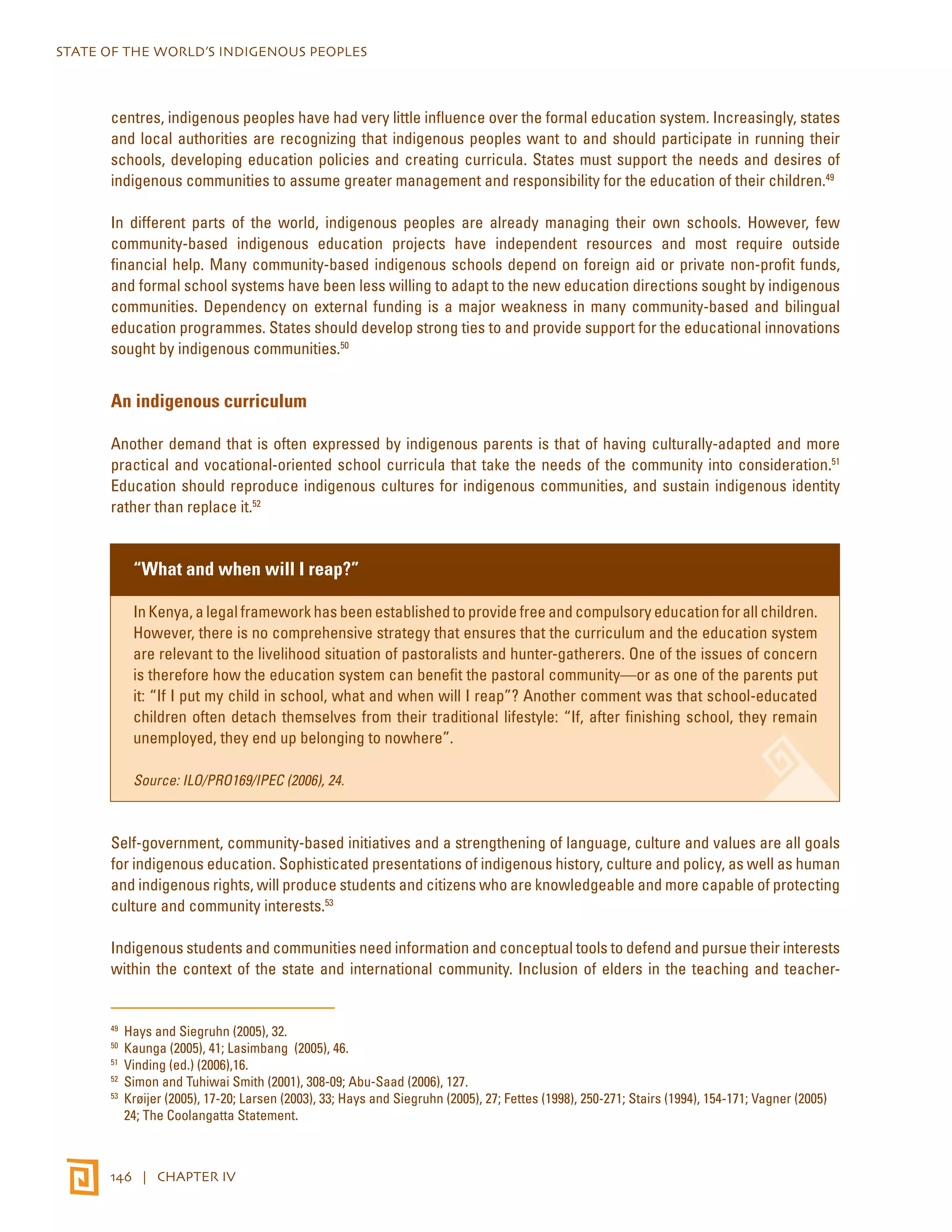

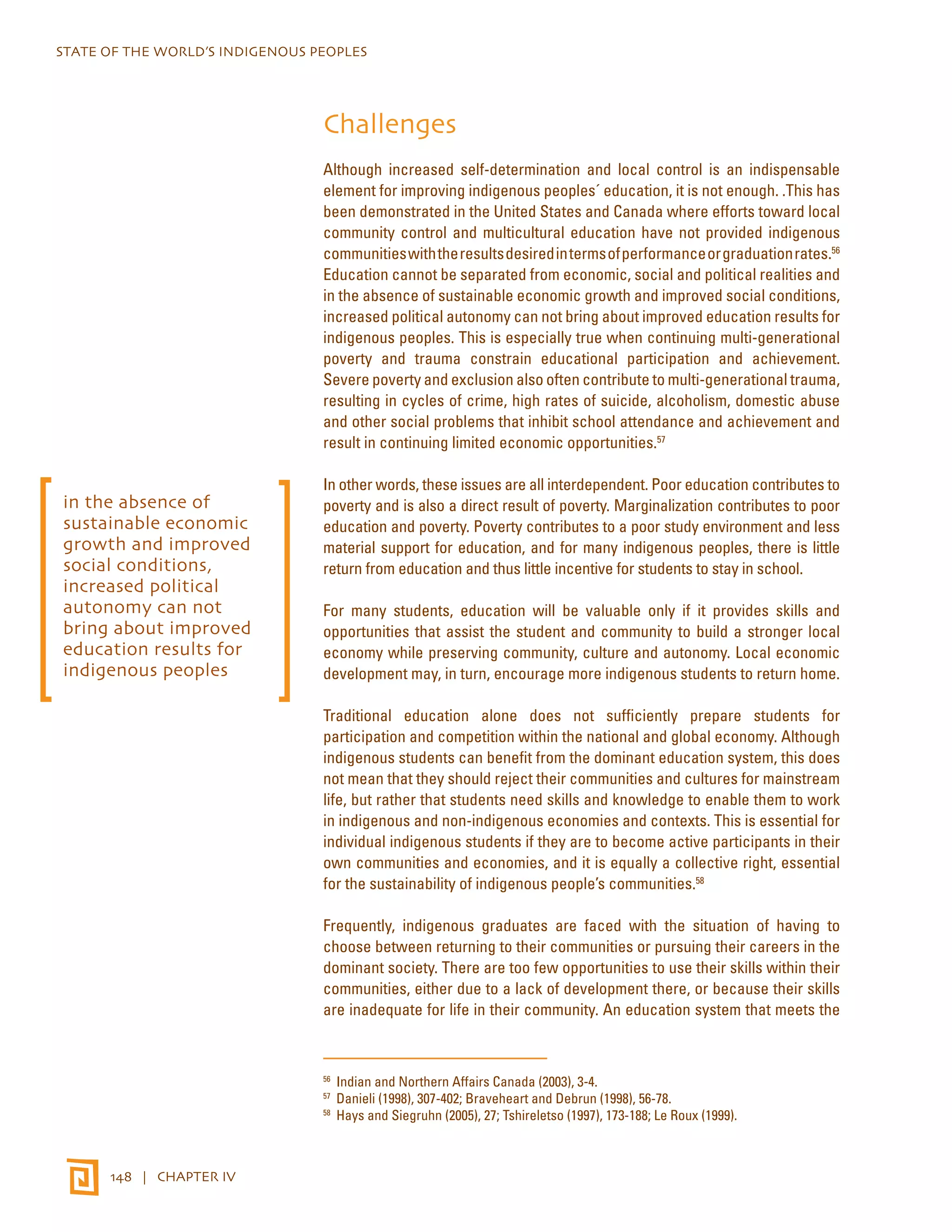
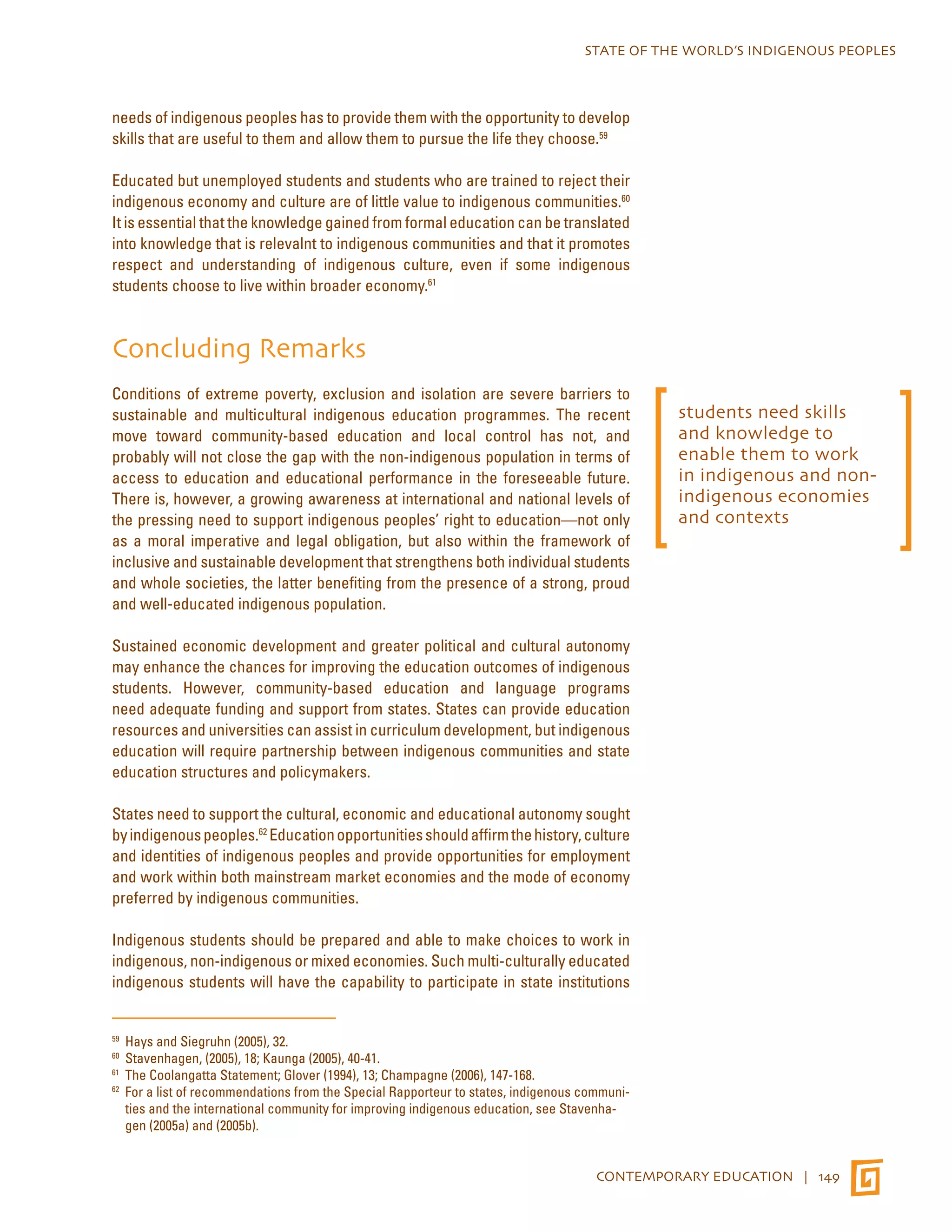
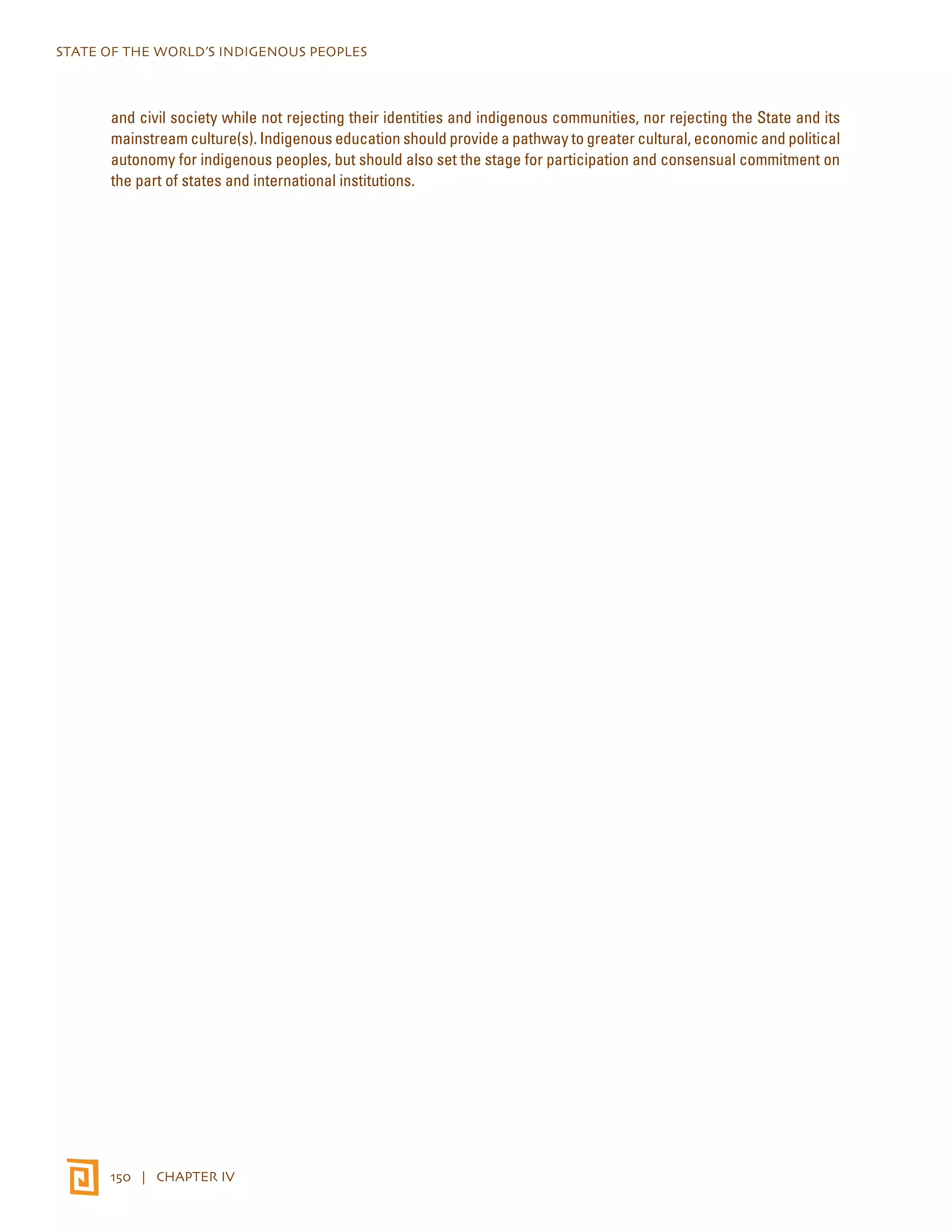
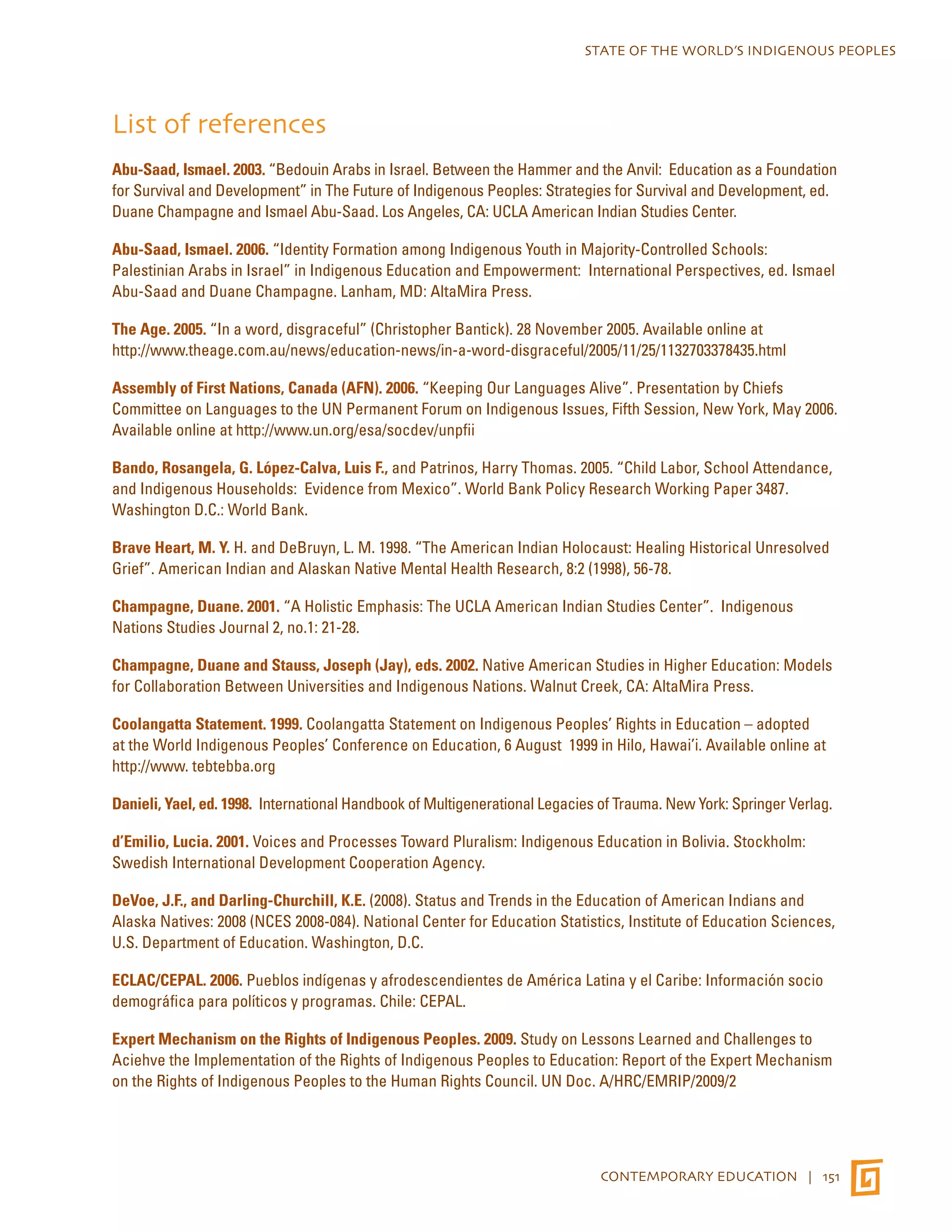
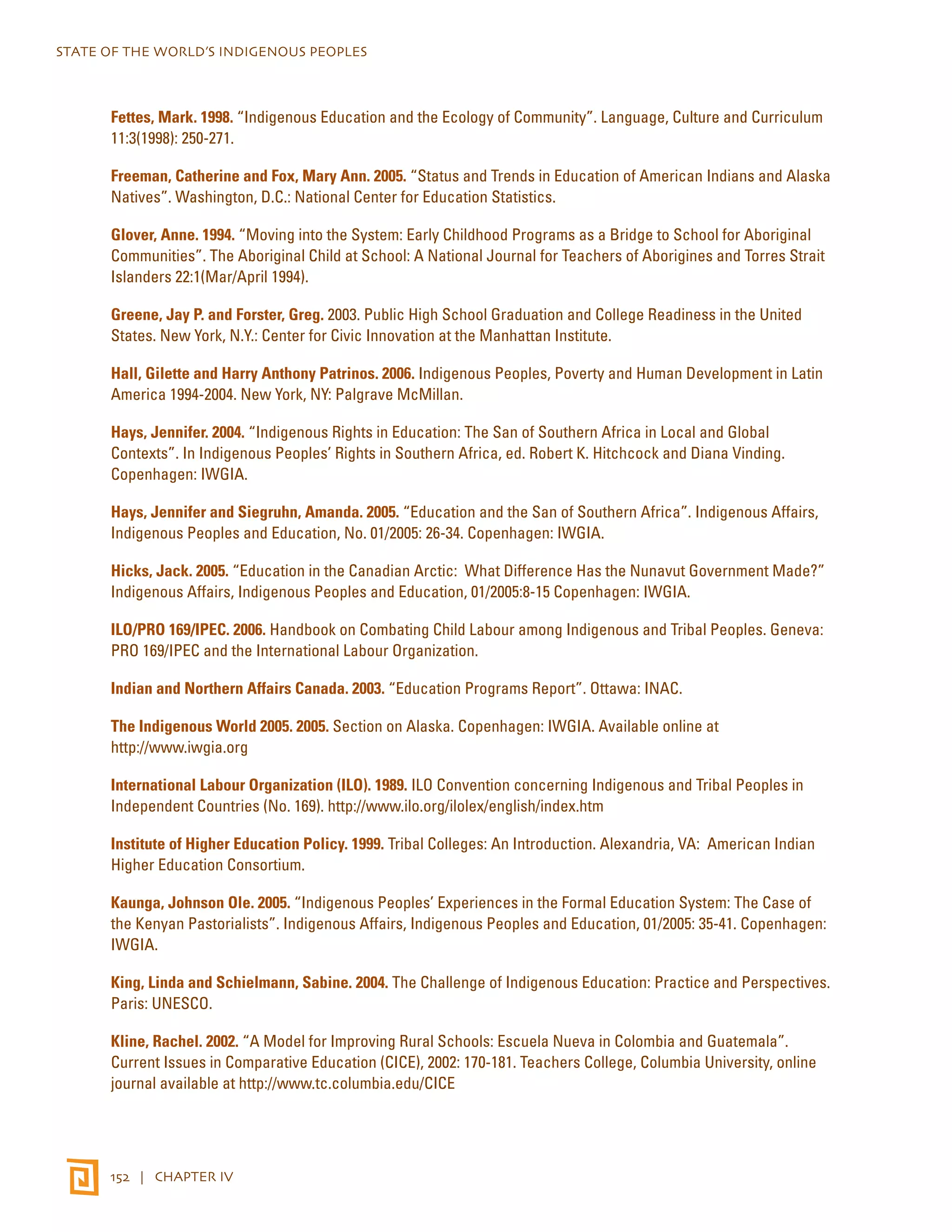

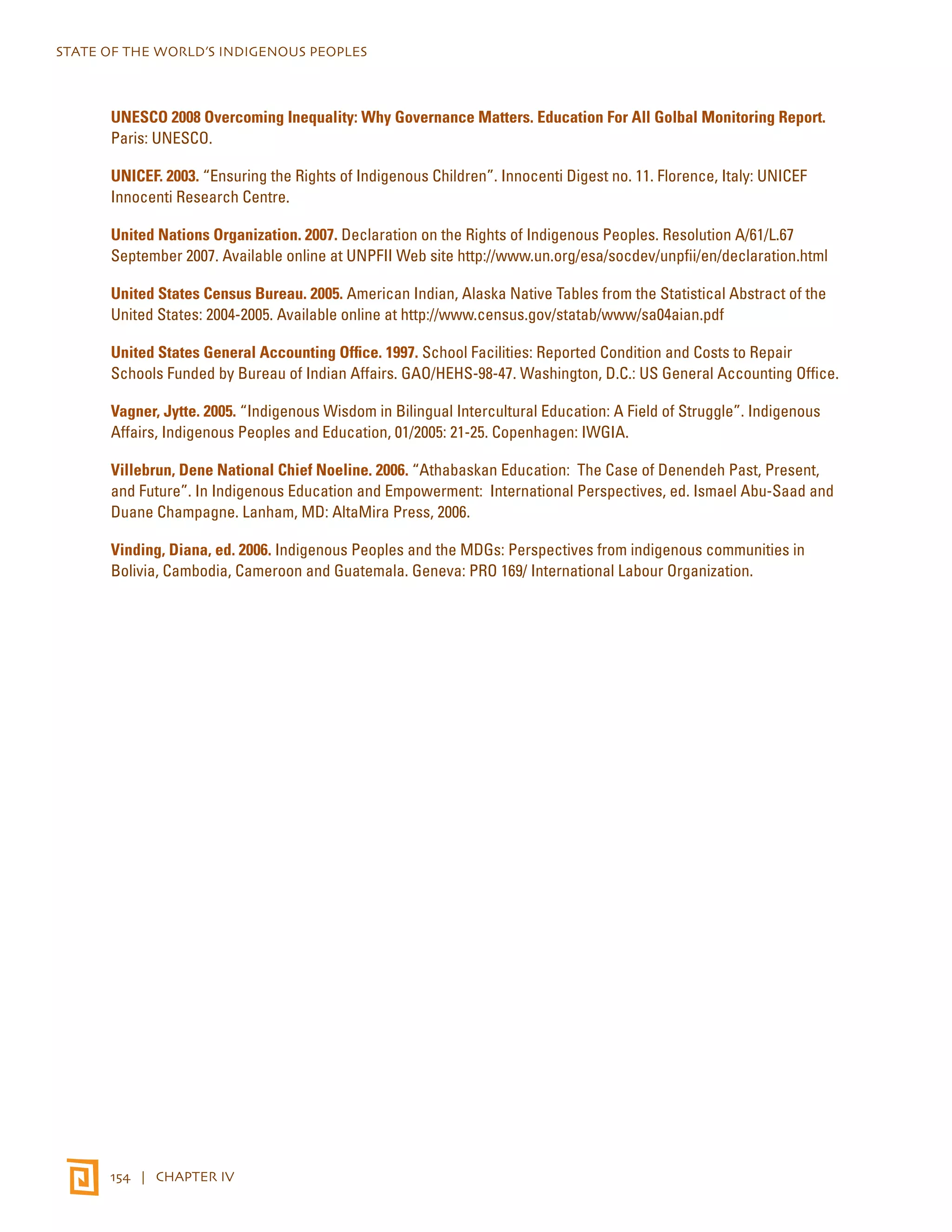


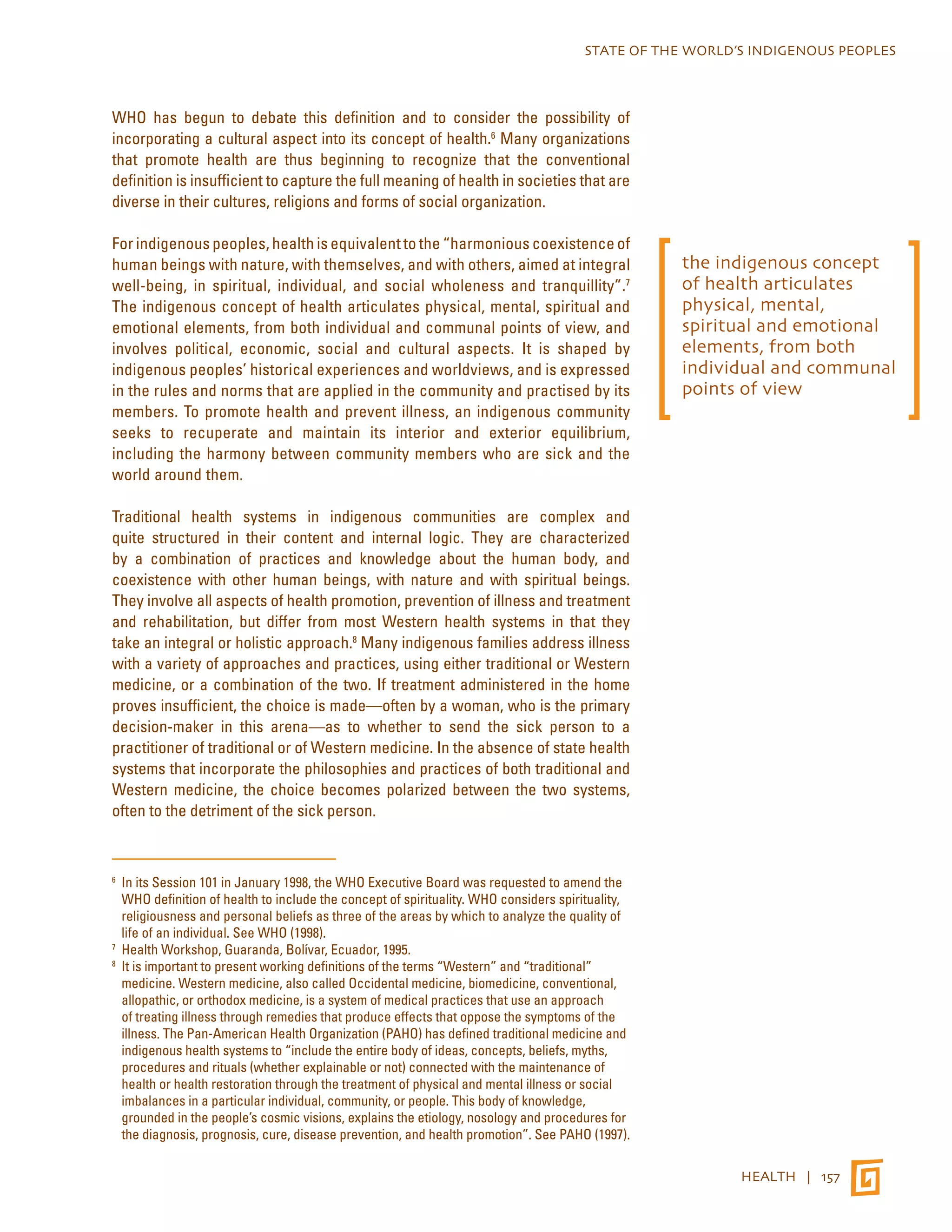
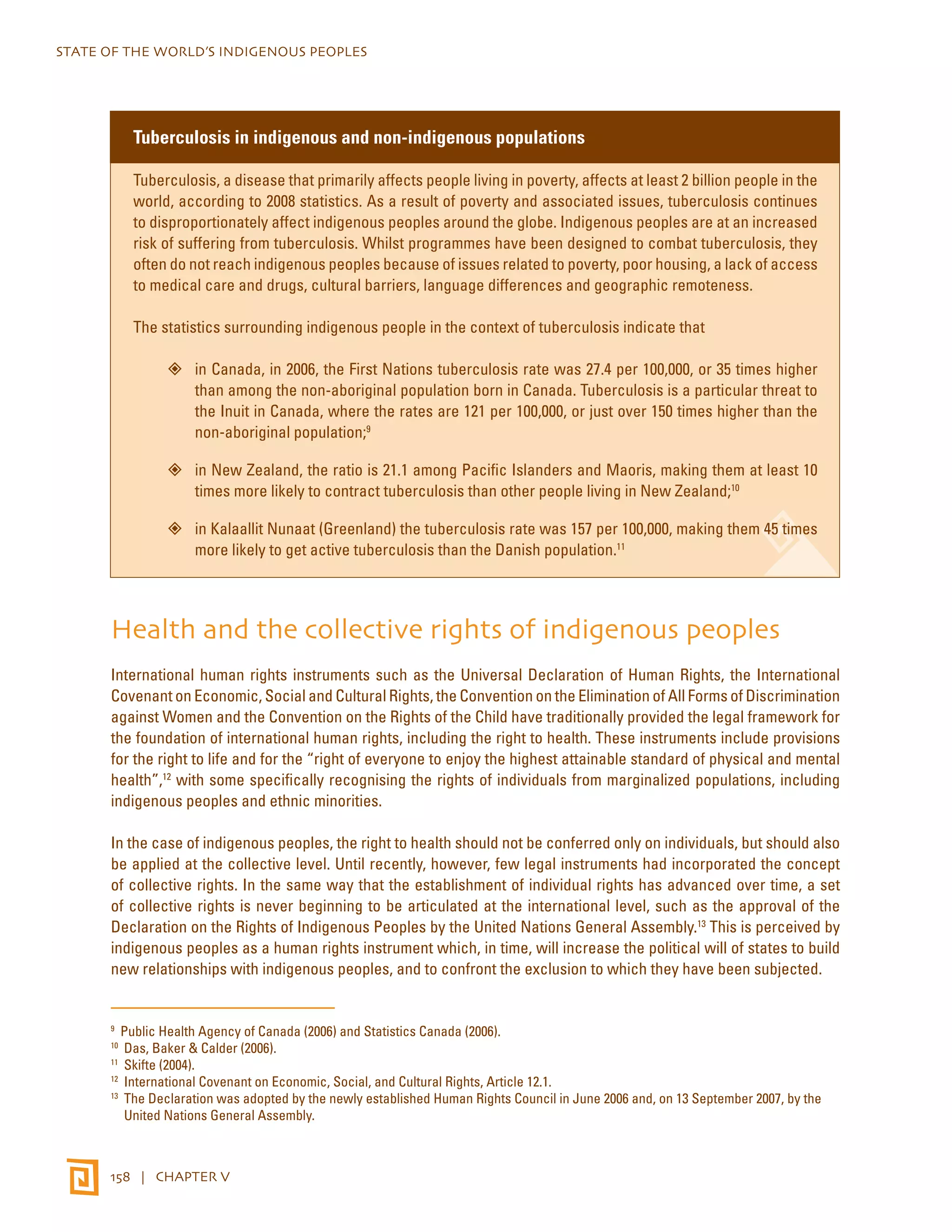

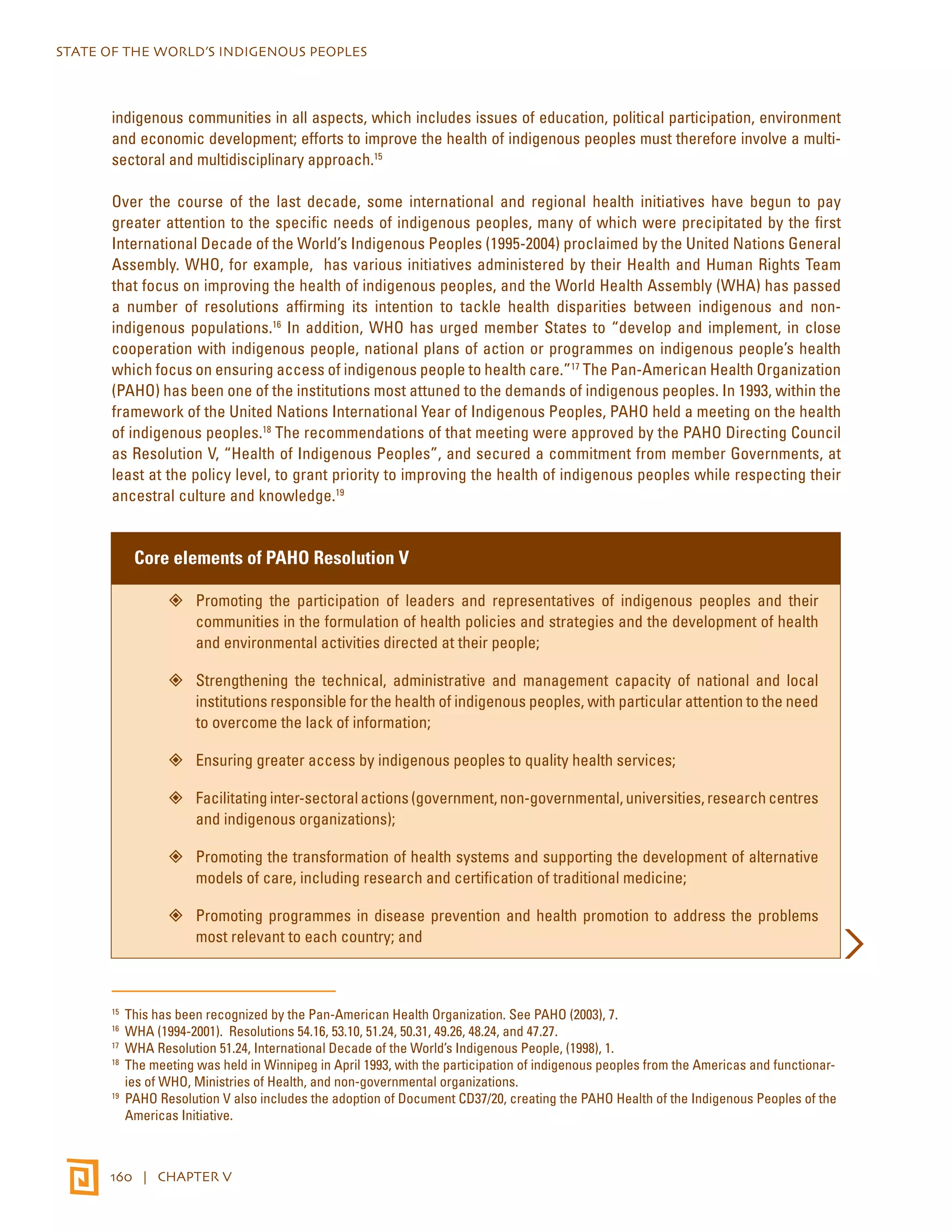
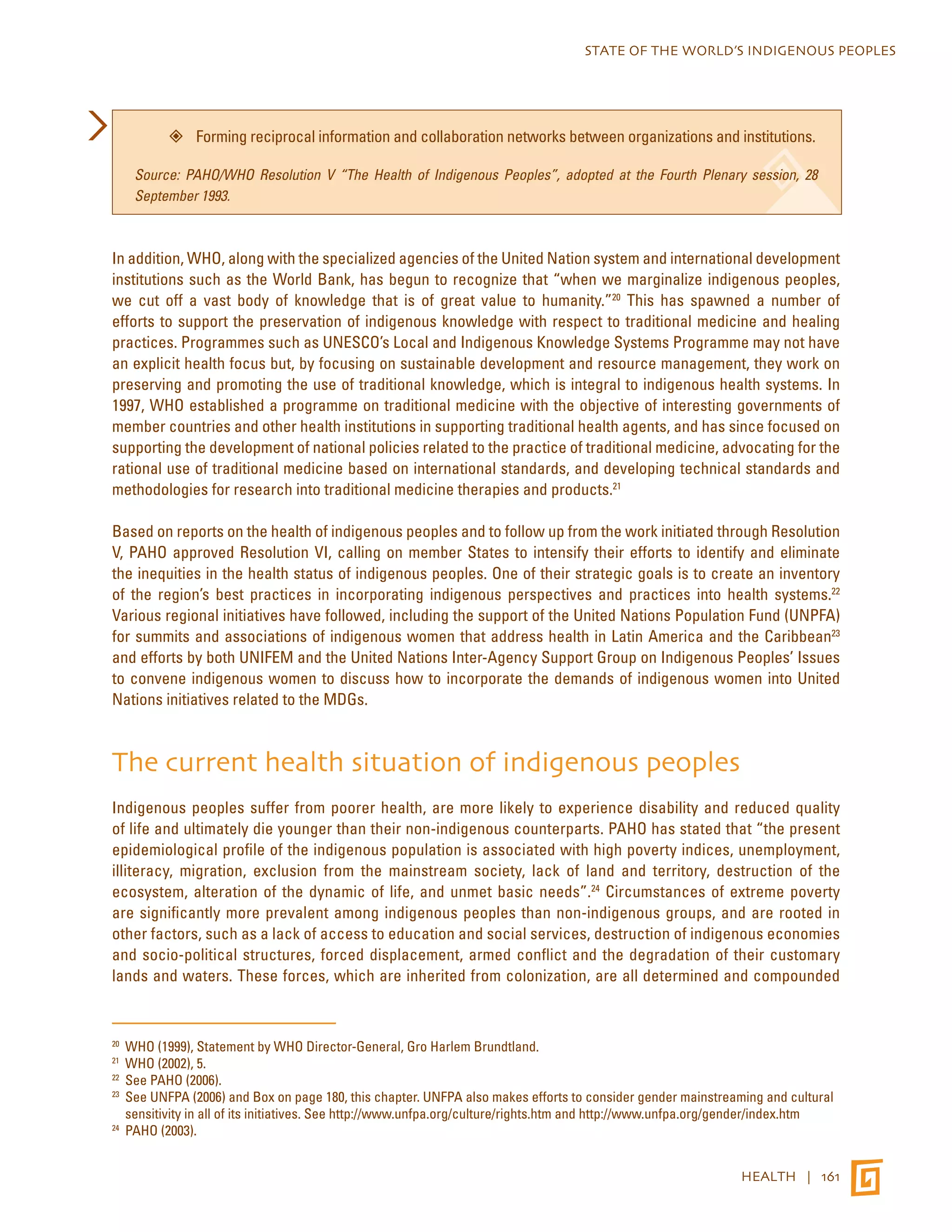

![STATE OF THE WORLD’S INDIGENOUS PEOPLES
Poor nutrition is one of the health issues that most affects indigenous peoples around the world. In addition
to circumstances of extreme poverty, indigenous peoples suffer from malnutrition because of environmental
degradation and contamination of the ecosystems in which indigenous communities have traditionally lived,
loss of land and territory, and a decline in abundance or accessibility of traditional food sources. These changes
in traditional diet, combined with other changes in lifestyle, have resulted in widespread malnutrition among
indigenous peoples. The World Bank has reported that “the rate of stunting [height/age] for Guatemala overall
is 44 percent, but for indigenous children the rate is 58 percent, higher than either Yemen or Bangladesh, and
almost twice the rate for non-indigenous children. In Ecuador, chronic malnutrition is more than twice as high in
indigenous as compared to non-indigenous communities”.26 In El Salvador, an estimated 40 per cent of indigenous
children under age five are malnourished, compared to the national average of 23 per cent, and in Honduras an
estimated 95 per cent of indigenous children under age 14 suffer from malnutrition.27
However, this malnutrition manifests itself differently depending on the local circumstances. Whilst in some
parts of the world malnutrition affects maternal and infant health and child development, in other regions
it contributes to an increasing prevalence of non-communicable diseases such as obesity, diabetes and
cardiovascular disease among indigenous peoples. In the State of Arizona in the United States, for example,
the Pima Indian tribe has the highest rate of diabetes in the world, as “some 50 per cent of the Pima between
the ages of 30 and 64 have diabetes.”28
HEALTH | 163
Indigenous people and diabetes
Indigenous people are particularly vulnerable to diabetes due to a combination of environmental, genetic
and socio-economic factors. The contamination and destruction of natural habitats and the disappearance
of wildlife plants and animals have resulted in the erosion of traditional food systems and decreased food
security. This has led to increasing reliance upon imported processed foods that have little nutritional
value but are often high in sodium and fat, causing obesity and diabetes.
The genetic selection processes that may have been advantageous when food was in short supply and
had to be obtained through hard physical effort make indigenous people highly vulnerable to diabetes
at the time of the rapid transition to a high-calorie diet and low levels of physical activity. The situation
is aggravated by indigenous peoples’ lack of access to health care. Most indigenous people are never
diagnosed or treated for diabetes. Others are diagnosed too late to prevent the dramatic impact of the
disease on the eyes, kidneys, nerves and circulation.
Because of economic constraints and lack of knowledge about healthy eating, many families choose
affordability over nutritional value. In Tonga, for example, traditional low-fat sources of protein, such as
fish, cost between 15 per cent and 50 per cent more than either lamb flaps or imported chicken parts. The
local taro plant costs more than imported starches such as bread and rice. Thus, “not only are the health
consequences of these imported foods detrimental, but the availability of these cheap imports is also
constraining the development of domestic markets”.
There is little research into diabetes prevalence in indigenous populations. However, available health
statistics indicate that, in some indigenous communities, diabetes has reached epidemic proportions and
26 Hall and Patrinos (2006), 14.
27 PAHO (2002a), 181.
28 PAHO (2002), 182.](https://image.slidesharecdn.com/sowipweb-141112214427-conversion-gate02/75/Sowip-web-174-2048.jpg)
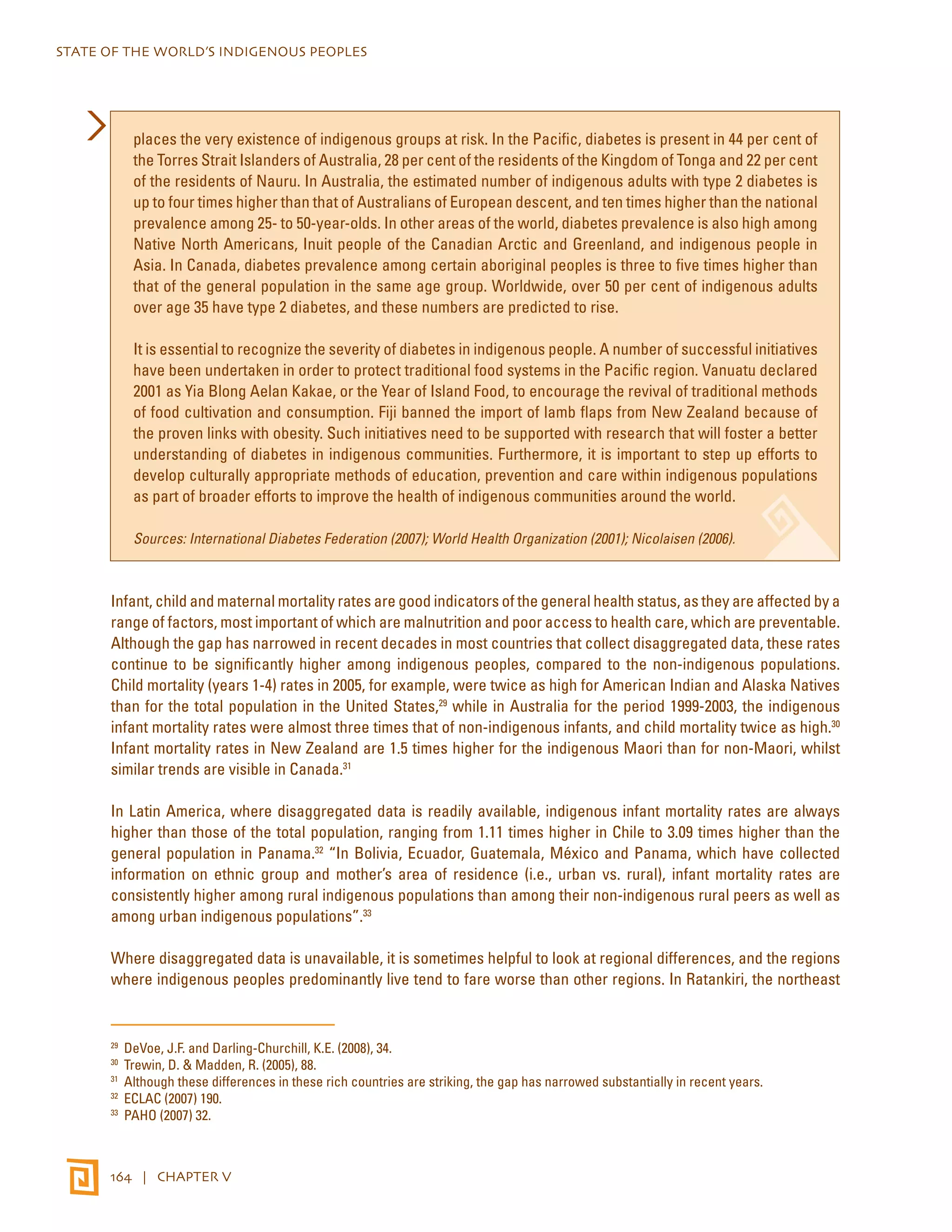
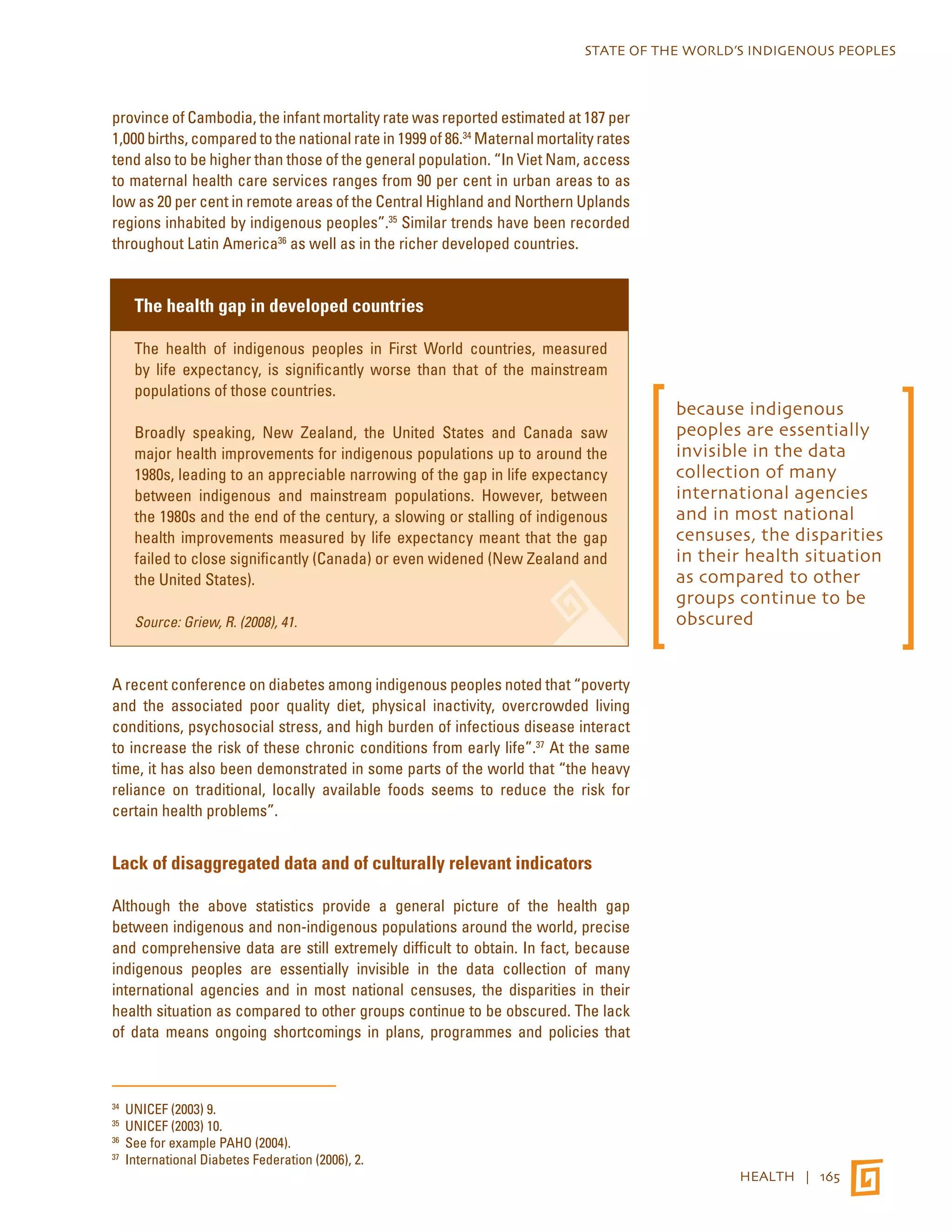
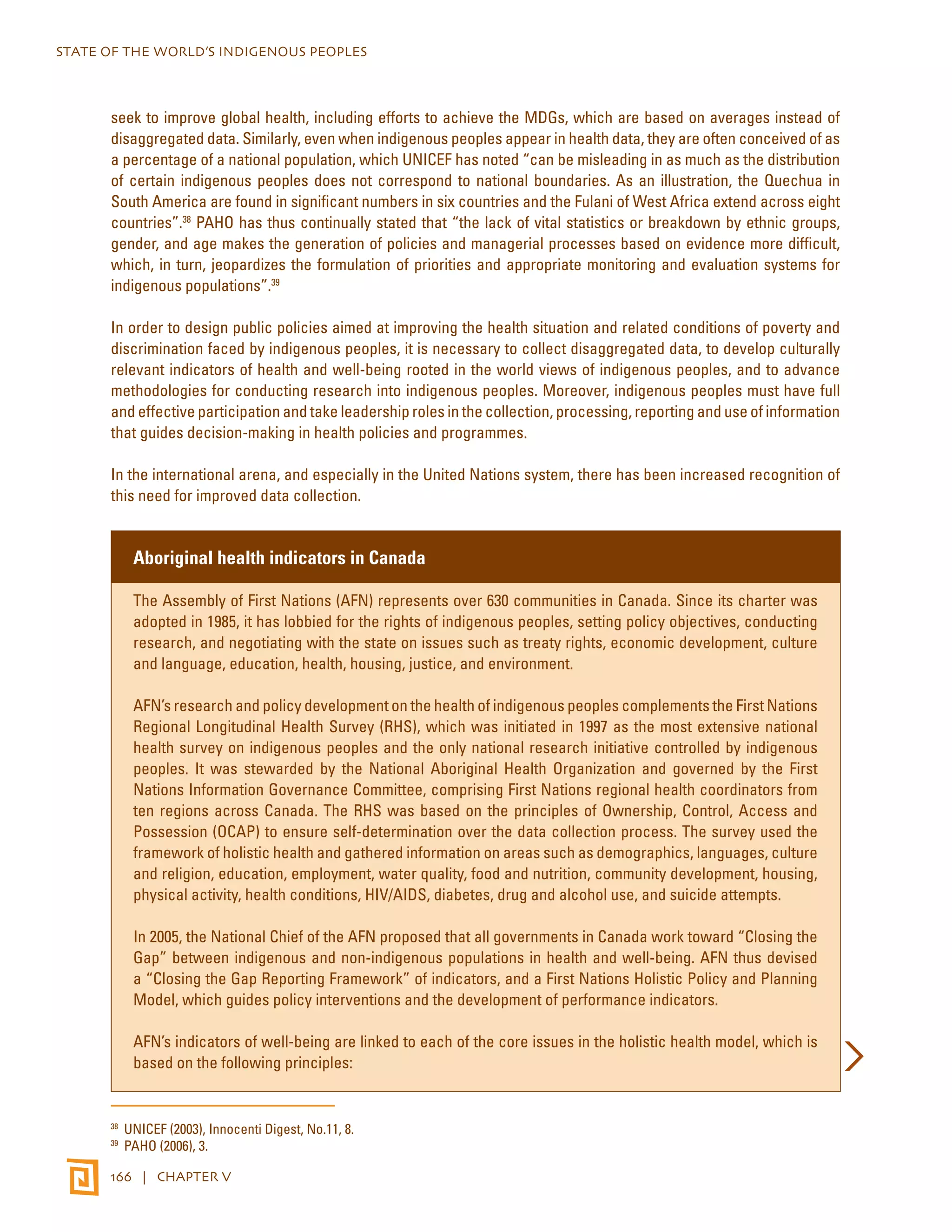
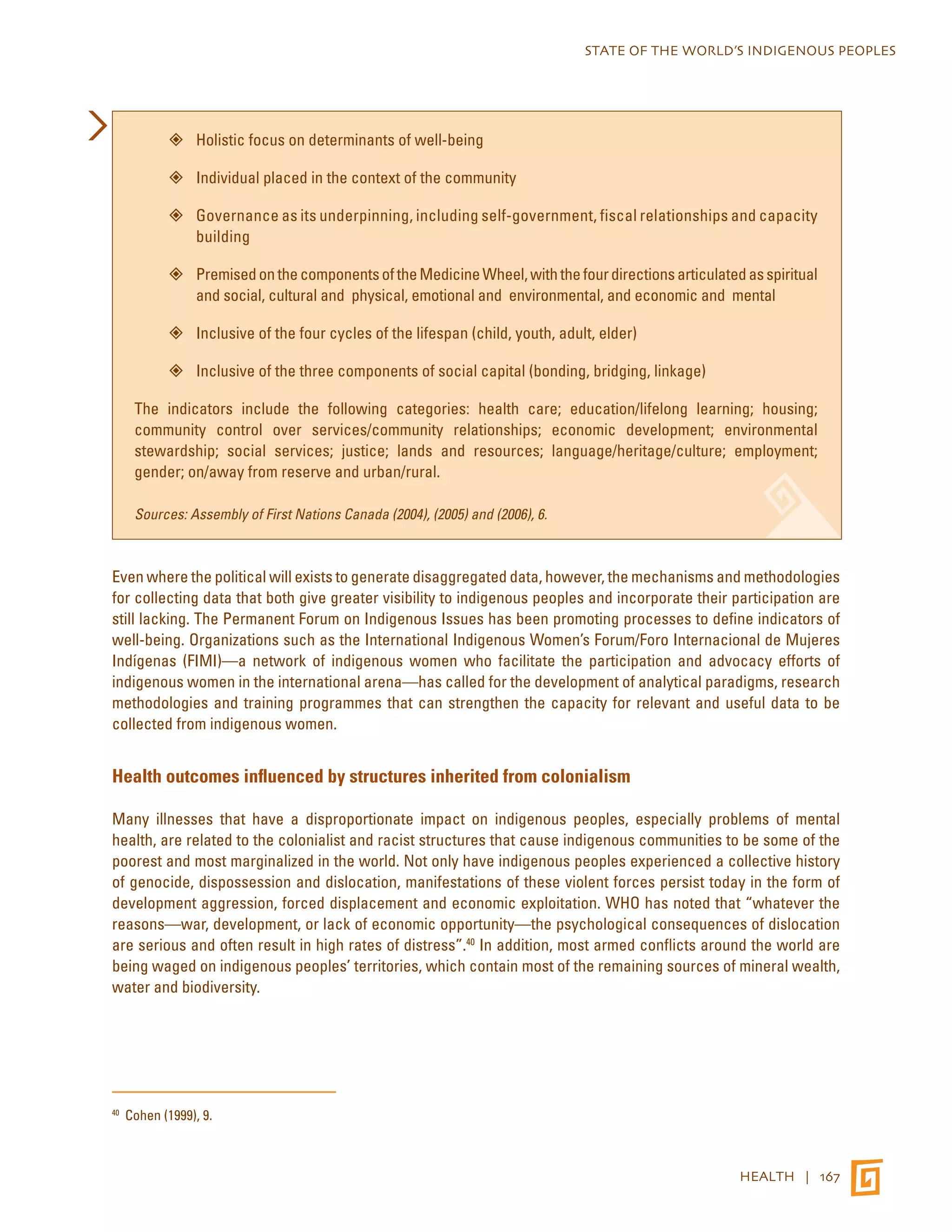
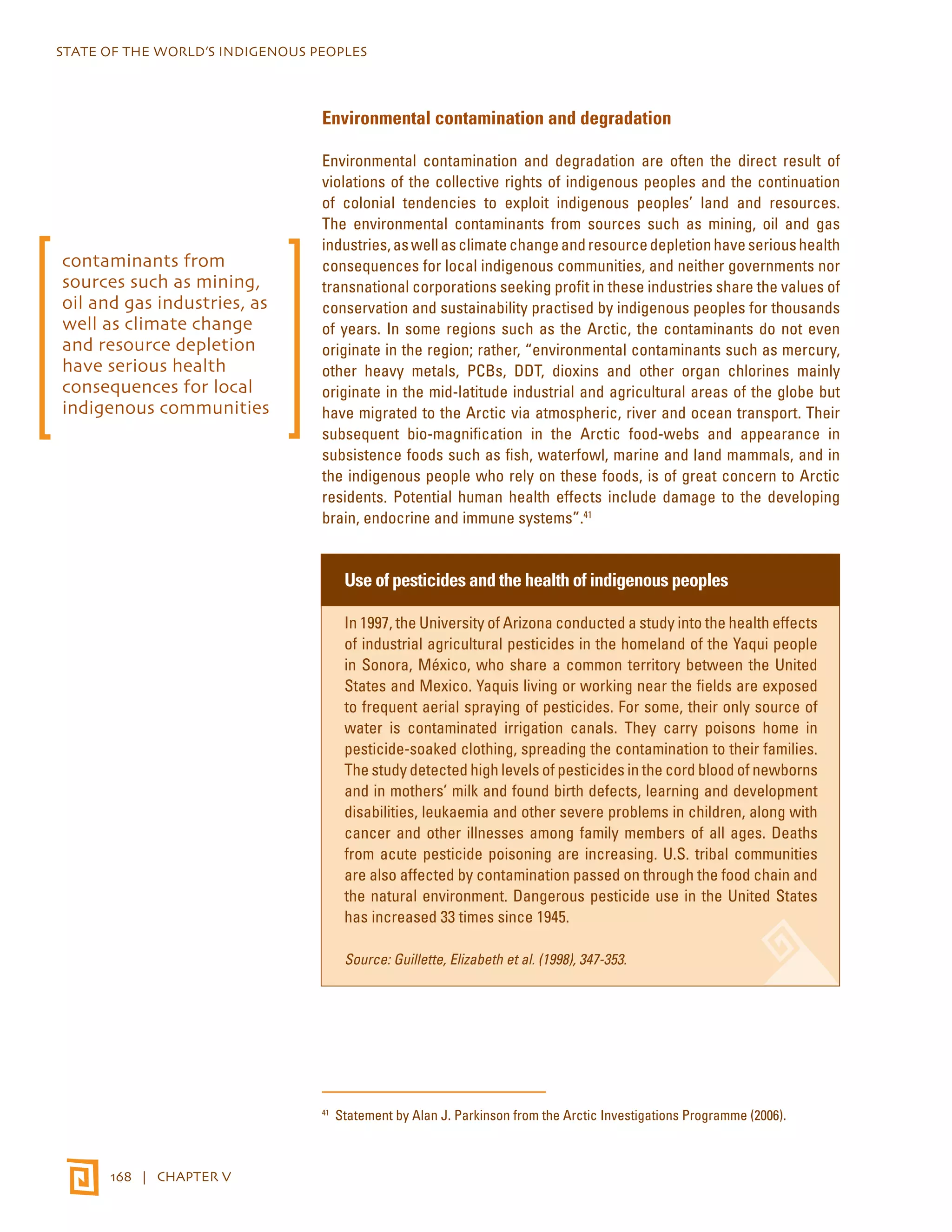
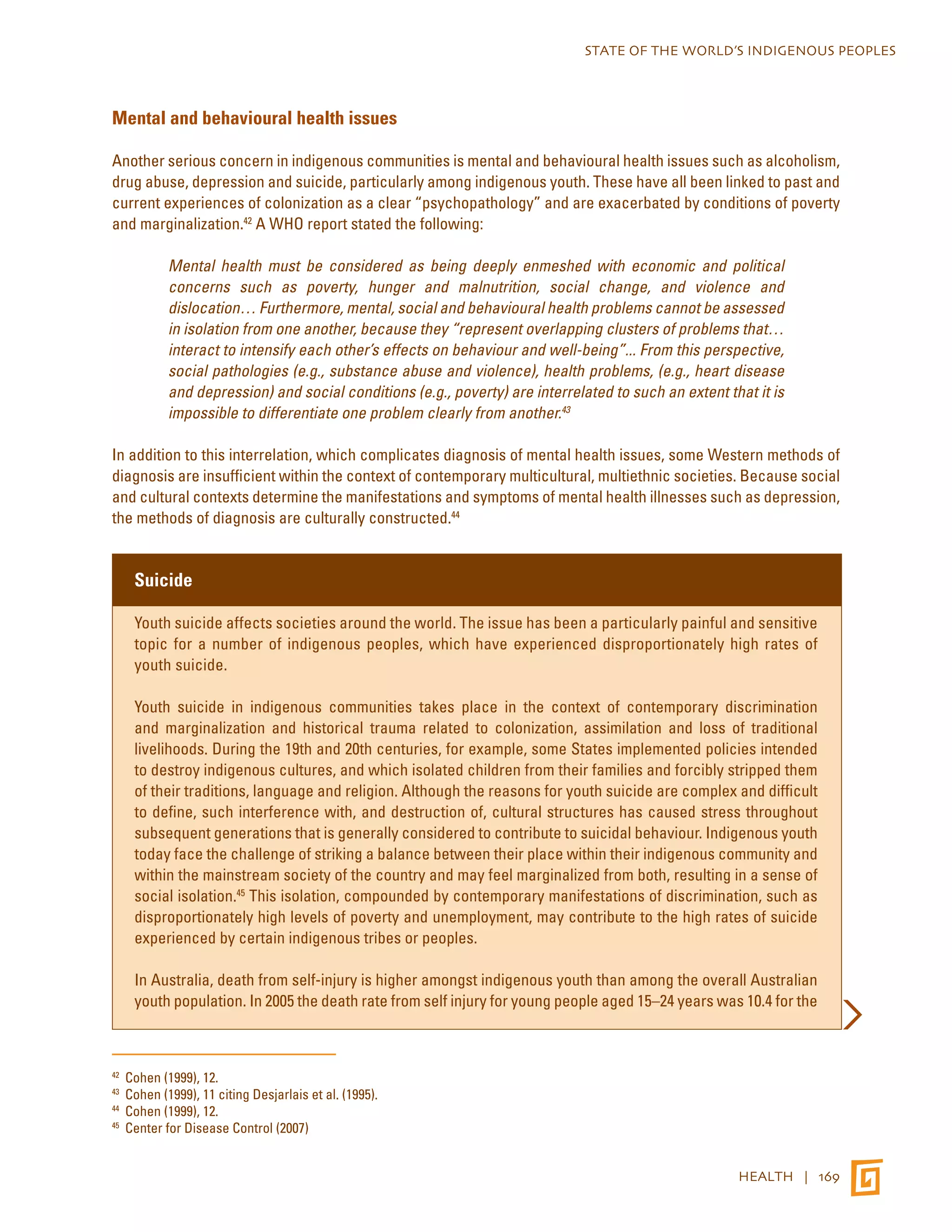
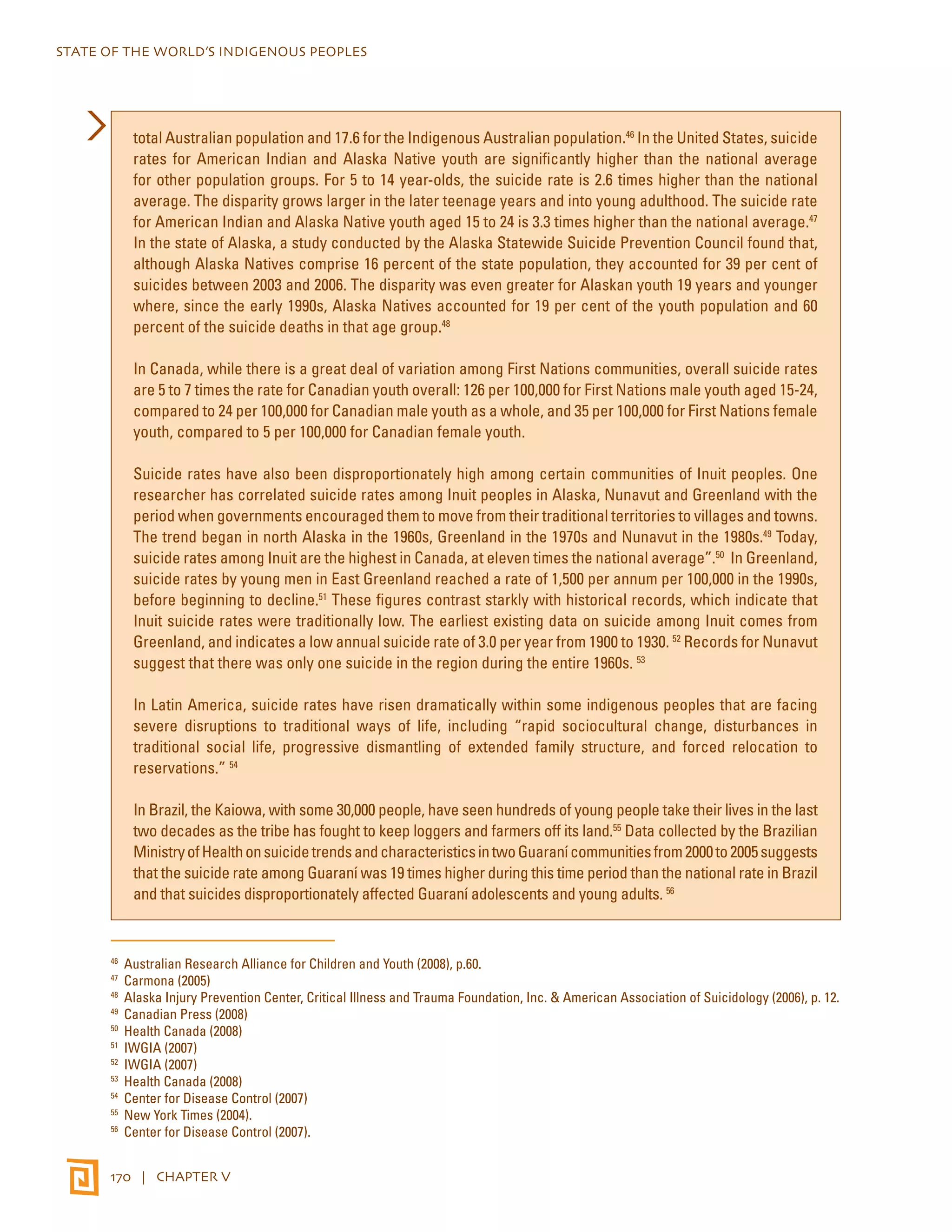
![STATE OF THE WORLD’S INDIGENOUS PEOPLES
In Colombia, at least 15 youth from the Embera, Wounaan, Katio and Chami peoples committed suicide
between 2003 and 2004. Given the tribes’ population of some 3,000 individuals, “the yearlong spate of
deaths adds up to a suicide rate of 500 per 100,000 people. The overall suicide rate in Colombia was 4.4
per 100,000 in 2003, according to government statistics.”57 The suicides took place at a time of extreme
change, during which settlers depleted the jungles of animals that the indigenous peoples once hunted,
forcing the once-nomadic Embera to form permanent communities and turn to farming. Their traditional
lives have also been greatly impacted by guerrilla and paramilitary activity.58
The problems faced by adolescents are often further compounded by the lack of resources available to
assist them. The Special Rapporteur on the right of everyone to the enjoyment of the highest attainable
standard of physical and mental health has reported discrimination in access to and treatment in, health
care and support services, stating that “[I]ndigenous populations are frequently ignored, with no specialist
development of psychiatric and support services despite acute needs that are manifest in increasing
suicide rates…”.59
The erosion of traditional resources and authority frustrates the ability of traditional governments to
make available the culturally appropriate services most needed by indigenous adolescents. This is
extremely significant as suicide rates have been found to be negatively associated with integration of
traditional culture in several Native American peoples and degree of self-government among Native
Canadians.60 Similarly, although a study of suicide risk among indigenous Sami in Arctic Norway found
an increased risk of suicide for the Sami in comparison with the rural population of Arctic Norway as
a whole, it found no increased risk of suicide among reindeer herding Sami males. This finding may be
due to the significance of reindeer herding as a traditional, culturally significant occupation among
the Sami in Norway. Today, Sami in Norway who are involved in reindeer herding occupy a unique
cultural position and have a strong ethnic identity and high status within the Sami culture.61 In this
regard, improvements in the enjoyment of human rights by indigenous peoples, including the rights to
self-governance, culture and land rights, and improved access to resources and reduction in poverty
may be expected to decrease the disproportionately high youth suicide rates faced by some indigenous
tribes or communities.
At the same time, some mental health problems may be perceived differently in indigenous communities that
have a collective sense of loss of their cultures, territories, or social structures. One study on alcoholism and
depression in an indigenous community in the United States noted that “depression… can be a positive expression
of belonging.… To be sad is to be aware of human interdependence and the gravity of historical, tribal, familial
and personal loss. To be depressed, and that includes tearfulness and sleep and appetite disturbances, is to
demonstrate maturity and connectedness to the Indian world”.62
HEALTH | 171
57 New York Times (2004).
58 New York Times (2004).
59 Hunt (2005), para 12.
60 Silviken, Haldorsen & Kvernmo (2006)
61 Silviken, Haldorsen & Kvernmo (2006)
62 Cohen (1999), 14, quoting O’Nell (1993).](https://image.slidesharecdn.com/sowipweb-141112214427-conversion-gate02/75/Sowip-web-182-2048.jpg)
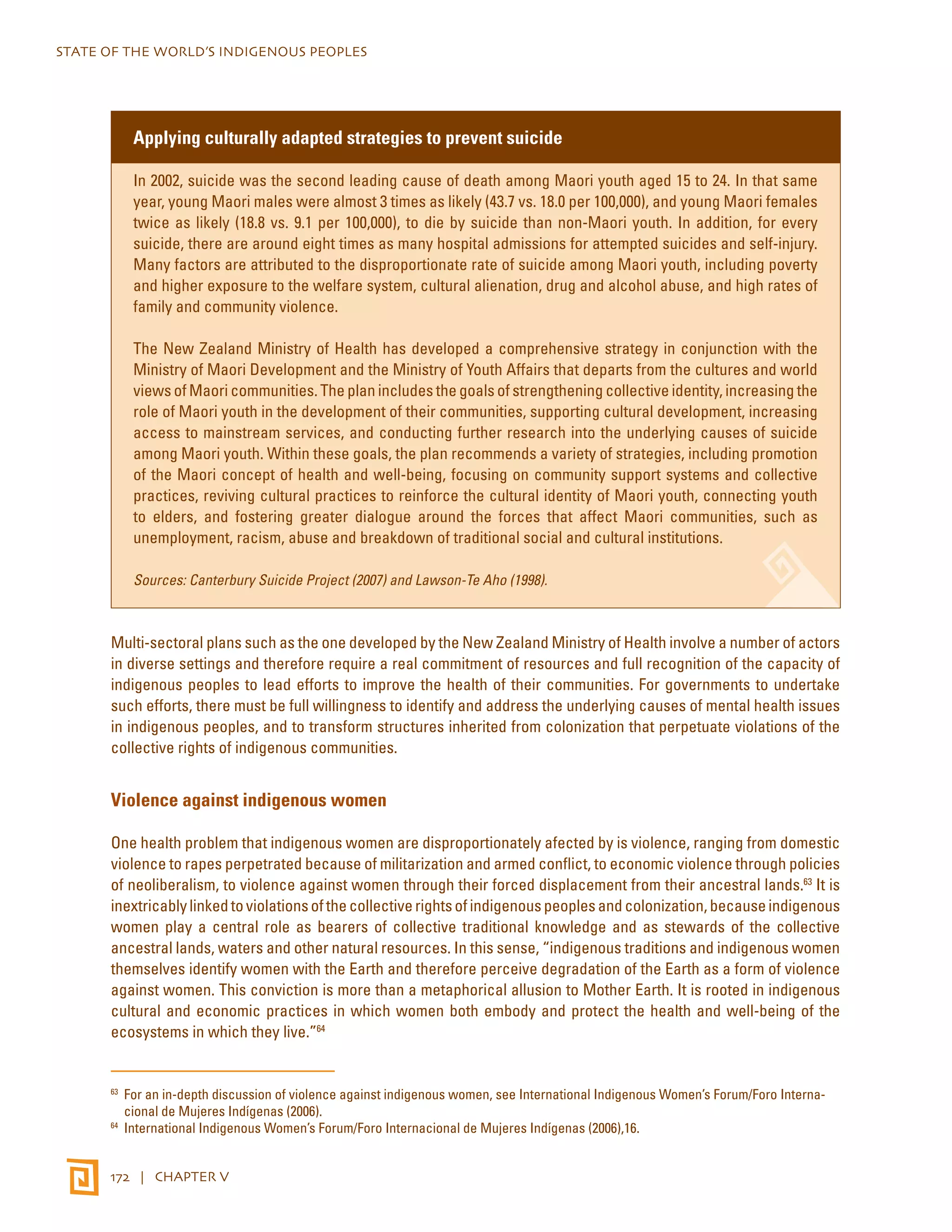
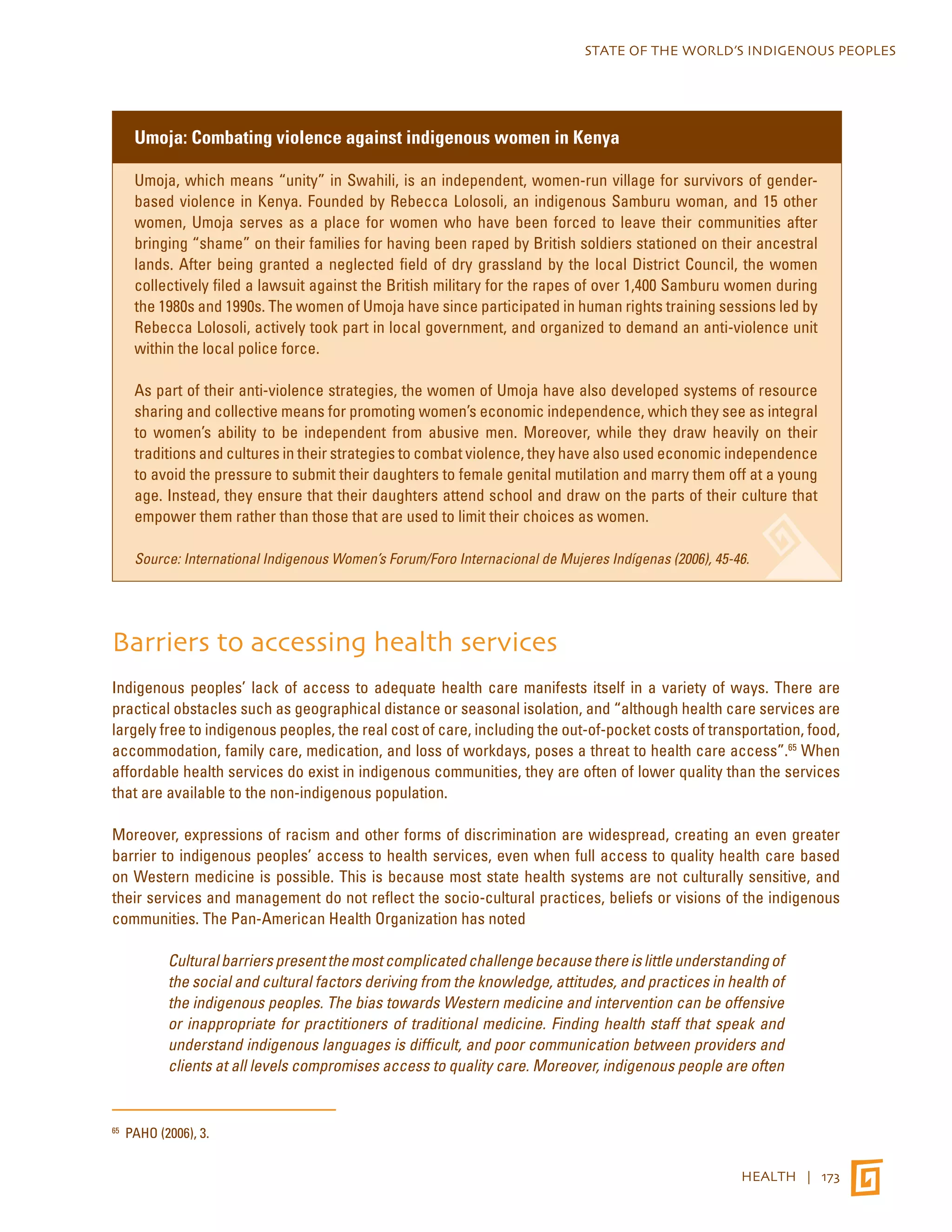
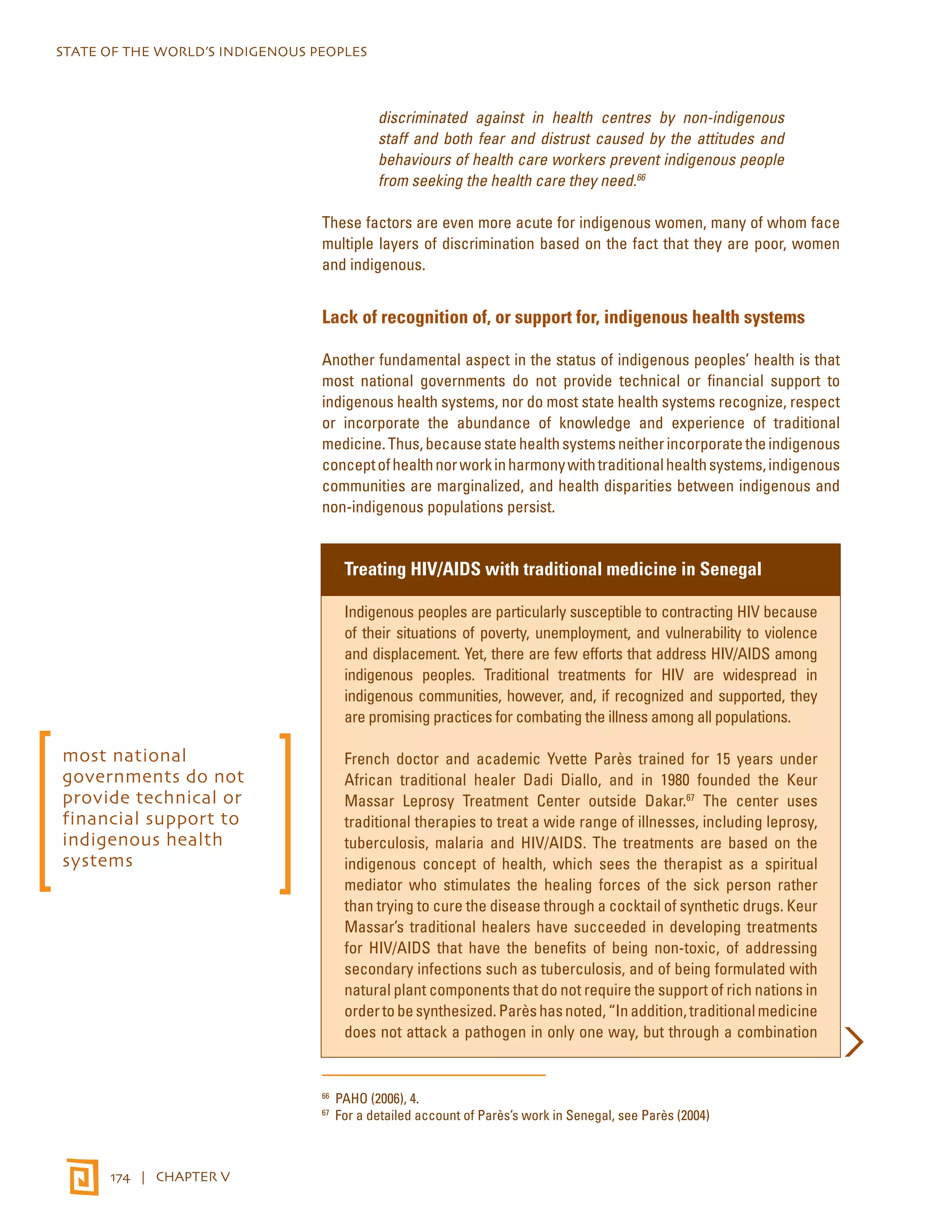
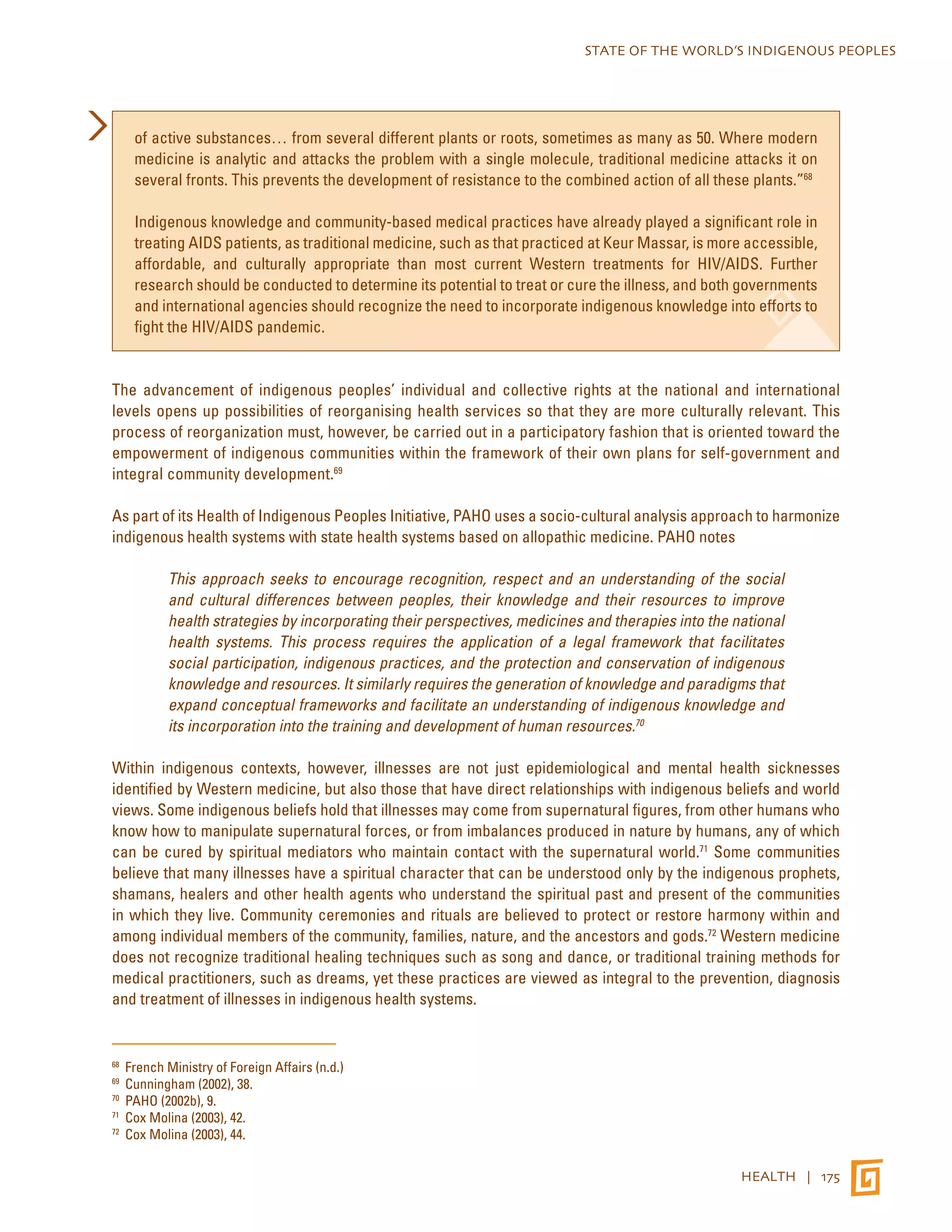
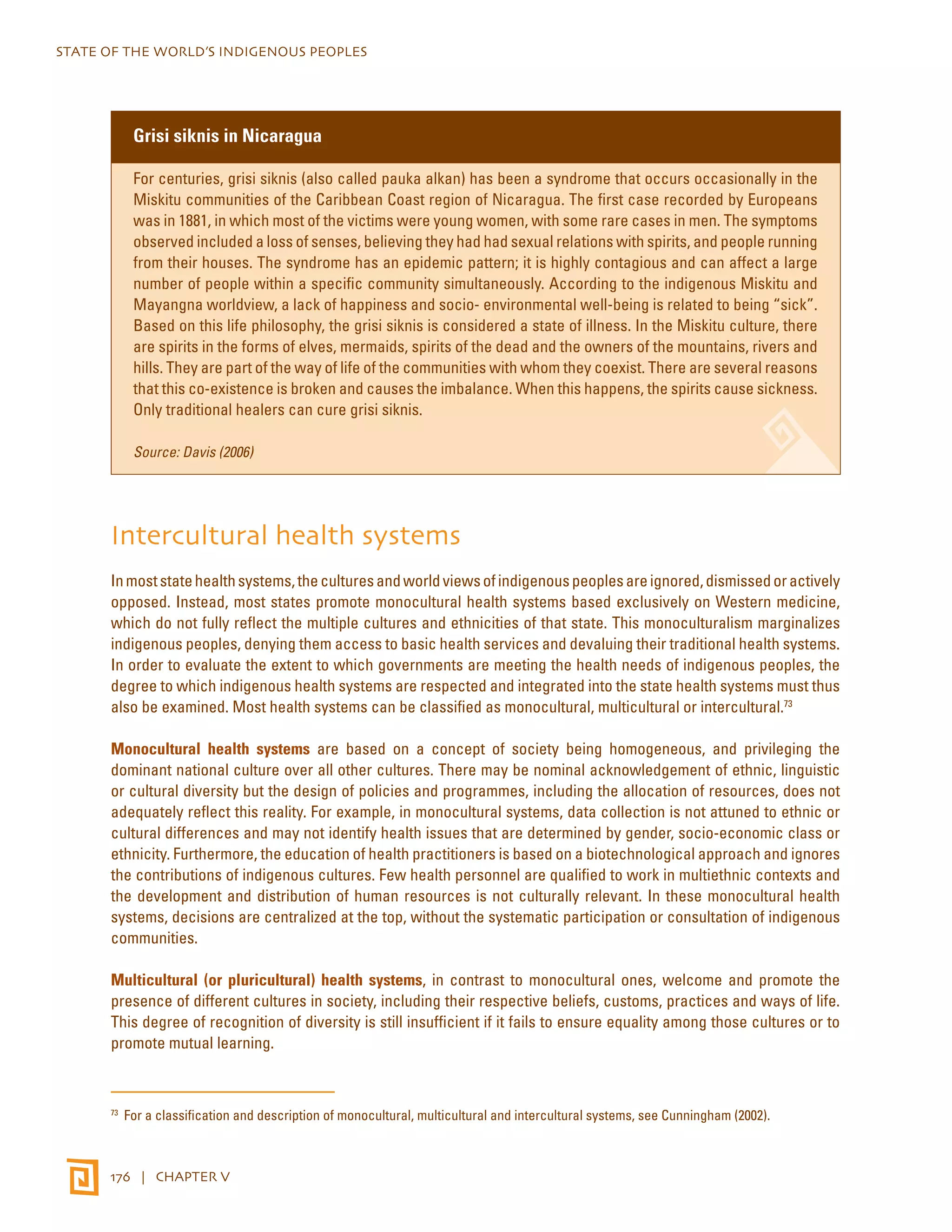

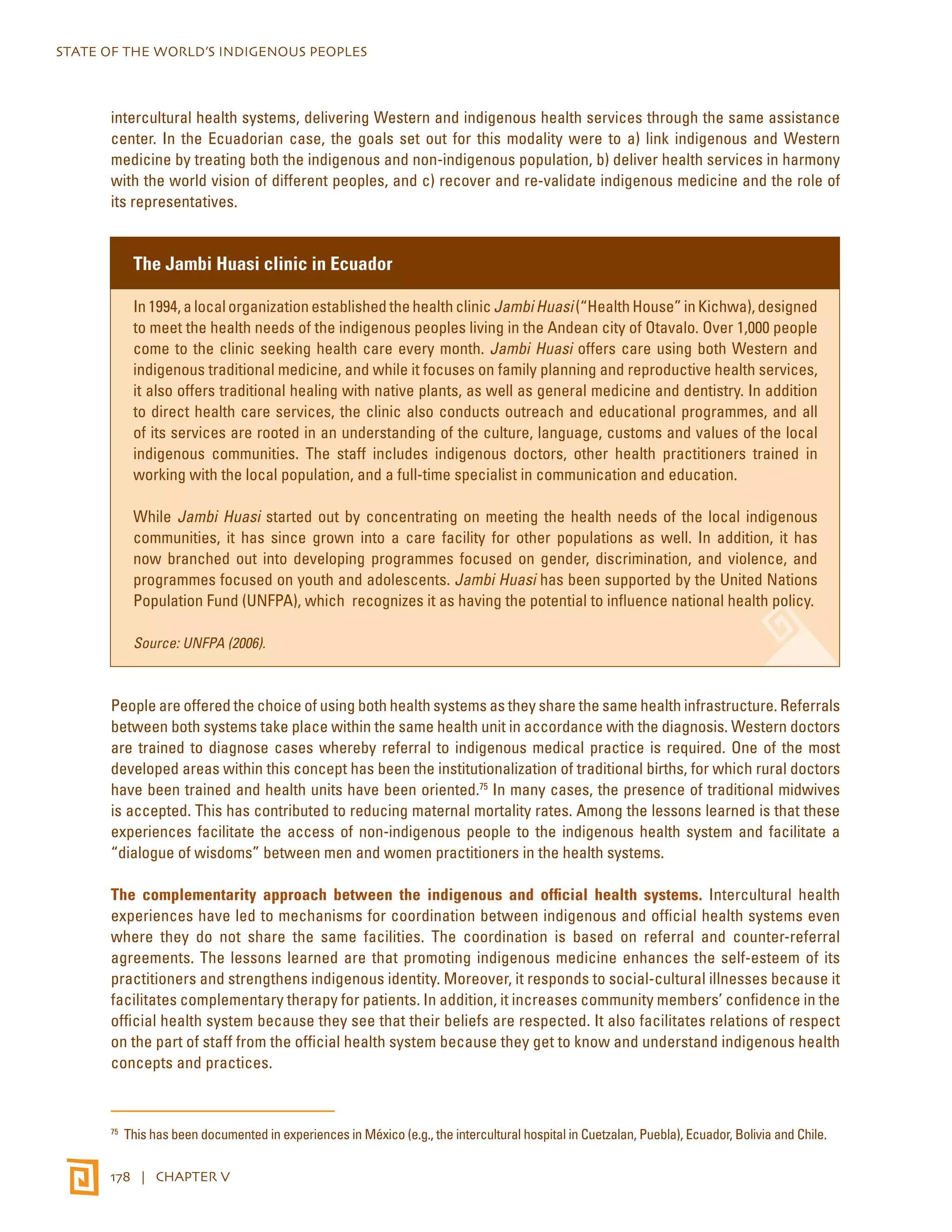
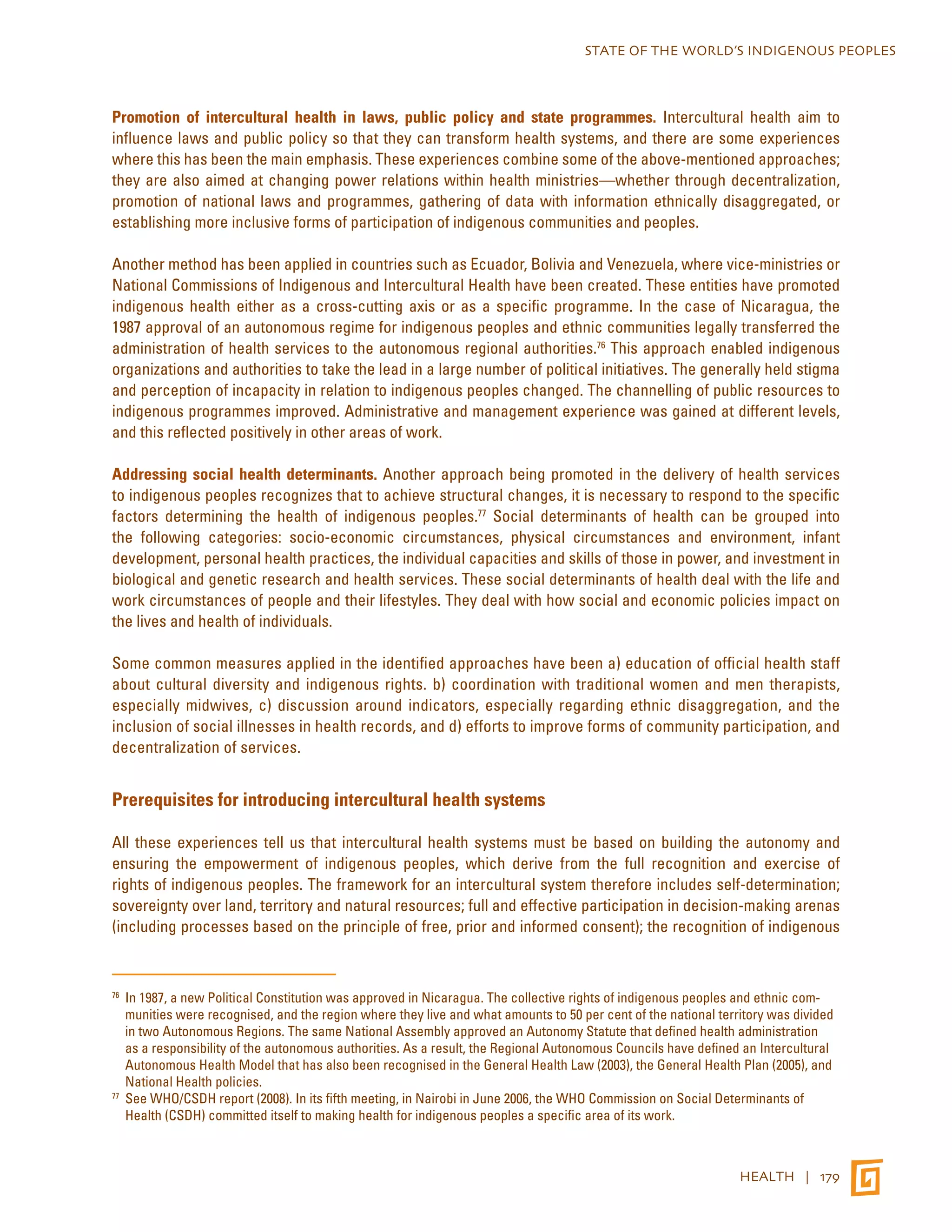
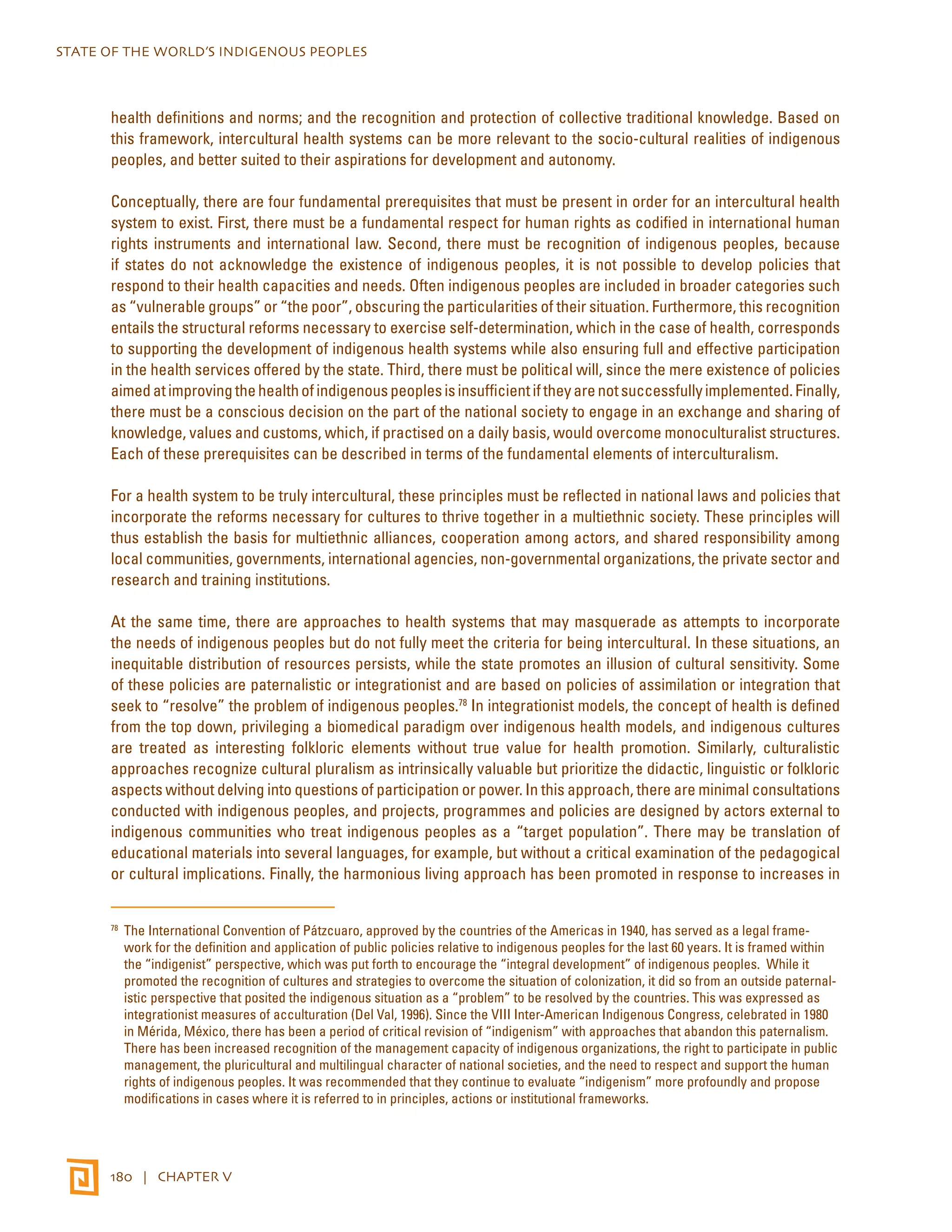
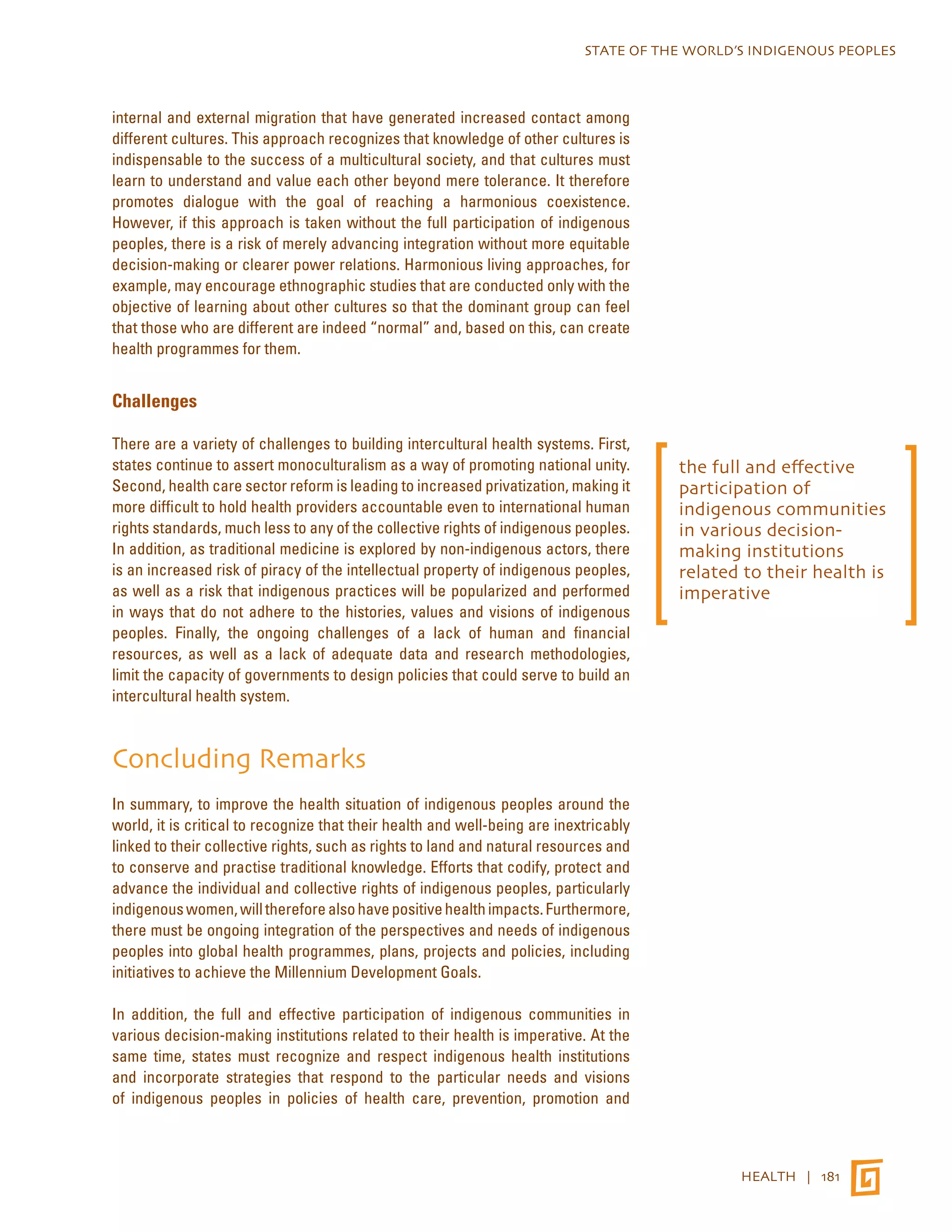
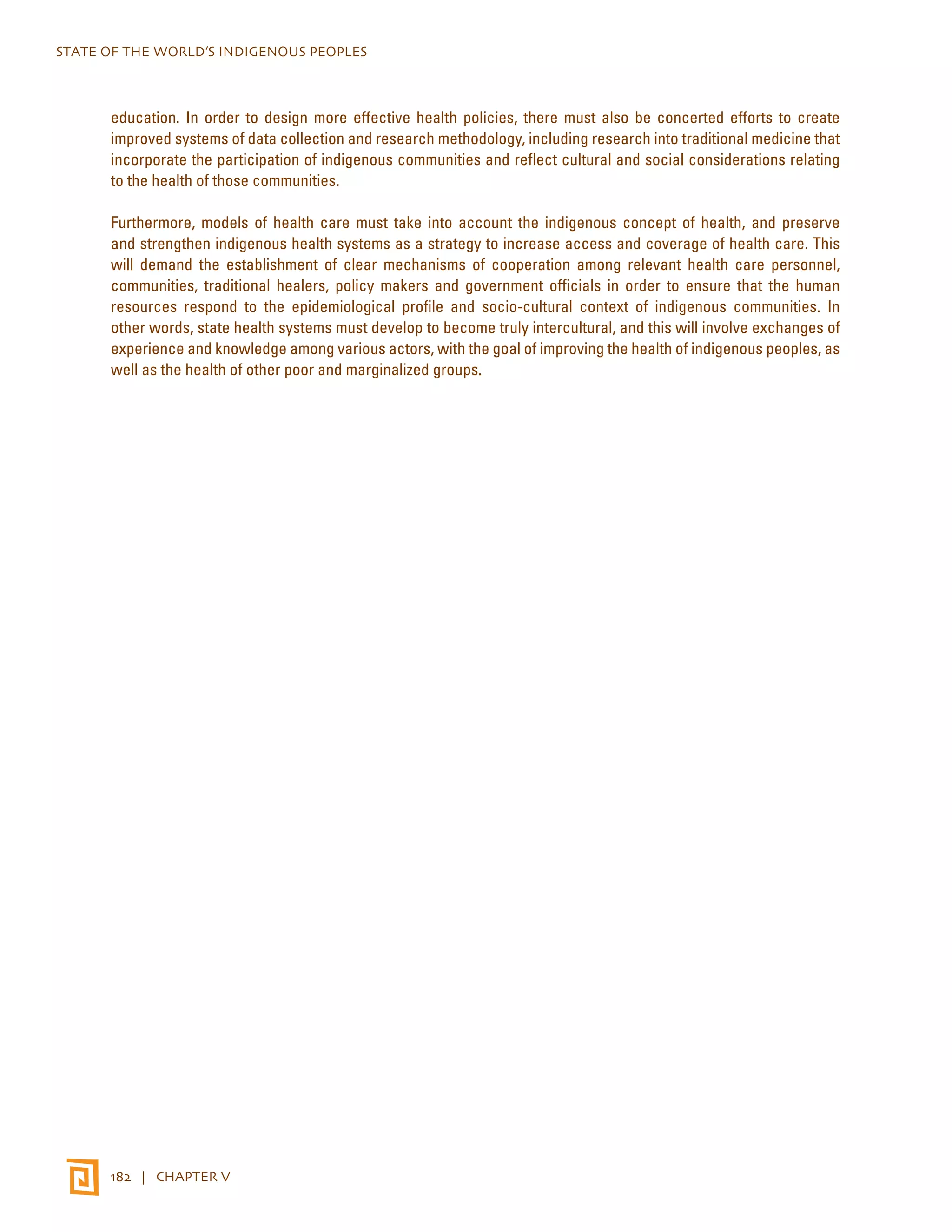
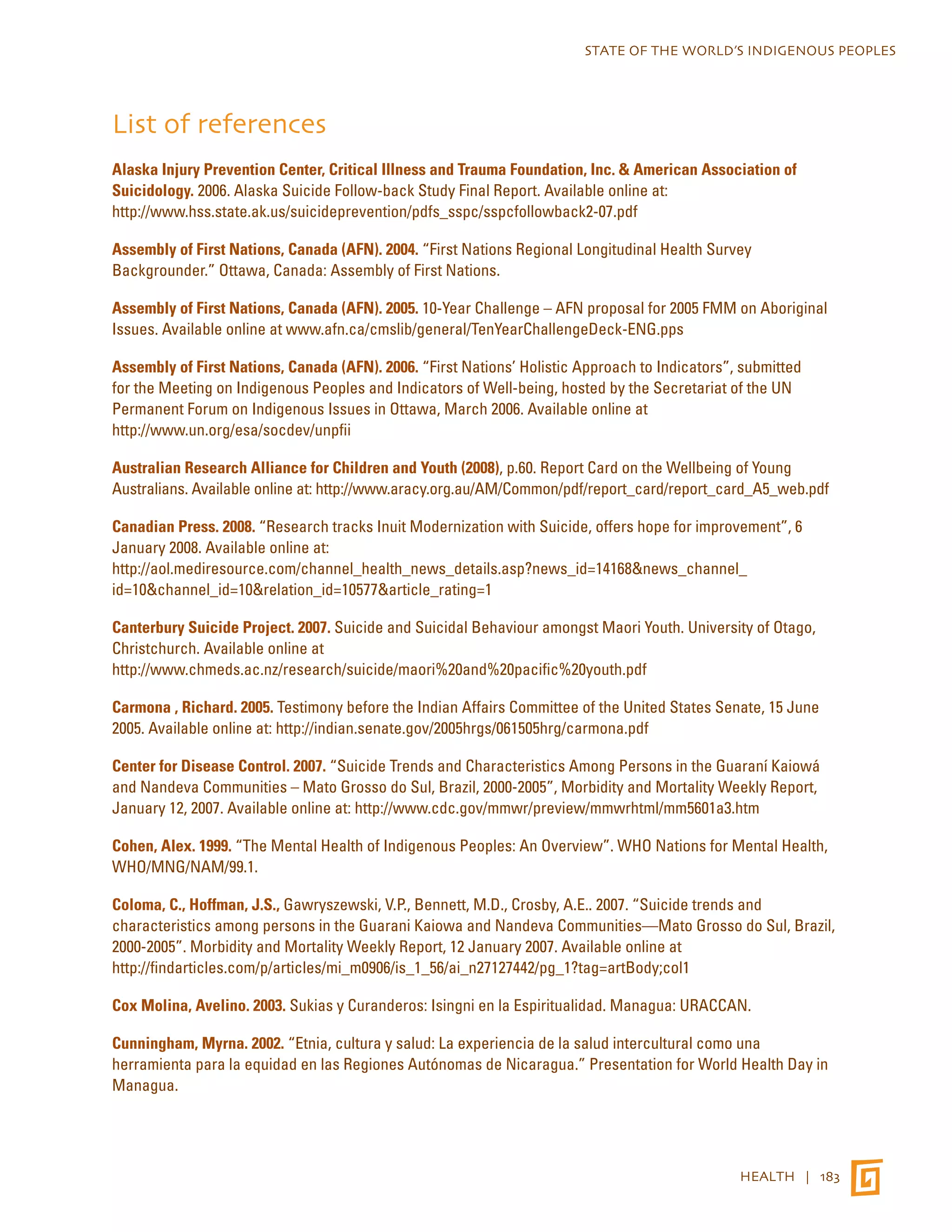
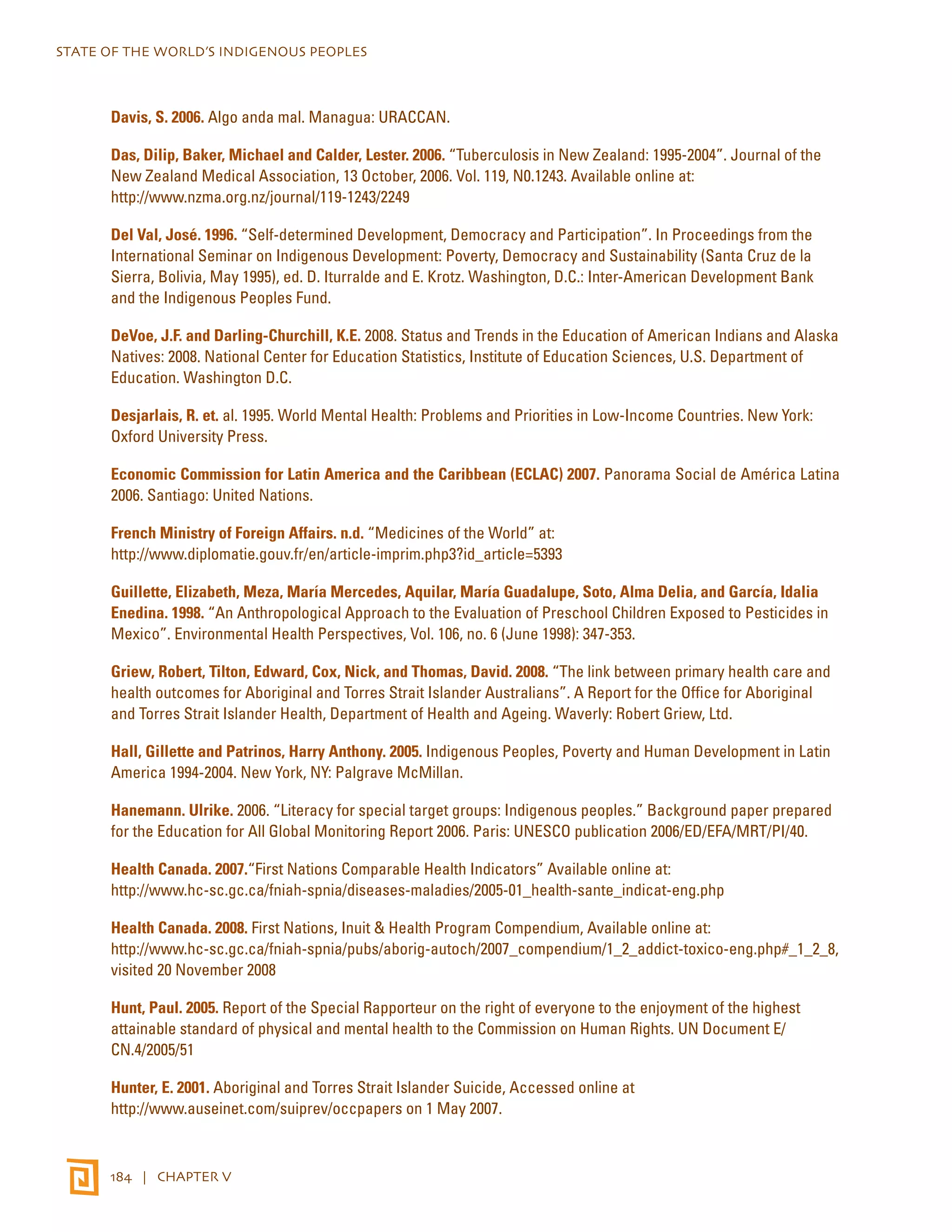
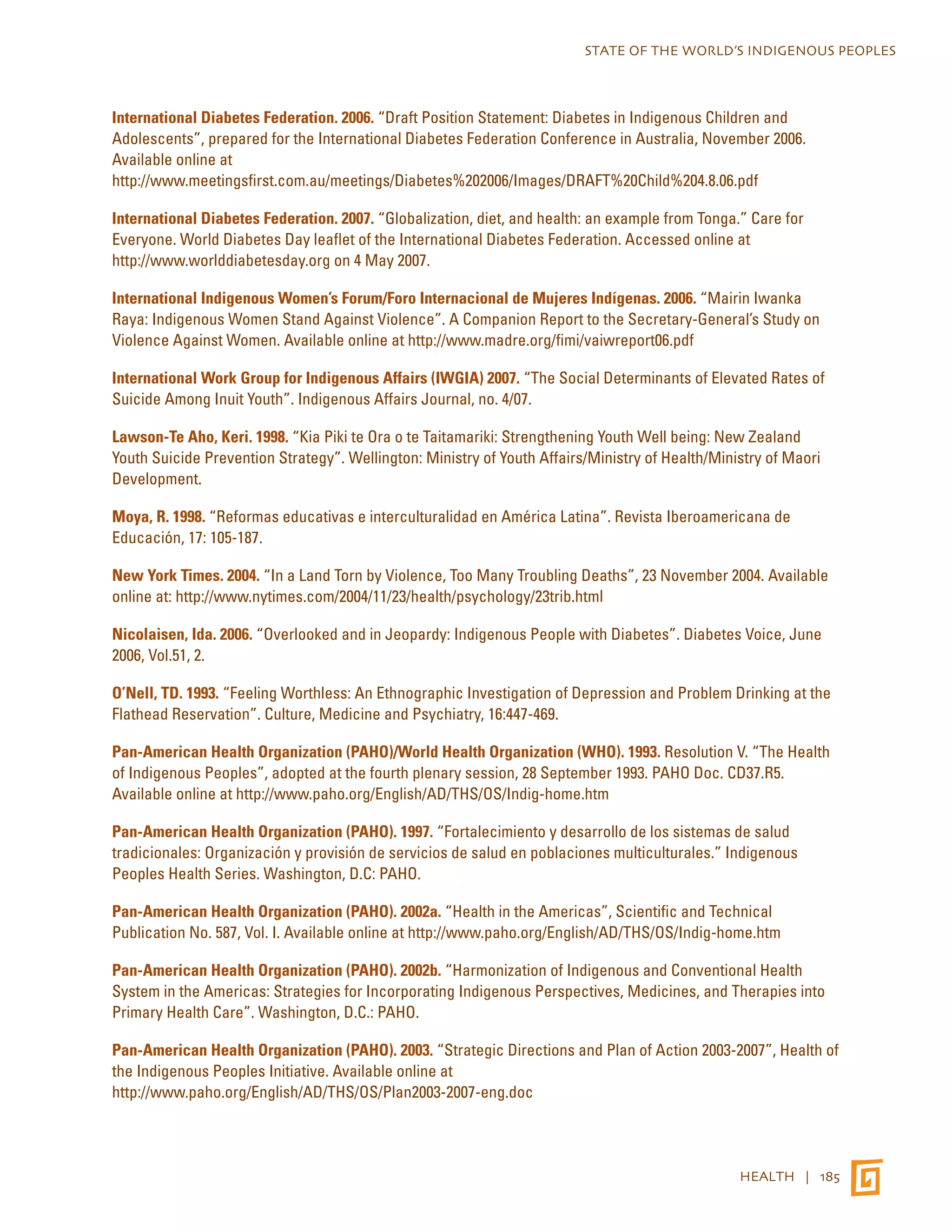
![STATE OF THE WORLD’S INDIGENOUS PEOPLES
Pan-American Health Organization (PAHO). 2004. “Healing our Spirit Worldwide” Newsletter for Indigenous
People, Edition No.2, May 2004.
Pan-American Health Organization (PAHO). 2006. “Health of the Indigenous Population in the Americas.” 47th
Session of the Directing Council, September 2006. PAHO Doc. CD47.R13. Available online at
http://www.paho.org/English/AD/THS/OS/Indig-home.htm
Pan-American Health Organization (PAHO). 2007. Health in the Americas, 2007. Volume I – Regional Health.
PAHO. Available online at http://www.paho.org/English/DD/PUB/csp27-stp622-e.pdf
Parès, Yvette. 2004. La Médecine africaine, une efficacité étonnante, témoignage d’une pionnière, [African
medicine, an astonishing efficacy, the account of a pioneer.] Barret-sur-Méoug: Editions Yves Michel.
Parkinson, Alan J. 2006. Statement at a joint hearing of the Committee on Commerce and Committee on Foreign
Relations of the US Senate by A.J. Parkinson from the Arctic Investigations Program, Centers for Disease
Control and Prevention, United States Department of Health and Human Services, on the Arctic Human Health
Initiative, 26 September, 2006. See: http://www.dhhs.gov/asl/testify/t060926.html
Public Health Agency of Canada. 2006. Tuberculosis in Canada 2006, Ottawa: Public Health Agency of Canada.
Available online at http://www.phac-aspc.gc.ca/publicat/2007/tbcanpre06/pdf/tbpre2006_e.pdf
Silviksen, Anne, T. Haldorsen & KS Kvernmo. 2006. “Suicide among Indigenosu Sami in Arctic Norway, 1970-
1988”, European Journal of Epidemiology No.9 September 2006.
Skifte, Turid Bjarnason. 2004. “Tubeculosis in Greenland – Still a problem to bear in mind: development and
strategy”. International Journal of Circumpolar Health 2004; 63 Suppl 2: 225-9
Statistics Canada. 2006. Aboriginal Peoples Highlight Tables, 2006 Census.
Available online at
http://www12.statcan.ca/english/census06/data/highlights/Aboriginal/pages/Page.cfm?Lang=E&Geo=PR&Code
=01&Table=2&Data=Count&Sex=1&Abor=5&StartRec=1&Sort=2&Display=Page
The Indigenous World 2004. 2004. Copenhagen: IWGIA. Available online at http://www.iwgia.org
The New York Times. 2004. “In a land torn by violence, too many troubling deaths”. 23 November 2004.
Trewin, D. & Madden, R. 2005. The Health and Welfare of Australia´s Aboriginal and Torres Strait Islander
Peoples. Canberra: Australian Bureau of Statistics and Australian Institute of Health and Welfare.
UNICEF. 2003. “Ensuring the Rights of Indigenous Children”. Innocenti Digest no. 11. Florence, Italy: UNICEF
Innocenti Research Centre.
United Nations Organization. 2007. Declaration on the Rights of Indigenous Peoples. UN Doc. A/61/L.67,
September 2007. Available online at UNPFII Web site http://www.un.org/esa/socdev/unpfii
United Nations Populations Fund (UNFPA). 2006. “Working from within and from without: Jambi Huasi – a model
for community empowerment”. Available online at http://www.unfpa.org/news/news.cfm?ID=742
United Nations Permanent Forum on Indigenous Issues (UNPFII). 2005. Report of the Workshop on
Methodologies Regarding Free, Prior and Informed Consent and Indigenous Peoples. UNPFII Fourth Session.
UN Doc. E/C.19/2005/1. Available online at http://www.un.org/esa/socdev/unpfii
186 | CHAPTER V](https://image.slidesharecdn.com/sowipweb-141112214427-conversion-gate02/75/Sowip-web-197-2048.jpg)
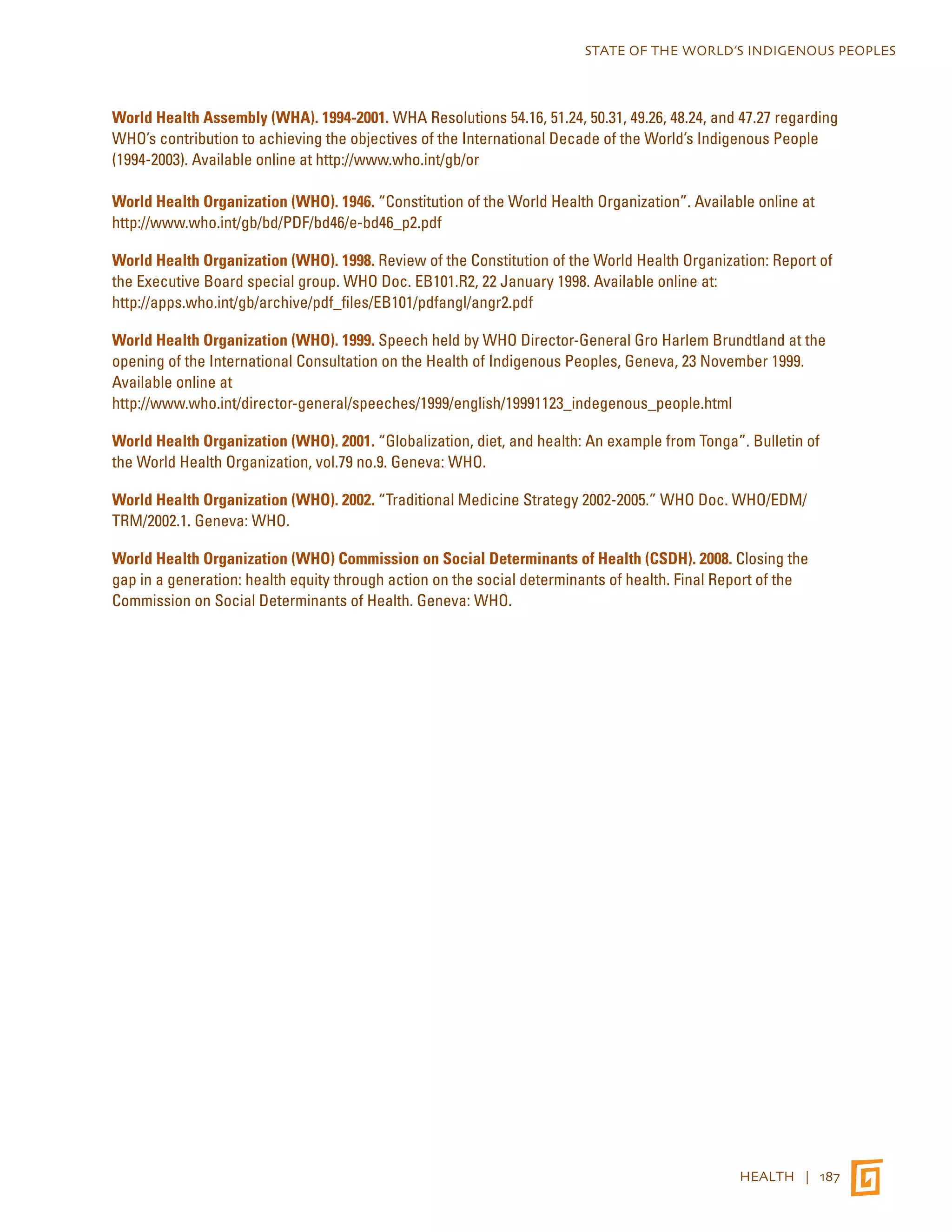

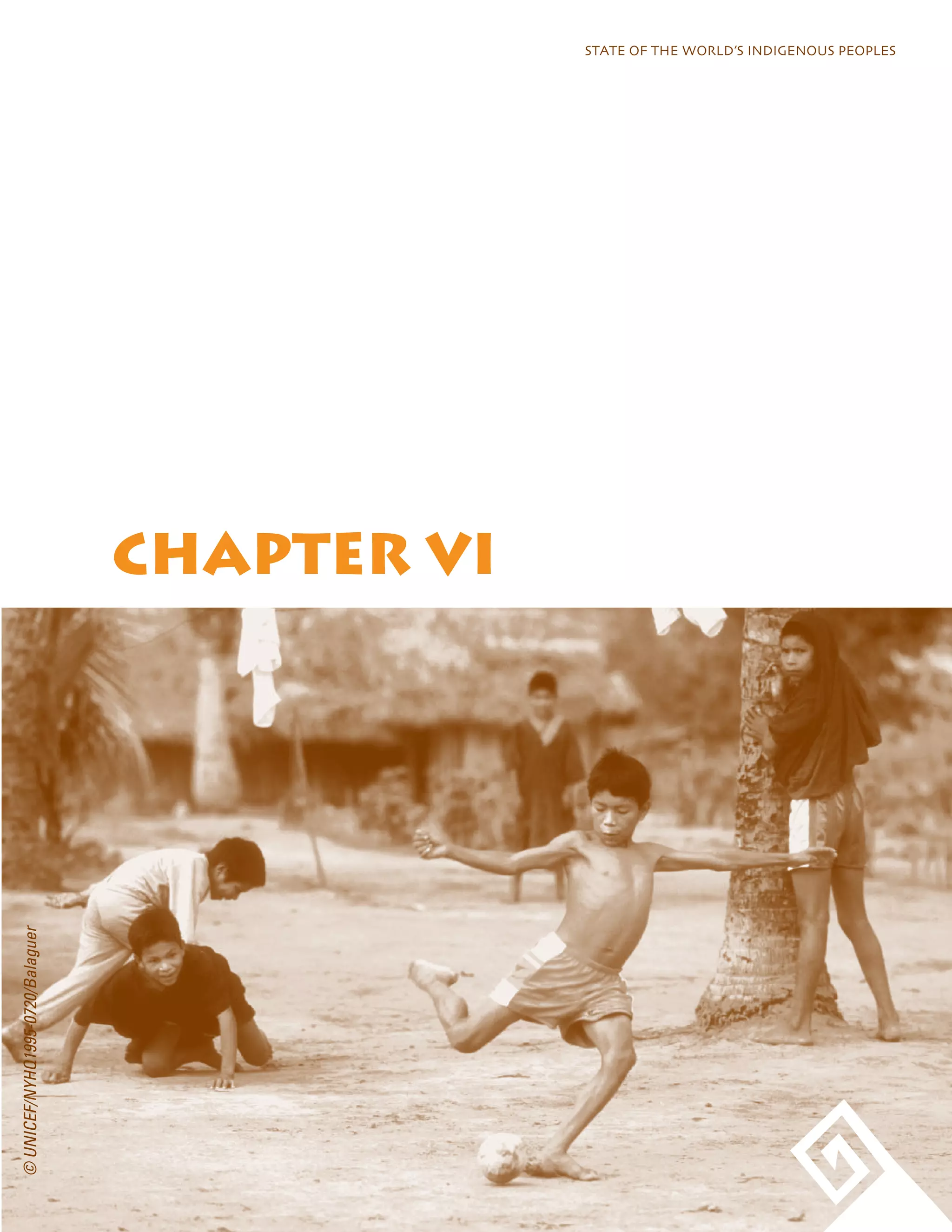
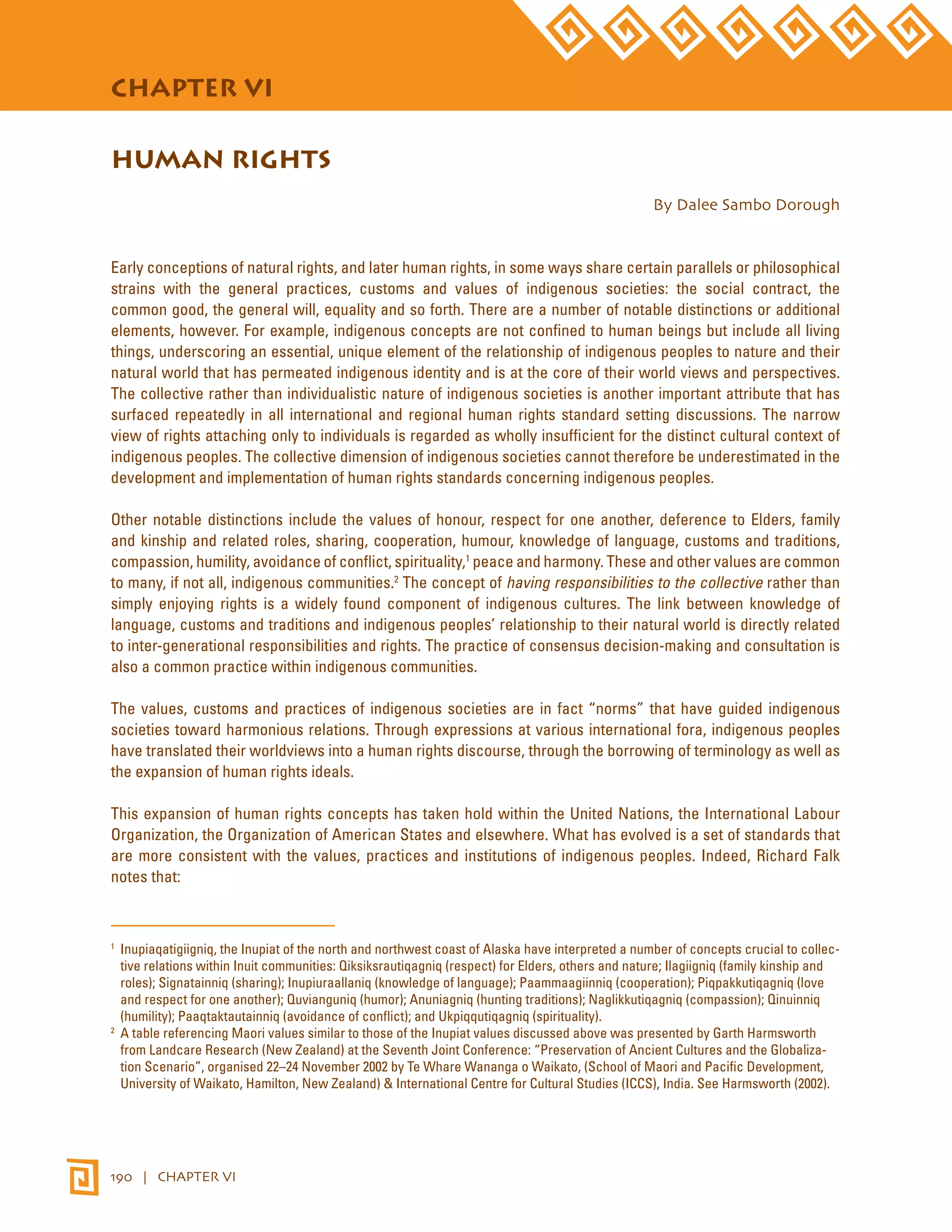
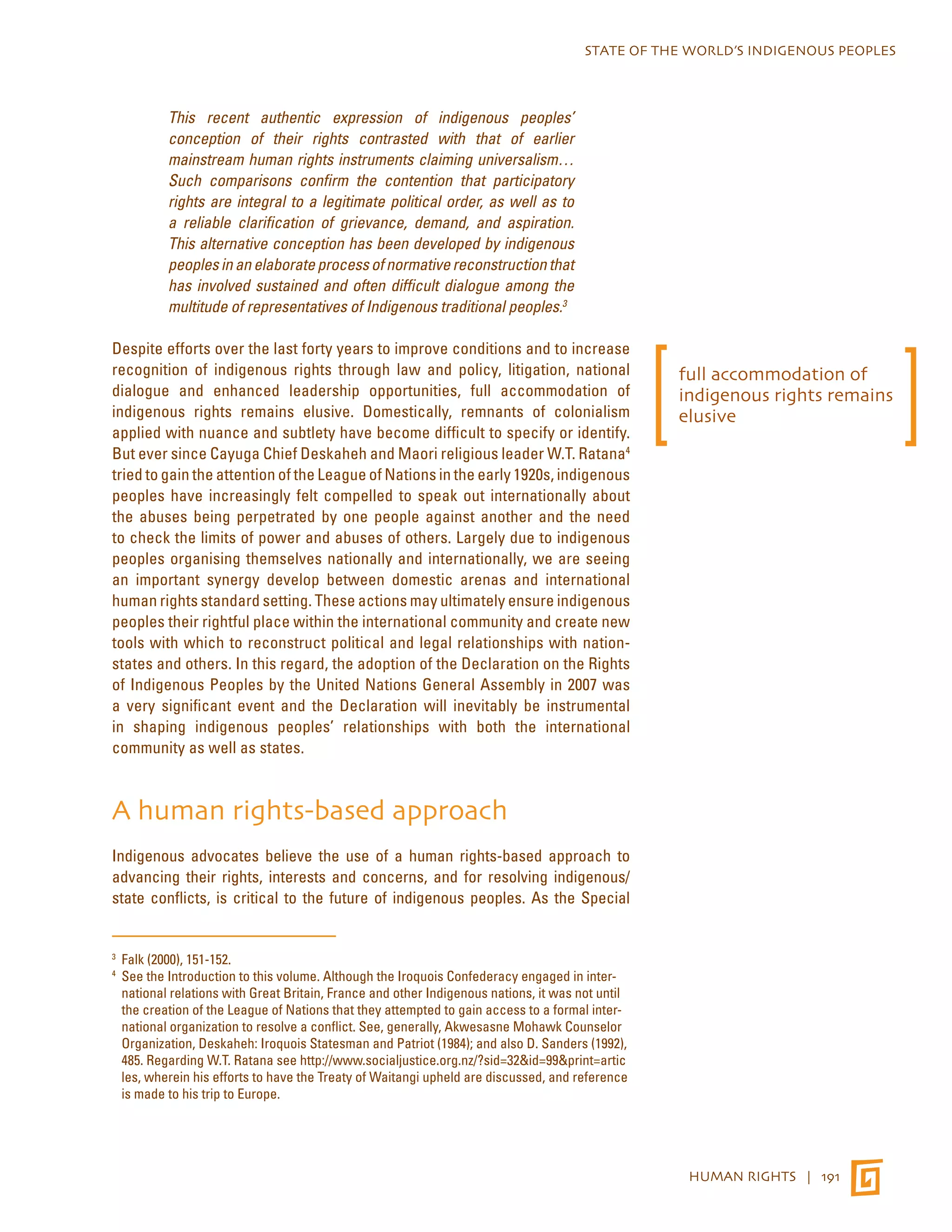

![STATE OF THE WORLD’S INDIGENOUS PEOPLES
norm of international law. It is therefore disconcerting that not only one but a range of state proposals were being
made in relation to the language concerning self-determination of indigenous peoples in the United Nations
Declaration on the Rights of Indigenous Peoples.11
Self-determination is also an integral part of democracy. The right to self-determination has been described as
“the oldest aspect of the democratic entitlement”. As international law Professor Thomas Franck explains:
Self-determination is the oldest aspect of the democratic entitlement... Self-determination
postulates the right of a people in an established territory to determine its collective political
destiny in a democratic fashion and is therefore at the core of the democratic entitlement.12
Fortunately, indigenous peoples’ views prevailed on this matter at the United Nations. The provisions of the UN
Declaration, when read in context, ensure consistency with international law and the obligations of UN Member
States to promote and protect human rights for all, including indigenous peoples.
HUMAN RIGHTS | 193
The inter-related, interdependent and indivisible nature of human rights
The authors of the Universal Declaration of Human Rights clearly recognized the interrelatedness of human
rights in this hallowed text by including reference to civil, political, economic, social and cultural rights. In
addition, those drafters of the International Covenants who argued for a single covenant understood the
importance of the interrelationship of the basic human rights and freedoms that form the International Covenant
on Civil and Political Rights and the International Covenant on Economic, Social and Cultural Rights.
Similarly, indigenous peoples recognize the interrelatedness and interdependence of all human rights.13 They
do so in large part because of their worldview of the holistic nature of their relations and inter-relationships
with all other beings and all living things. From their earliest interventions at the UN Working Group on
Indigenous Populations (WGIP), indigenous peoples have seen the text of the UN Declaration on the Rights of
Indigenous Peoples as a whole and have affirmed the view that human rights are interrelated, interdependent
and indivisible.14
11 The Declaration on the Rights of Indigenous Peoples was adopted by 143 votes in favor, 4 against and 11 abstentions (A/
RES/61/295).
12 Franck (1992), 52.
13 There are a range of indigenous interventions, Joint Submissions, etc., on this point. Specifically, see Geneva Declaration on
the Health and Survival of Indigenous Peoples, adopted at a 1999 World Health Organization health consultation; its preambular
paragraph 11 states: “Reminding the international agencies and other bodies of the UN system of their responsibility, and the
obligation of States, towards the promotion and protection of Indigenous Peoples' status and rights, and that a human rights ap-proach
to Indigenous health and survival is based on the said international responsibility and obligation to promote and protect
the universality, indivisibility, interdependence and interrelation of the rights of all peoples”. See WHO (1999).
14 Numerous statements have been made by indigenous peoples about the provisions of the Declaration being dependent upon
one another, and that the text must be read in context and as a whole. See, for example, the 1996 NGO Statement to the Com-mission
on Human Rights Working Group on the Draft Declaration (WGDD) stating that, “the Preamble was fundamental to the
overall draft because it lays the philosophical foundations and contextual clauses and it is responsive to the intent of the dec-laration”.
See WGDD (1997), para. 34. Also see the 1998 Statement of the Inuit Circumpolar Conference to WGDD stating that,
“[the Declaration] was an integrated document to be read as a whole…” See WGDD (1998), 8. Finally, see the Joint Submis-sion
on the Urgent Need to Improve the UN Standard-Setting Process on Indigenous Peoples’ Human Rights presented to the
Permanent Forum on Indigenous Issues, Fourth Session, in New York UNPFII (2004), para. 10.](https://image.slidesharecdn.com/sowipweb-141112214427-conversion-gate02/75/Sowip-web-204-2048.jpg)
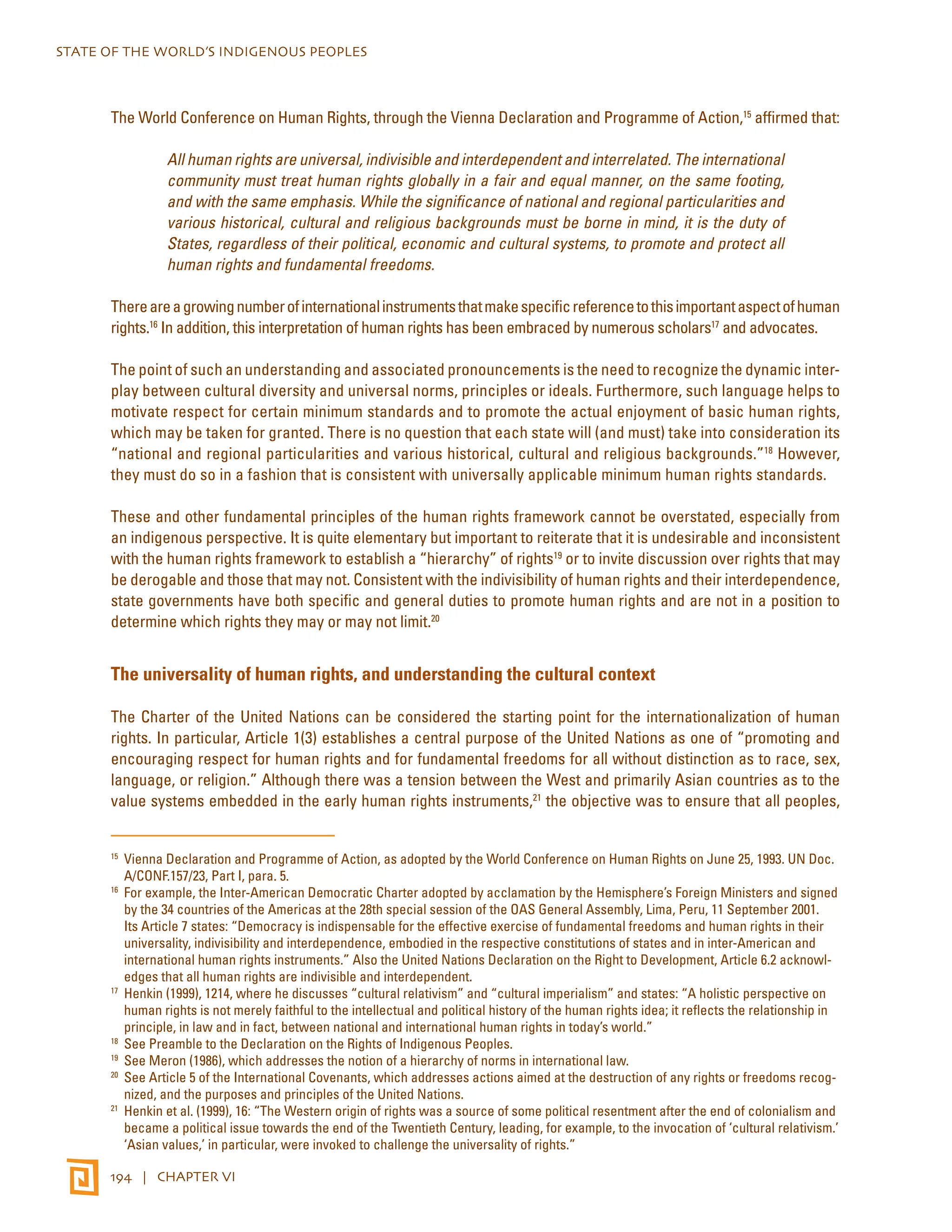
![STATE OF THE WORLD’S INDIGENOUS PEOPLES
HUMAN RIGHTS | 195
worldwide, enjoyed fundamental human rights. The purpose was not to replace
national constitutions or internal laws22 but rather to establish minimum
standards at the international level to be guaranteed by every state to its peoples.
Furthermore, there was no intention to create homogeneity.23
The concept of cultural context24 is significant in order to reinforce the positive
purposes of international human rights instruments. Dependent upon regional
or cultural particularities and conditions, the manifestation of every right will
require different weighting. This is also true in the context of the exercise of
collective or group rights and those of an individual nature.
The United Nations Charter itself recognizes that regional organs and
arrangements were anticipated by the United Nations25 for the accommodation
of regional differences. In fact, various regional arrangements have emerged
and have been complementary to the international human rights framework.
For example, the Organization of American States is a regional arrangement,
with a corresponding Inter-American Court of Human Rights and institutions to
“enforce” and monitor a variety of regional human rights instruments.26
Similar to these regional arrangements, the work of the United Nations in
preparing the Declaration on the Rights of Indigenous Peoples reinforced
the need for instruments and processes to accommodate cultural diversity.
Indeed, this was the ultimate objective of the UN Declaration. Such an
approach is a necessary element to ensure the effectiveness of universally
recognized human rights. Furthermore, cultural diversity is preferable to
cultural imperialism, which would be antithetical to the objective of respecting
and promoting international human rights.27
22 See also Mabo v. Queensland (1992), per Brennan J: “[I]nternational law is a legitimate
and important influence on the development of the common law, especially when inter-national
law declares the existence of universal human rights. A common law doctrine
founded on unjust discrimination in the enjoyment of civil and political rights demands
reconsideration.”
23 Falk (2000), 151-152: “[T]he interplay of different cultural and religious traditions sug-gests
the importance of multi-civilizational dialogue involving the participation of various
viewpoints, especially those with non-Western orientations. The world does not need a
wholesale merging of different cultures and civilizations; rather, it simply needs to foster
a new level of respect and reconciliation between and among its ever changing and ever
diverse peoples and nations.”
24 Steiner and Alston (1996), 374, which cites the American Anthropological Association’s
“Statement on Human Rights” (1947): “Today the problem is complicated by the fact that
the Declaration must be of worldwide applicability. It must embrace and recognize the
validity of many different ways of life.”
25 Charter of the United Nations, Chapter VIII.
26 Hannum (1990), chapters 5, 10 and 12.
27 Henkin et al. (1999), 107, quoting Donnelly (1989): “Cultural relativity is an undeniable fact;
moral rules and social institutions evidence an astonishing cultural and historical vari-ability.
The doctrine of cultural relativism holds that at least some such variations cannot
be legitimately criticised by outsiders. But if human rights are literally the rights everyone
has simply as a human being, they would seem to be universal by definition. How should
the competing claims of cultural relativism and universal human rights be reconciled? I
defend an approach that maintains the fundamental universality of human rights while
accommodating the historical and cultural particularity of human rights.”
ultimately, the balancing
of the universality of
human rights and the
accommodation of
distinct cultural contexts
are necessary to ensure
and maintain the rich
diversity of humankind](https://image.slidesharecdn.com/sowipweb-141112214427-conversion-gate02/75/Sowip-web-206-2048.jpg)
![STATE OF THE WORLD’S INDIGENOUS PEOPLES
Indigenous peoples recognize that there is no room for cultural imperialism in the context of human rights.
Rather, indigenous peoples are demanding that human rights be interpreted fairly, holistically, and consistent with
the peremptory norms of international law. Ultimately, the balancing of the universality of human rights and the
accommodation of distinct cultural contexts are necessary to ensure and maintain the rich diversity of humankind.
Human rights, democracy, and the rule of law
Like the interdependence of human rights, there are important relationships between human rights, democracy
and the rule of law.28 Increasingly, the international community has recognized the importance of this relationship.29
For any government institutions to have a measure of integrity, they must ensure access, participation and
representation. In this way, democracy is not merely about one person, one vote. In order to exercise the
human right to self-determination without any threat to the territorial integrity or political unity of sovereign
and independent states, governments must guarantee effective representation of all.30 Without such effective
participation and accommodation, and without recognizing the rights of distinct peoples within their borders,
states cannot possibly claim to respect social justice and democracy. Hence, democracy and the rule of law are
necessarily interrelated.
In 1991, the Conference on Security and Co-operation in Europe noted:
The participating States emphasize that issues relating to human rights, fundamental freedoms,
democracy and the rule of law are of international concern, as respect for these rights and
freedoms constitutes one of the foundations of the international order. They categorically and
irrevocably declare that the commitments undertaken in the field of the human dimension of the
CSCE are matters of direct and legitimate concern to all participating States and do not belong
exclusively to the internal affairs of the State concerned. 31
And, in 1992, United Nations Secretary-General B. Boutros-Ghali stated:
Democracy within nations requires respect for human rights and fundamental freedoms, as set
forth in the [United Nations] Charter... This is not only a political matter.32
More recently, the member States of the OAS adopted the Inter-American Democratic Charter in Lima, Peru,
coincidentally on September 11, 2001, and affirmed, both in the preamble and operative paragraphs of the Charter,
28 Steiner and Alston (1996), 387, citing Pannikar (1982): “Human rights are tied to democracy. Individuals need to be protected
when the structure which is above them (Society, the State or the Dictator – by whatever name) is not qualitatively superior to
them, i.e., when it does not belong to a higher order. Human rights are a legal device for the protection of smaller numbers of
people (the minority or the individual) faced with the power of greater numbers.”
29 Steiner and Alston (ibid.), 1314, quoting Steiner (1999), 202: “…the rule of law, so vital to the growth of liberalism and democratic
government, is invoked to urge greater predictability in the application of laws bearing on foreign investment and on busi-ness
generally… In turn, it is argued, heightened business investment and activity under such a legal regime will ultimately
strengthen the rule of law with respect to civil and political rights as well. Foreign investment and the development of the local
economy in a broad Western model thus will contribute importantly toward, if not make inevitable, the realization of democratic
and human rights culture… The causal flows are argued to be reciprocal, as global business activity both inspires and responds
to the growth of democratic rule and its associated rule of law.”
30 See Declaration on Principles of International Law Concerning Friendly Relations and Cooperation Among States in Accordance
with the Charter of the United Nations, (1970), General Assembly Resolution 2625 (XXV), 25 UN GAOR, Supp. (No. 28) 121, UN Doc
A/8028 (1971), reprinted in 9 I.L.M. 1292 (1970).
31 OSCE Document of the Moscow Meeting on the Human Dimension, Emphasising Respect for Human Rights, Pluralistic Democ-racy,
the Rule of Law, and Procedures for Fact-Finding, 3 October 1991, in 30 I.L.M. 1670, at 1672.
32 B. Boutros-Ghali (1992), 22, para. 81.
196 | CHAPTER VI](https://image.slidesharecdn.com/sowipweb-141112214427-conversion-gate02/75/Sowip-web-207-2048.jpg)
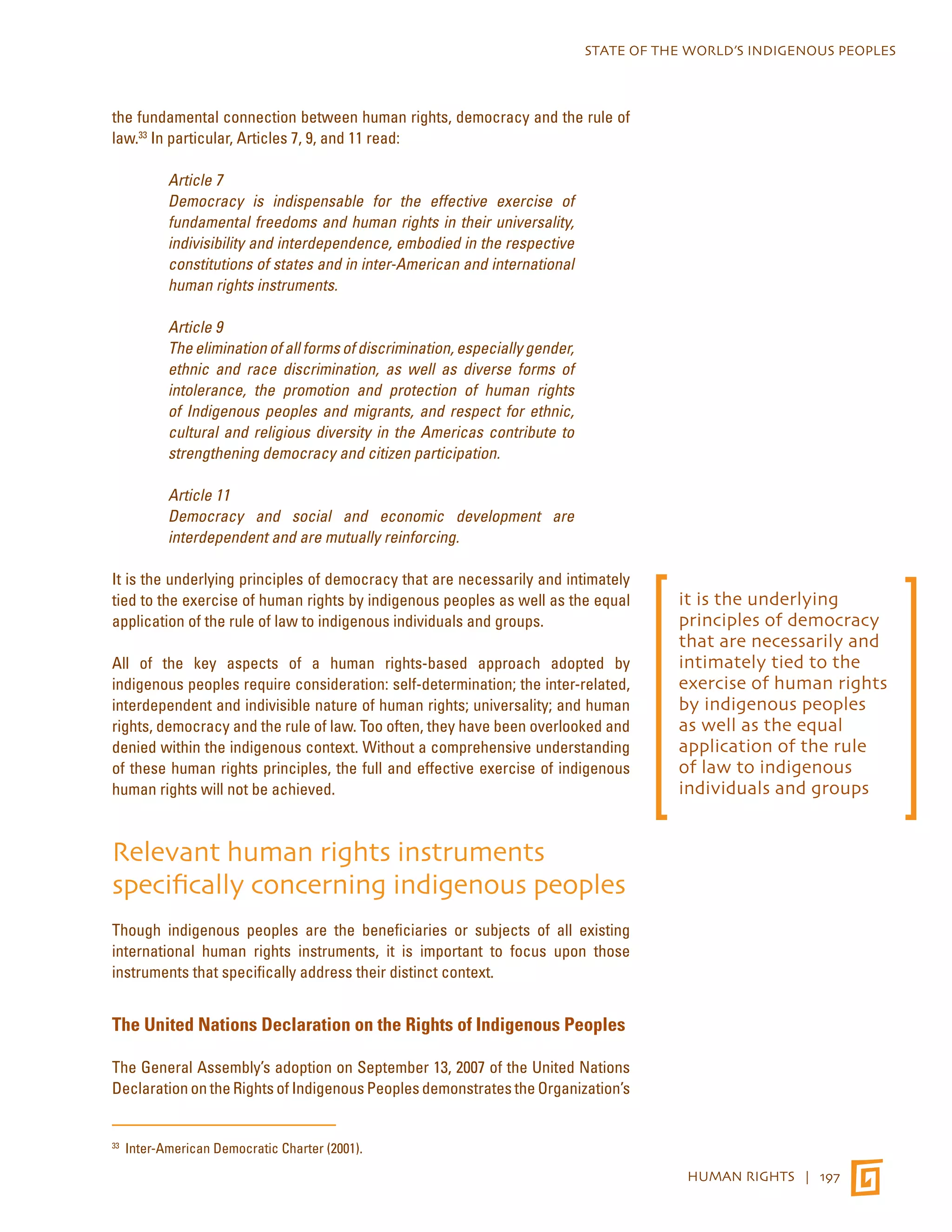

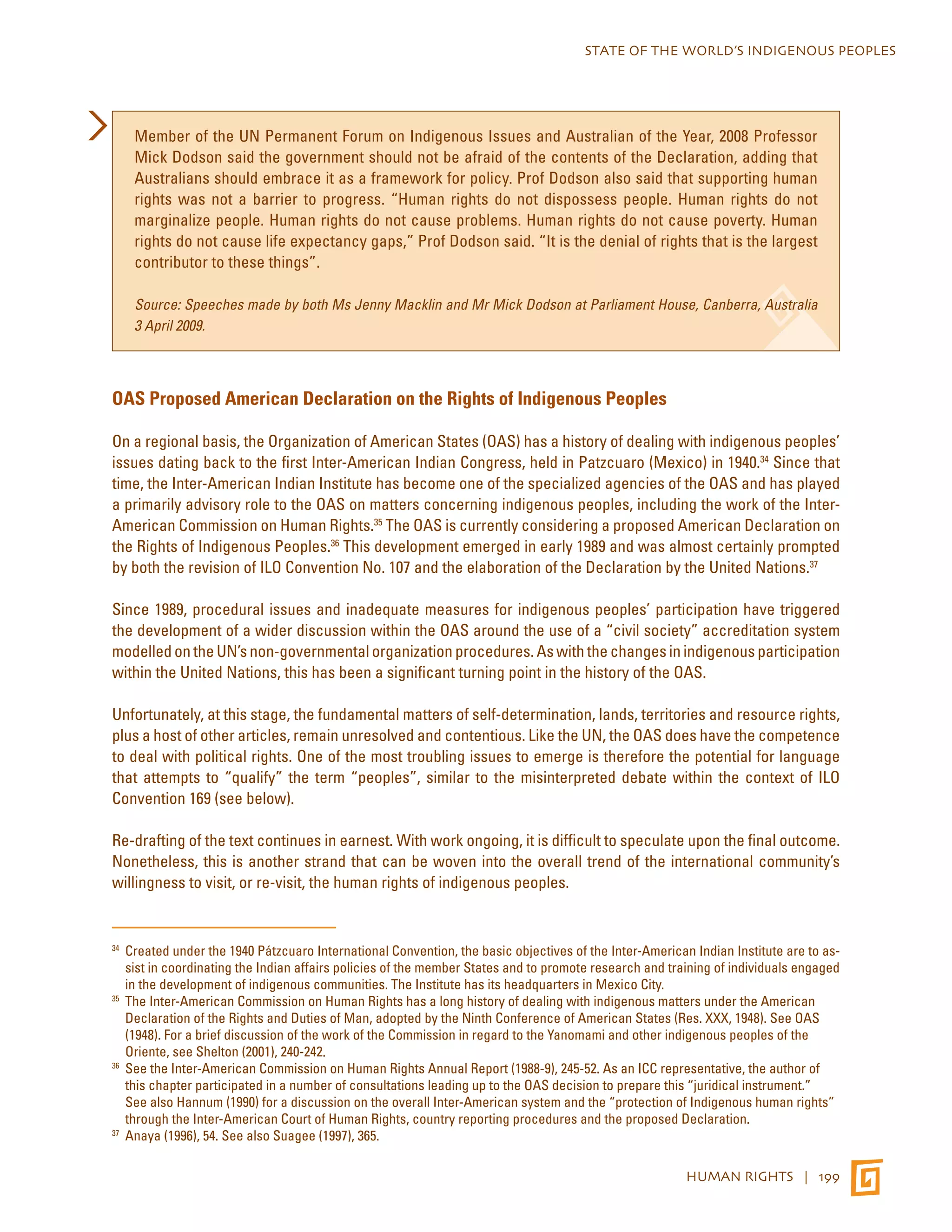
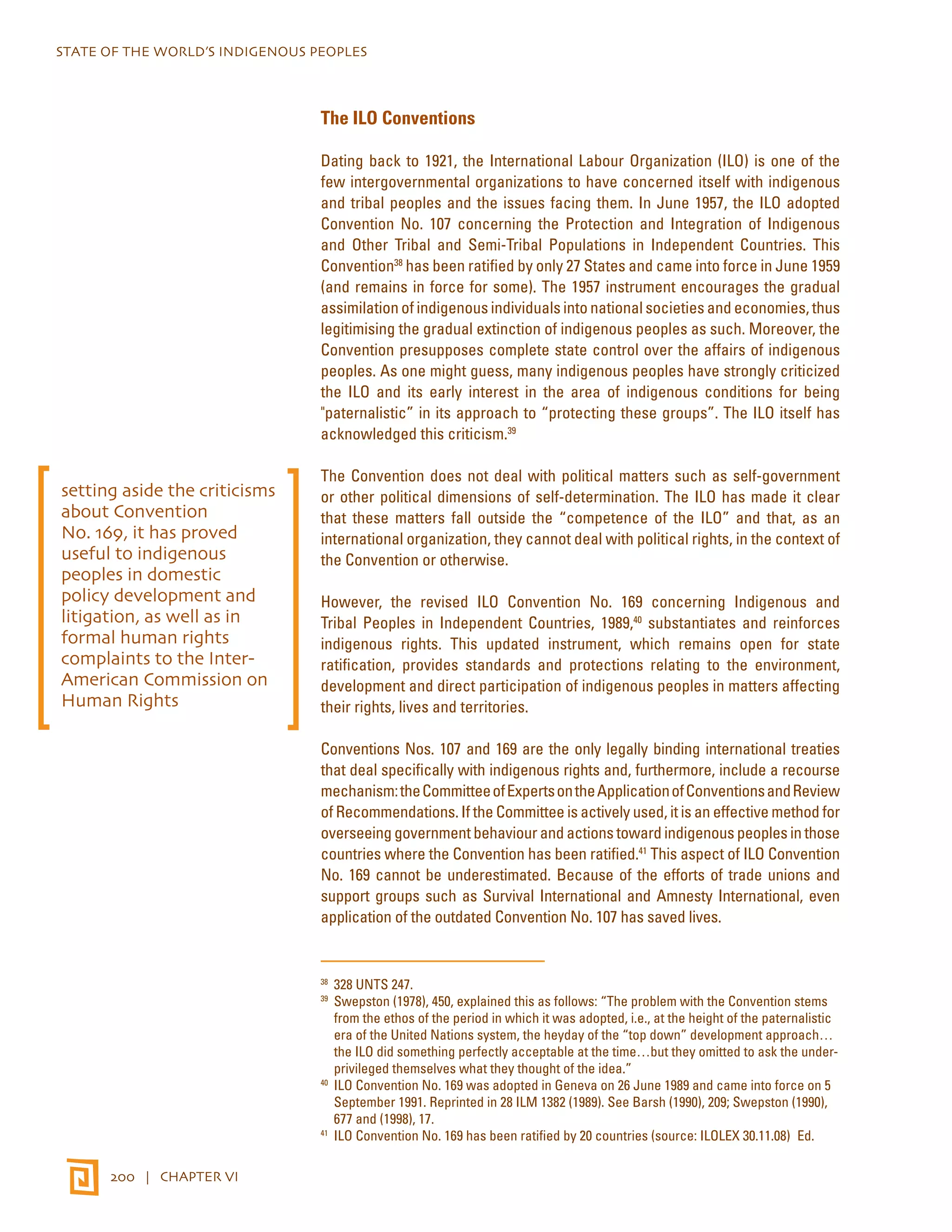
![STATE OF THE WORLD’S INDIGENOUS PEOPLES
When read in context, there are many possibilities for interpreting the language in a positive fashion. Setting
aside the criticisms about Convention No. 169,42 it has proved useful to indigenous peoples in domestic policy
development43 and litigation,44 as well as in formal human rights complaints to the Inter-American Commission on
Human Rights.45
HUMAN RIGHTS | 201
International Covenants
The Universal Declaration of Human Rights was utilized as a starting point for the codification of first and second
generation rights, namely civil and political rights as contained in the International Covenant on Civil and Political
Rights (ICCPR)46 and economic, social and cultural rights as contained in the International Covenant on Economic,
Social and Cultural Rights (ICESCR).47 It is interesting to note that some of those engaged in the process grappled
with the fact that civil and political rights and economic, social and cultural rights were interdependent.48
Common to both the ICCPR and the ICESCR is the fact that they are binding upon State parties to the Covenants—
creating international legal obligations that relate to the very principles and purposes of the United Nations
42 See S. Venne (1989).
43 The following information was downloaded from the ILO website at http://www.ilo.org: “Prior to its submission to the Committee
of Experts of the ILO, the Government of Norway sent its latest report on the implementation of Convention No. 169 to the Sami
Parliament for its comments. These comments form an integral part of the report, under the terms of an agreement entered into
between the Norwegian Government and the Sami Parliament. This co-operation is established as a permanent procedure to
ensure the inclusion of the opinion of the Sami Parliament in the formal reporting procedure on Convention No. 169. The Sami
Parliament has indicated its willingness to enter into an informal dialogue with the Committee of Experts, together with the
Norwegian Government, to facilitate the implementation of the Convention. The Government has stated that it shares the wish
to facilitate the implementation of the Convention in this way, believing that open co-operation between governments and rep-resentative
indigenous bodies may contribute effectively to the international promotion of indigenous rights and cultures, and
the Government therefore fully supports the suggestion of a supplementary dialogue.”
44 The following information was downloaded from the ILO website at http://www.ilo.org: “With regard to the environment, the
Norwegian Ministry of Culture has instructed the regional board responsible for managing crown land in Finnmark to ask the
opinion of the Sami Assembly before taking any decision concerning land-use projects. The reindeer herding districts are
legally entitled to be consulted, have the right to be compensated, in the event of economic damage, and may bring lawsuits
before the courts if they consider a project inadmissible.” In this case, the provisions of ILO Convention No. 169 were invoked
and utilised by the Sami peoples. Such use of the language of the Convention is only available to those whose respective state
members have ratified the treaty.
45 See the Petition lodged by Jaime Castillo Felipe, on his own Behalf and on Behalf of the Mayagna Indian Community of Awas
Tingni Against Nicaragua, re-printed in 9 St. Thomas L. Rev. 164 (1996). This petition was prepared by S. James Anaya, Counsel
of Record, and invokes various provisions of ILO Convention No. 169, as well as the United Nations draft Declaration on the
Rights of Indigenous Peoples, the draft Inter-American Declaration on the Rights of Indigenous Peoples [discussed above], and
the American Convention. See also the Petition by the Western Shoshone (1993); the Mayan Cultural Council of Belize (2000);
and the complaint filed by S. J. Anaya and R. A. Williams, Jr., on behalf of the First Nation of Carrier Sekani of British Columbia,
Canada (2000). See also Anaya (1998), 1.
46 International Covenant on Civil and Political Rights was adopted by the United Nations General Assembly on 16 December 1966
and entered into force on 23 March 1976. General Assembly Resolution. 2200A (XXI), 21 UN GAOR Supp. (No. 16) at 52, UN Doc.
A/6316 (1966), 999 UNTS. 171.
47 International Covenant on Economic, Social and Cultural Rights (1966), adopted by the United Nations General Assembly on 16
December 1966 and entered into force 3 January 1976. General Assembly Resolution 2200A (XXI), 21 UN GAOR Supp. (No. 16) at
49, UN Doc. A/6316 (1966), 993 U.N.T.S. 3,
48 Steiner and Alston (1996), 17. The authors re-print the “Annotations on the Text of the Draft International Covenants on Hu-man
Rights,” UN Doc. A/2929 (1955), which include: “[Between 1949 and 1951 the Commission on Human Rights worked on a
single draft covenant dealing with both of the categories of rights. But in 1951 the General Assembly, under pressure from the
Western-dominated Commission, agreed to draft two separate covenants]…to contain ‘as many similar provisions as possible’
and to be approved and opened for signature simultaneously, in order to emphasise the unity of purpose….Those who were in
favor of drafting a single covenant maintained that human rights could not be clearly divided into different categories, nor could
they be so classified as to represent a hierarchy of values. All rights should be promoted and protected at the same time. With-out
economic, social and cultural rights, civil and political rights might be purely nominal in character; without civil and political
rights, economic, social and cultural rights could not be long ensured….”](https://image.slidesharecdn.com/sowipweb-141112214427-conversion-gate02/75/Sowip-web-212-2048.jpg)
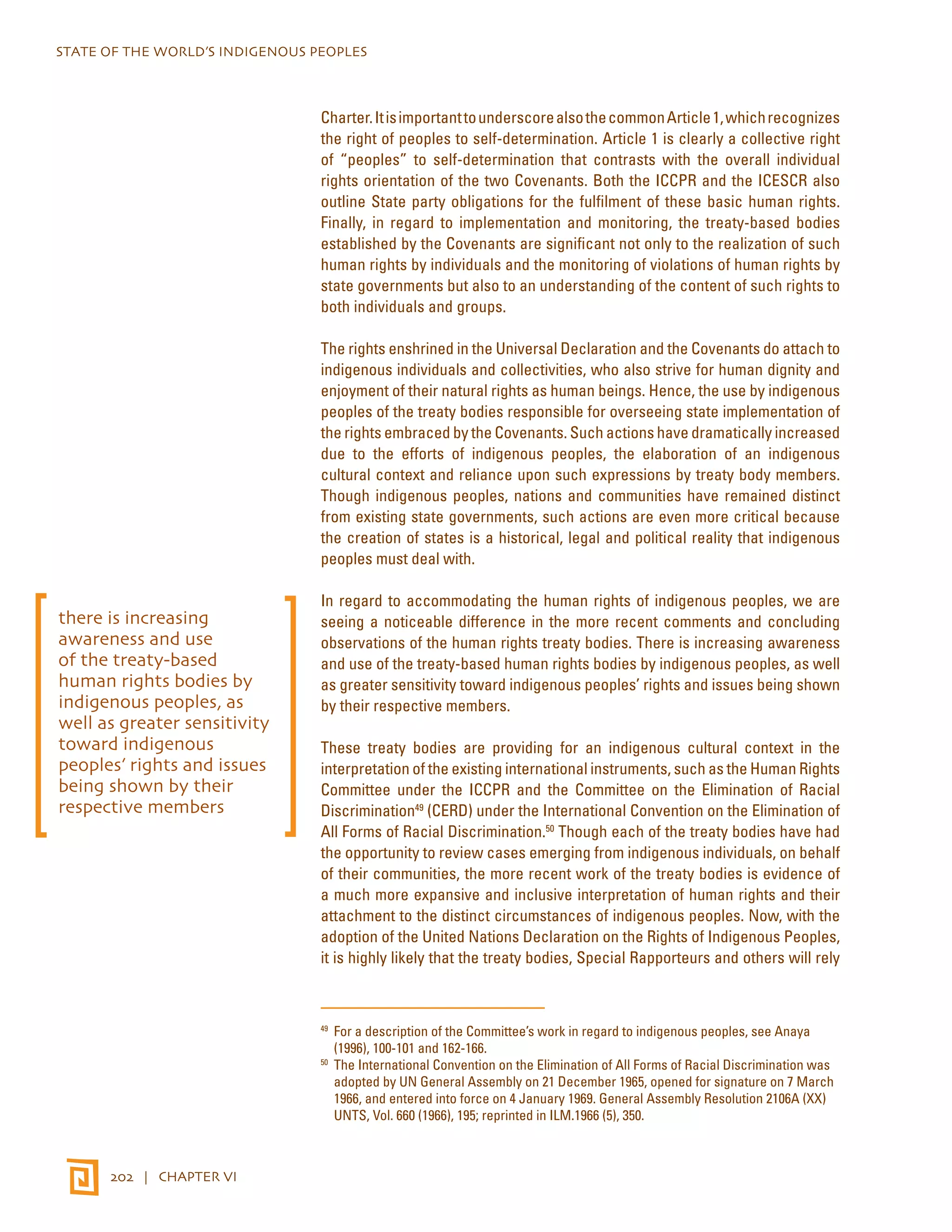
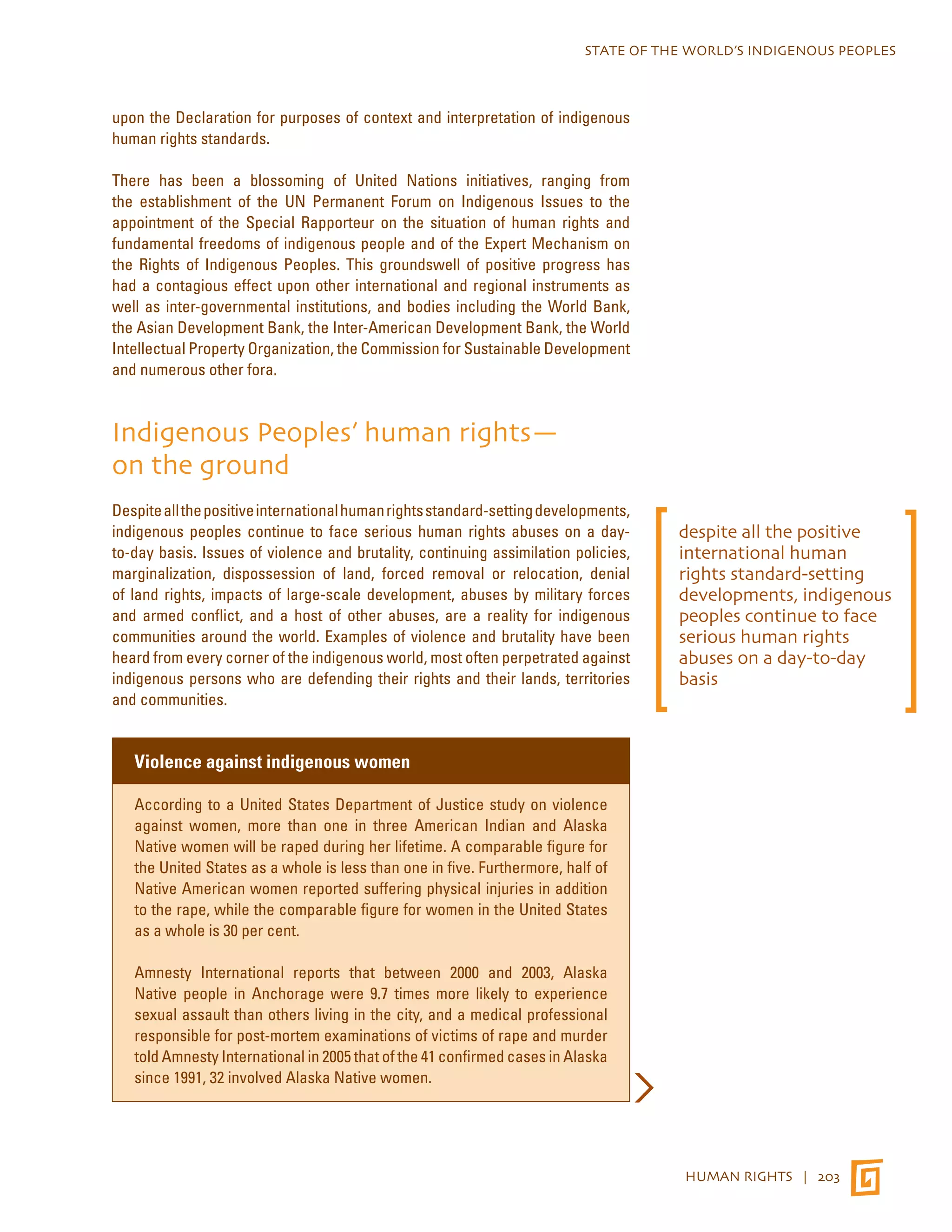
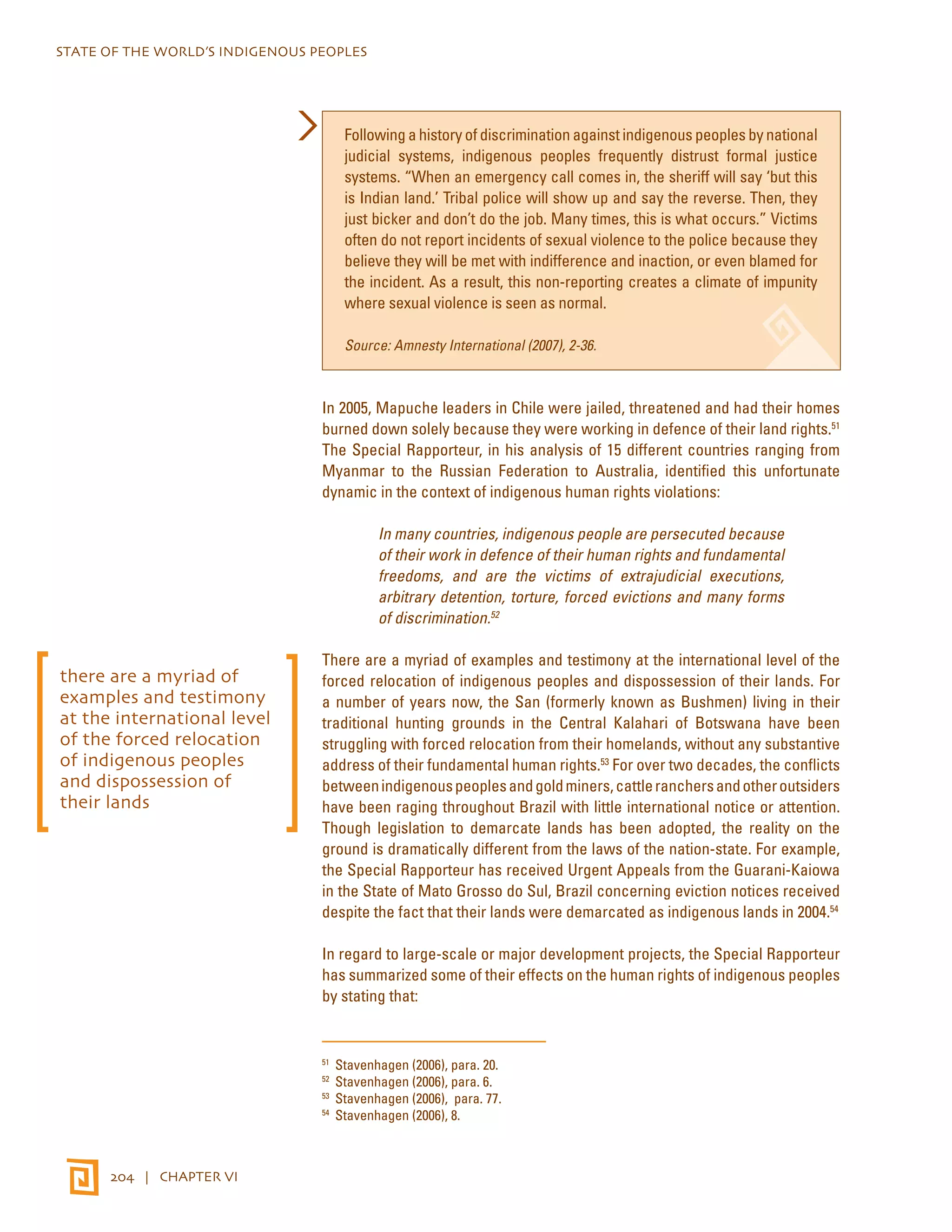
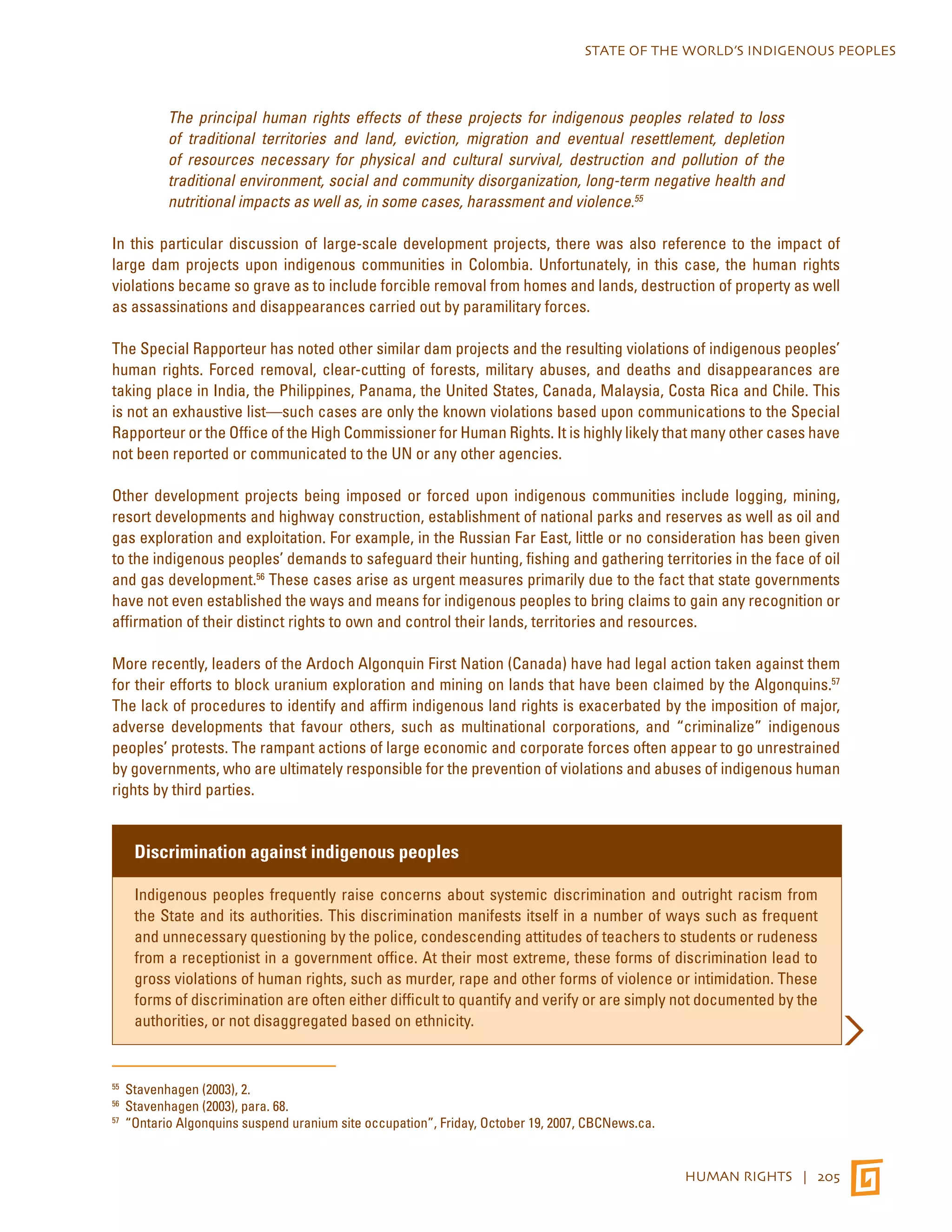
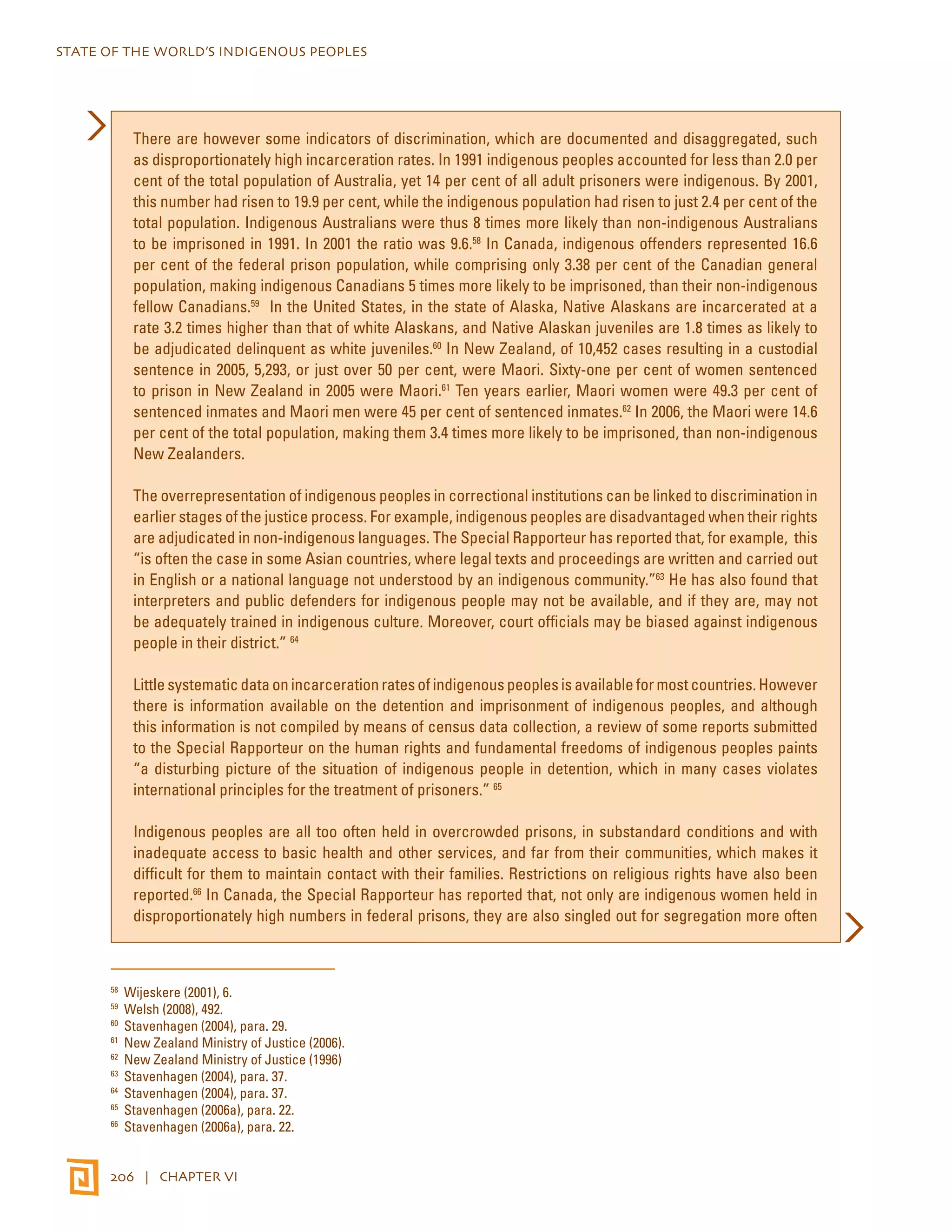
![STATE OF THE WORLD’S INDIGENOUS PEOPLES
than other inmates and suffer higher rates of inmate abuse.67 In Mexico, reports indicate that indigenous
women tend to be abused and harassed while in detention, and may become involved in drug and
prostitution schemes operating in prisons.68
Indigenous peoples have frequently faced detention due to the criminalization of social protest activities.
According to the Special Rapporteur, “[o]ne of the most serious shortcomings in human rights protection
in recent years is the trend towards the use of legislation and the justice system to penalize and criminalize
social protest activities and legitimate demands made by indigenous organizations and movements in
defence of their rights.”69 The Special Rapporteur has reported, for example, receiving “many reports
from countries such as India, Indonesia, the Lao People’s Democratic Republic, Malaysia and Thailand, of
arbitrary arrest or fake criminal charges made against members of indigenous and tribal peoples, as well
as other forms of threats and intimidations, as a result of their mobilization to defend their rights against
State authorities. In Mexico, the Special Rapporteur received complaints about indigenous community
activities being prosecuted on “fabricated” charges for their participation in social mobilization over
rights issues.70
Cases of ill-treatment and torture during detention, as well as extrajudicial killings have also been widely
reported. In relation to his 2006 visit to Kenya, the Special Rapporteur received numerous reports of arbitrary
detention, police harassment, and incidents of torture and rape suffered by local residents as a result
of the punitive application of security measures. Reportedly, many police abuses took place in relation
to social protests associated with land rights claims, with vocal community members being ill-treated
and arrested.71 The Special Rapporteur has voiced concerns regarding abuse of indigenous individuals in
detention in a number of instances, including in cases reported from Bangladesh and Botswana.72
HUMAN RIGHTS | 207
Sources: See Footnotes
Testimony of abuses by State-controlled military or paramilitary forces has also been repeatedly given. In
Myanmar, according to information received by the Special Rapporteur on the human rights and fundamental
freedoms of indigenous people, members of the village of Tagu Seik, near Einme, were tortured and their
community ransacked on the basis of purported communications with another armed opposition group.73 In the
Philippines, a similar military attack upon indigenous peoples took place. This was again on the basis that the
indigenous individuals were allegedly members of a “splinter group of communist terrorists”.74
Needless to say, these and numerous other gross human rights violations and abuses are perpetrated
against indigenous peoples—as collectivities or as individual men and women—on the basis of their identity
and marginalization, and, in the case of indigenous women, on the basis of their sex. Unfortunately, such
discriminatory actions have been constant, from the time of first contact with outsiders to the present. Little has
changed, despite the groundswell of developments in the area of human rights standards specifically addressing
indigenous peoples’ human rights.
67 Stavenhagen (2005), para. 56.
68 Stavenhagen (2004), para. 26.
69 Stavenhagen (2006a), para. 19.
70 Stavenhagen (2004), para. 49.
71 Stavenhagen (2007a), para. 60.
72 See for example,Anaya (2008), para. 70 and Stavenhagen (2007a), para. 53
73 Stavenhagen (2003), para. 60.
74 Stavenhagen (2003), para. 66.](https://image.slidesharecdn.com/sowipweb-141112214427-conversion-gate02/75/Sowip-web-218-2048.jpg)
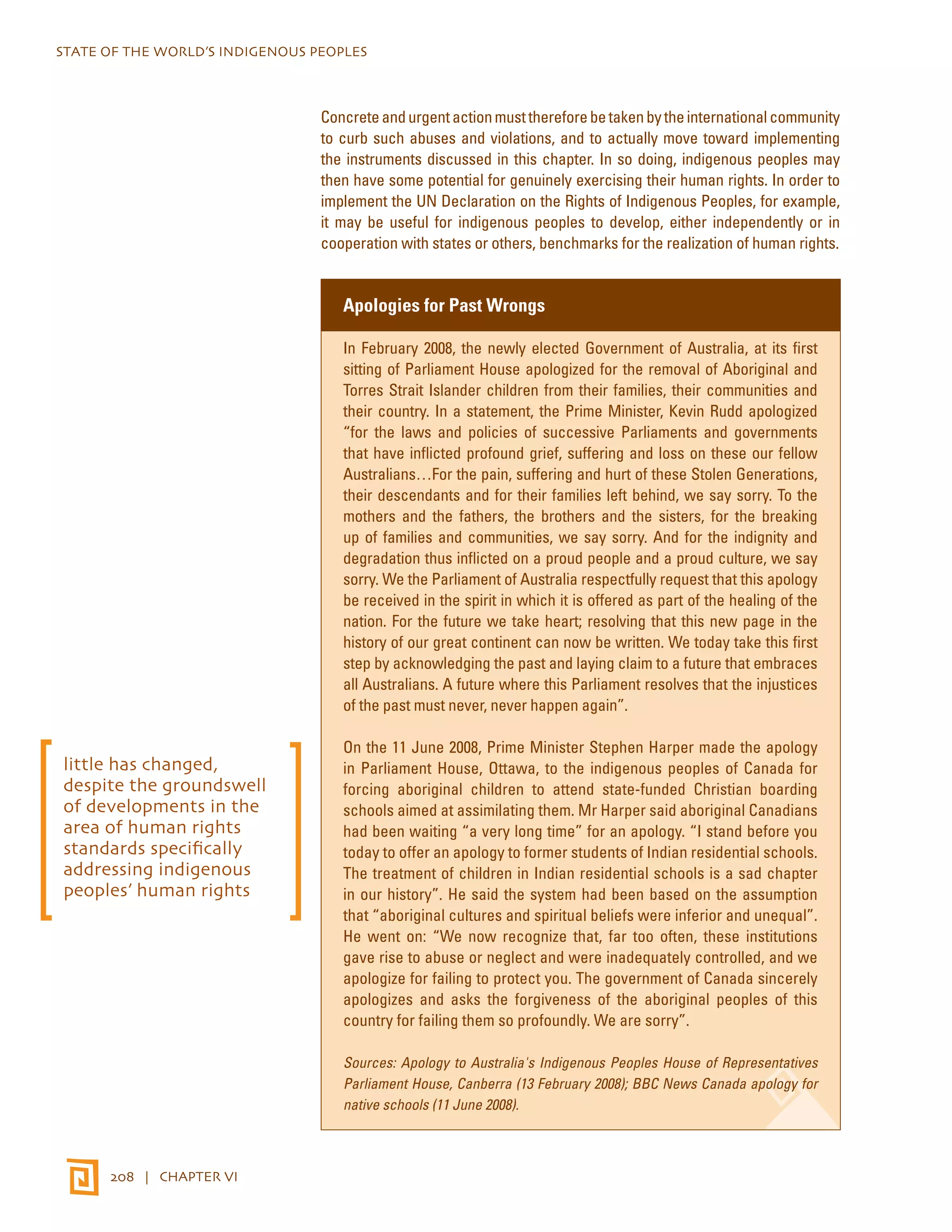
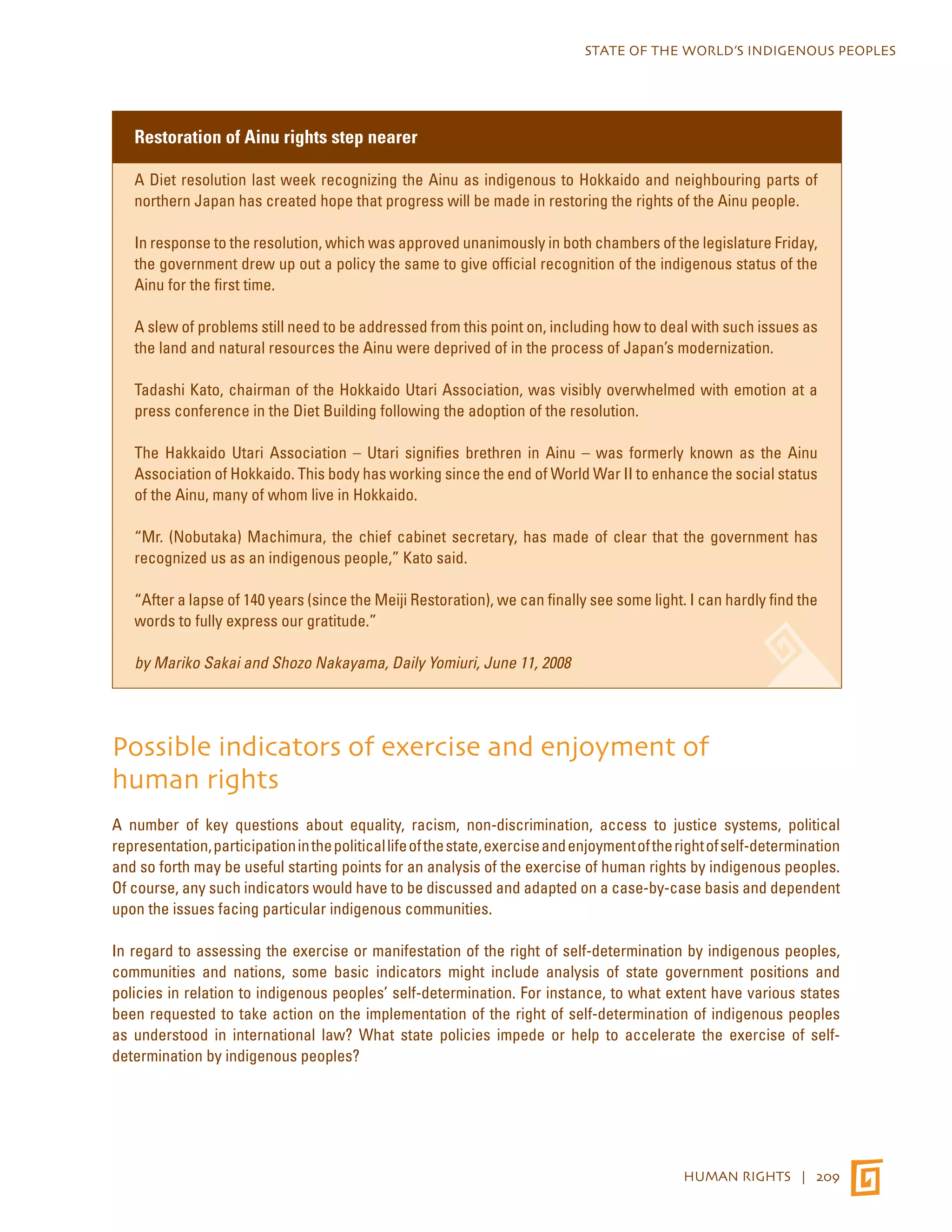
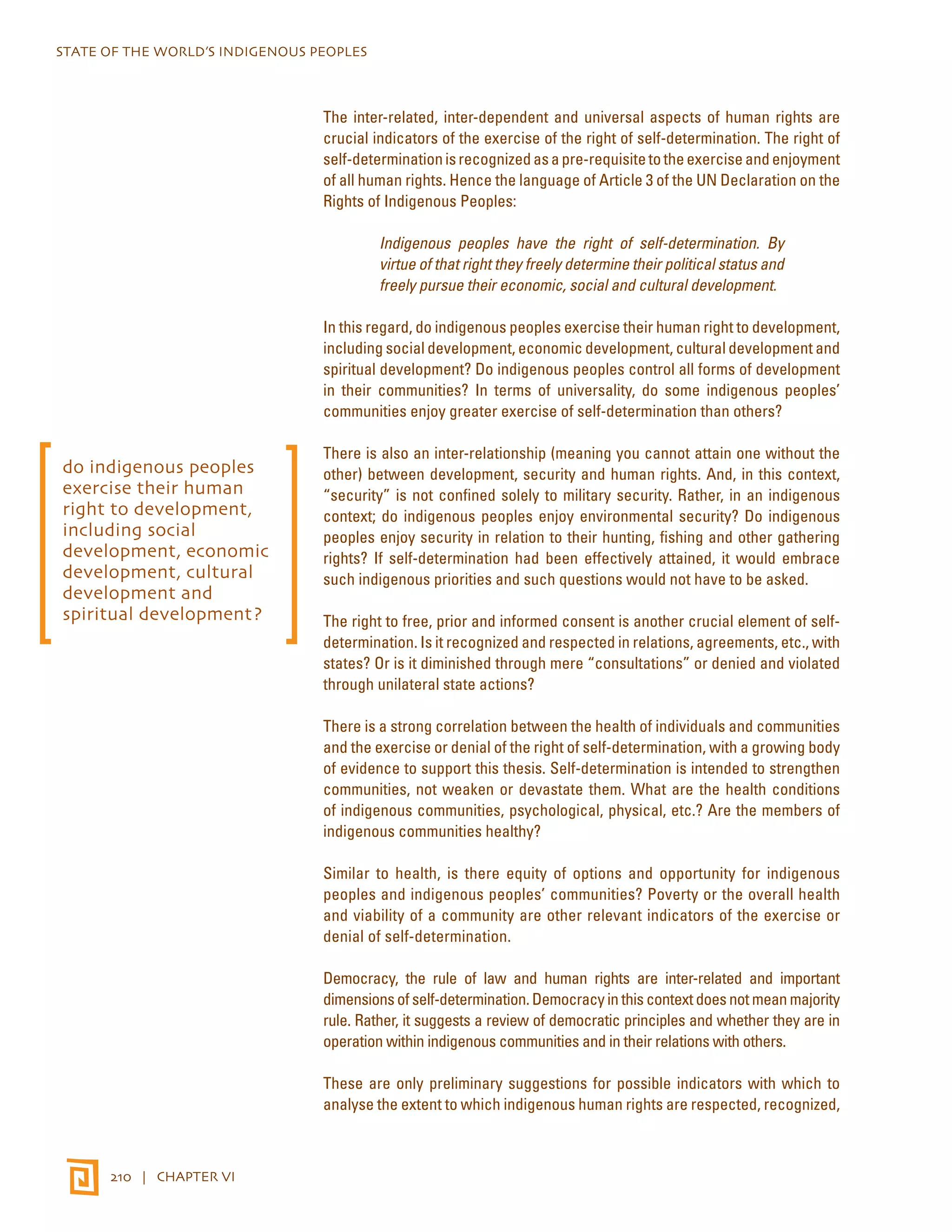
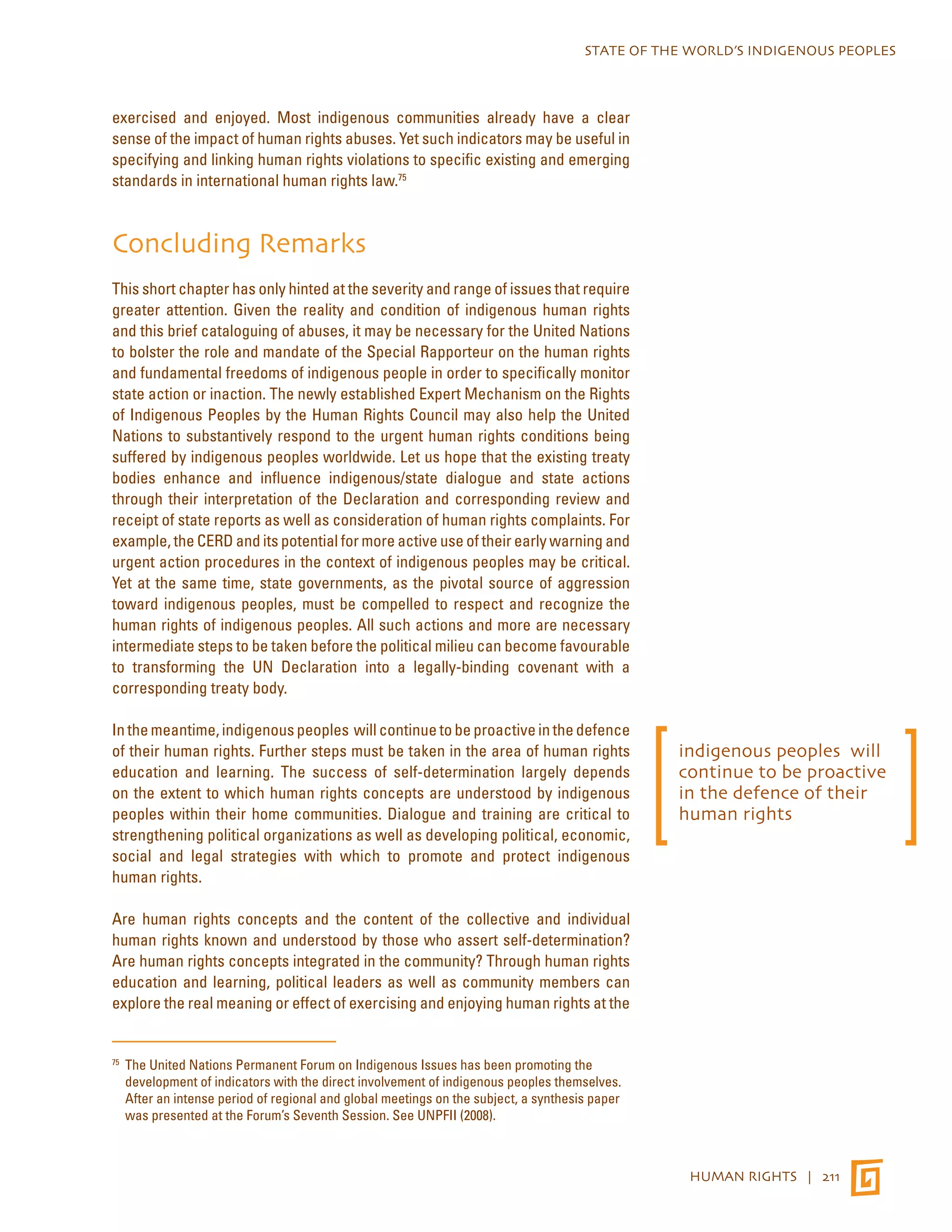
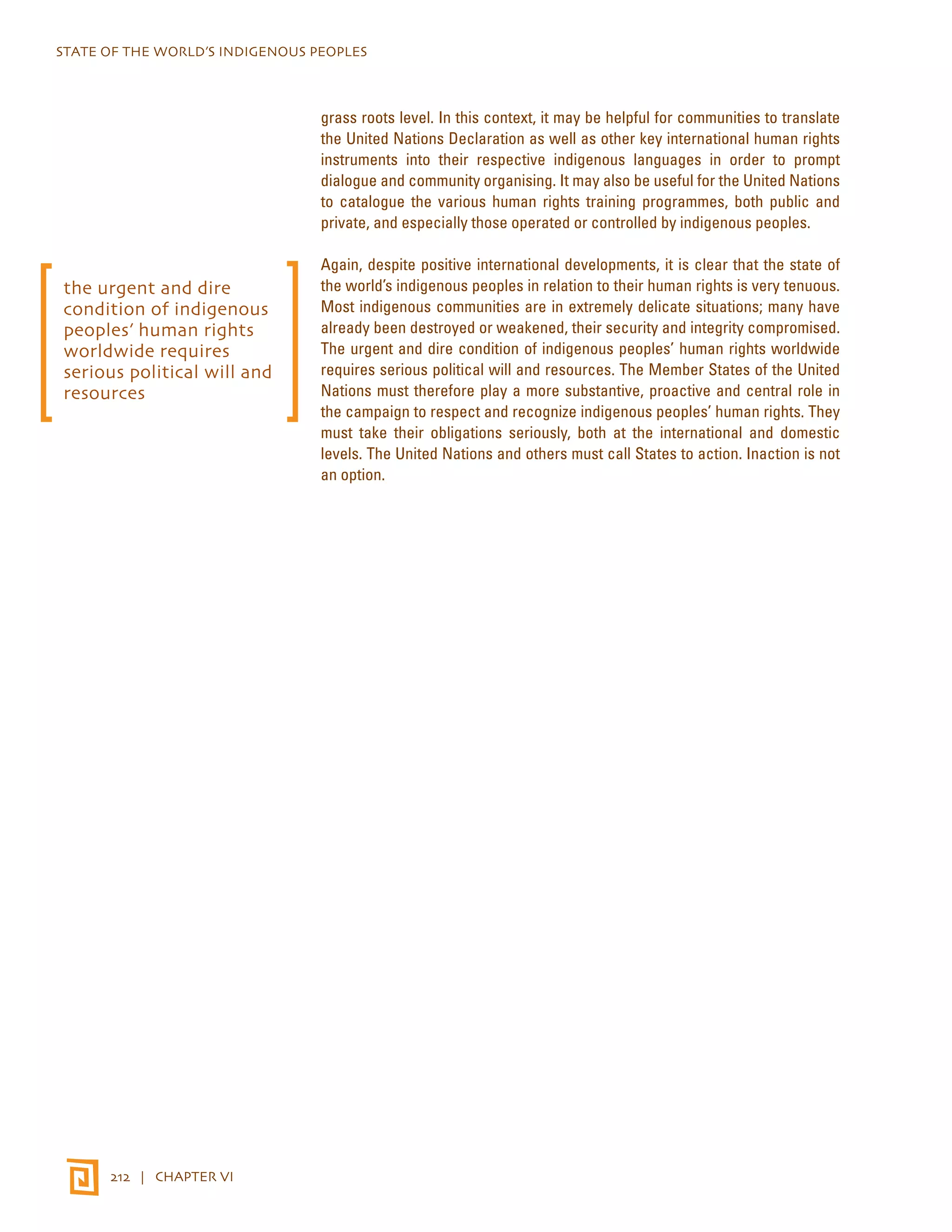
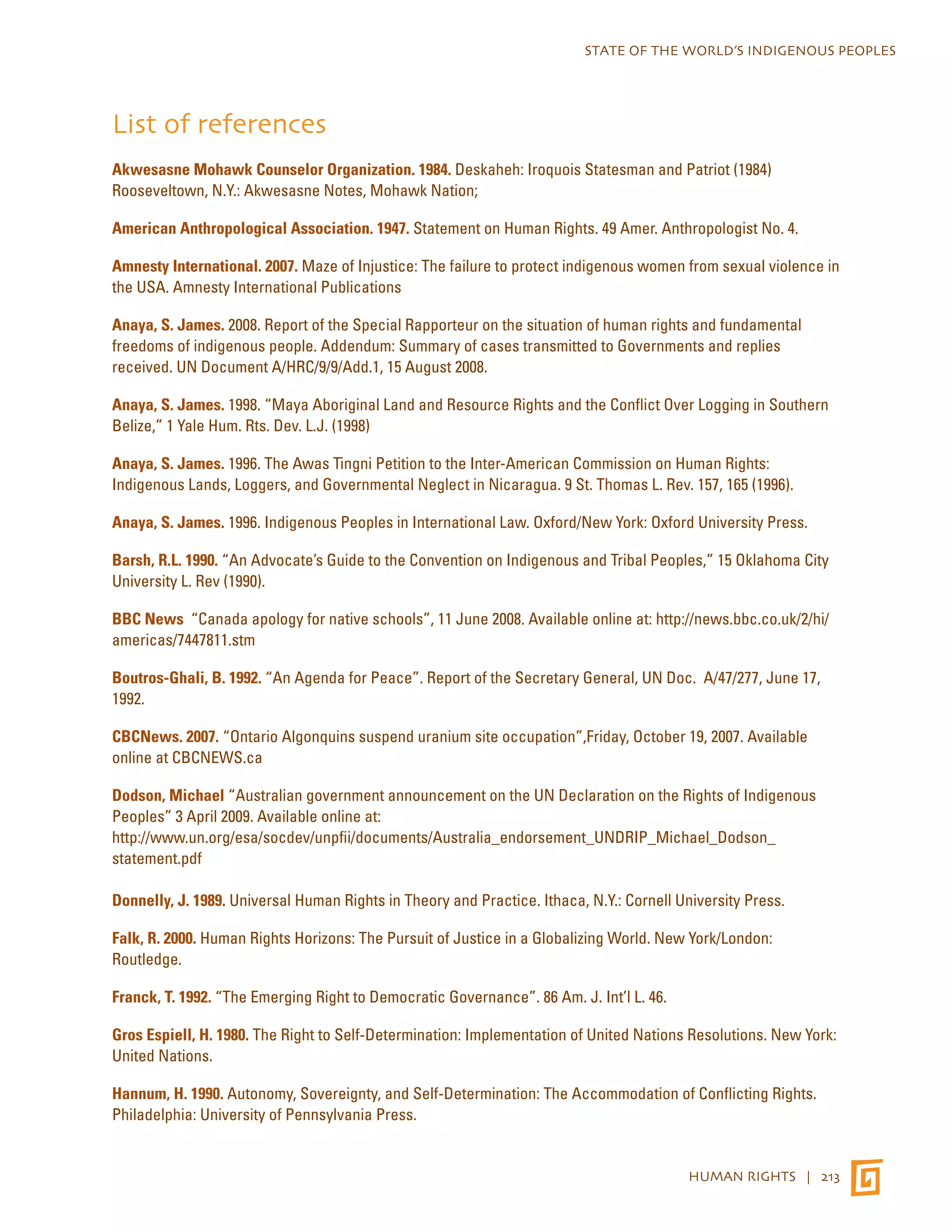
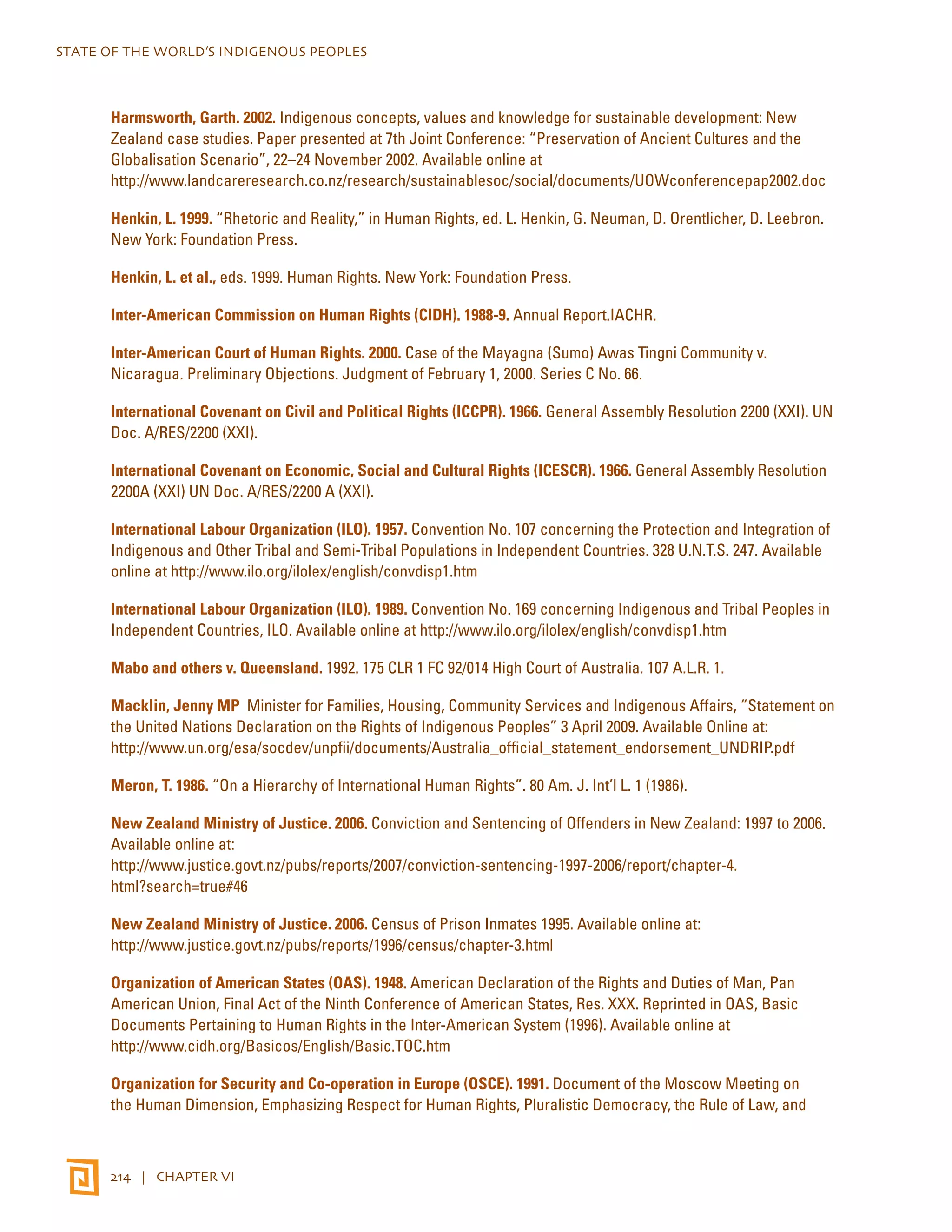
![STATE OF THE WORLD’S INDIGENOUS PEOPLES
Procedures for Fact-Finding, adopted at the Conference on Security and Co-operation in Europe, Moscow,
October 3, 1991. 30 I.L.M. 1670, at 1672.
Pannikar, R. 1982. “Is the Notion of Human Rights a Western Concept?”' Diogenes Volume 120, pp.75-102. Ed.
An-Na'im, Abdullahi.
Rudd, Kevin “Apology to Australia's Indigenous Peoples” House of Representatives Parliament House, Canberra
(13 February 2008) Available online at: http://www.pm.gov.au/media/Speech/2008/speech_0073.cfm
Sanders, D. 1992. "Remembering Deskaheh: Indigenous Peoples and International Law" in International Human
Rights Law [:] Theory and Practice, ed. I. Cotler & F.P. Eliadis. Montreal: Canadian Human Rights Foundation, 1992.
Shelton, D. 2001. “Environmental Rights,” in Peoples’ Rights, ed. P. Alston. New York: Oxford University Press.
Stavenhagen, Rodolfo. 2003. Report of the Special Rapporteur on the situation of human rights and fundamental
freedoms of indigenous people, to the Commission on Human Rights. UN Document E/CN.4/2003/90, 21 January 2003.
Stavenhagen, Rodolfo. 2005. Report of the Special Rapporteur on the situation of human rights and fundamental
freedoms of indigenous people, to the Commission on Human Rights. Addendum: Mission to Canada. UN
Document E/CN.4/2005/88/Add.3, 2 December 2004.
Stavenhagen, Rodolfo. 2004. Report of the Special Rapporteur on the situation of human rights and fundamental
freedoms of indigenous people, to the, Commission on Human Rights. UN Document E/CN.4/2004/80, 26 January
2004.
Stavenhagen, Rodolfo. 2006. Report of the Special Rapporteur on the situation of human rights and fundamental
freedoms of indigenous people to the Commission on Human Rights. Addendum: Analysis of country situations
and other activities of the Special Rapporteur. UN Document E/CN.4/2006/78/Add.1, 18 January 2006.
Stavenhagen, Rodolfo. 2006a. Report of the Special Rapporteur on the situation of human rights and
fundamental freedoms of indigenous people to the Commission on Human Rights, submitted pursuant to
Commission resolution 2005/51. Addendum: Progress report on preparatory work for the study regarding
best practices carried out to implement the recommendations contained in the annual reports of the Special
Rapporteur. UN Document E/CN.4/2006/78/Add.4, 26 January 2006.
Stavenhagen, Rodolfo. 2007. Report of the Special Rapporteur on the situation of human rights and fundamental
freedoms of indigenous people to the Human Rights Council. UN Doc. A/HRC/6/15, 15 November 2007.
Stavenhagen, Rodolfo. 2007a. Report of the Special Rapporteur on the situation of human rights and
fundamental freedoms of indigenous people. Addendum: Summary of cases transmitted to Governments and
replies received. UN Document A/HRC/6/15/Add.1, 20 November 2007
Stavenhagen, Rodolfo. 2007a. Report of the Special Rapporteur on the situation of human rights and
fundamental freedoms of indigenous people, to the Commission on Human Rights. Addendum: Mission to
Kenya. UN Document A/HRC/4/32/Add.3, 26 February 2007.
Steiner, H. 1999. “Do Human Rights Require a Particular Form of Democracy” in Democracy, the Rule of Law
and Islam, ed. E. Cotran and A. O. Sherif. London: Kluwer Law International.
Steiner, H.J. and P. Alston. 1996. International Human Rights in Context: Law, Politics, Morals. New York: Oxford
University Press.
HUMAN RIGHTS | 215](https://image.slidesharecdn.com/sowipweb-141112214427-conversion-gate02/75/Sowip-web-226-2048.jpg)
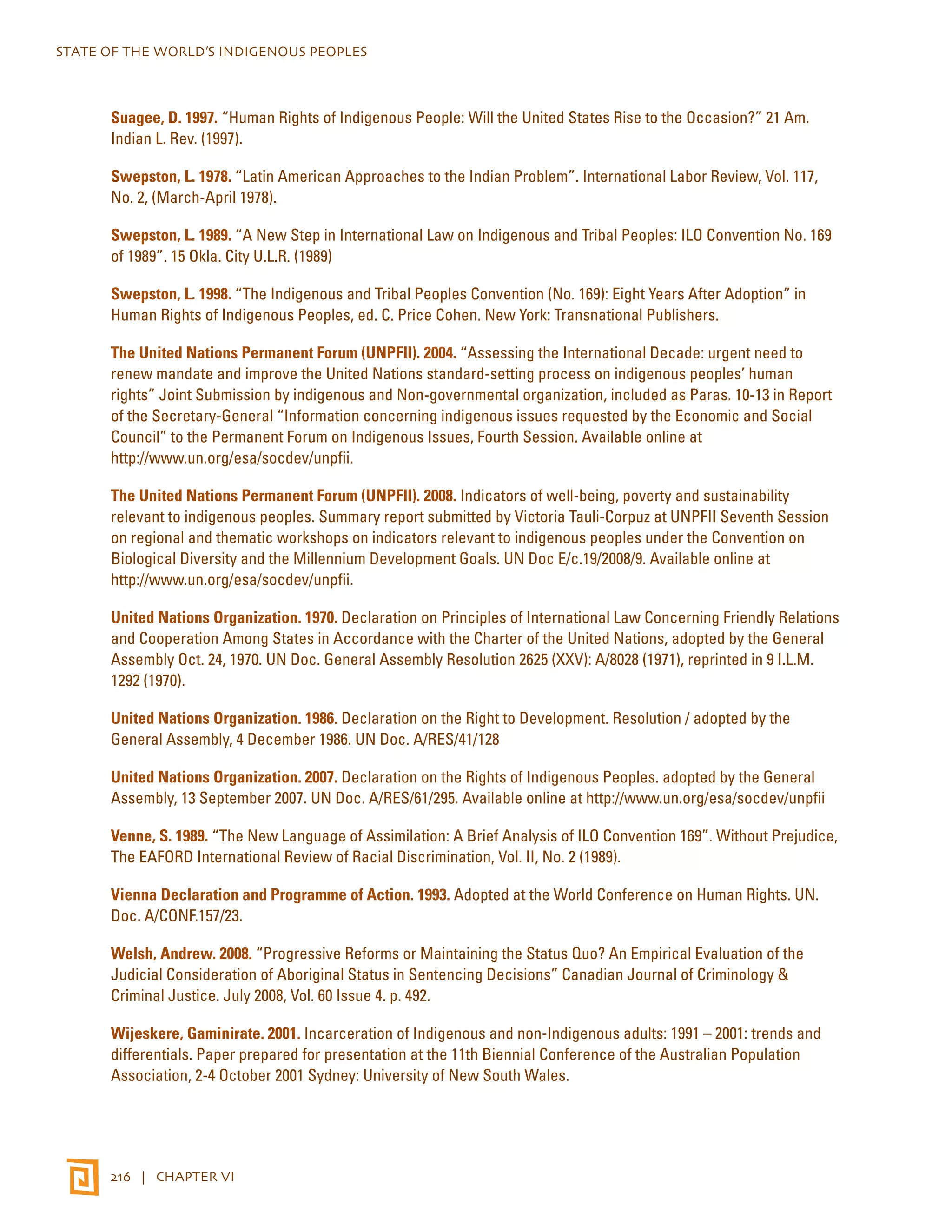
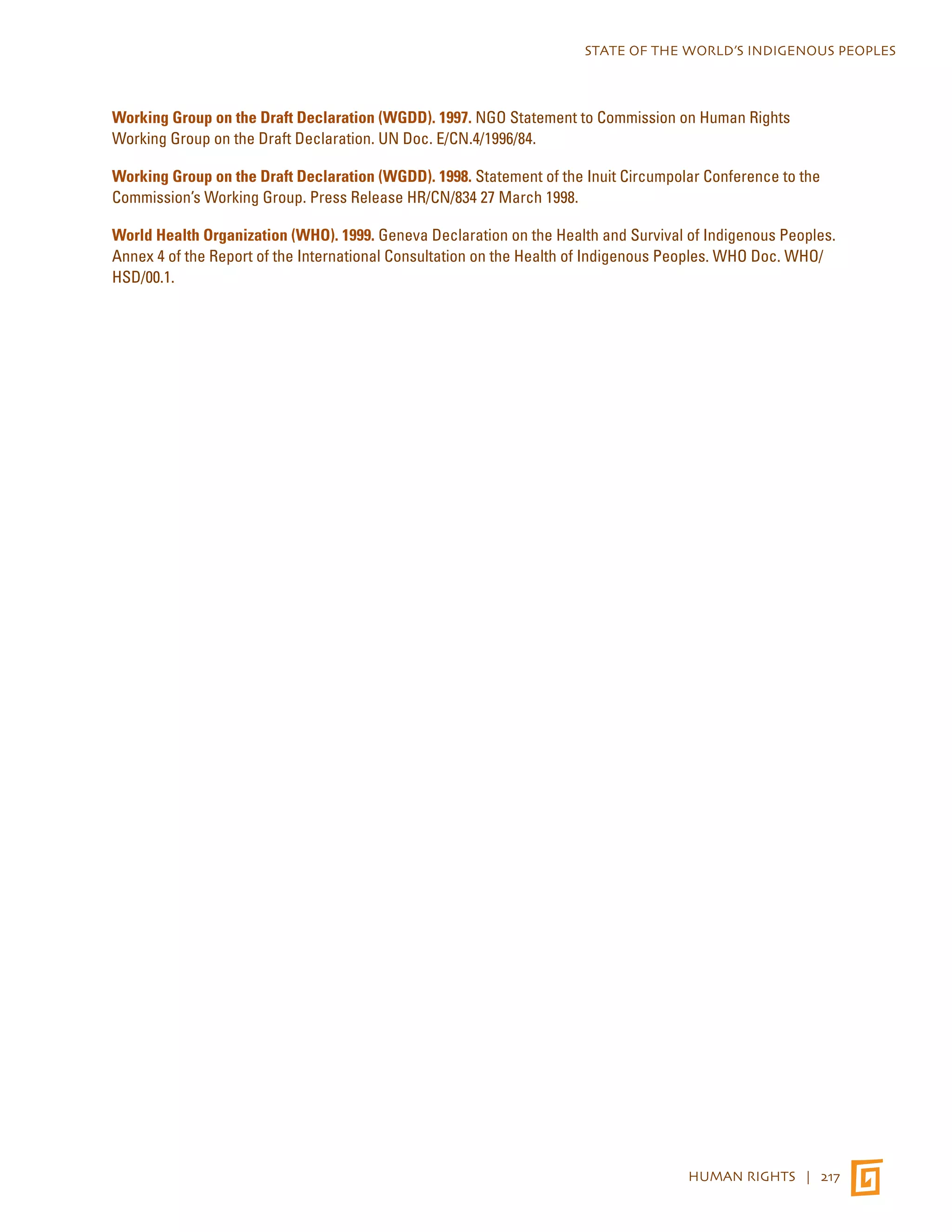

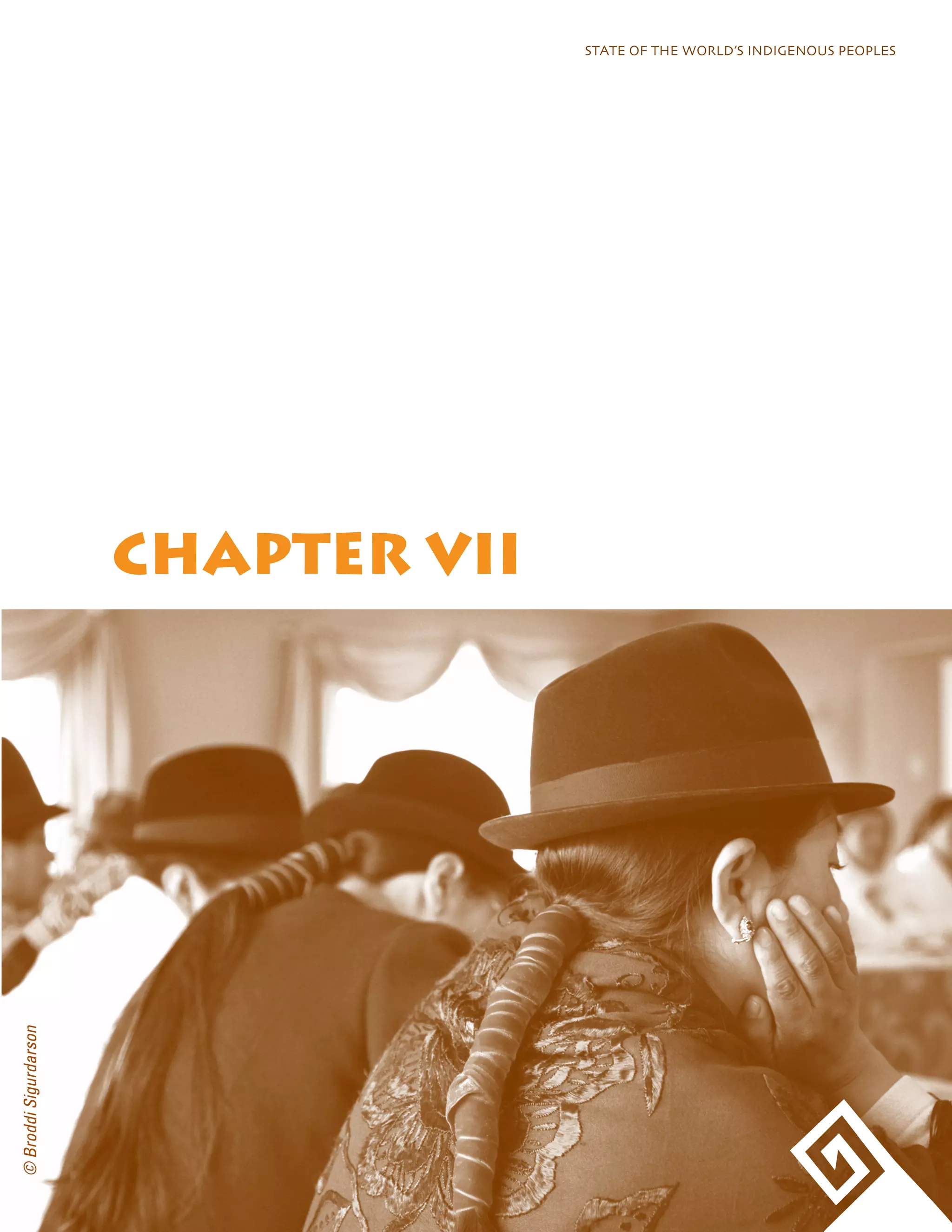

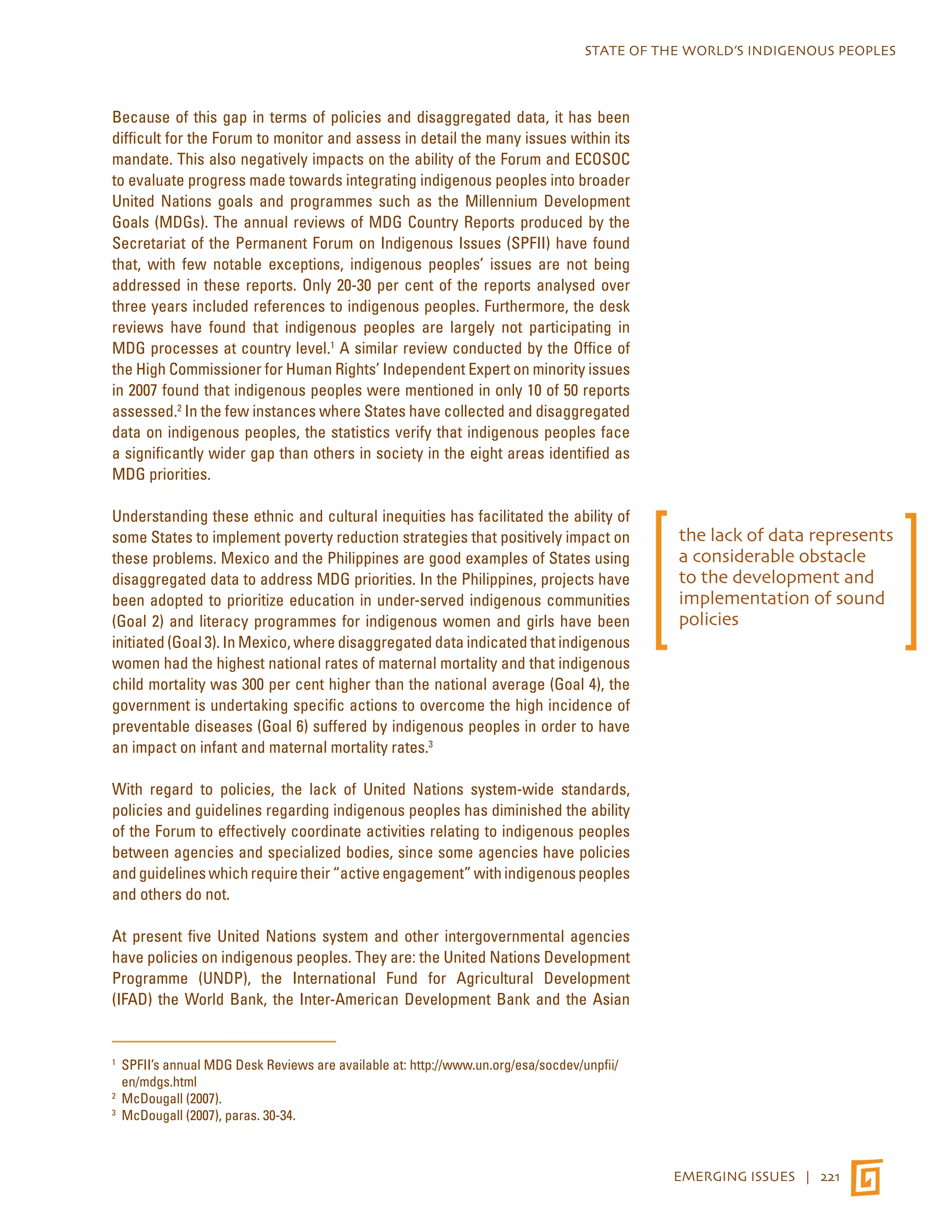
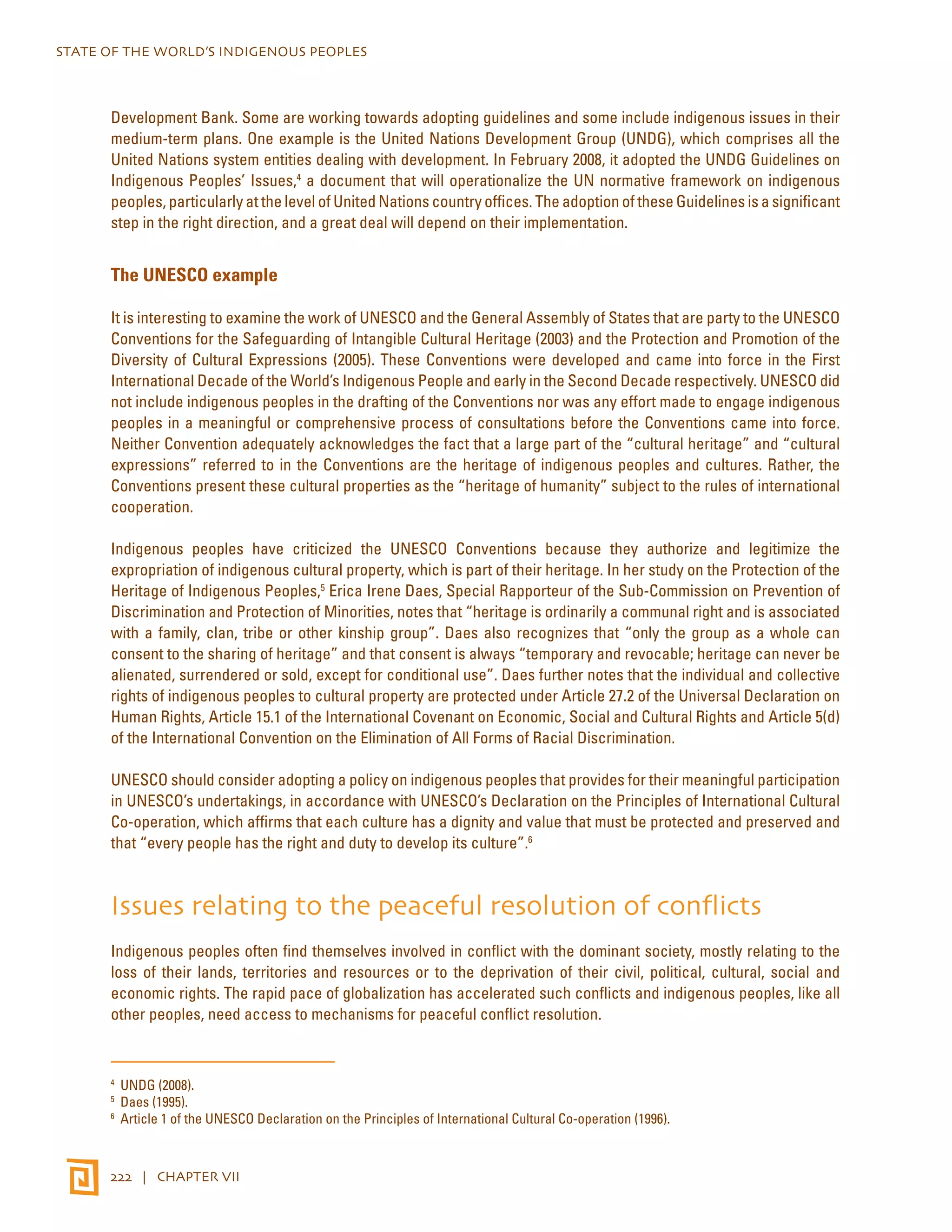
![STATE OF THE WORLD’S INDIGENOUS PEOPLES
EMERGING ISSUES | 223
The United Nations system does not provide specific juridical mechanisms for
the resolution of conflicts to which indigenous peoples are a party or which
result in the victimization of indigenous peoples.
The International Court of Justice (ICJ) does not provide legal standing to
indigenous individuals or collectives to pursue litigation against States and
others. The human rights treaty bodies and the regional international courts,
such as the Inter-American Court, have been accessed by indigenous peoples
to a limited extent, i.e., in cases where a State party has agreed to optional
protocols, or where a State party has reporting obligations under a treaty. It
should be noted, however, that the decisions of these human rights treaty bodies
are not binding or enforceable and are often ignored by offending States. Thus,
indigenous efforts in these fora have not had significant results in the resolution
of conflicts.
The indigenous problématique and United Nations intervention in
cases of conflict
In his “Study of treaties, agreements and other constructive arrangements
between States and indigenous populations”, Special Rapporteur Miguel Alfonso
Martínez discussed inherent problems relating to domestic and international
juridical fora as venues for the resolution of conflicts between States and
indigenous peoples. He notes:
In practically all cases, both in Latin America and in other
regions mentioned above, the legal establishment can be seen
serving as an effective tool in [the] process of domination.
Jurists (with their conceptual elaborations), domestic laws
(with their imperativeness both in the metropolis and in the
colonies), the judiciary (subject to the ‘rule of [non-indigenous]
law’), one-side international law (its enforcement assured
by military means) and international tribunals (on the basis
of existing international law) were all present to “validate”
juridically the organized plunder at the various stages of the
colonial enterprise.7
Noting that the indigenous problématique “cannot be approached exclusively
on the basis of juridical reasoning” because the problems confronted are
essentially political in nature, he concludes that:
Juridical discussions and argumentation simply take too long,
require copious resources (which the indigenous side almost
always lacks or has only in limited amounts), and in many
cases are prejudiced by centuries of sedimented rationale. In
addition, the urgency of the existing problems simply leaves no
7 Martínez (1999), para. 196.
indigenous peoples often
find themselves involved
in conflict with the
dominant society, mostly
relating to the loss of
their lands, territories
and resources or to the
deprivation of their civil,
political, cultural, social
and economic rights](https://image.slidesharecdn.com/sowipweb-141112214427-conversion-gate02/75/Sowip-web-234-2048.jpg)

